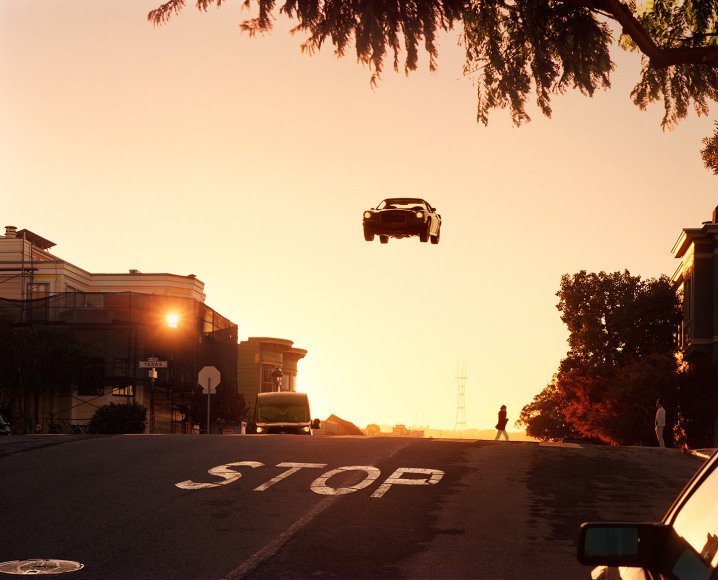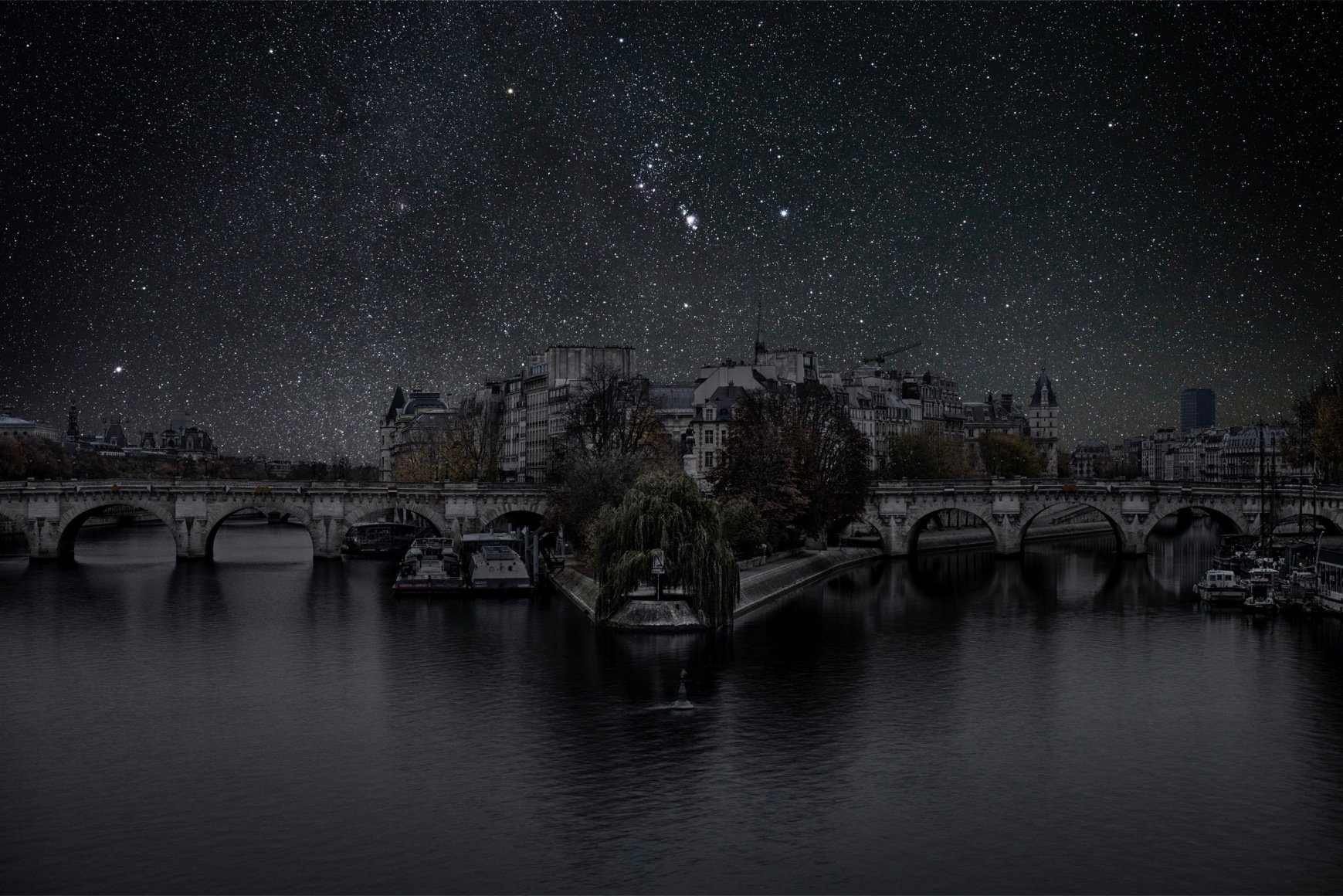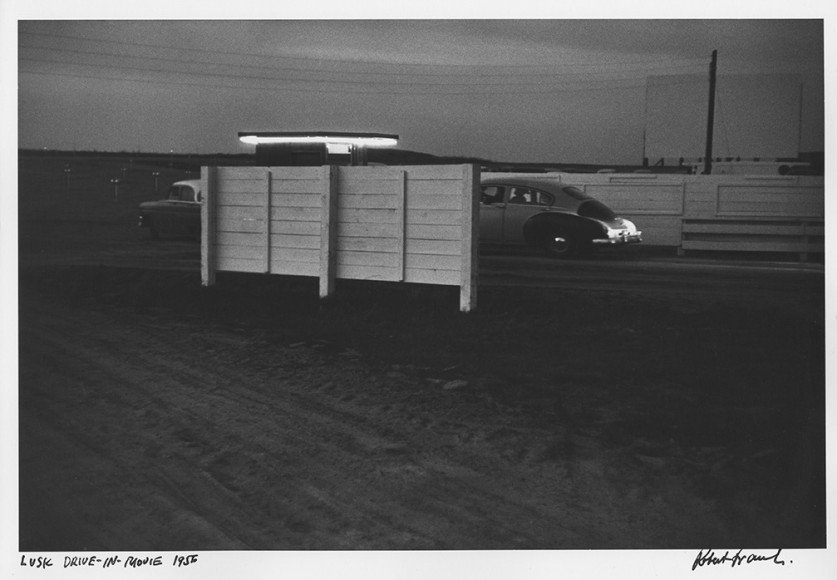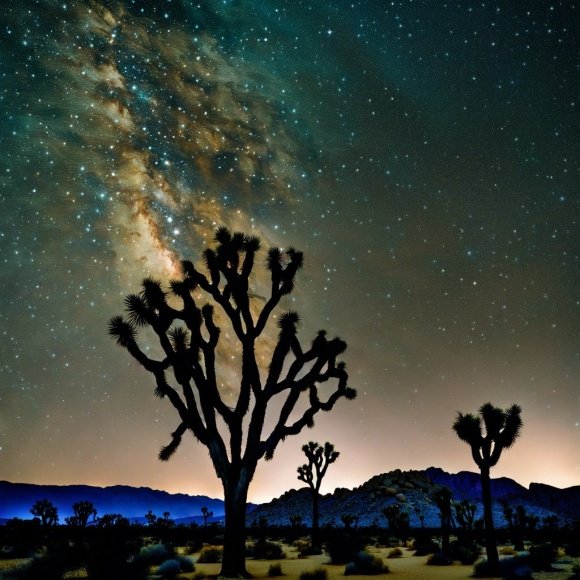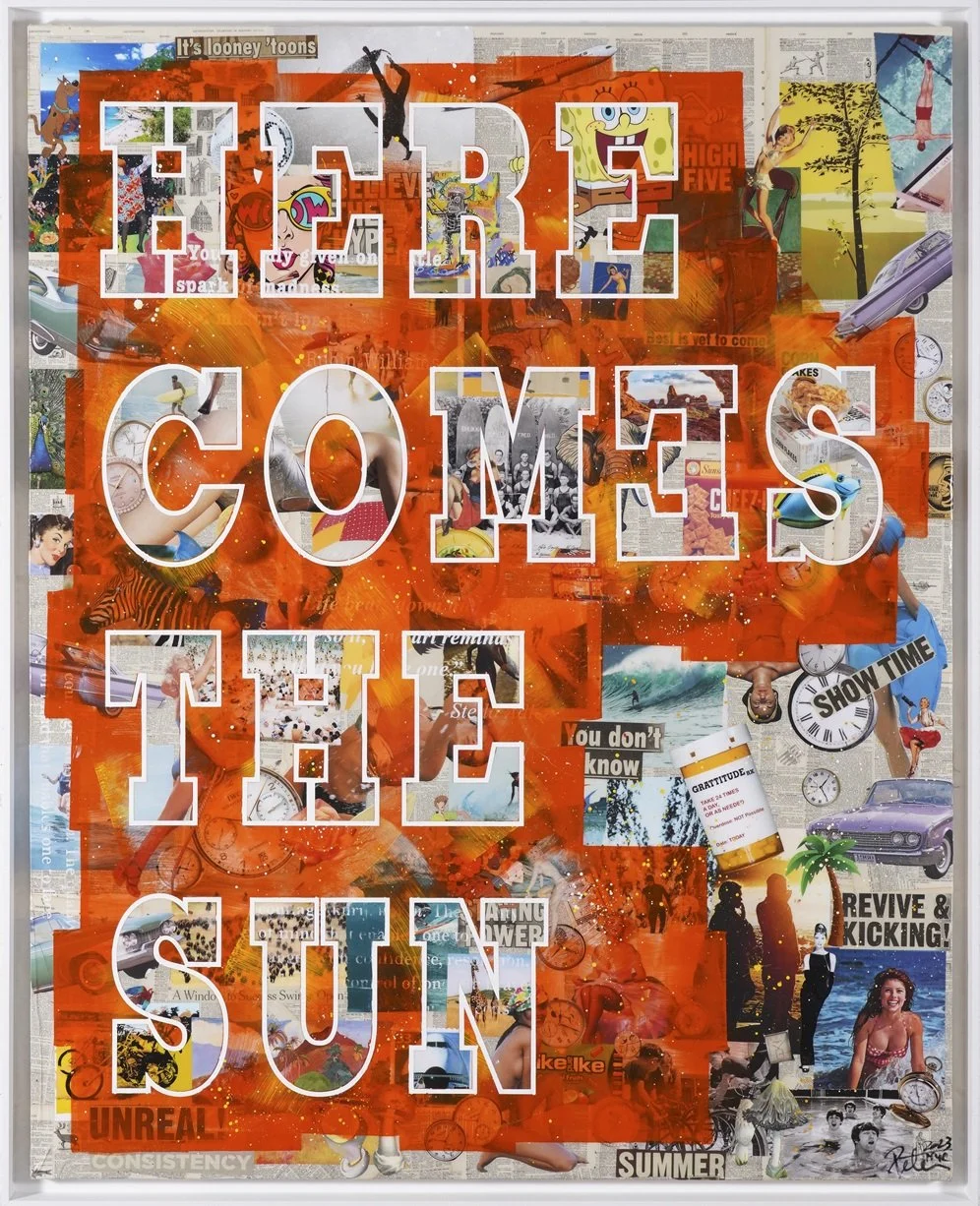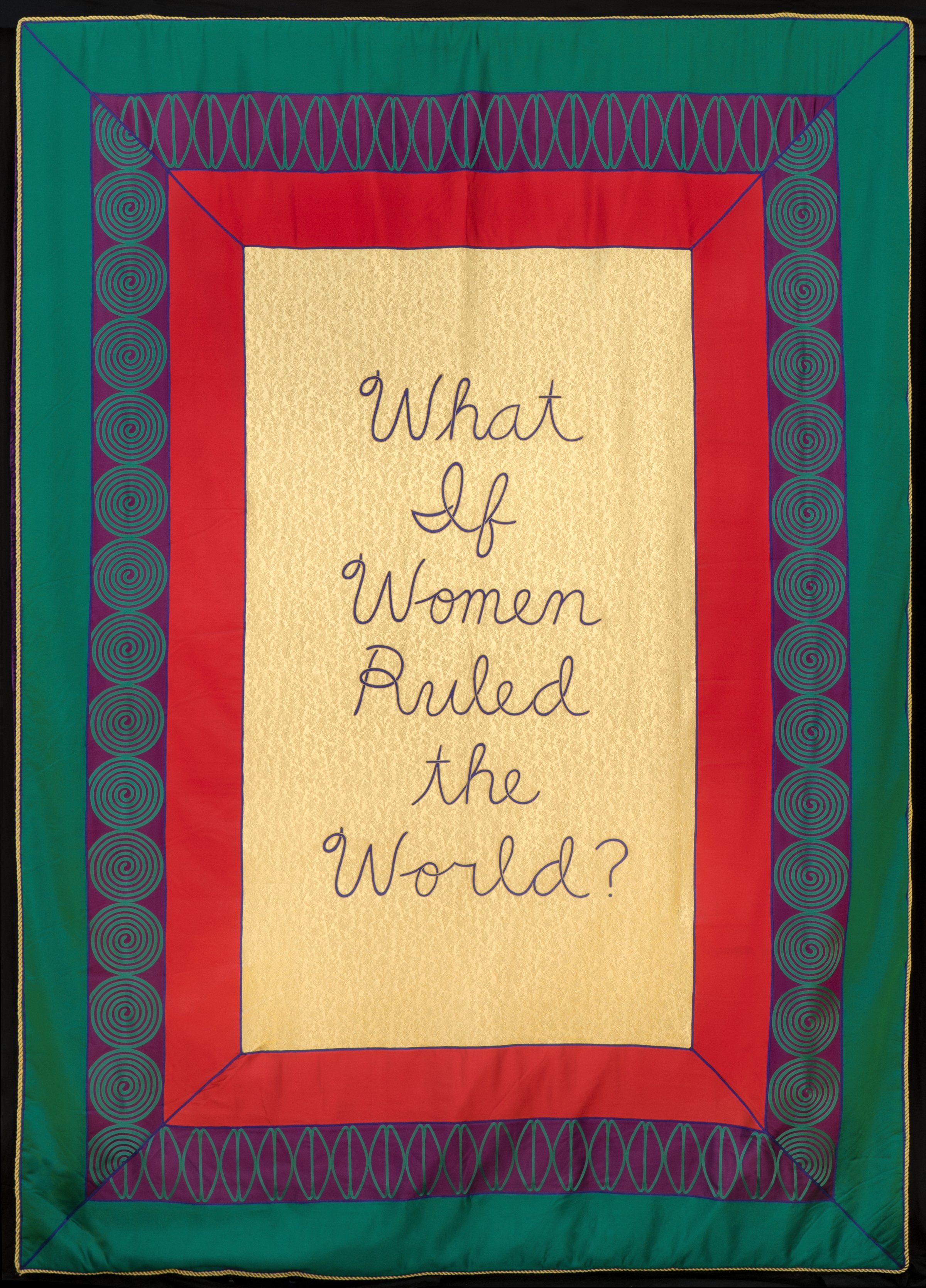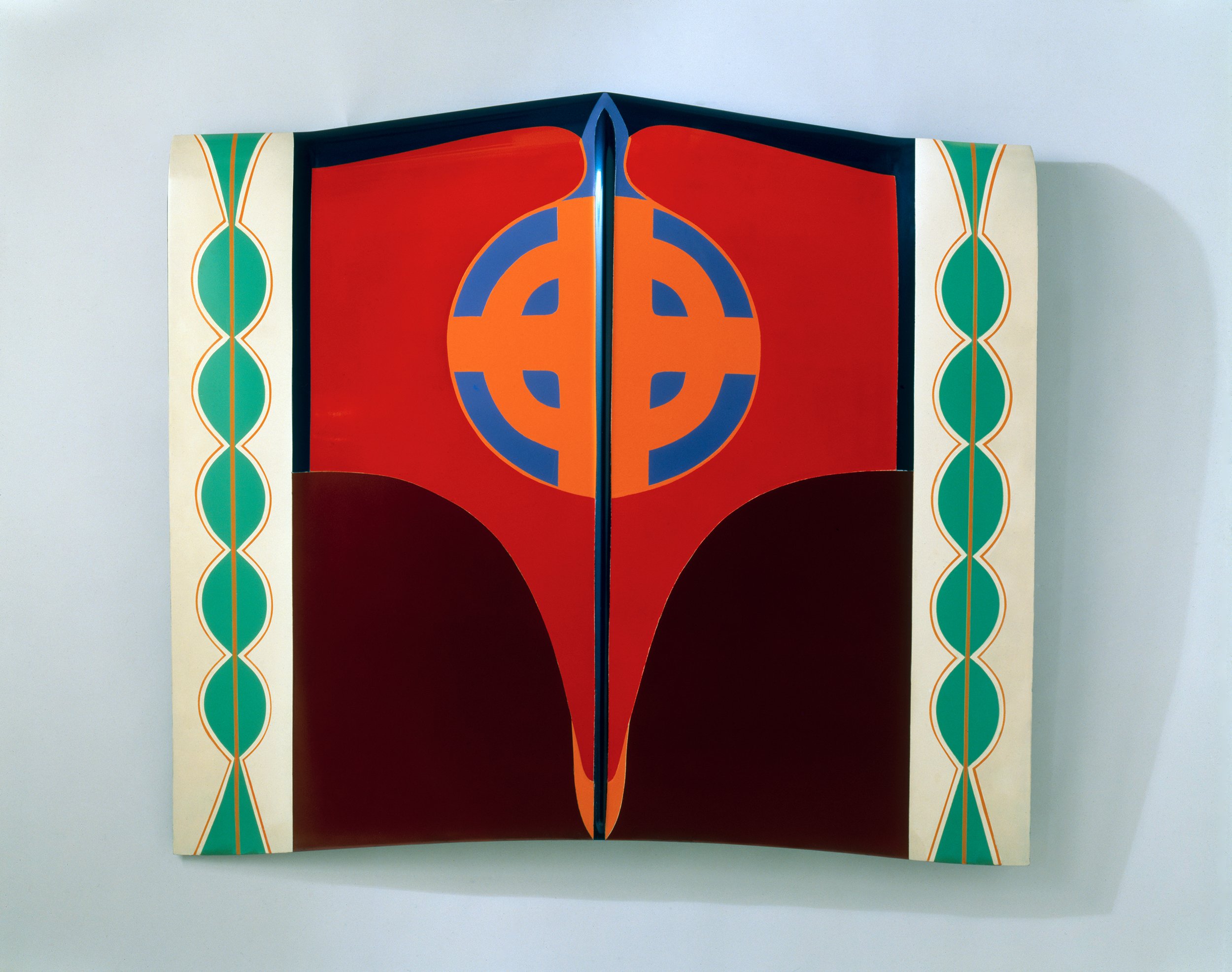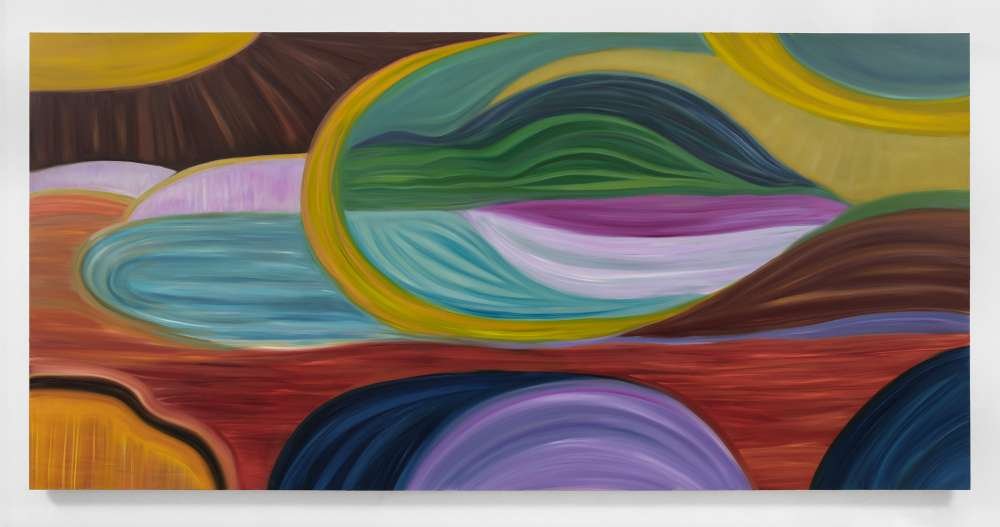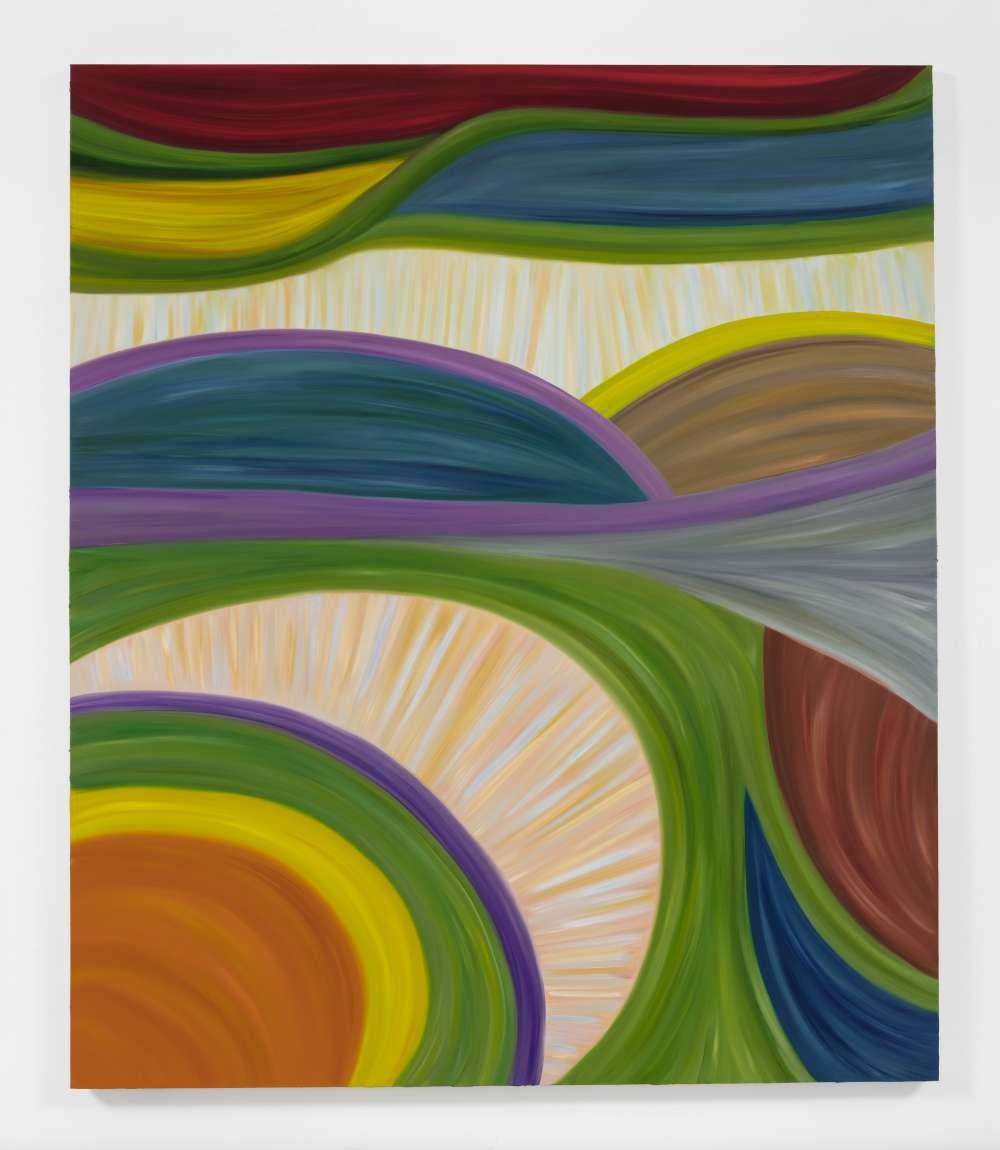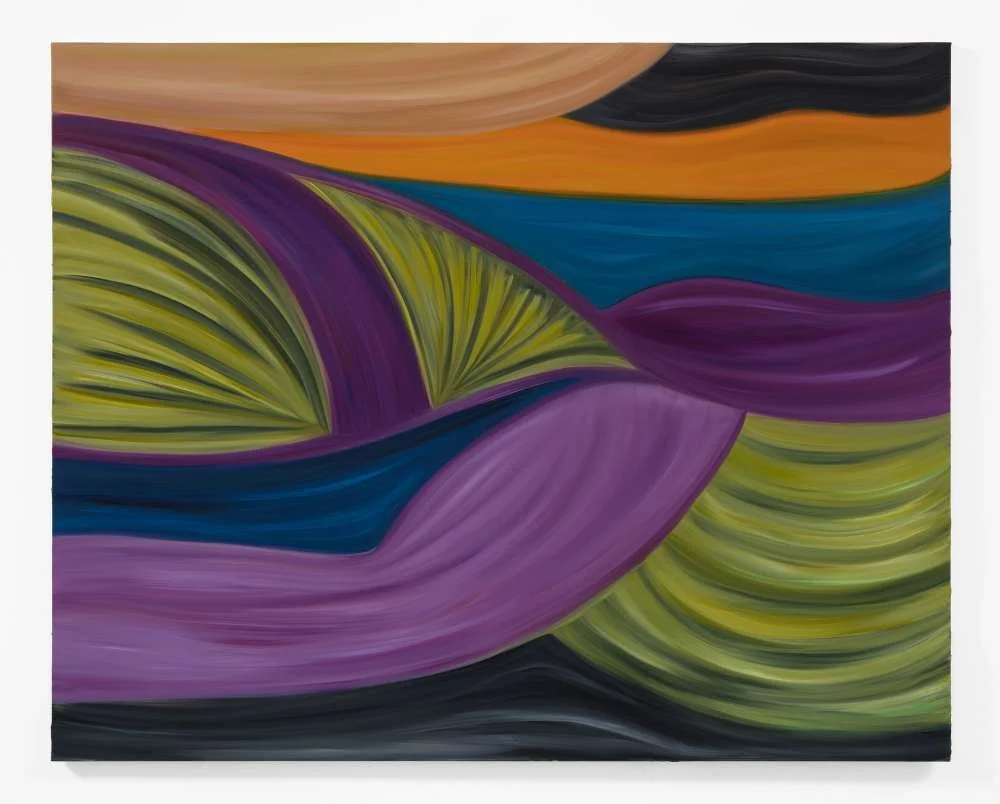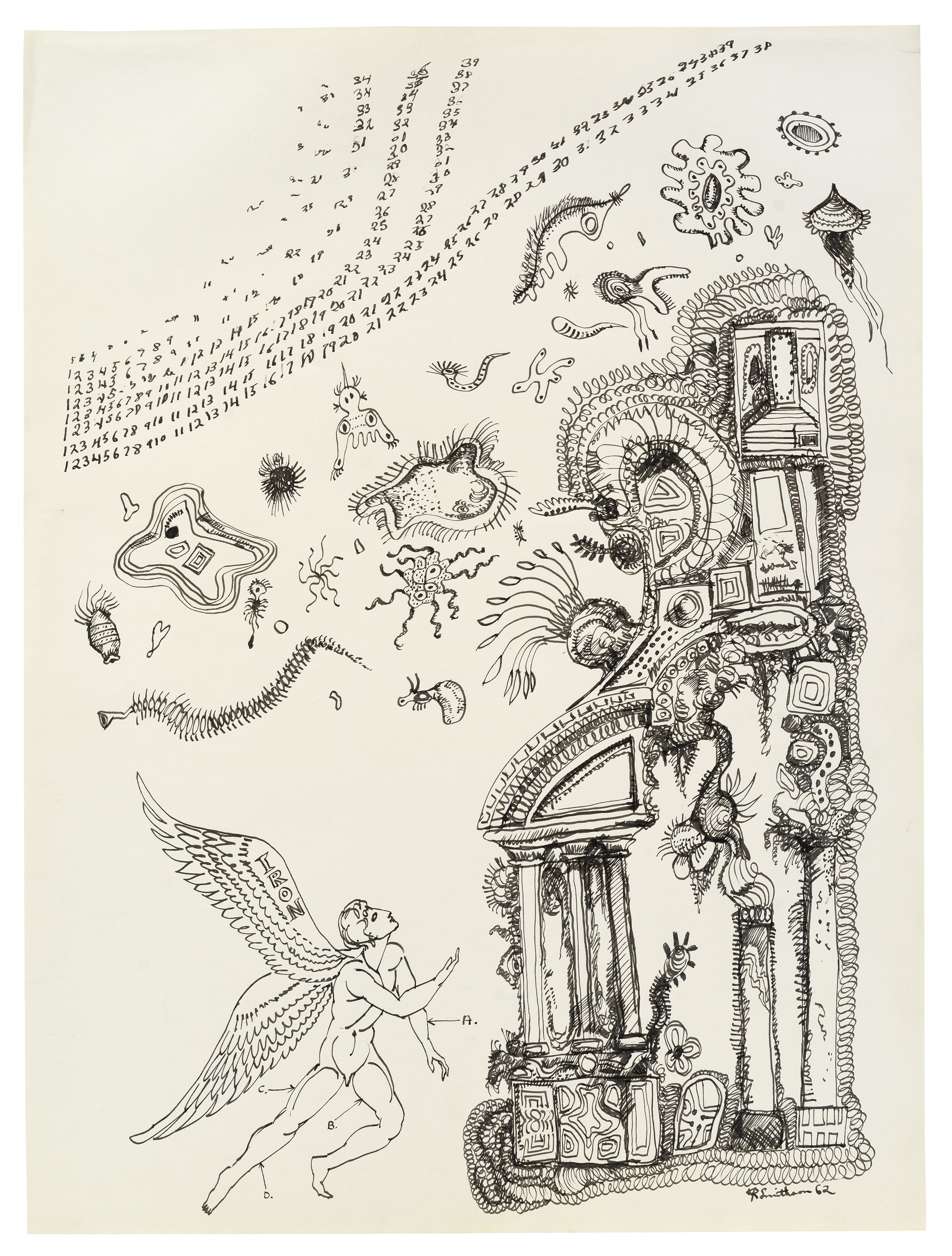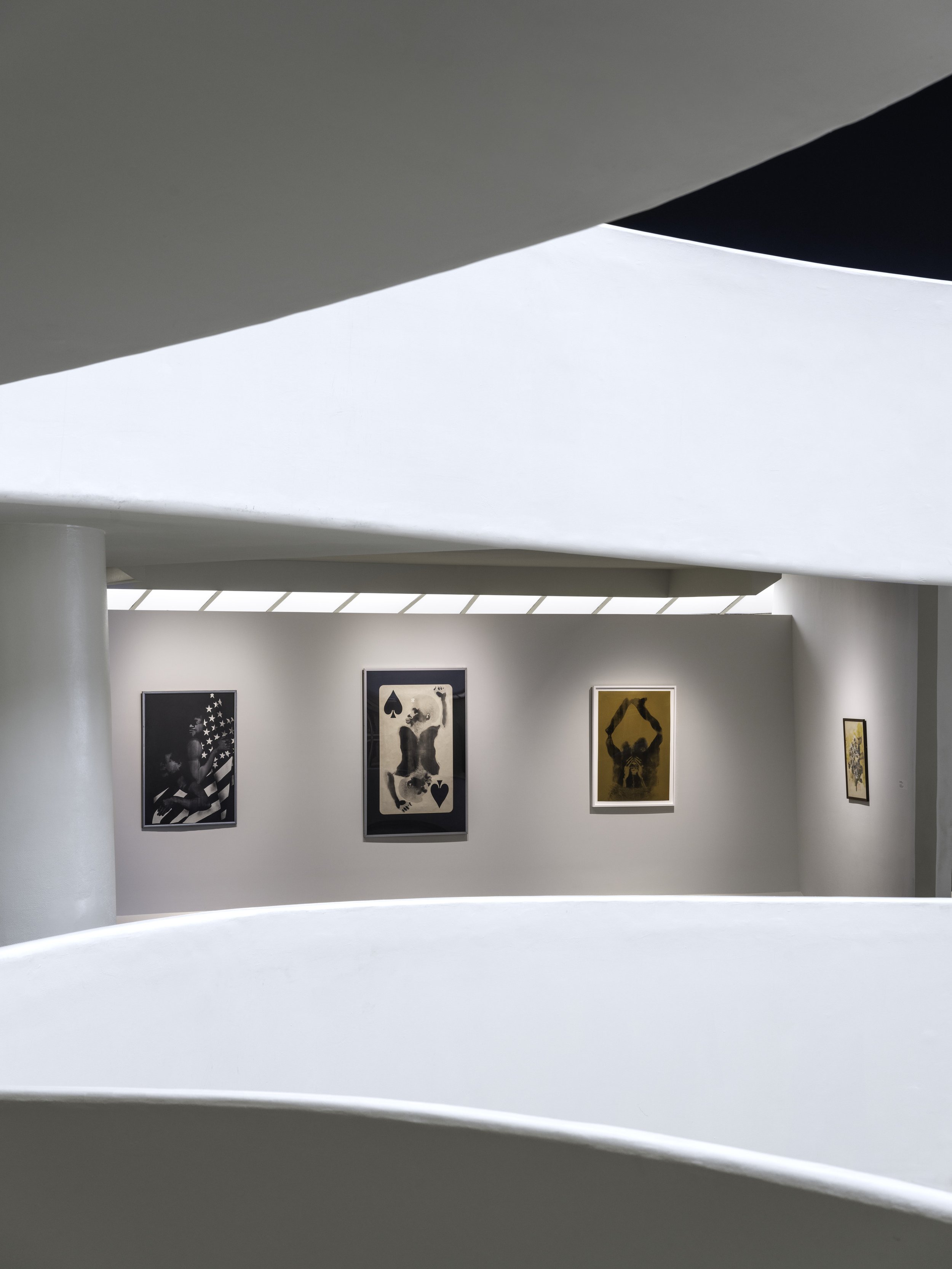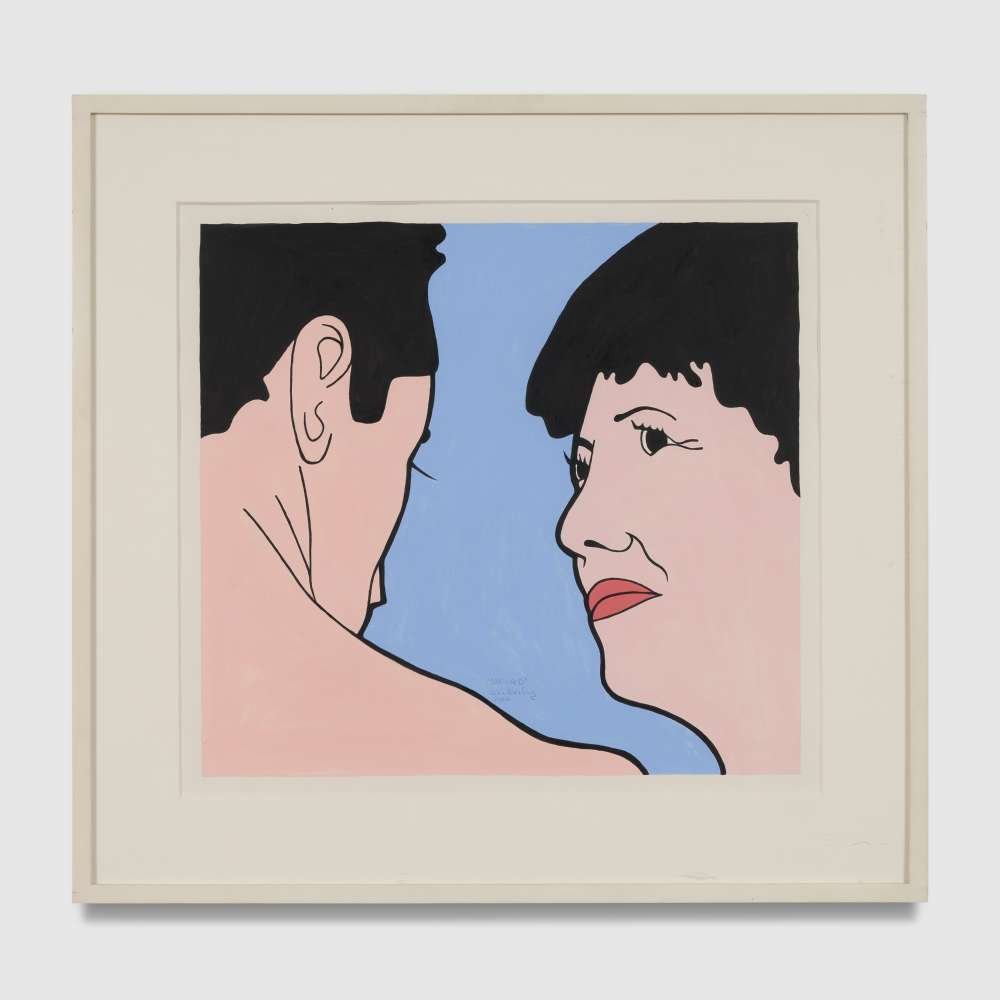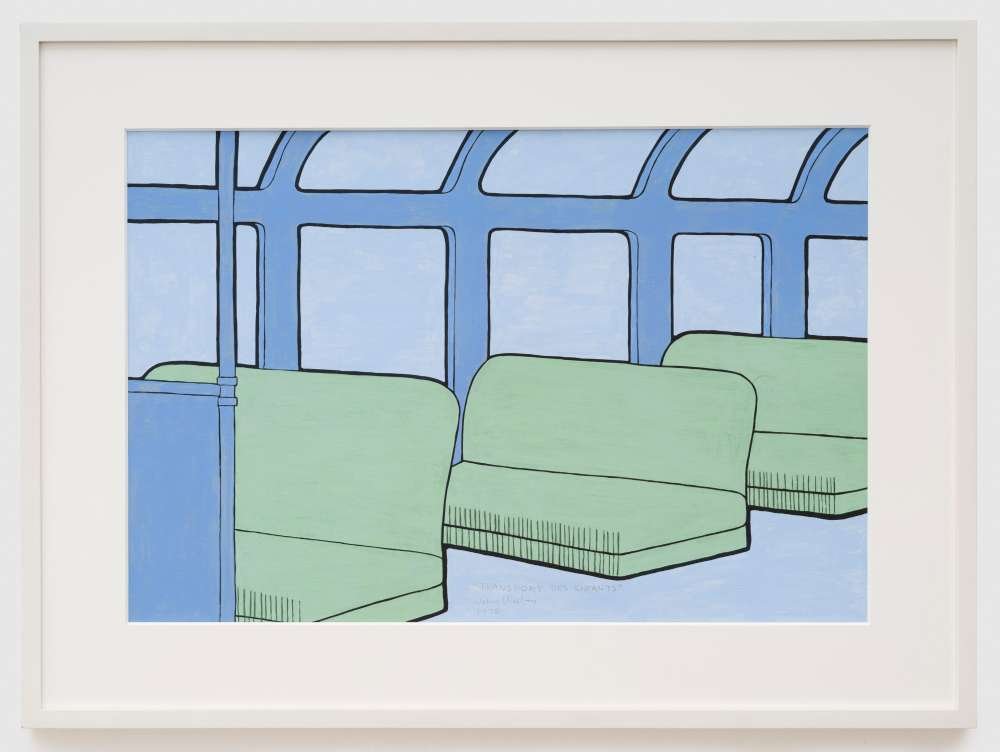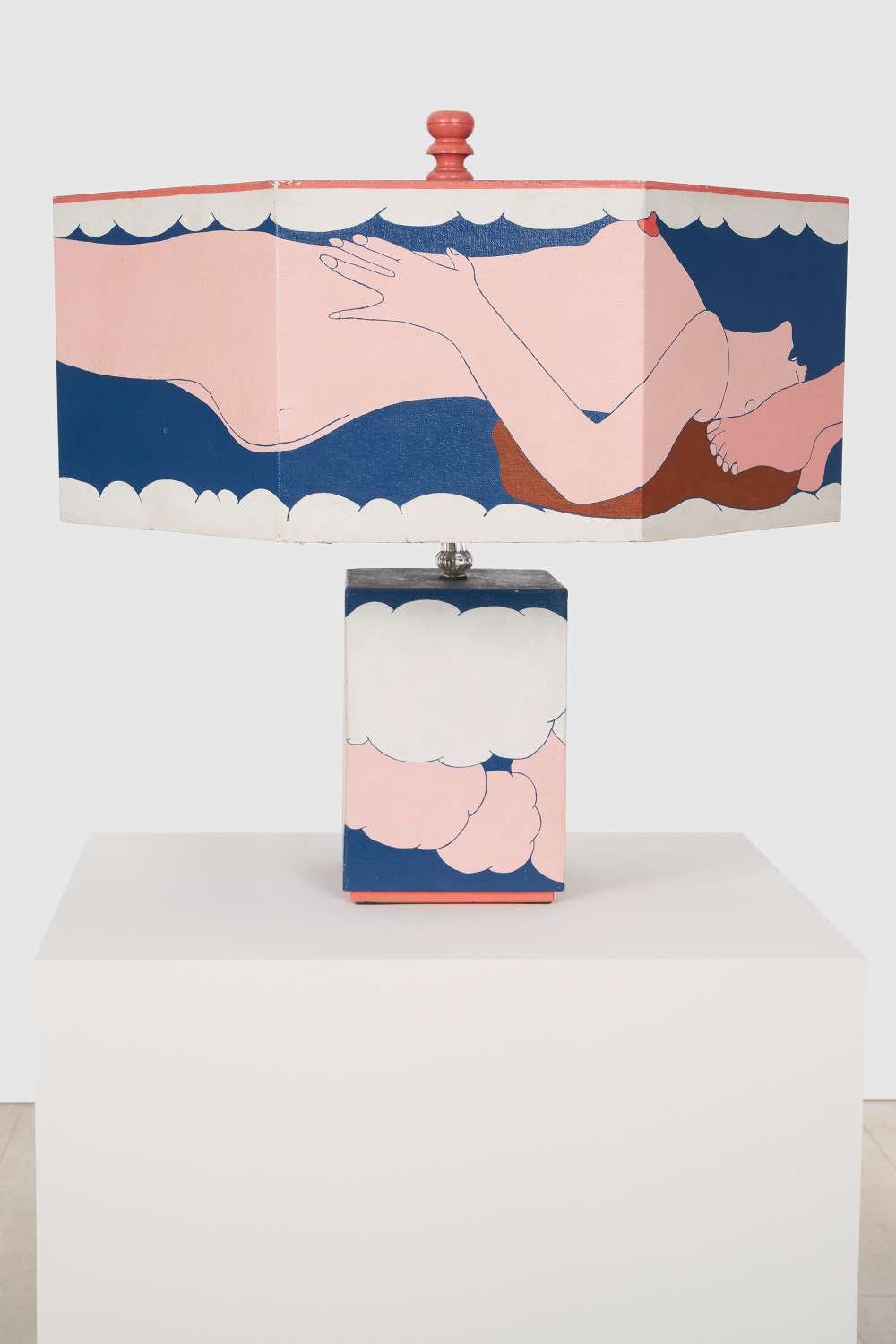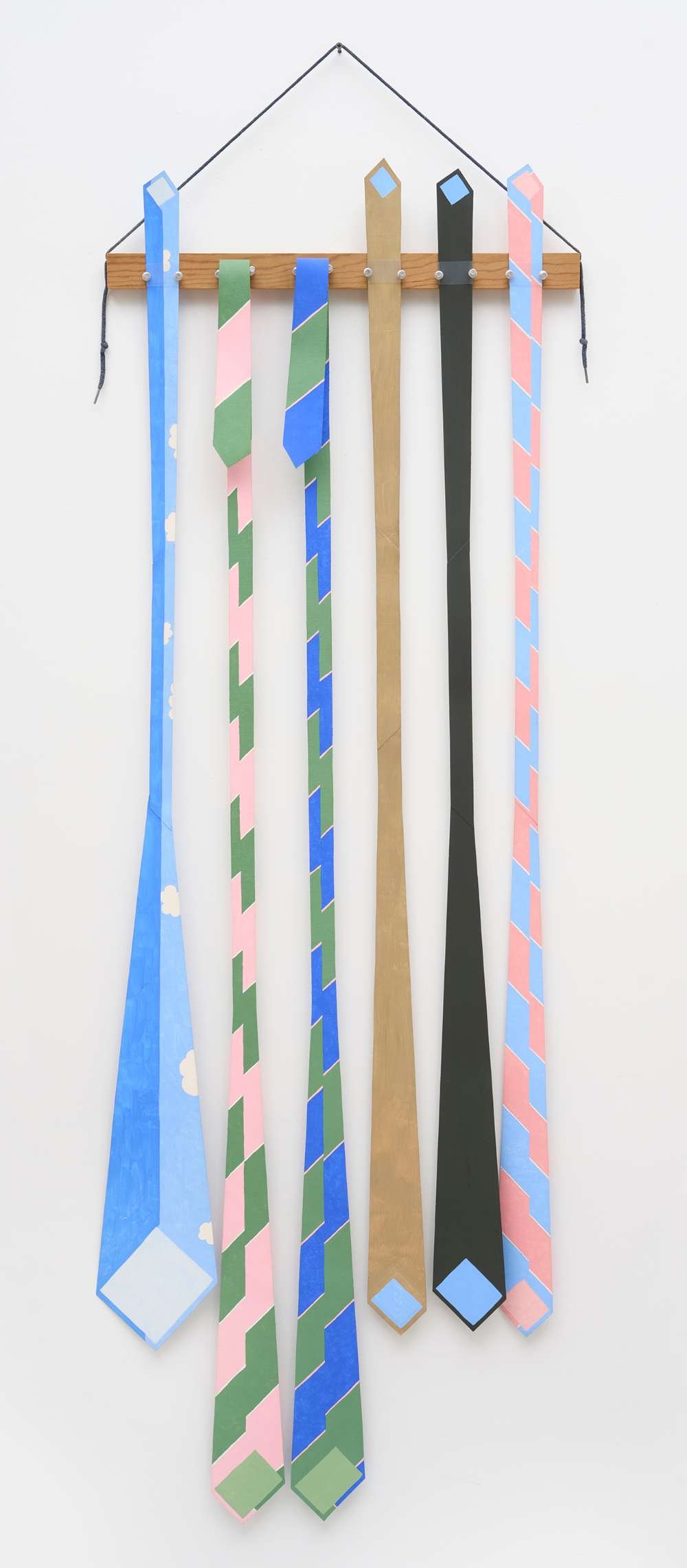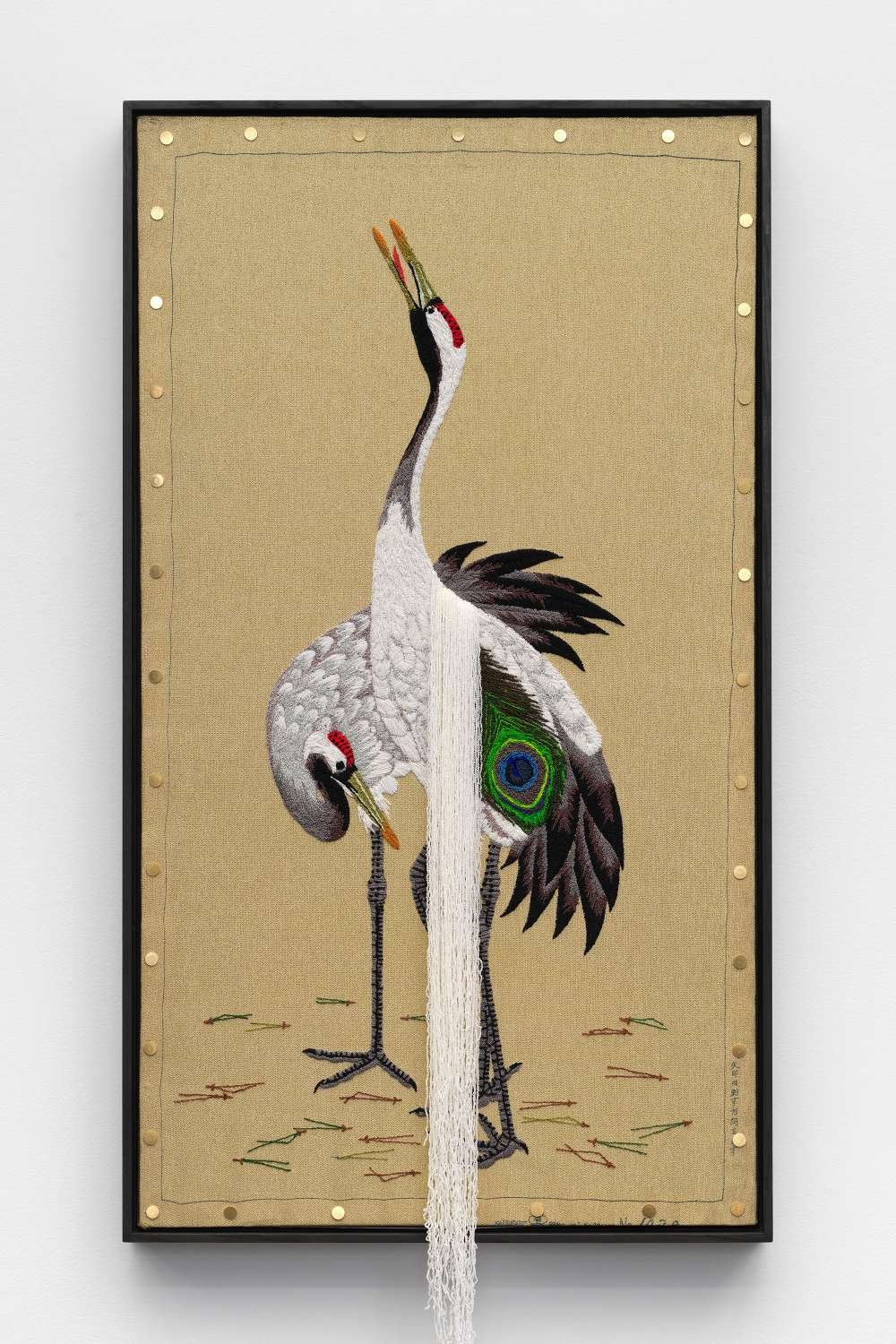BEFORE MIDNIGHT
Matthew Porter Eureka Valley, 2023 27 x 33.5 inch archival pigment print Edition 4 of 5
BEFORE MIDNIGHT – An online exhibition.
To start the new year presents a selection of photographs taken between sunset and midnight – a magical time for photography. Requiring a unique blend of creativity and technical skill, photographs that explore this time can uncover a rich tapestry of emotions, stories, and atmosphere expressing the artist's vision and interpretation of the world.
Thierry Cohen Paris 48° 51' 30'' 2020-11-13 LST 2:06 26 x 40 inch pigment print - Edition of 5 39 x 60 inch pigment print - Edition of 3
The allure of great photography lies not only in the proficiency of its practitioners but also in the artist’s ability to evoke an emotional response.
Robert Frank Lusk, Wyoming, 1956 11 x 14 inch gelatin silver print
Before midnight, the world undergoes a subtle metamorphosis, and during this transition, the photographer has the opportunity to make images that resonate with viewers on a surprisingly profound level.
Glen Luchford, Kate Moss. 1994.
The temporal constraint of the rapidly changing light (not to mention the change in human behavior after dark) challenges photographers to seize the fleeting moment and capture it in a single frame.
Dall-e, A.I. generated print from the prompt: “Joshua Tree at night with three Joshua trees, stars, and a blue line of light at the horizon” 11 x 11 inch archival pigment print Edition of 3
Gerhard Richter
Strip (Strip), 2011 Digital print on paper between Alu Dibond and Perspex (Diasec) © Gerhard Richter 2024 (25012024)
David Zwirner is pleased to present an exhibition of new and recent work by renowned German artist Gerhard Richter at the gallery’s 24 Grafton Street location in London. This marks the gallery’s first presentation of Richter’s work in London since announcing his representation in December 2022, and follows the artist’s recent debut at David Zwirner in New York in spring of 2023.
This considered installation expands upon Richter’s sustained inquiry into the fixity of perception and reaffirms his unwavering commitment to the formal and conceptual possibilities of abstraction. Centrally featured are three of the artist’s celebrated abstract paintings, made in the years preceding his decision to move away from oil paint and turn toward drawing and installation with increasing dedication. An expansive group of new works on paper—some made with ink or pencil, others with a combination of the two—illuminates the newfound urgency and prominence that Richter has placed on method and technique in drawing.
27.6.2023, 2023 Ink and pencil on paper © Gerhard Richter 2024 (25012024)
Richter created the ink drawings, a number of which include unprecedented vividness of colour, by dripping the medium onto paper and shifting around the sheet to produce unexpected forms, further augmenting the improvisatory and captivating freedom of movement unique to this body of work. For the pencil drawings, Richter instead combines various elements from a limited set of forms and techniques—including meandering lines, broad tonal planes applied with angled strokes of graphite, and passages of smudging, hatching, and erasure—thereby uniting choice and chance through this infinitely generative process. These works on paper condense and distill the tenets that have remained central to Richter’s practice throughout his career. As noted by Dieter Schwarz, editor of the artist’s catalogue raisonné of drawings: ‘They are of stringent individuality and recognizably by Richter’s hand, not based on their signature style but rather because they make their theme the act of drawing itself, gauging the conditions of drawing.’
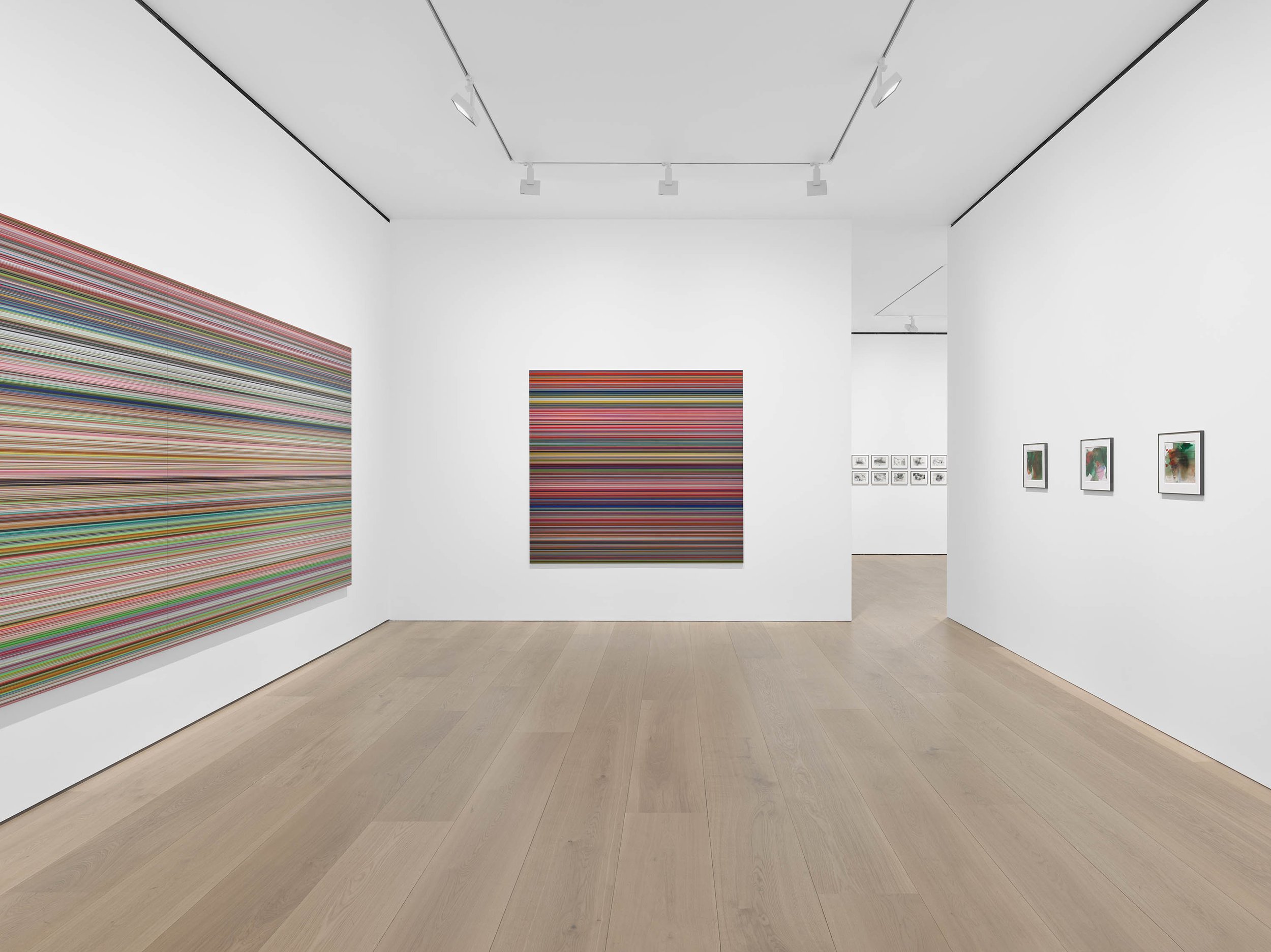




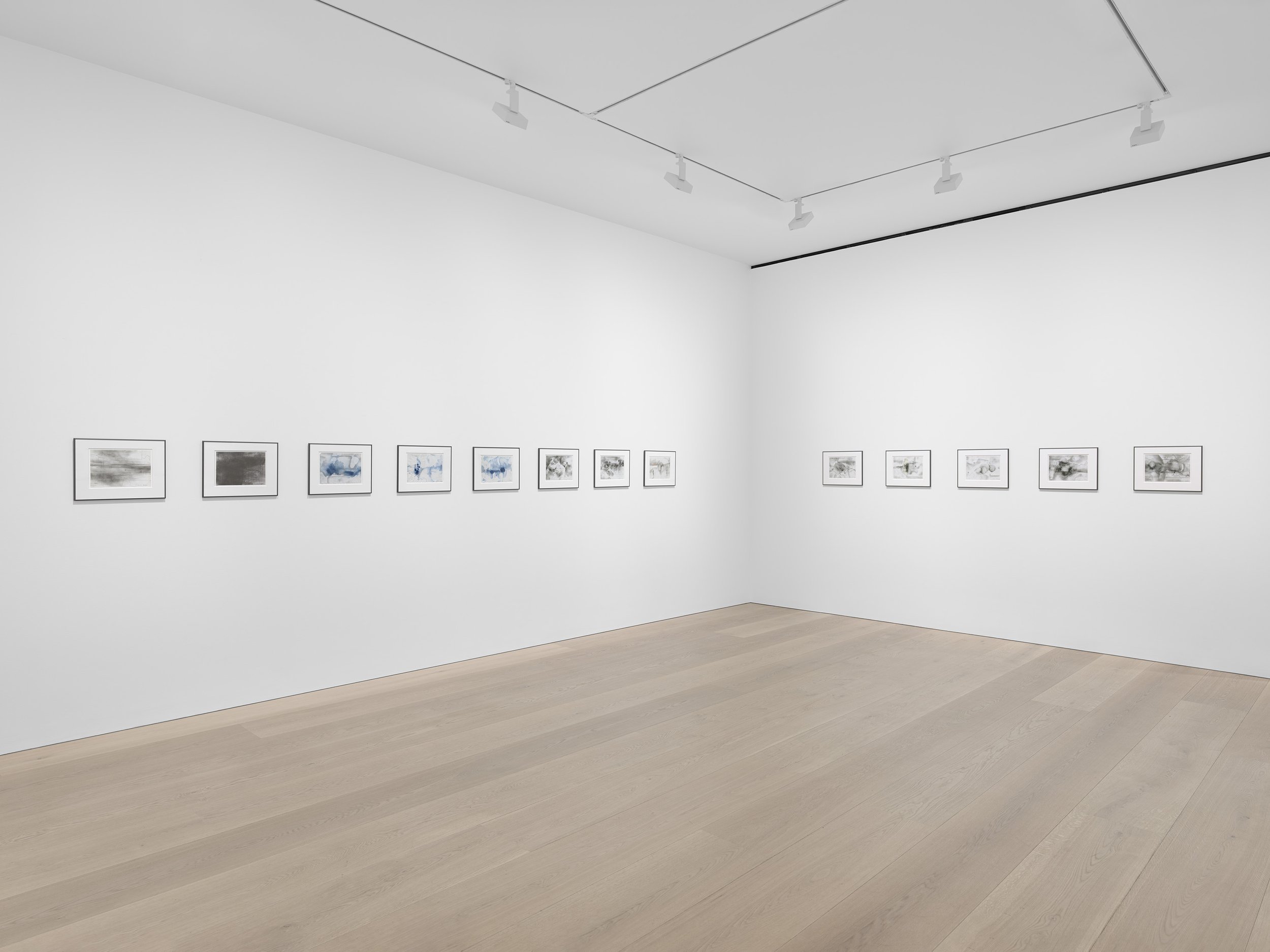


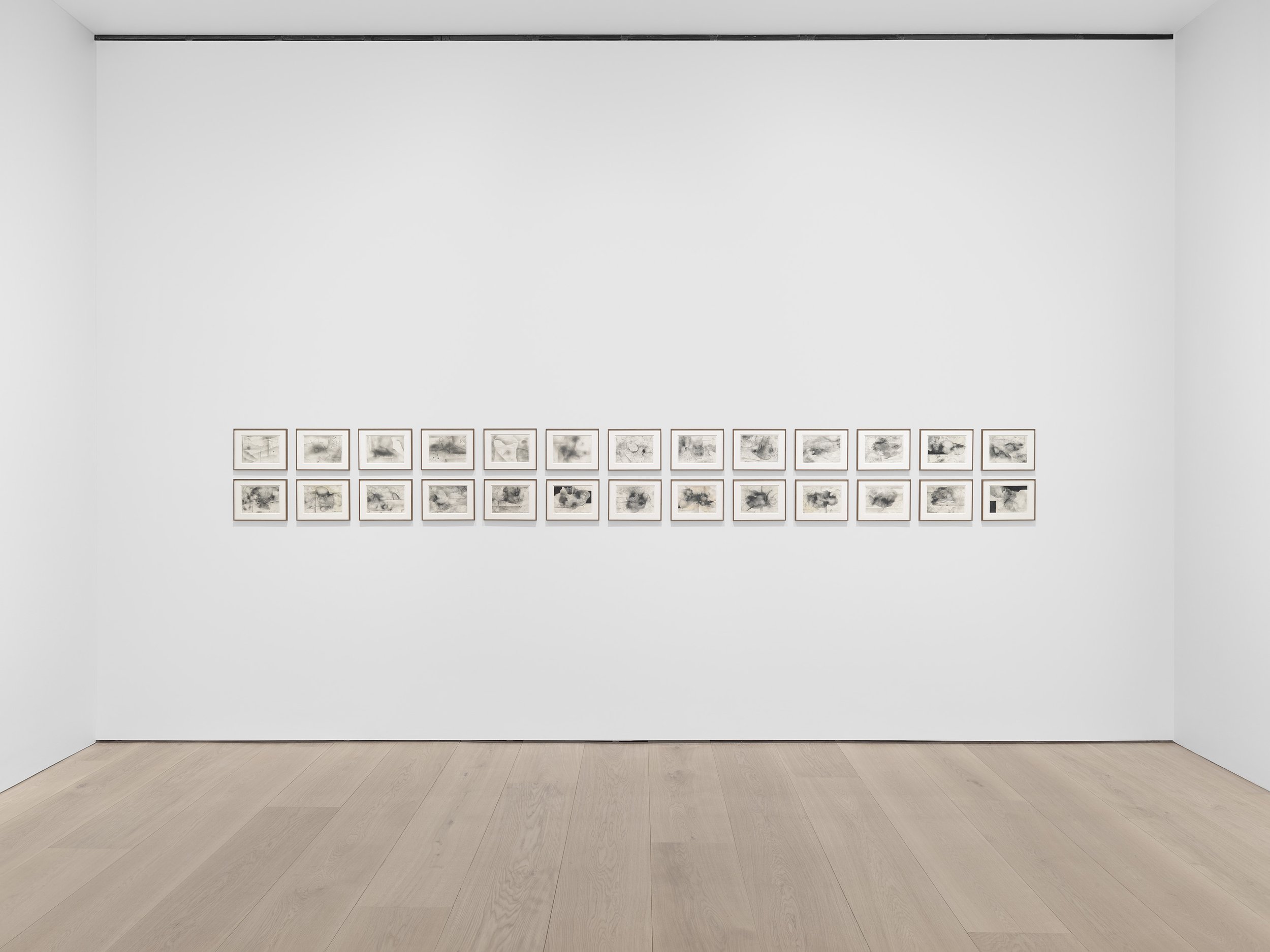


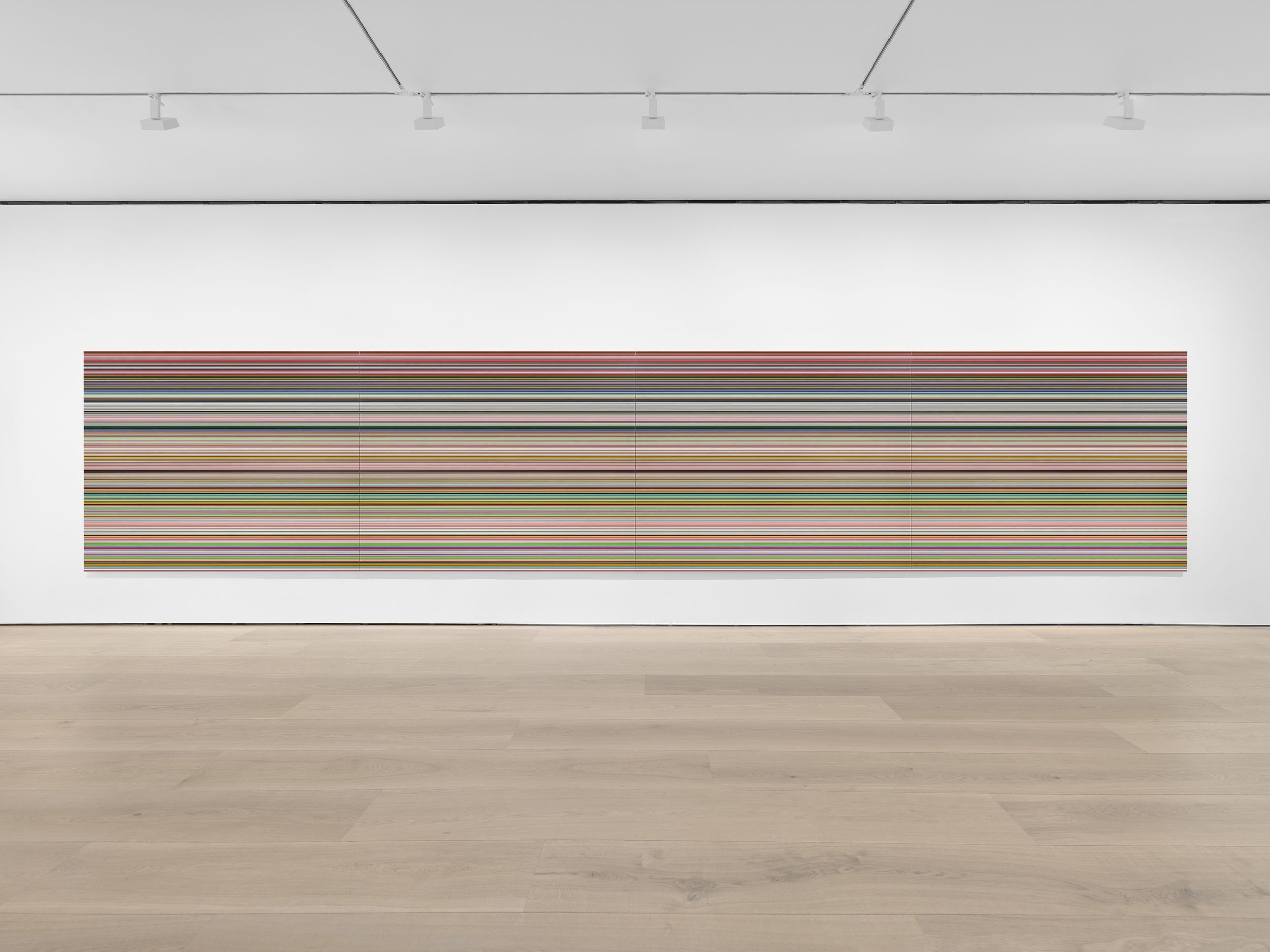
Installation view, Gerhard Richter, David Zwirner, London, 2024. Courtesy David Zwirner
Also featured are important recent works that illustrate Richter’s longstanding interest in the idea of reflection—in both the material and the phenomenological sense of the word. His large-scale paintings and room-sized installations, which are notable for their use of glass and mirrored surfaces, serve as sites for the perpetual creation and contemplation of a new kind of abstract image. On view is a work from Richter’s expansive Spiegel (Mirror) series, which the artist began in the 1980s; comprising wall-mounted panes of glossy tinted glass, they invite viewers to look both at and beyond one’s surroundings. A group of vibrant lacquer-behind-glass paintings from 2010 explore the dual role of paint as conceptual image and physical substance. These works eventually led to Richter’s development of the Strip paintings (begun in 2011), which are derived from a photographic reproduction of one of the artist’s abstract paintings that is then digitally divided, mirrored, and repeated into a glass-mounted print whose pristine surface removes all traces of its maker’s hand. Crucially, Richter classifies the Strips as “paintings” despite their computerized facture, thus positioning the works at a philosophical nexus in which they examine both the historical implications of painting as well as its future possibilities. Gerhard Richter was born in 1932 in Dresden, Germany. He studied art at the Dresden Hochschule für Bildende Künste from 1951 to 1956, with mural painting as his main course of study. In 1959, Richter visited Documenta II, held in Kassel, Germany, an experience that inspired him to alter his artistic trajectory. After his escape from East Germany in 1961, he completed a second course of study at the Staatliche Kunstakademie in Düsseldorf. There, he united with fellow students Sigmar Polke, Konrad Lueg (later known as the gallerist Konrad Fischer), and Manfred Kuttner to collectively form the short-lived “capitalist realism” group. From 1964 onward, Richter has had many solo exhibitions in renowned galleries and museums worldwide. The artist’s first solo exhibition in a public institution was held at the Gegenverkehr, Zentrum für aktuelle Kunst, in Aachen, Germany, in 1969. In 1972 he was selected as the only artist to represent Germany in its national pavilion at the Venice Biennale. Richter has exhibited at Documenta, in Kassel, Germany, more times than any other artist (1972, 1977, 1982, 1987, 1992, 1997, 2007, and 2017). Richter’s work has been presented in numerous solo and retrospective exhibitions at important institutions worldwide, including the Kunstverein für die Rheinlande und Westfalen, Düsseldorf (1971, 1986); Kunsthalle Bremen, Germany (1975); Centre Pompidou, Paris (1977, 2012); Städtische Kunsthalle, Düsseldorf (1986); Neue Nationalgalerie, Berlin (1986, 2012, 2023); Hirshhorn Museum and Sculpture Garden, Washington, DC (1988, 2003); San Francisco Museum of Modern Art (1989, 2002); Tate, London (1991, 2011); Moderna Museet, Stockholm (1993); Art Institute of Chicago (2002); The Museum of Modern Art, New York (2002); Queensland Art Gallery, Brisbane (2017); The Met Breuer, New York (2020); and The National Museum of Modern Art, Tokyo (2022). In April 2023, the Neue Nationalgalerie in Berlin opened Gerhard Richter: 100 Works for Berlin. This special long-term presentation features works that the Gerhard Richter Kunststiftung gave to the museum on permanent loan in 2021, including Richter’s Birkenau cycle of large-scale abstract paintings from 2014.
17.7.2023, 2023 Colored ink and pencil on paper © Gerhard Richter 2024 (25012024)
Richter has been honoured with a number of significant awards, among them the Kunstpreis Junger Westen, Kunsthalle Recklinghausen, Germany (1967); Arnold-Bode-Preis, Kassel, Germany (1981); Oskar-Kokoschka-Preis, Vienna (1985); Goslarer Kaiserring, Goslar, Germany (1988); Golden Lion at the 47th Venice Biennale (1997); Praemium Imperiale Award, Japan Art Association, Tokyo (1997); Wexner Prize, Wexner Center for the Arts, Columbus, Ohio (1998); Foreign Honorary Membership of the American Academy of Arts and Letters, New York (1998); Staatspreis des Landes Nordrhein-Westfalen, Düsseldorf (2000); and the Kunst- und Kulturpreis der deutschen Katholiken, Deutsche Bischofskonferenz, Bonn, Germany (2004). In 2007 Richter received honorary citizenship of Cologne, Germany. In the same year, he designed a spectacular stained-glass window for the Cologne Cathedral. Works by the artist are held in important public and private collections worldwide. Richter lives and works in Cologne.
This exhibit opened on January 25th and will conclude on March 28th, 2024. For more information about this exhibit, visit David Zwirner’s site , along with following them on Instagram and find the gallery also on Artsy here.
Josèfa Ntjam : Futuristic Ancestry: Warping Matter and Space-time(s)
Installation views: “Josèfa Ntjam: Futuristic Ancestry: Warping Matter and Space-time(s)” Fotografiska., NYC, 2024, Photography Credit: Leandro Justen. Courtesy of Fotografiska New York
Fotografiska New York, presented French multimedia Genre-Defying Artist Josèfa Ntjam’s First-Ever Solo U.S. Museum Show on February 2, 2024, and the exhibition will run through May 2024. The exhibition titled Futuristic Ancestry: Warping Matter and Space-time(s) includes dozens of never-before-seen works.
The show, titled Futuristic Ancestry: Warping Matter and Space-time(s), will feature a selection of new works, including biomorphic sculptures and photomontages printed on plexiglass and aluminum. The show also presents the U.S. debut of Matter Gone Wild, an immersive video installation that bends perceptions of space, time, historical narrative, and cultural identity as it pushes the limits of moving-image technology. Directed by Ntjam in collaboration with Sean Hart and Nicolas Pirus, Matter Gone Wild follows the stories of extraterrestrials revolting against systems of oppression through collective struggle, offering a broader reflection on present-day political realities.
Throughout her collages, narratives, and references, Ntjam blends memory with historical fact, the incorporation of personal and family archives, and speculative fiction (from Battlestar Galactica to the novels of Octavia E. Butler) to produce new interpretations of radical liberation movements around the world, from the battle against white supremacy led by the Black Panther Party in the U.S. to the fights in Cameroon and Nigeria against colonial power.
Installation views: “Josèfa Ntjam: Futuristic Ancestry: Warping Matter and Space-time(s)” Fotografiska., NYC, 2024, Photography Credit: Leandro Justen. Courtesy of Fotografiska New York
The exhibition plunges visitors into an immersive and alternative ecosystem that suggests how disparate movements are intertwined through a global demand for liberation. Powered by mythologies from across the African continent and the limitless horizons of science fiction, Ntjam’s work imagines new possibilities for the future with a nod to the past.
“Josèfa Ntjam’s work combines disciplines, ideas and images in ways that were previously unimaginable,” said Jessica Jarl, Global Director of Exhibitions at Fotografiska. “It is a rare privilege to be able to debut such extraordinary work so early in an artist’s career.”















Installation views: “Josèfa Ntjam: Futuristic Ancestry: Warping Matter and Space-time(s)” Fotografiska., NYC, 2024, Photography Credit: Leandro Justen. Courtesy of Fotografiska New York
Ntjam (b. 1992, Metz, France) is best known for her work that blends science fiction, history, and fantasy to present alternative narratives of African diasporic experiences. Across multiple mediums, her practice deconstructs mainstream discourses on origin, identity, and race. The artist, who earned a degree from the École Nationale Supérieure d’Art, has been featured in exhibitions at the Stedelijk Museum in Amsterdam and the Barbican Art Gallery in London.














Photography Credit: Leandro Justen. Courtesy of Fotografiska New York
Programming highlights for this exhibition include an invitation for all Fotografiska members to celebrate the opening night which had a performance by Sun Ra Arkestra, the renowned experimental Jazz group, alongside the artist.
About Fotografiska
Fotografiska is the contemporary museum for photography, art, and culture. Founded in Stockholm in 2010 and led globally by its Chairman Yoram Roth, Fotografiska is a destination to discover world-class photography, eclectic programming, elevated dining, and surprising new perspectives.
For more information about this exhibition and others at Fotografiska New York, please visit their site here. The museum can also be found on Instagram and Facebook.
Art Wynwood
Courtesy of Art Wynwood
Art Wynwood will be taking place Feb 14-18 (VIP Preview 2/14 benefitting the Bass Museum); this annual winter event provides a unique platform for art enthusiasts to explore over 50 contemporary, emerging, and modern art galleries from the Miami/Southern Florida region, and from across the United States like NYC, The Hamptons , and Dallas to international galleries from London, Italy, Germany, France, Spain, Venezuela and more (over 500 artists will be shown, representing a diverse array of works including pieces from the 20th and 21st centuries, post-war, pop and street art, and various modern & contemporary genres), just a few artists being shown include Derrick Adams, Damien Hirst, Alex Katz, Jeff Koons, Wifredo Lam, Gloria Lorenzo, Henri Matisse, JD Miller, Gina Pellón, René Portocarrero, Ugo Rondinone, Andy Warhol, world-renowned photographer David Yarrow, and Ukraine-based gallery Kedria Arts will be showing 5 exceptional Ukrainian artists. Art Wynwood will also bestow its 2024 Lifetime Achievement Award to one of Miami’s most influential artists , Peter Tunney , who will have a special booth exhibiting a show of new works (his art will also be featured on an outdoor mural flanking the fair entrance), and for the 4th consecutive year, the fair has partnered with the Discover Boating Miami International Boat Show next door, enhancing the cultural experience on Biscayne Bay with the world’s largest boat and yacht show.
Jeff Koons -Monkey Train (Birds) (shown by Zeit Contemporary Art)
Zeit Contemporary Art based in NYC at 590 Madison Avenue will be showing: Alex Katz, Jeff Koons, Sol Lewitt, Robert Mangold, Henri Matisse, Nelo Vinuesa, Andy Warhol.
Kedria Arts, founded by sculptor Oleg Kedria and based in Kiev, Ukraine with another location in Detroit will be showing five Ukrainian artists: Alina Bauer, Oleg Kedria, Mykola Khodorovsky, Zhanna Thomas, Igor Tulipanov.
Alex Katz- suite of Ada (shown by Adamar Fine Art)
Adamar Fine Arts is a 37 year old gallery in Miami that represents contemporary masters (mostly in print) and a small group of internationally renowned mid-career artists; among the artists they will show at Wynwood: Derrick Adams, Damien Hirst, Alex Katz, Ugo Rondinone, Donald Sultan.
Cernuda Arte, based in Coral Gables, will be showing an exciting roster of all Cuban-born artists: Carlos Alfonzo, Wifredo Lam, Amelia Peláez, René Portocarrero, Gina Pellón, Manuel Mendive, José Bedia, Danuel Méndez, Enrique Casas, and Yasiel Elizagaray.
Antonio Sannino -Under Construction Sea VI (shown by Liquid Art System)
Liquid Art System is a gallery originally based in Capri that just opened a second gallery in Miami in Dec, they will be showing over 15 artists at Art Wynwood including: Silvia Berton, Peter Demetz, Marco Grassi, Antonio Sannino.
JD Miller- The Perfect Wave (shown by Samuel Lynne Galleries)
Samuel Lynne Galleries, with locations in Dallas, Houston and Chicago, will be showing: world renowned photographer David Yarrow, JD Miller (a brilliant painter with a career spanning over 25 years and creator of a unique 3-Dimensional Oil technique), Lea Fisher (a protégée of JD Miller who has captivated audiences with her unique take on oil painting), Tanner Lawley (contemporary artist who was awarded "Top 50 Artists to Watch" by Art Business News).
Imaginart.Gallery based in Coral Gables will exhibit a solo show of work by Cuban-born/Coral Gables-based Gloria Lorenzo.
Courtesy of Peter Tunney
Art Wynwood will bestow its 2024 Lifetime Achievement Award to visual artist Peter Tunney, a genuine force of nature with boundless creative energy, spreading his positive messages in unconventional ways while delivering works of art to a worldwide collector base for over 30 years. He creates in almost every medium: paint, collage, wood, photography, found objects, and discarded materials. His nontraditional life, a cache of extraordinary experiences, and countless wild adventures serve as the foundations for his work. In addition to his current Tribeca space, Tunney has maintained a gallery in the heart of Miami’s famed Wynwood Walls for the last eight years.
Peter Tunney- INVINCIBLE SUMMER (6ft x 8ft)
The Peter Tunney Experience is a fixture in the thriving Wynwood neighborhood (previous Art Wynwood Lifetime Achievement Award recipients include Mel Ramos, Martha Cooper, Shepard Fairey, Logan Hicks, Ron English). Here’s some words from Peter Tunney about his special booth/show, Invincible Summer (inspired by the words of Albert Camus): “I have been immersed in Invincible Summer since I first stumbled upon the passage by Albert Camus. Thousands of quotes and snippets flood into my mind and studio regularly, but this one pierced my heart and resonated with me in my core. It gave me the way. It articulated for me something that I’ve been feeling for decades but was unable to express.
Peter Tunney- ALBERT CAMUS
Since Jan. 2023, “Invincible Summer” has been in the DNA of my practice of art making and daily meditation. It is the lens through which I’ve been processing all aspects of life. I might even say that these words have changed the trajectory of my life going forward. Words do matter.”
Peter Tunney- HERE COMES THE SUN (6ft x 8ft)
Art Wynwood is hosted by Art Miami and is returning for its 11th edition during Presidents Day Weekend. The event provides a unique platform for art enthusiasts to explore and collect contemporary, emerging, and modern art from over 50 international galleries. Known for showcasing diverse artistic expression, Art Wynwood will take place at One Herald Plaza (NE 14th Street & Biscayne Bay), Miami, FL 33132.
Fair Hours:
Platinum VIP Preview: Wednesday, February 14: 4:30 – 6 p.m.
VIP Preview: Wednesday, February 14: 6 – 10 p.m.
General Admission:
Thursday, February 15: 11 a.m. – 7 p.m.
Friday, February 16: 11 a.m. – 7 p.m.
Saturday, February 17: 11 a.m. – 7 p.m.
Sunday, February 18: 11 a.m. – 5 p.m.
For more information about Art Wynwood, please see their site here. Art Wynwood can also be found on Instagram and Facebook.
Gary Simmons: Public Enemy
Installation view: Gary Simmons: Recapturing Memories of the Black Ark, 2014-15. Prospect 3, New Orleans, Louisiana. October 25, 2014 - January 25, 2015. Courtesy of the artist and Hauser & Wirth, Los Angeles. © Gary Simmons. Photo: Scott McCrossen/FIVE65 Design
Pérez Art Museum Miami (PAMM) is pleased to present Gary Simmons: Public Enemy, which opened on December 5, 2023. The exhibition, co-organized with the Museum of Contemporary Art Chicago, is the first comprehensive career survey of the richly layered work of Gary Simmons and features nearly 70 sculptures, paintings, photographs, works on paper, and installations, as well as a number of large-scale wall drawings the artist will create on-site.
Since the late 1980s, Simmons has played a key role in situating questions of race, class, and identity at the center of contemporary art discourse. Notable for his early application of appropriated pop-cultural imagery, Simmons’ work aims to analyze and expose histories of racism in visual culture. Over the course of his career, Simmons has revealed traces of these histories in sports, cinema, literature, music, architecture, and urbanism, while drawing heavily on genres such as hip-hop, horror, and science fiction.
Hollywood, 2008. Pigment, oil paint, and cold wax on canvas. 84 × 120 in. Rubell Museum. © Gary Simmons
“We’re proud to present the work of Gary Simmons, which encapsulates the essence of our nation’s culture and history to urge us to explore the depth of our own stories. Simmons compels us to confront our shared past while embracing the possibilities of our collective future — serving as a powerful reminder that art has the remarkable ability to weave together important narratives of our time,” said PAMM Director Franklin Sirmans.
Organized in sections ranging from miseducation to erasure to recurrence, Public Enemy spans 30 years of the artist’s highly disciplined production. Guided by an internal logic, Simmons’ approach is cool, analytical, and unflinching in its interrogation of intense historical narratives, yet the results consistently deliver a strong emotional charge. The exhibition offers audiences a timely opportunity to gain a holistic understanding of the complex and profoundly moving work of this groundbreaking and influential artist.











Exhibition highlights include: Lineup (1993) in which eight pairs of gold-plated athletic sneakers sit neatly arrayed on a platform under a police wall chart lineup used to identify suspects’ height; Step into the Arena (The Essentialist Trap) (1994), a boxing ring with a chalkboard drawing on the floor demonstrating the footwork for the Cakewalk dance and tap shoes dangling from the ropes, referencing the ways in which African American men have been exploited for entertainment in sports, the performing arts, and cinema; and Recapturing Memories of the Black Ark (2014-ongoing), an interactive sculptural installation inspired by Lee “Scratch” Perry’s Black Ark reggae recording studio in Jamaica on which local performers will activate the work throughout the exhibition run. These installations will accompany a vast selection of pictorial works featuring Simmons’ signature technique—a striking erasure effect that he achieves by executing an image to its completion then smearing it with his hands.
“This comprehensive survey of Gary Simmons’ complex, hard-hitting work, is both long overdue and timely. Posing sharp questions about what we, as individuals and as a society, remember and what we are made to forget, Simmons’ work touches on urgent political issues while probing the spaces between history and collective memory.” said MCA James W. Alsdorf Chief Curator René Morales.
Gary Simmons: Public Enemy is curated by René Morales, James W. Alsdorf Chief Curator, and Jadine Collingwood, Assistant Curator, with Jack Schneider, Curatorial Associate, of the Museum of Contemporary Art Chicago. The exhibition is accompanied by a major exhibition catalogue and a slate of related programming.
Major support for this exhibition is provided by the Terra Foundation for American Art
At Pérez Art Museum Miami, the exhibition is presented by Citi with lead individual support from Patricia and William Kleh. Support from Ford Foundation, the Andy Warhol Foundation for the Visual Arts and Funding Arts Network is gratefully acknowledged.
© Gary Simmons. Photo: Tito Molina/HRDWRKER. Courtesy of the artist and Hauser & Wirth
ABOUT GARY SIMMONS
Gary Simmons was born in 1964 in New York City, where he was raised. Today he lives and works in Los Angeles. He received a BFA in 1988 from the School of Visual Arts, New York, and an MFA in 1990 from the California Institute of the Arts, Valencia; he also studied at Hunter College, New York. He has received numerous awards, including the Studio Museum in Harlem Joyce Alexander Wein Prize (2013), the George Gund Foundation USA Gund Fellowship (2007), and the National Endowment for the Arts Interarts Grant (1990).
Simmons’ work has been the subject of major exhibitions worldwide. He has had solo exhibitions at institutional venues including California African American Museum, Los Angeles; Drawing Center, New York; Museum of Contemporary Art Detroit; Pérez Art Museum Miami; Modern Art Museum of Fort Worth; Bohen Foundation, New York; and Museum of Contemporary Art, Chicago.
Simmons’ work has been included in group exhibitions at the Studio Museum in Harlem, New York; Whitney Museum of American Art, New York; Blaffer Art Museum, Houston; Museum of Modern Art, New York; M. H. de Young Memorial Museum, San Francisco; Mildred Lane Kemper Art Museum, Washington University, St. Louis; and the Nasher Museum of Art, Duke University, Durham, North Carolina, among many other institutions.
His works can be found in numerous public collections including the Whitney Museum of American Art, New York; Albright-Knox Art Gallery, Buffalo; Baltimore Museum of Art; Colección Jumex, Mexico City; Museum of Modern Art, New York; Portland Art Museum, Oregon; Rubell Family Collection, Miami; San Francisco Museum of Modern Art; Studio Museum in Harlem, New York; Walker Art Center, Minneapolis; and Pérez Art Museum Miami.
ABOUT PAMM
Pérez Art Museum Miami (PAMM), led by Director Franklin Sirmans, promotes artistic expression and the exchange of ideas, advancing public knowledge and appreciation of art, architecture, and design, and reflecting the diverse community of its pivotal geographic location at the crossroads of the Americas. The nearly 40-year-old South Florida institution, formerly known as Miami Art Museum (MAM), opened a new building, designed by world-renowned architects Herzog & de Meuron, on December 4, 2013 in Downtown Miami’s Maurice A. Ferré Park. The facility is a state-of-the-art model for sustainable museum design and progressive programming and features 200,000 square feet of indoor and outdoor program space with flexible galleries; shaded outdoor verandas; a waterfront restaurant and bar; a museum shop; and an education center with a library, media lab, and classroom spaces.
For more information about this exhibit and other exhibits currently on view and upcoming, please visit the Pérez Art Museum website here. PAMM can also be found on Instagram, YouTube, TikTok, and Facebook.
Vincent Valdez and Ry Cooder: El Chavez Ravine
Installation photograph, title wall of Vincent Valdez and Ry Cooder: El Chavez Ravine, Los Angeles County Museum of Art, November 12, 2023 - August 11, 2024, photo © Museum Associates/LACMA
The Los Angeles County Museum of Art (LACMA) presents Vincent Valdez and Ry Cooder: El Chavez Ravine, which explores Vincent Valdez’s El Chavez Ravine (2005–7), recently added to the museum’s collection through a generous gift from award-winning musician Ry Cooder..
Vincent Valdez, El Chavez Ravine (detail), 2005-2007, Los Angeles County Museum of Art, gift of Ryland Cooder, © Vincent Valdez and Ry Cooder, photo © Museum Associates/LACMA
An elaborate oil painting on an ice cream truck, El Chavez Ravine conjures the history of the once thriving, predominantly Mexican American community in the hills north of downtown Los Angeles whose residents were forcibly evicted to make way for the construction of Dodger Stadium in the late 1950s. In 2004, Cooder invited Valdez to create a painting to align with his musical interpretation of the neighborhood. Cooder provided Valdez with a studio in L.A.’s Boyle Heights and a 1953 Chevrolet Good Humor truck customized by the lowrider-car club Duke’s to use as a support for the painting. Valdez depicted former Dodgers owner Walter O’Malley, LAPD Chief William H. Parker, FBI Director J. Edgar Hoover, and the displaced families. Valdez’s narrative—which illustrates dawn to sunset unfolding around the vehicle—poses a visual contradiction between the eviction and the ice cream truck.
Vincent Valdez, El Chavez Ravine (detail), 2005-2007, Los Angeles County Museum of Art, gift of Ryland Cooder, © Vincent Valdez and Ry Cooder, photo © Museum Associates/LACMA
El Chavez Ravine draws from the style and history of Mexican and American muralism. Valdez, born in San Antonio in 1977, apprenticed with muralist Alex Rubio in his teenage years. Judy Baca, who depicted the Chavez Ravine evictions in The Great Wall of Los Angeles, inspired Valdez, as did painters Carlos Almaraz, Robert de la Rocha, Judithe Hernández, Gilbert “Magu” Lujan, and Frank Romero, membersof the collective Los Four, who were among the first Chicanx artists to show their work in a major museum exhibition (at LACMA, in 1974). Valdez has built upon the impact of these artists’ work, creating complex portrayals of American history and bringing visibility to experiences of Mexican Americans. El Chavez Ravine is aPage 2 monument to a disturbing chapter in L.A. history. Shown alongside Valdez’s research and preparatory materials, the work symbolizes the continued struggles for affordable housing, and against eminent domain, gentrification, and discrimination going on across the United States.
Vincent Valdez and Ry Cooder: El Chavez Ravine is curated by Rita Gonzalez, Terri and Michael Smooke, Curator and Department Head, and Dhyandra Lawson, Andy Song, Assistant Curator, Contemporary Art, at LACMA.




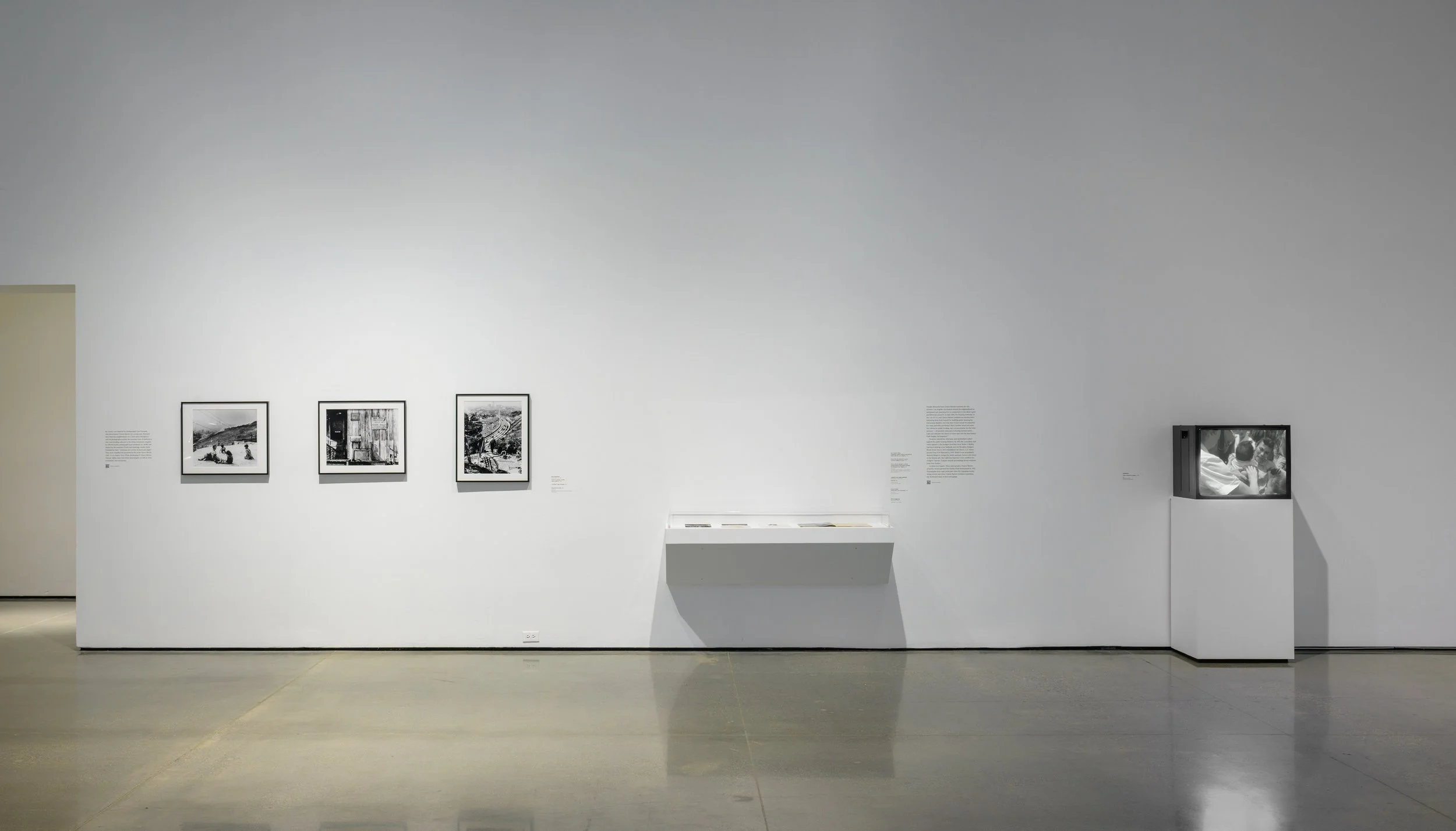








Installation photograph, Vincent Valdez and Ry Cooder: El Chavez Ravine, Los Angeles County Museum of Art, November 12, 2023 - August 11, 2024, © Vincent Valdez and Ry Cooder, photo © Museum Associates/LACMA
About Vincent Valdez
Vincent Valdez (b. 1977) blends large, representational paintings—the scale of which recall Western traditions of history painting as well as mural painting and cinema— with contemporary subject matter. He focuses on subjects that explore his observations and experience of life in the 21st century. The results are powerful images of American identity that confront injustice and inequity while imbuing his subjects with empathy and humanity. A recipient of the Latinx Artist Fellowship (2022), Joan Mitchell Fellowship (2016), as well as residencies at the Skowhegan School of Painting & Sculpture (2005), the Vermont Studio Center (2011), the Künstlerhaus Bethanien (2014), and the Arion Press King Residency (2023), Valdez currently lives and works between Houston and Los Angeles. Valdez’s work has been featured in exhibitions at major museums such as Crystal Bridges Museum of American Art, MASS MoCA, The National Portrait Gallery, and The Smithsonian Museum of American Art, and is held in the collections of The Cheech Marin Center for Chicano Art, Culture & Industry, The Ford Foundation, LACMA, and The Museum of Fine Arts Houston, among other institutions.
Credit: This exhibition was organized by the Los Angeles County Museum of Art.
Lead support provided by LACMA's Future Arts Collective. Generous support provided by Fabian Newton Family.
All exhibitions at LACMA are underwritten by the LACMA Exhibition Fund. Major annual support is provided by The David & Meredith Kaplan Foundation, with generous annual funding from Louise and Brad Edgerton, Edgerton Foundation, Mary and Daniel James, Justin Lubliner, Alfred E. Mann Charities, Kelsey Lee Offield, Koni and Geoff Rich, Lenore and Richard Wayne, and Marietta Wu and Thomas Yamamoto.
About LACMA: Located on the Pacific Rim, LACMA is the largest art museum in the western United States, with a collection of nearly 152,000 objects that illuminate 6,000 years of artistic expression across the globe. Committed to showcasing a multitude of art histories, LACMA exhibits and interprets works of art from new and unexpected points of view that are informed by the region’s rich cultural heritage and diverse population. LACMA’s spirit of experimentation is reflected in its work with artists, technologists, and thought leaders as well as in its regional, national, and global partnerships to share collections and programs, create pioneering initiatives, and engage new audiences.
The exhibit opened on November 12, 2023, and will end on August 11, 2024. The exhibition location is BCAM, Level 1.
For more information about this exhibit, along with other exhibits and the LACMA, please visit their site. The museum can also be found on Instagram, Facebook, You Tube.
Judy Chicago: Herstory
What if Women Ruled the World? From “The Female Divine,” 2020. Embroidery and brocade on velvet-backed fabric, 204 x 144 x 1/2 in (518.16 x 365.76 x 1.27 cm). © Judy Chicago/Artists Rights Society (ARS). Jordan Schnitzer Family Foundation
New York, NY The New Museum opened on October 12, 2023, with “Judy Chicago: Herstory,” it brings together six decades of the artist’s work and including an exhibition with the exhibition spotlighting women essential to the history of art and Chicago’s own practice. It will be on view through March 3, 2024; Chicago’s most comprehensive New York museum survey to date spans three floors of the New Museum, tracing the artist’s sixty-year career across painting, sculpture, installation, drawing, textiles, photography, stained glass, needlework, and printmaking. On the Museum’s Fourth Floor, a total installation featuring Chicago's embroideries, sculptures, drawings, and carpet design contextualizes her practice by bringing together artworks and archival materials from more than eighty women artists, writers, and cultural figures, including Hilma af Klint, Hildegard of Bingen, Claude Cahun, Elizabeth Catlett, Simone de Beauvoir, Artemisia Gentileschi, Emma Goldman, Frida Kahlo, Georgia O'Keeffe, Charlotte Salomon, Remedios Varo, and Virginia Woolf, among others. Titled after fifteenth century author Christine de Pisan’s “Le Livre de la Cité des Dames,” “The City of Ladies” continues Chicago's work as a feminist activist and cultural historian claiming space for women in narratives that previously obscured or denied their contributions—much like her seminal work The Dinner Party (1974–79) in its attempt to create a history of important and often overlooked women.
Birth Trinity: Needlepoint 1, from the Birth Project, 1983. Needlepoint on mesh canvas, 51 x 130 in (129.5 x 330.2 cm). Needlepoint by Susan Bloomenstein, Elizabeth Colten, Karen Fogel, Helene Hirmes, Bernice Levitt, Linda Rothenberg, and Miriam Vogelman. © Judy Chicago/Artists Rights Society (ARS), New York. The Gusford Collection. Photo: Donald Woodman/Artists Rights Society (ARS), New York
“Judy Chicago: Herstory” will encompass the entirety of Chicago’s practice, from her 1960s experiments in Minimalism and her revolutionary feminist art of the 1970s to her series of the 1980s and 1990s—such as the Birth Project (1980–85), PowerPlay (1982–87), Holocaust Project (1985–93), Resolutions: A Stitch in Time (1994–2000), and The End: A Meditation on Death and Extinction (2012-1018)—which expand the purview of her Second Wave Feminist agenda to confront environmental disaster, genocide, social inequity, birth and creation, mortality, and the construct of masculinity. The exhibition includes legendary works such as Rainbow Pickett (1965), originally presented in “Primary Structures” at the Jewish Museum, an exhibition which consecrated the minimalist turn in contemporary sculpture; Atmospheres, her radical performances initiated in 1969 employing colored smoke and fireworks to activate rather than scar the landscape; a suite of visionary abstractions from the 1970s—such as Through The Flower (1973) and the Great Ladies series (1973)—exemplifying Chicago’s iconography rooted in feminist theory; the Birth Project, a cycle of dozens of works begun in 1980 combining needlework, embroidery, and painting to celebrate the birth process; and documentation of “Womanhouse,” the fabled 1972 installation staged in an abandoned Hollywood mansion by Chicago and Miriam Schapiro’s Feminist Art Program. These historic works are joined by recent series including The End: A Meditation on Death and Extinction (2012–18), exploring death as it affects both individuals and the planet, and The Female Divine (2022), a series of eleven monumental banners designed by Chicago and produced by the nonprofit Chanakya School of Craft in Mumbai posing questions such as “What if Women Ruled the World?” Tracing her prolific practice across many decades and intersecting art movements, “Herstory” demonstrates the vast range and impact of Judy Chicago’s work over more than half a century.








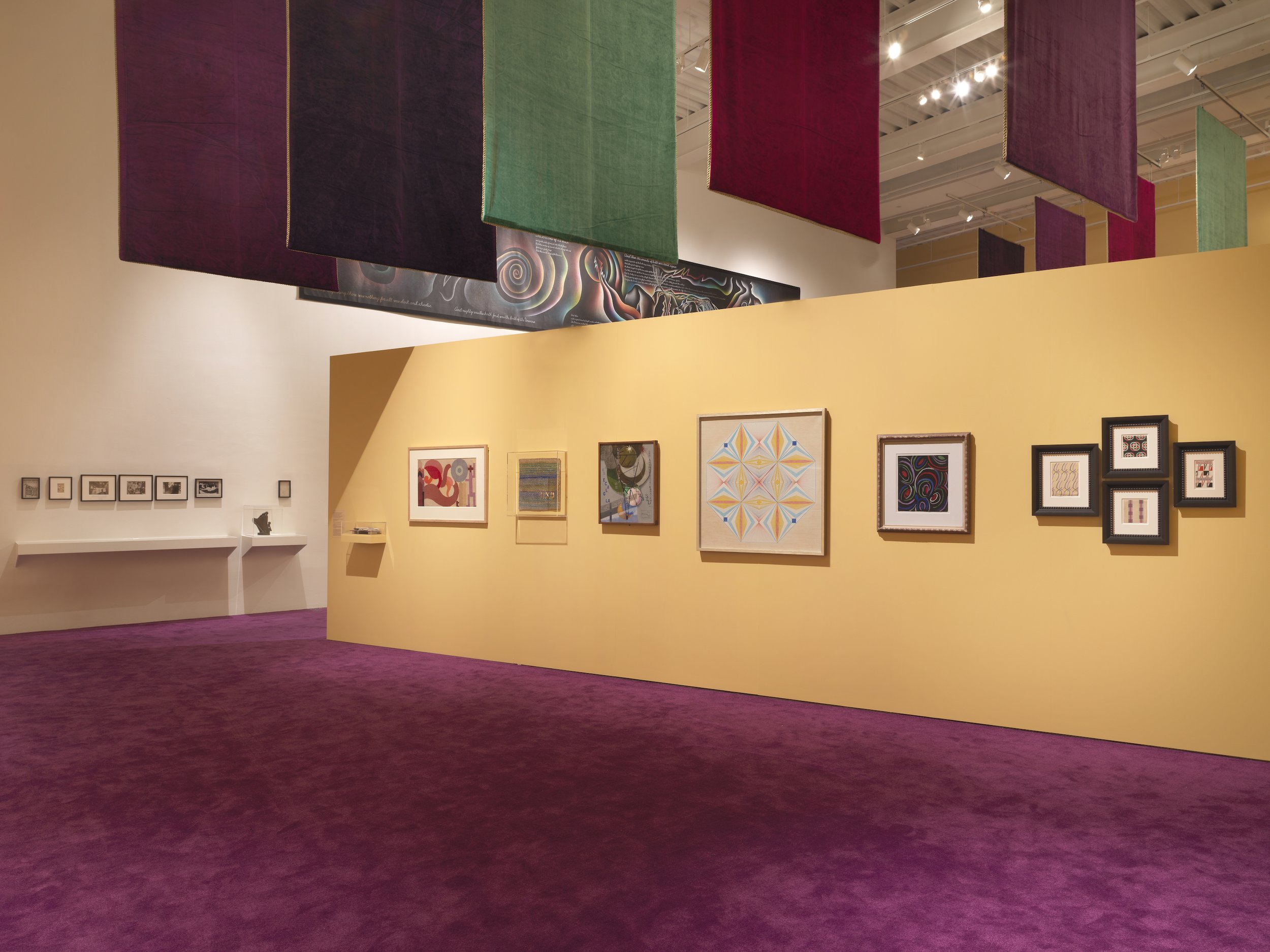















“Judy Chicago: Herstory,” 2023. Exhibition view: New Museum, New York. Courtesy New Museum. Photo: Dario Lasagni
The exhibition will also explore Chicago’s manifold contributions as a feminist activist and cultural historian, presenting her work in dialogue with other women artists, writers, and thinkers whose memory she has helped keep alive through her tireless activities as both researcher and historical preservationist. Combining artworks and source materials in a distinctive exploration of artistic influences and reverberations across history, this exhibition proposes a new, radical model for a solo exhibition—an “introspective,” rather than a retrospective. In this collaborative curatorial approach, the artist is invited to conceive a personal museum based on a model of historiography that is porous, hospitable, and accepting. “The City of Ladies” includes work and archival materials from Hilma af Klint, Eileen Agar, Anni Albers, Lola Álvarez Bravo, Anna Atkins, Alice Austen, Djuna Barnes, Simone de Beauvoir, Otti Berger, Annie Besant, Hildegard of Bingen, Rosa Bonheur, Marianne Brandt, Nannie Burroughs, Claude Cahun, Julia Margaret Cameron, Leonora Carrington, Countess Virginia Oldoini Verasis di Castiglione, Elizabeth Catlett, Pop Chalee, Elizabeth S. Clarke, Ithell Colquhoun, Imogen Cunningham, Sonia Delaunay, Maya Deren, Emily Dickinson, Sophie Drinker, Suzanne Duchamp, Leonor Fini, Elsa von Freytag-Loringhoven, Olga Fröbe-Kapteyn, Artemisia Gentileschi, Gluck (Hannah Gluckstein), Emma Goldman, Natalia Goncharova, Martha Graham, Alice Guy-Blaché, Florence Henri, Barbara Hepworth, Hannah Höch, Kati Horna, Georgiana Houghton, Zora Neale Hurston, Frida Kahlo, Gertrude Käsebier, Käthe Kollwitz, Emma Kunz, Dorothea Lange, Edmonia Lewis, Mina Loy, Dora Maar, Jeanne Mammen, Maria Martinez, Maria Martins, Mary Louise McLaughlin, Maria Sibylla Merian, Paula Modersohn-Becker, Louise Nevelson, Maria Longworth Nichols Storer, Anaïs Nin, Georgia O’Keeffe, Méret Oppenheim, Agnes Pelton, Mary Richardson, Margaret Sanger, Augusta Savage, Ethel Smyth, Gertrude Stein, Varvara Stepanova, Florine Stettheimer, Dorothea Tanning, Sophie Taeuber-Arp, Toyen, Sojourner Truth, Remedios Varo, Pablita Velarde, Beatrice Wood, Virginia Woolf, and Unica Zürn, as well as a number of unattributed works.
Judy Chicago and Donald Woodman, Rainbow Shabbat, 1992. Stained glass, 54 x 204 in (137.2 x 518.2 cm). Fabrication by Bob Gomez; glass painting by Dorothy Maddy. © Judy Chicago/Artist Rights Society (ARS), New York. © Donald Woodman/Artist Rights Society (ARS), New York. Jordan Schnitzer Family Foundation
Contextualizing Chicago’s feminist methodology within the many art movements in which she participated—and from whose histories she has frequently been erased—“Herstory” showcases Chicago’s tremendous impact on American art and highlights her critical role as a cultural historian claiming space for women often omitted from various canons. Part-expanded self portrait and part-historical, revisionist archive, “Herstory,” will be both a solo exhibition and a polyphonic survey of the feminist arts over multiple centuries.
Car Hood, 1964. Sprayed acrylic lacquer on car hood, 42 7/8 x 49 1/8 x 4 1/8 in (108.9 x 124.8 x 10.8 cm). © Judy Chicago/Artists Rights Society (ARS), New York. Moderna Museet, Stockholm. Purchase 2007 (The Second Museum of Our Wishes), MOM/2007/149. Photo: Donald Woodman/Artists Rights Society (ARS), New York
“Judy Chicago: Herstory” is curated by Massimiliano Gioni, Edlis Neeson Artistic Director, Gary Carrion-Murayari, Kraus Family Senior Curator, Margot Norton, former Allen and Lola Goldring Senior Curator at the New Museum and current Chief Curator at the Berkeley Art Museum and Pacific Film Archive, and Madeline Weisburg, Assistant Curator. The exhibition will be accompanied by a fully illustrated catalogue co-published by Phaidon and the New Museum, featuring texts by Glenn Adamson, Connie Butler, Gary Carrion-Murayari, Ann Goldstein, Jennifer Higgie, Candice Hopkins, Amelia Jones, Quinn Latimer, Margot Norton, Kymberly Pinder, Ian Wallace, Madeline Weisburg, and Carmen Winant; and an interview between the artist and Massimiliano Gioni.
SUPPORT
Lead sponsorship of “Judy Chicago: Herstory” is provided by DIOR.
Major support is provided by The Artemis Council of the New Museum* Jordan Schnitzer/The Harold & Arlene Schnitzer CARE Foundation..
The New Museum gratefully acknowledges the Artistic Director’s Circle of the New Museum: Dakis Joannou, Co-Chair; Eugenio Lopez, Co-Chair; Gael Neeson, Co-Chair; Shane Akeroyd, Pietro Beccari, Abbie and Patrick Dean, Susan Hayden, J. Tomilson and Janine Hill, Carola Jain, Richard Mumby, Holly Peterson, Elham and Tony Salamé, and Beth Swofford. Additional support is provided by: Sabrina Buell and Yves Behar, DMINTI & DANAE, Jay Franke and David Herro, The Gladys Krieble Delmas Foundation, Grażyna Kulczyk Collection, Hill Art Foundation, Marley Blue Lewis, Kathleen O’Grady / The O’Grady Foundation, Debbie and Mitchell Rechler, Judy Rechler, Samuel H. Kress Foundation, Margherita Stabiumi, Younghee Kim-Wait, and Lisa Watson and Mike Krupka. Support for the accompanying publication has been provided by the J. McSweeney and G. Mills Publications Fund at the New Museum. Special thanks to Jeffrey Deitch, New York/Los Angeles and Jessica Silverman, San Francisco. *Artemis Council Members: Maria Baibakova, Co-Chair, Nicole Nunag, Co-Chair, Dr. Shelley Fox Aarons, Alison Blood, Lisa Burnes, Cheryl Chan, Jacqueline Clements, Anna Maria Gonzales Cuevas, Ingrid Cincala Gilbert, Kaleta A. Doolin, Heather Flow, Molly Gochman, Stacey Goergen, Kimberly Gould, Agnes Gund, Vanessa Guo, Lynette Hayde, Christina Hribar, Justine Leguizamo, Lucy Liu, Jennifer Lotz, Justine McEnerney, Jessica Paindiris, Holly Peterson, Debbie Rechler, Barrie S. Roman, Chiara Rusconi, Nicole Salmasi, Arielle Schnitzer, Tracey Serko, Julie Simpson, Jennifer Soros, Lynda Stern, Sara Story, Alva Stux, Vicki Match Suna, Roxann Taylor, Nicola Vassell, Younghee Kim-Wait and Alexandra Wait, Olivia Walton, Madeline Weinrib, Demetria White, Sue Hostetler Wrigley, Tiffany Zabludowicz, Ruoqi Amy Zhou, Afrodet Zuri, Aimée Mullins, Ambassador and H. R. H. Princess Eugenie of York, Ambassador.
ABOUT NEW MUSEUM
The New Museum is the only museum in New York City exclusively devoted to contemporary art. Founded in 1977, the New Museum is a center for exhibitions, information, and documentation about living artists from around the world. From its beginnings as a one-room office on Hudson Street to the inauguration of its first freestanding building on the Bowery designed by SANAA in 2007, the New Museum continues to be a place of experimentation and a hub of new art and new ideas.
For more information about this exhibition and others, please visit the New Museum website for updates. The New Museum can also be found on Instagram.
LEONARD MARTIN:Suite Zabriskie
Toutes les images/All images:© Courtesy de l'artiste et TEMPLON, Paris—Brussels—NewYork
Multimedia artist Léonard Martin has joined the Galerie Templon family. The gallery marked his arrival with a solo exhibition of brand-new work, the fruit of a dialogue between painting and film he developed during his 2019 residency at Villa Medici.
Painter, video maker, and sculptor, he strives to build bridges between different eras and forms. The French art scene has been captivated by his work since he graduated from Beaux-Arts de Paris in 2015. His creative process makes use of drawings, papers, and precious sculptures he occasionally animates with stop motion, a motor, or video. Léonard Martin finds his subjects by delving into literature and the history of art. Wooden figures on tracks bring to life the characters of Irish novelist and poet James Joyce on their strolls. Italian painter Paolo Uccello’s horse riders serve as a pretext to create an interactive piece. He sometimes takes a break from building marionettes and automatons and uses painting to capture the theatre of objects that is his workshop. Visibly playing with perspective and cultural labels, particularly “painting” and “sculptures,” the scenes he creates generate a dialogue between mediums and eras.
Toutes les images/All images:© Courtesy de l'artiste et TEMPLON, Paris—Brussels—NewYork
Suite Zabriskie is a new series of paintings that invents a possible sequel to Zabriskie Point (1970), Michelangelo Antonioni’s famous movie, following on from the final scene. The film ends with a luxurious villa exploding in a billowing cloud of smoke and household items suspended in the sky, all against a background of music by Pink Floyd. The canvases emerge in a landscape of objects it would be difficult to describe as still lifes, since their spatial representation cuts loose from genre codes to embrace theatre design, for instance, or mental mapping.
Antonioni’s film criticised the society of the time, disparaging consumerism, police violence and the conservative system. While these problems have yet to be resolved, they have now been joined by other issues, such as the ecological crisis and need to protect the living world.
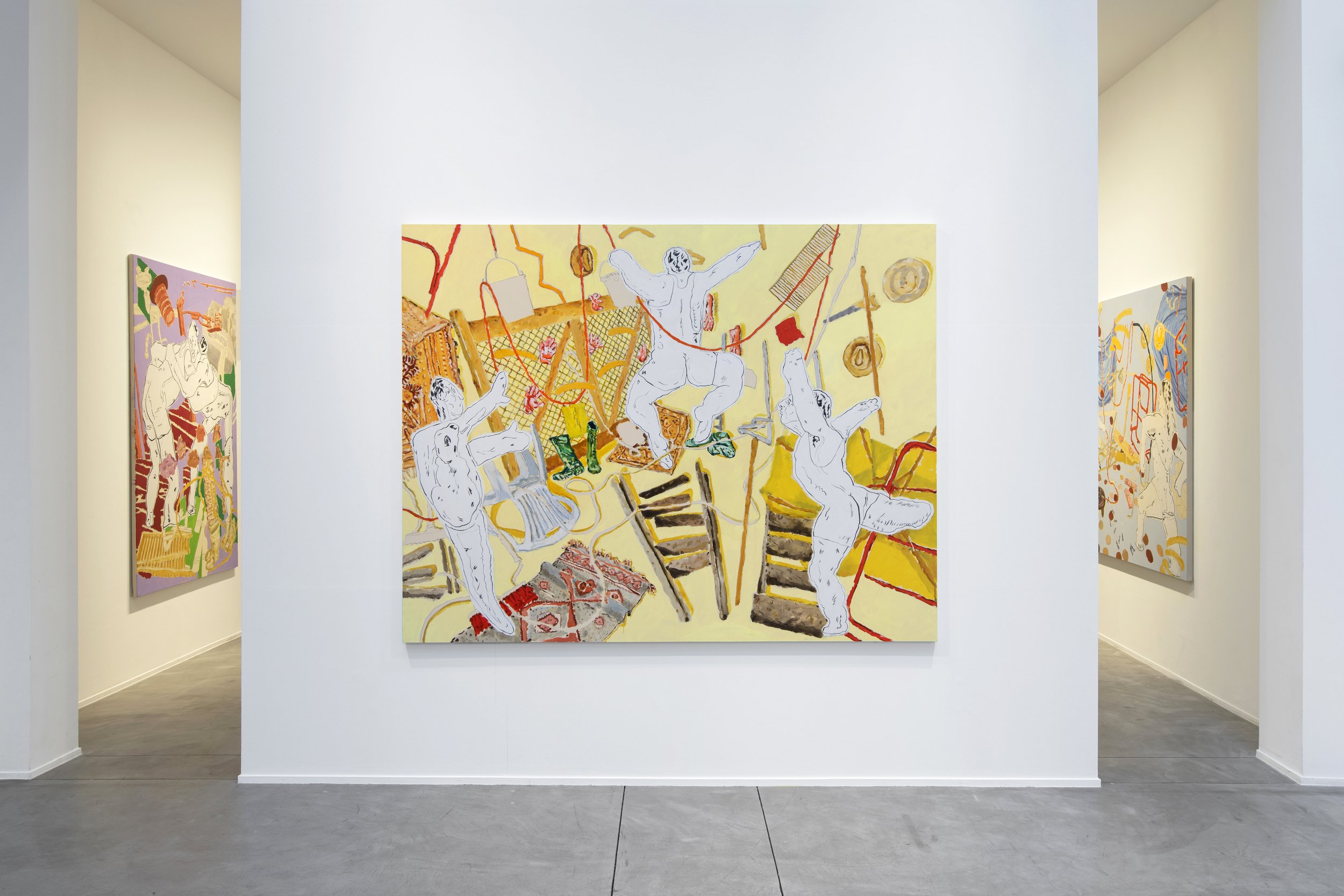
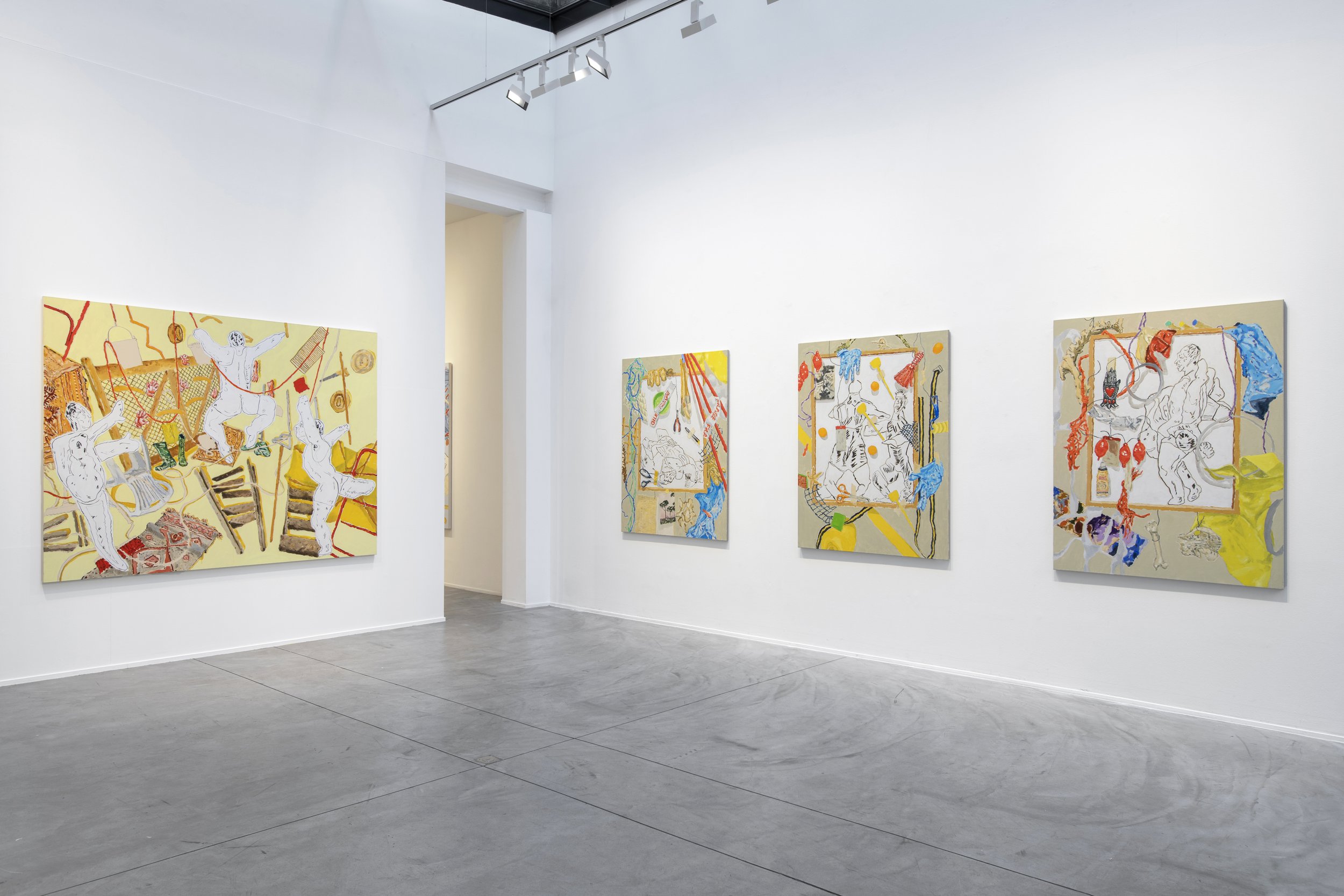
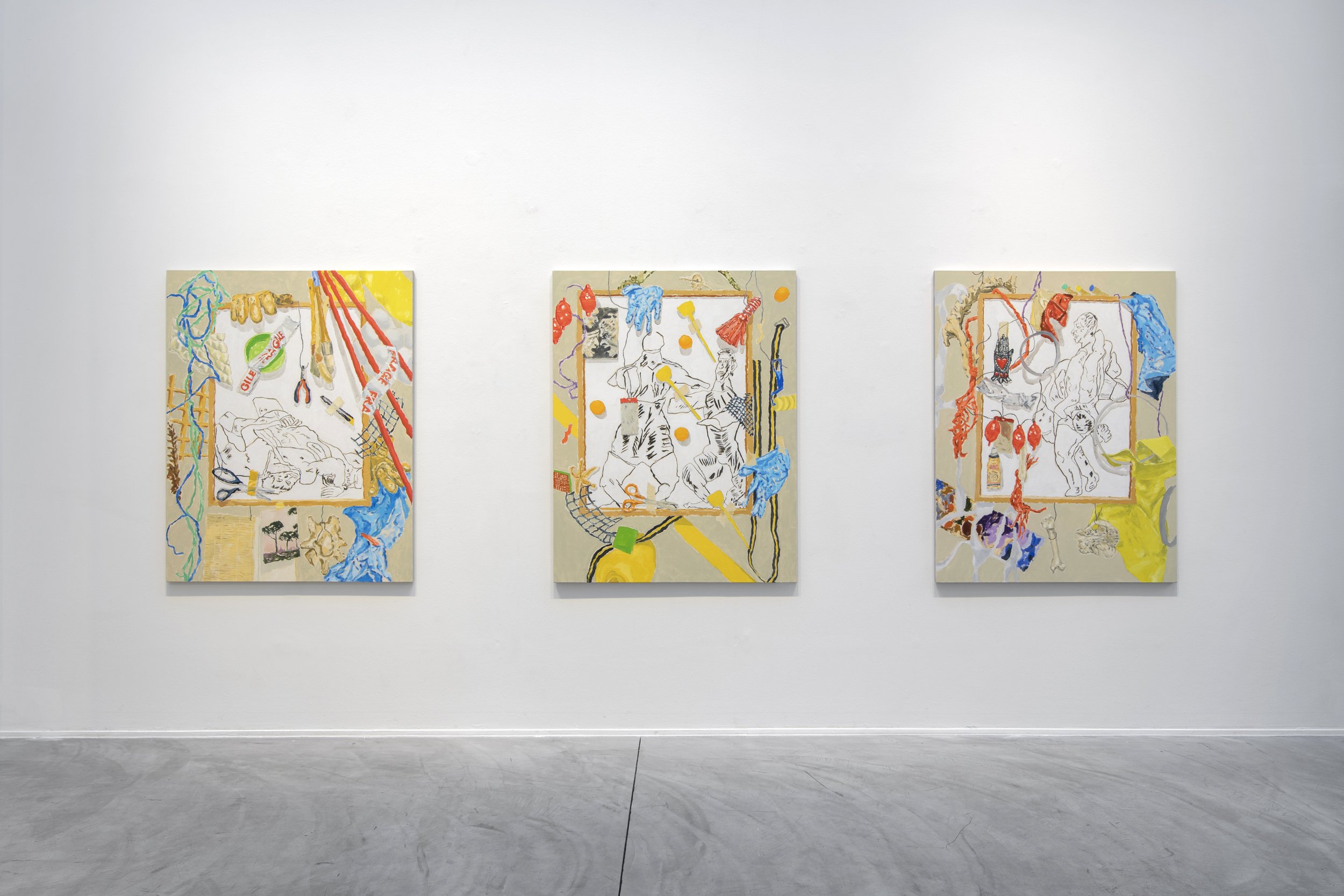
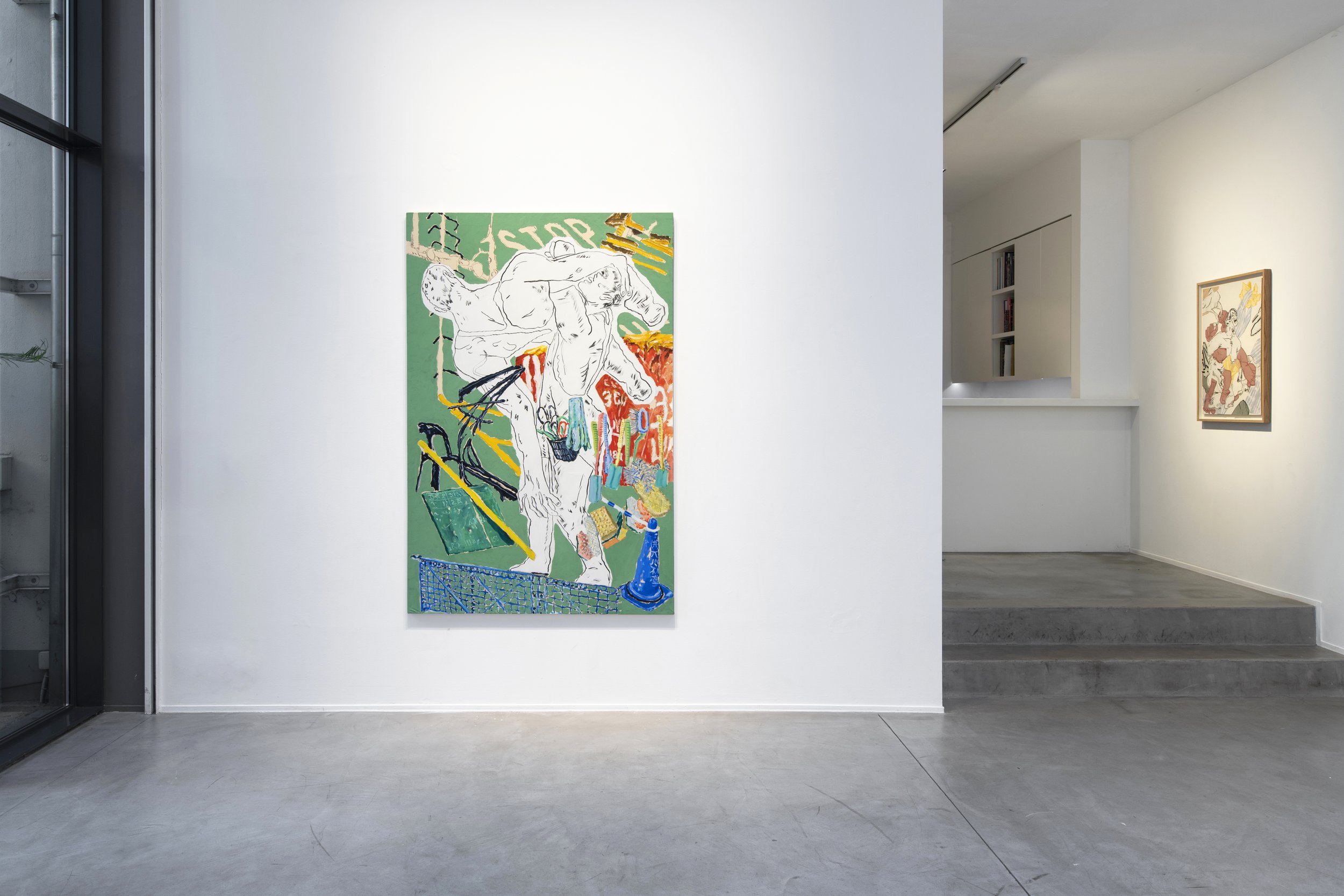
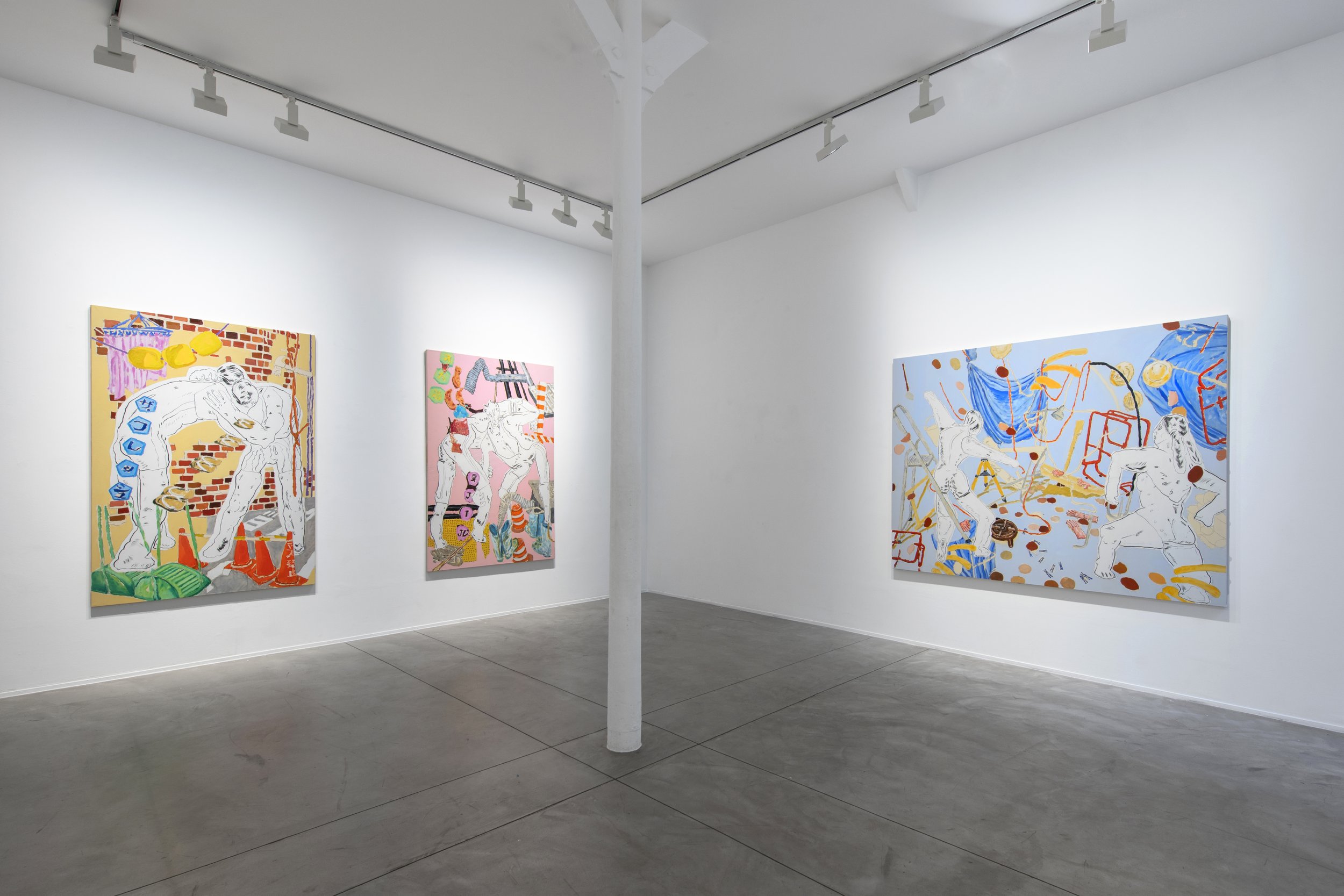
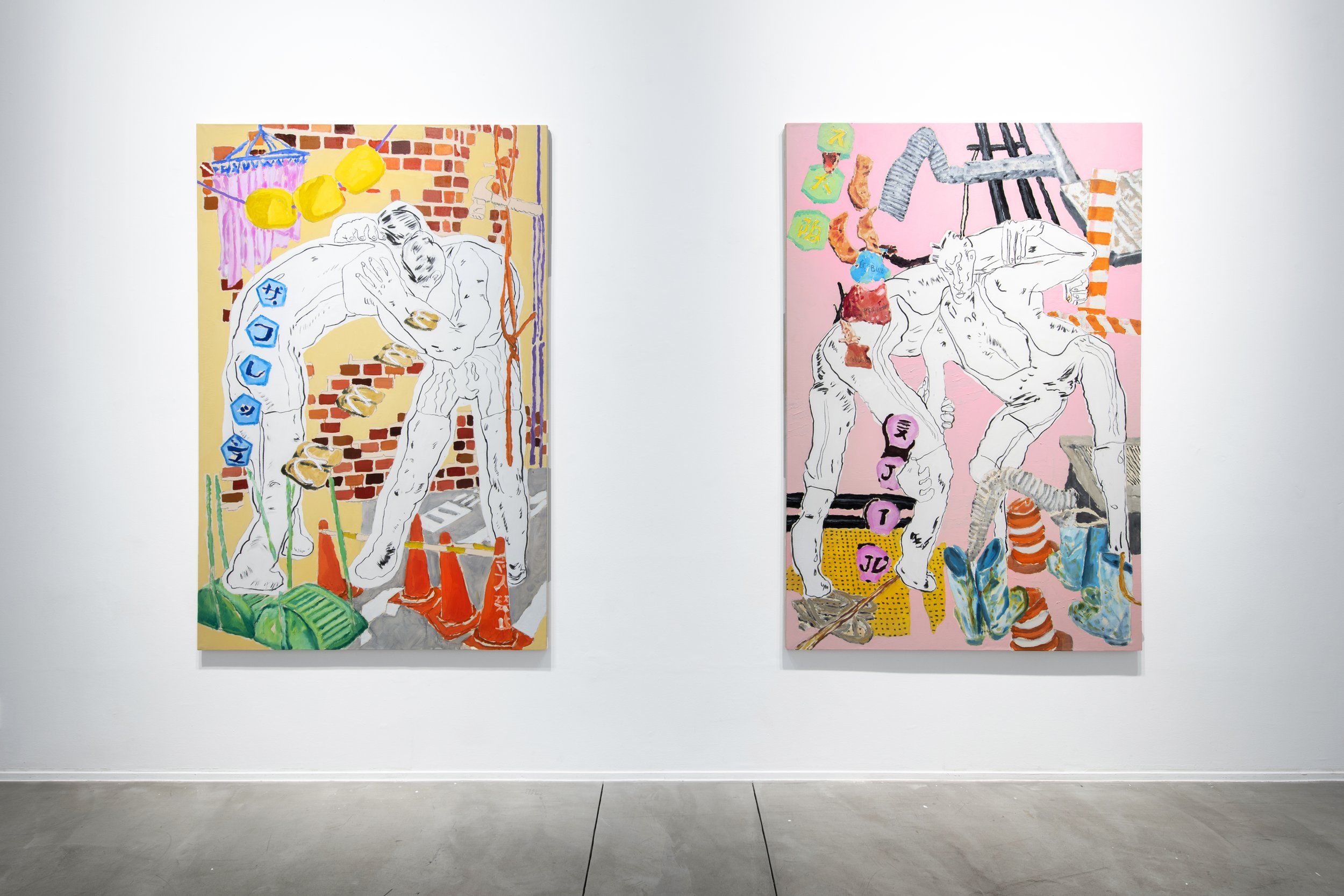
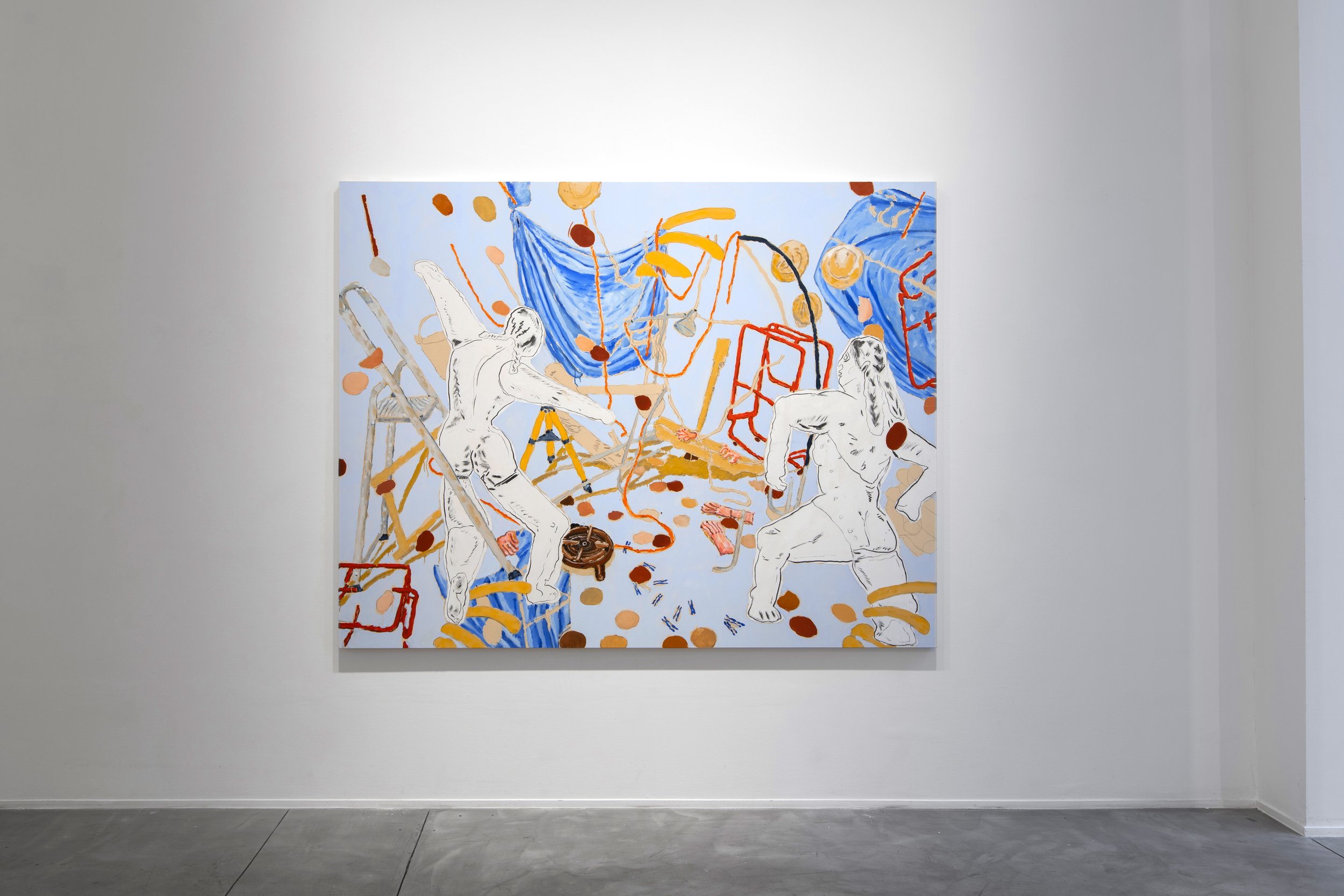
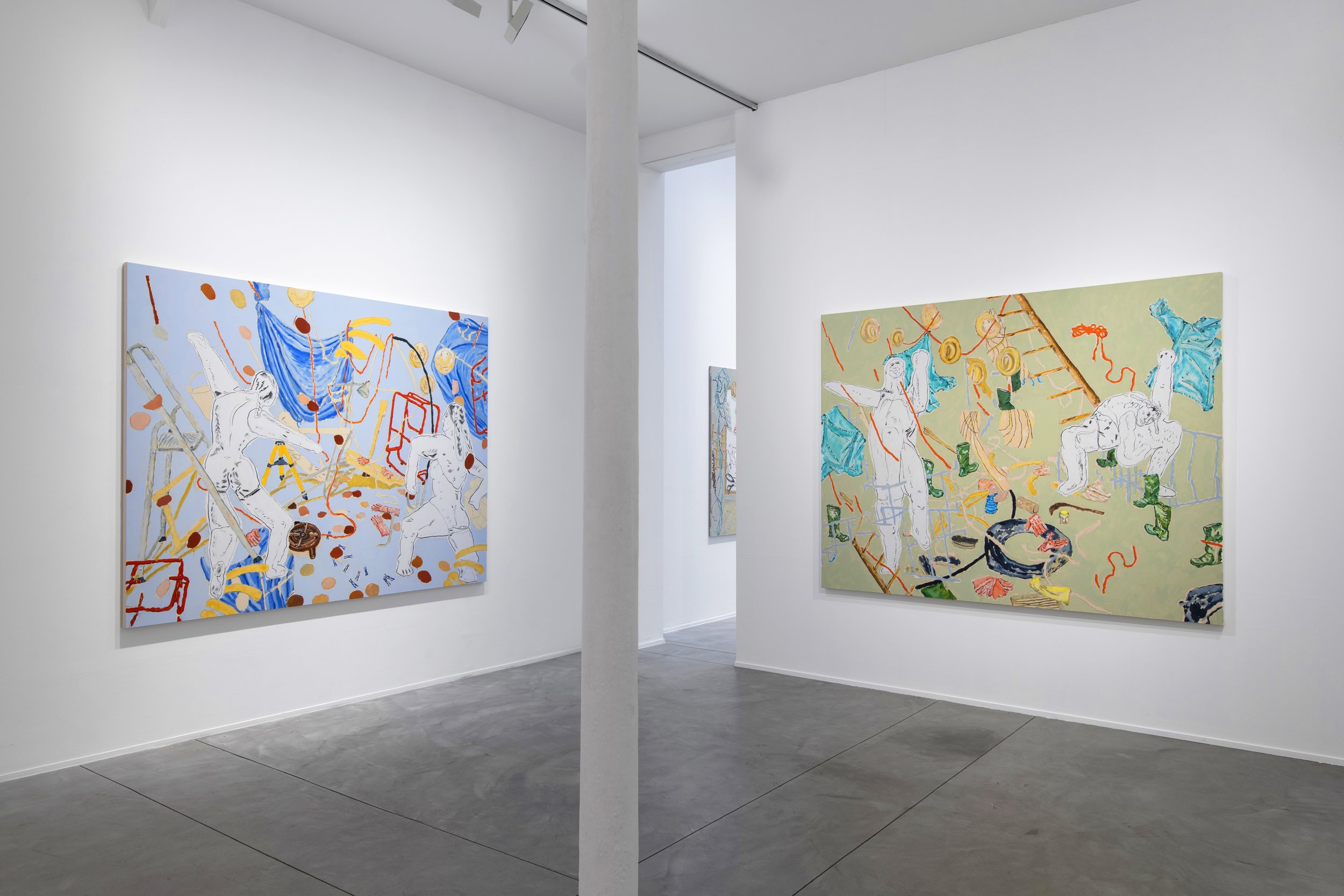
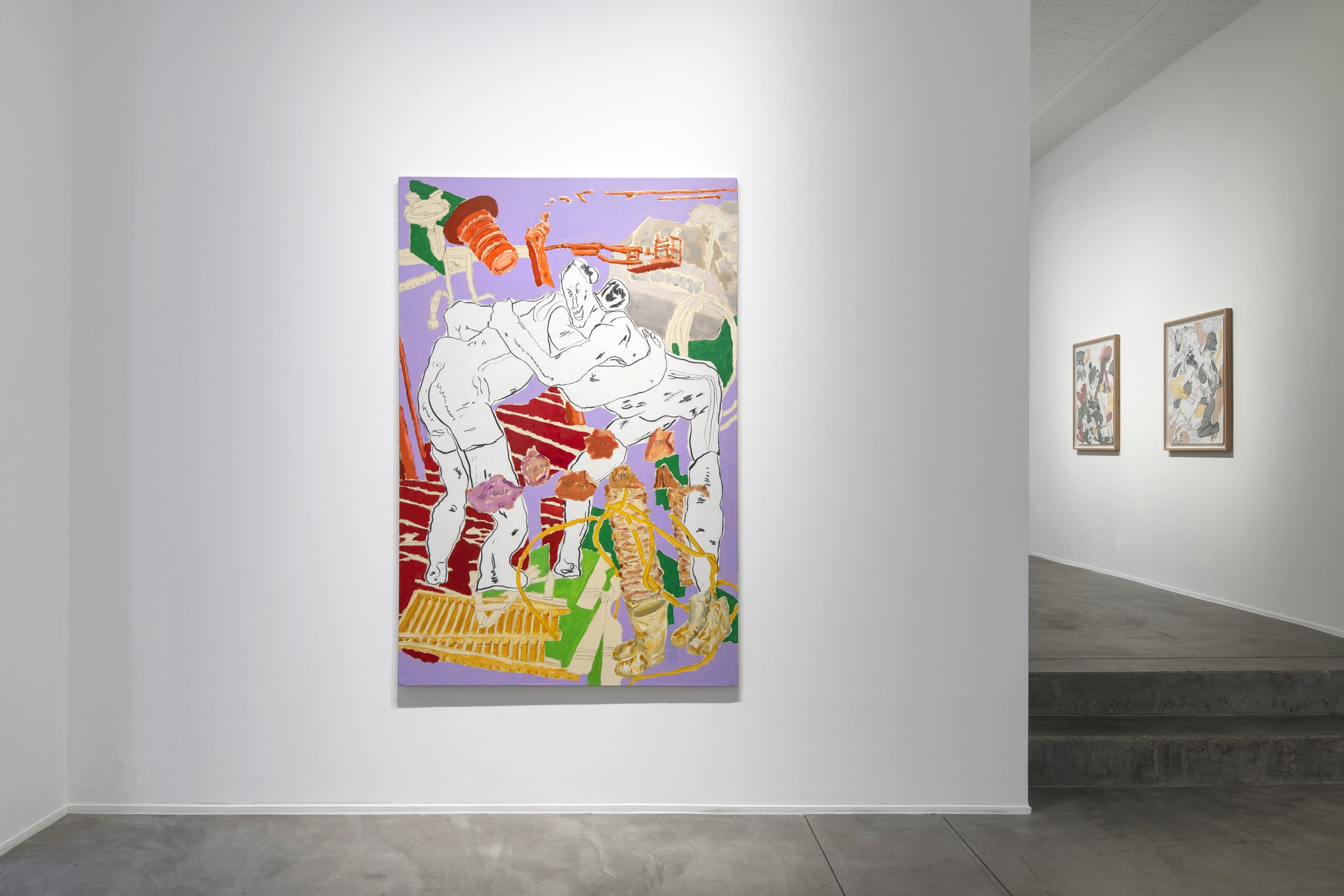
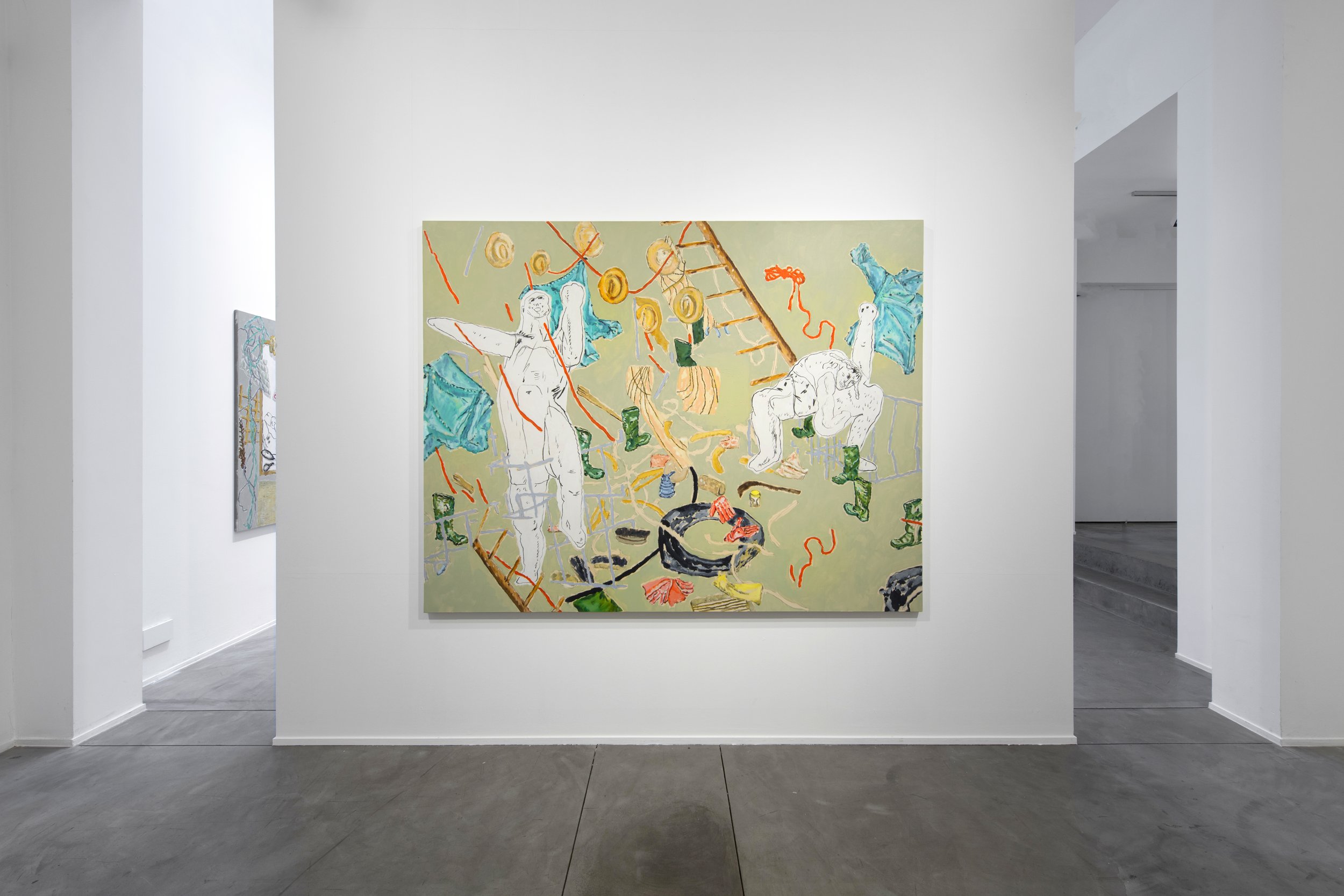
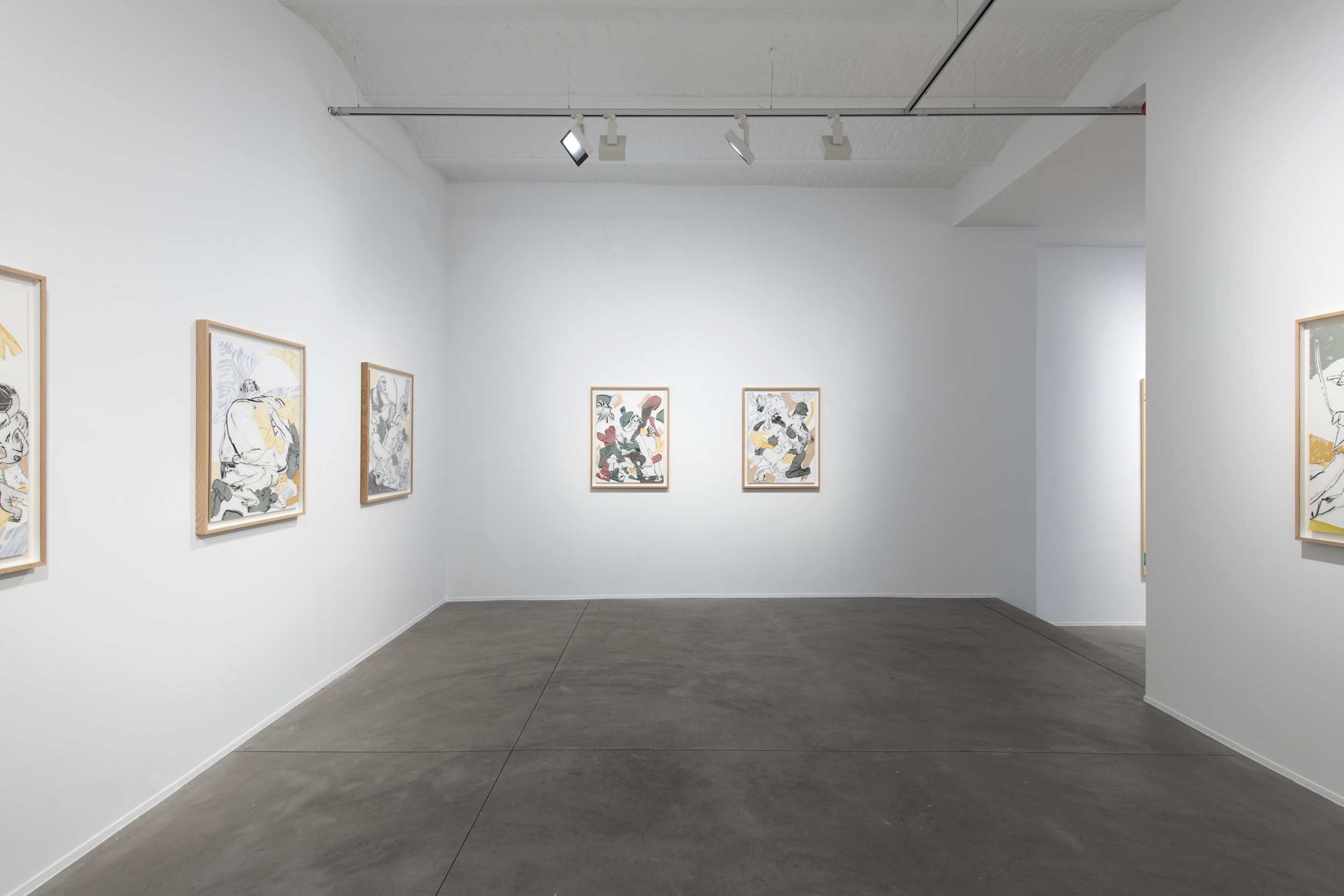
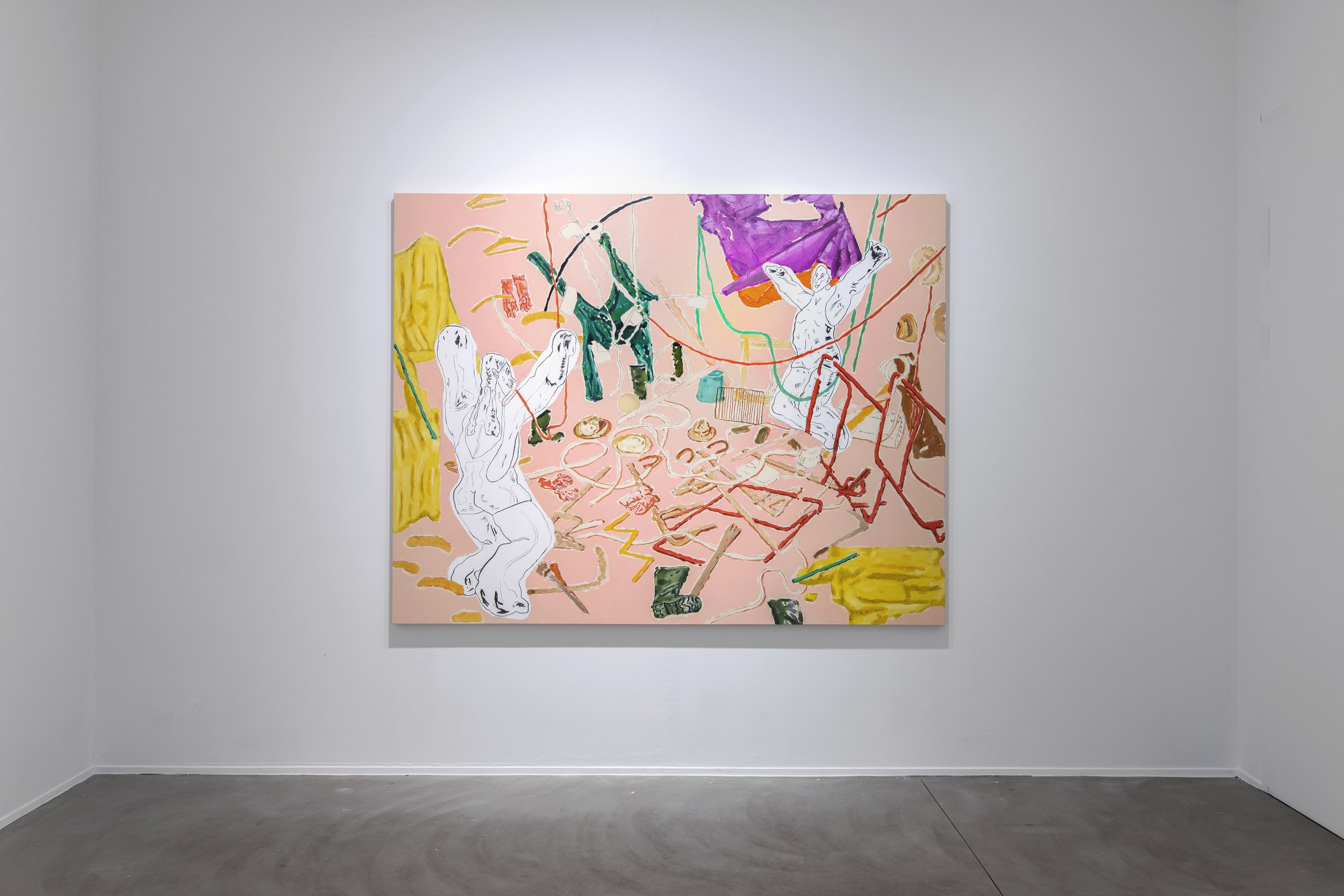
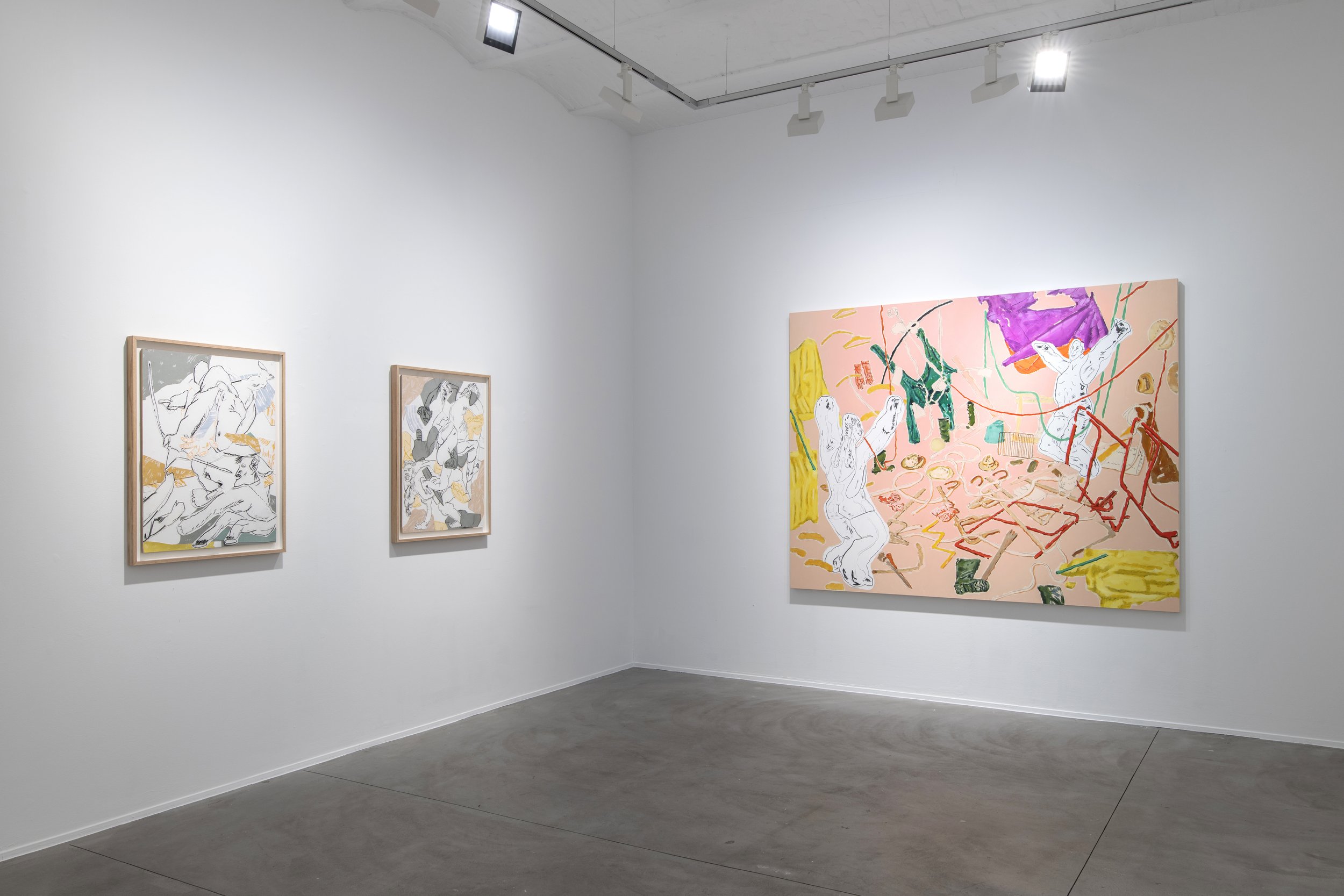
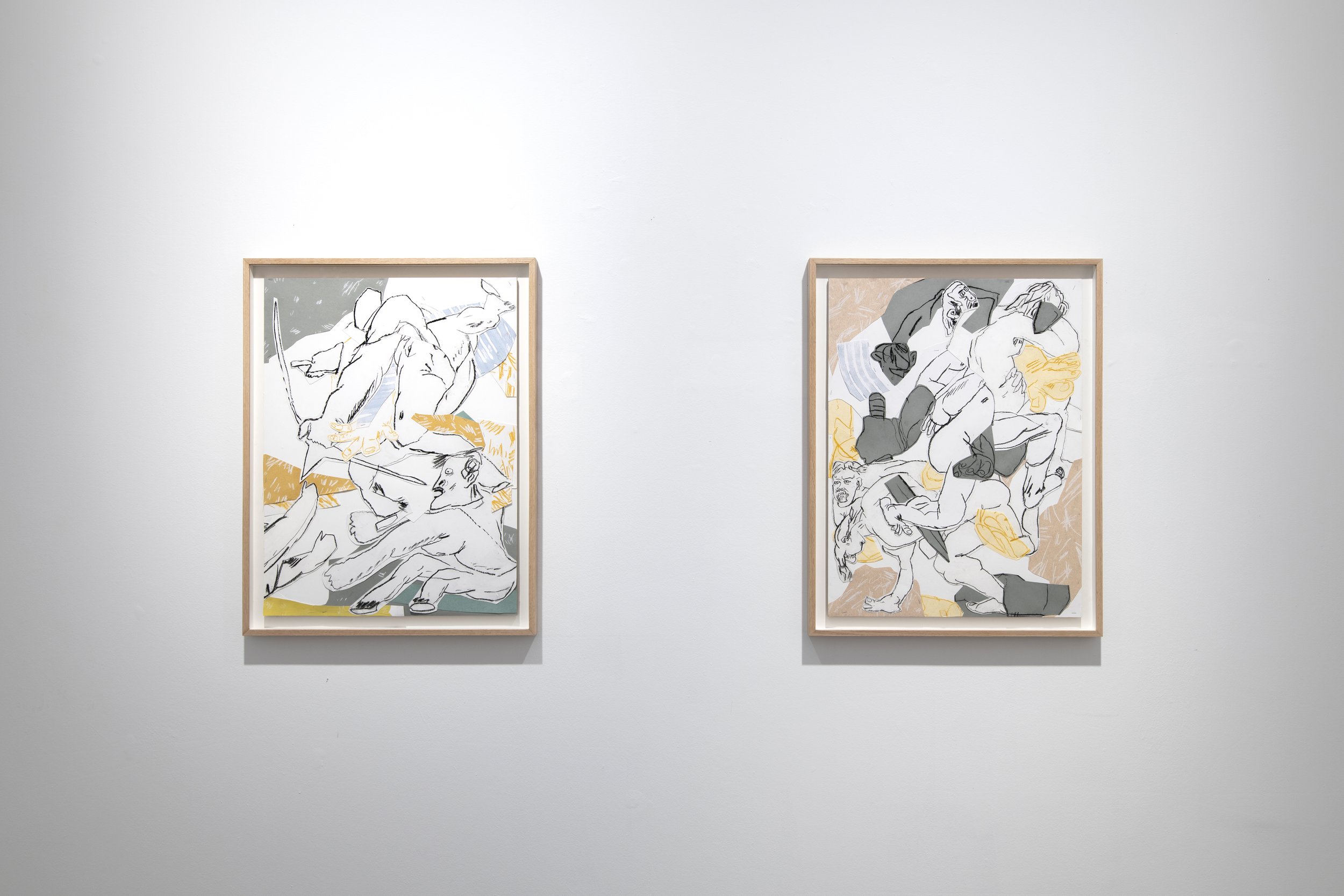
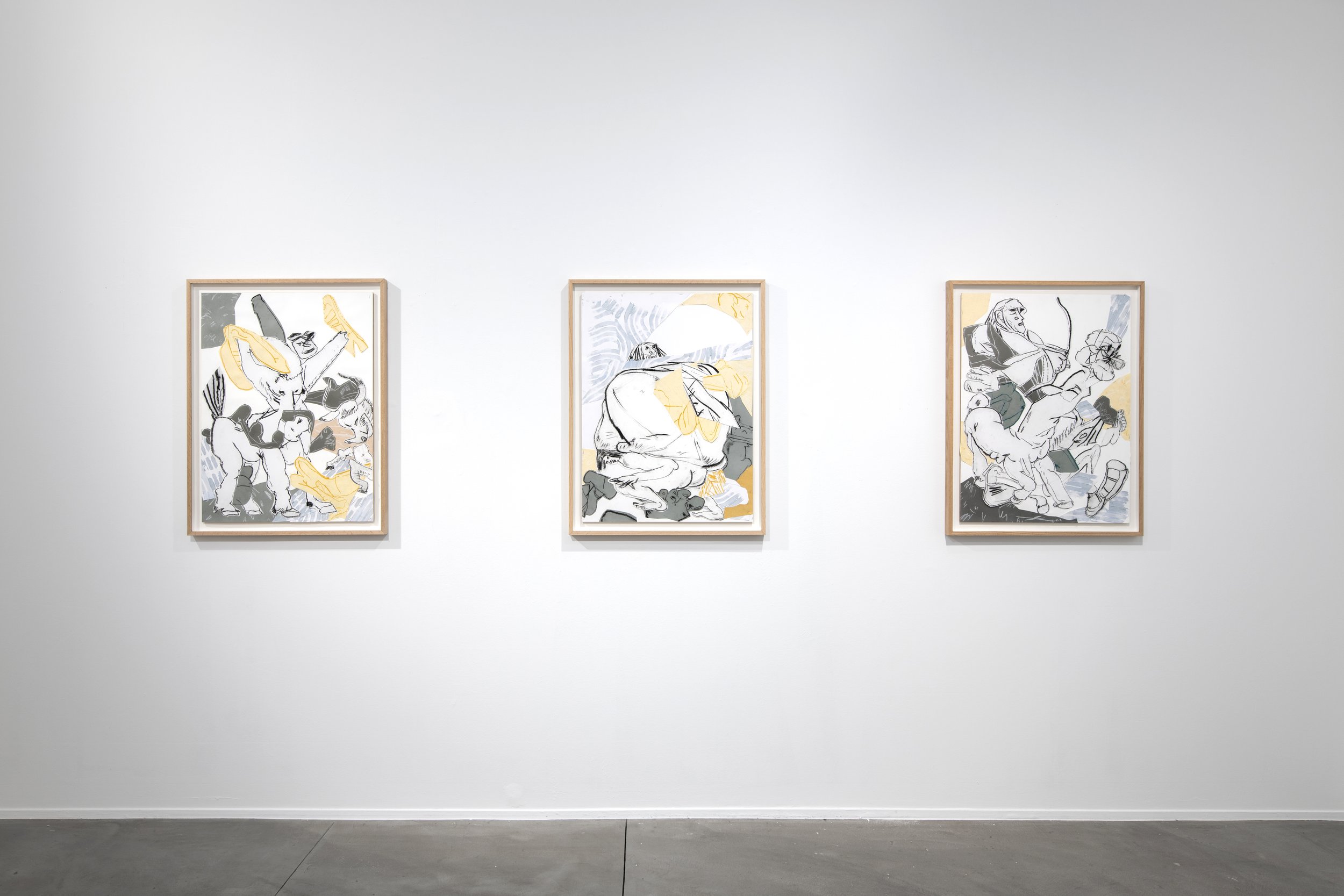
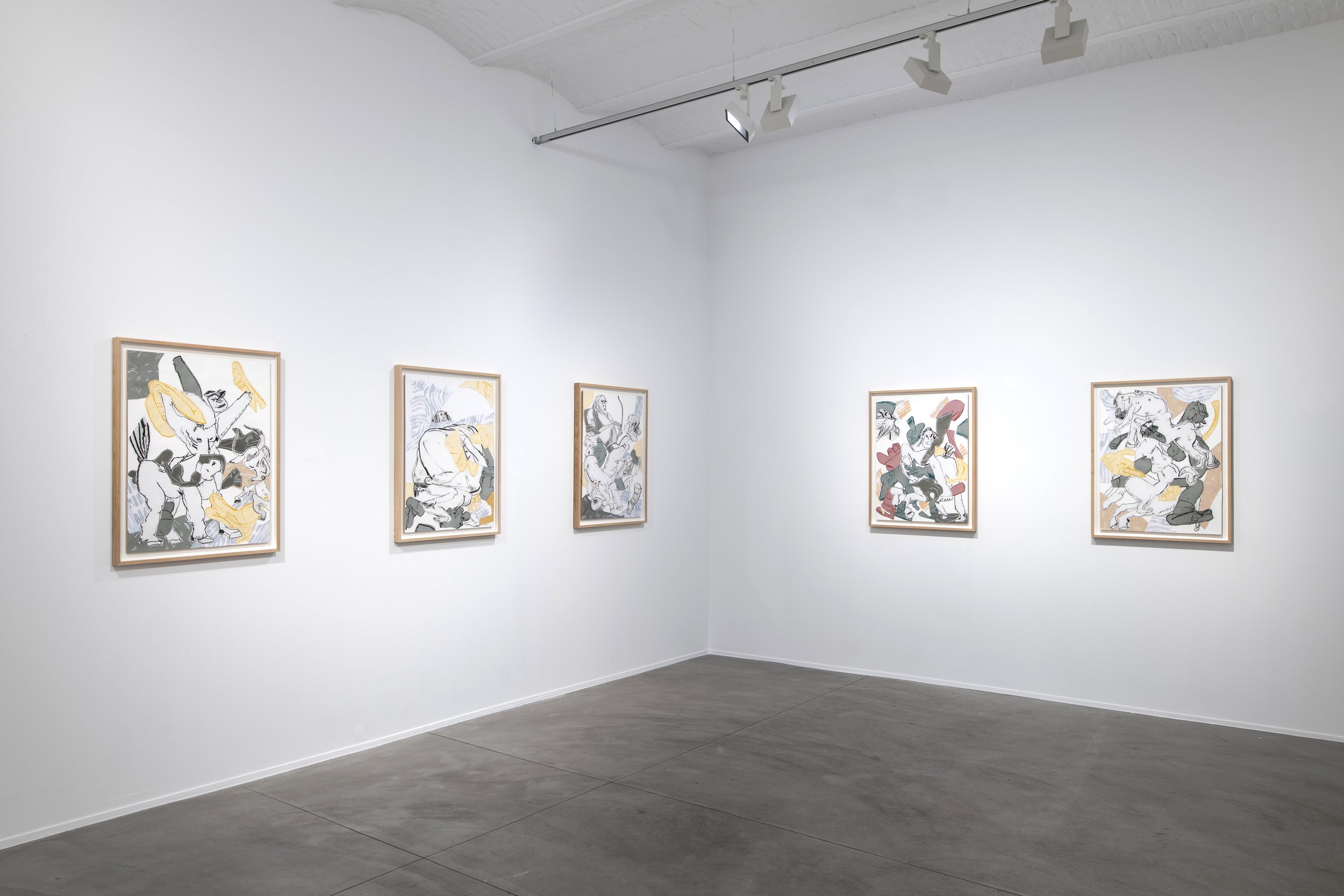
Toutes les images/All images:© Courtesy de l'artiste et TEMPLON, Paris—Brussels—NewYork
“Watching the objects in Zabriskie Point explode raises the question of the repercussions the history of one generation has on the next, the mark it leaves,” explains Léonard Martin.
“I capture the objects on the fly. The film ends in what feels like a point of no return, whereas my paintings imagine possibilities for what came next. How can we find our way through the dreams abandoned by our elders?”
Similarly to emaki, the Chinese, Japanese and Korean illustrated scrolls which foreshadowed cinema, the bird’s-eye view offered by Martin’s paintings prevent the viewer’s gaze from standing still. These paintings do not have a vanishing point, opening the door to multiple interpretations and keeping the images in motion. The solid block of background colour accommodates the objects like the characters on a page of writing. History constantly needs to be rewritten. The profusion of marks that cover the surface of the paintings suggest the constant flow of images, texts and sounds that now fill our daily lives, sometimes blurring our vision. For Martin, “painting might well make it possible to demolish the images, to make the cloud that hangs heavy above our heads rain.”
The series of paintings thus form a sort of musical suite. A next step following on from the film’s missing image (the items falling back to earth after being thrown in the air), from the blind spots of a particular era (the ecological and social impact of the post-war boom years), from the battles still to be fought (police criminality, conservatism, the hubris of progress). The artist asks himself: “how can we stick the fragments of history back together? What should we look for and listen for? My paintings do not take stock. They draw lines, from one memory to another, seeking to repopulate the desert that Antonioni’s lovers fly over.”
Finally, in homage to Flemish painting, the “Quodiblet” series of oils on canvas is inspired by trompe l’oeil to showcase the work of the artist workshop.
Born in 1991 in Paris, Léonard Martin currently lives and works in the French capital. After studying at Beaux-Arts de Paris (graduating in 2015 with first class honours) and Fresnoy – Studio National des Arts Contemporains (graduating in 2017 with first class honours), he showed his work at the Salon de Montrouge, Jeune Création and La Villette in Paris and Collection Lambert in Avignon.
In 2018-2019, he was artist-in-residence at the French Academy in Rome at the Villa Medici. His other prizes and residencies include the Cité Internationale des Arts in Paris in 2019, the ADAGP Digital Art – Video Art Revelation prize in 2017, Prix Dauphine from Université Paris-Dauphine in 2018, and Lafayette Anticipations in 2021. His work was exhibited at the Collection Lambert in Avignon in 2017, La Villette in Paris, the Gwangju Biennale in Korea, Villa Emerige in Paris, and Beaux-Arts de Paris in 2018, and Palais de Tokyo in Paris and Lyon Biennale in 2019.
On January 11th, Suite Zabriskie opened at the Brussels Gallery location and will close on February 24th of, 2024. For more information about this exhibit and other exhibits at the Templon Gallery, please visit their website here. Also, find the Gallery on Instagram and Artsy.
Sasha Gordon: Surrogate Self
Photo Credit: William Jess Laird.
The first solo museum presentation for rising artist Sasha Gordon opened at the Institute of Contemporary Art, Miami (ICA Miami) this December, debuting a suite of new paintings and recent work. The exhibition demonstrates the ongoing evolution of Gordon’s signature, surrealistic practice, which explores the complexities of bodily experience in hyperrealistic detail. Coinciding with Miami Art Week and curated by Alex Gartenfeld, ICA Miami’s Irma & Norman Braman Artistic Director, Sasha Gordon's exhibition features a Suite of New Paintings showcasing Gordon’s Hyperrealistic Forms and Innovative Explorations of the Politics of Representation, and is on view at ICA Miami through April 28, 2024.
Often depicting herself, Gordon is keenly aware of the art historical themes of portraiture and self-portraiture, and of the politics of representation. She approaches these categories with inventiveness and humor and a unique ability to make fantasy real. Gordon’s images survey a wide range of emotional possibilities while exploring the rich plurality of her identity as a queer Asian American woman. Depicting intimacy, empowerment, vulnerability, and the feminine form, her work critically engages issues of self-image, racial prejudice, interpersonal relationships, and the attending psychological impacts, while also exhibiting discomfort.
Sasha Gordon, Princess, 2023. Oil on canvas, 182.8 x 243.8cm (72 x 96in). Copyright Sasha Gordon. Courtesy the artist; Stephen Friedman Gallery, London and New York; and Matthew Brown, Los Angeles. Photo: Mark Blower.
In her most recent works, including new paintings debuting at ICA Miami, Gordon depicts herself in a condition of becoming. Transforming into animal, botanical, and geological phenomena, Gordon enacts the process of objectifying bodies, while examining personal experiences of alienation and challenging taboos and standards of representation. Through these avatars she portrays the othering of unconventional human bodies and examines her own experiences of alienation, while questioning the logic of certain limiting social norms.
Volcano, 2023. Oil on canvas, 243.8 x 182.8cm (96 x 72in). Copyright Sasha Gordon. Courtesy the artist; Matthew Brown Gallery, Los Angeles and Stephen Friedman Gallery. Photo: Mark Blower.
Among the recent works featured in the exhibition is Volcano (2023), in which Gordon explores themes of transformation and confronts the demonization of women's emotions. While anger among men is typically perceived as a manifestation of strength or power, in women it is often labelled a sign of instability. With this painting, the artist claims her right to express rage, reimagining herself as an erupting volcano; gritting her teeth, she paints herself overflowing with lava-like emotion.


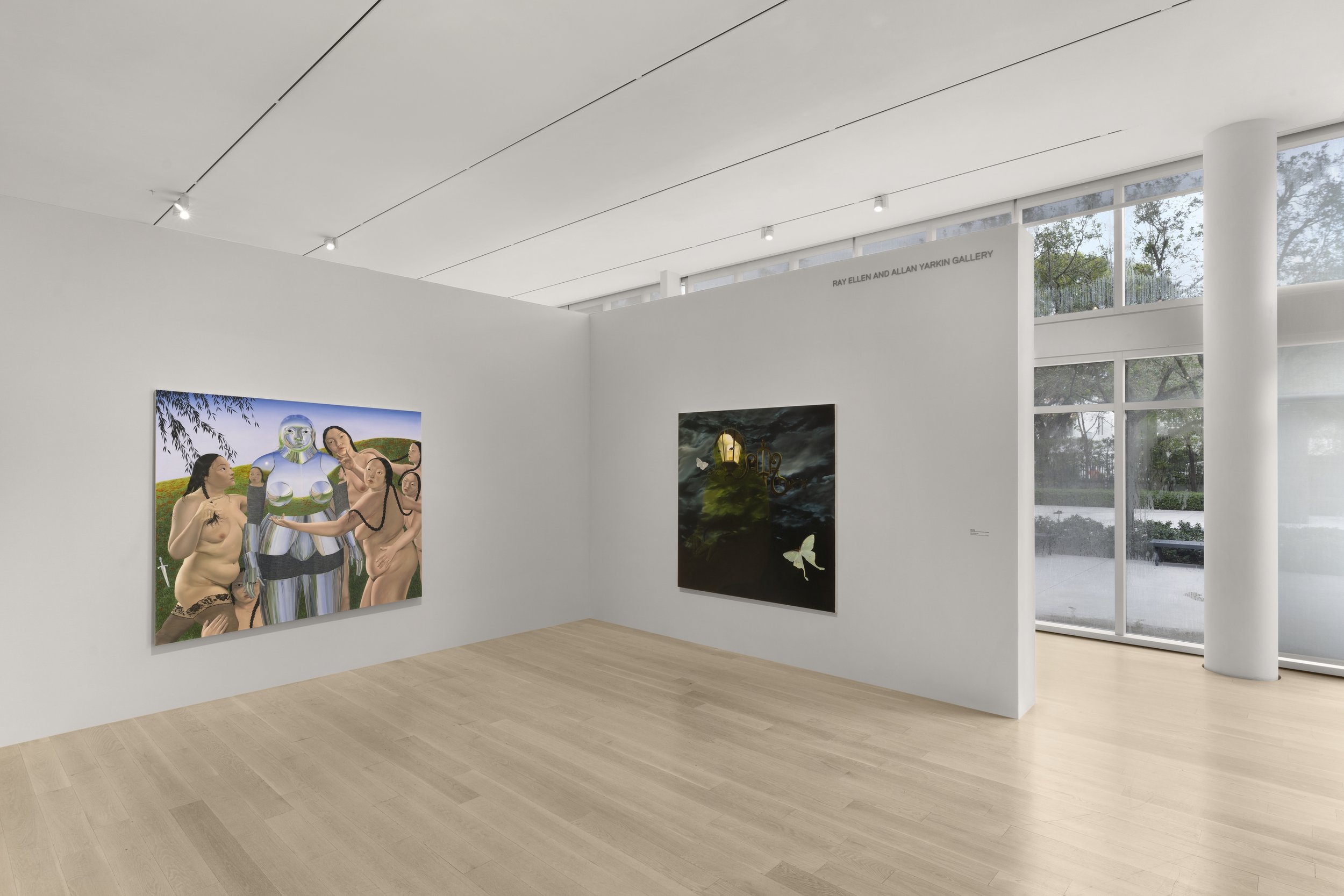









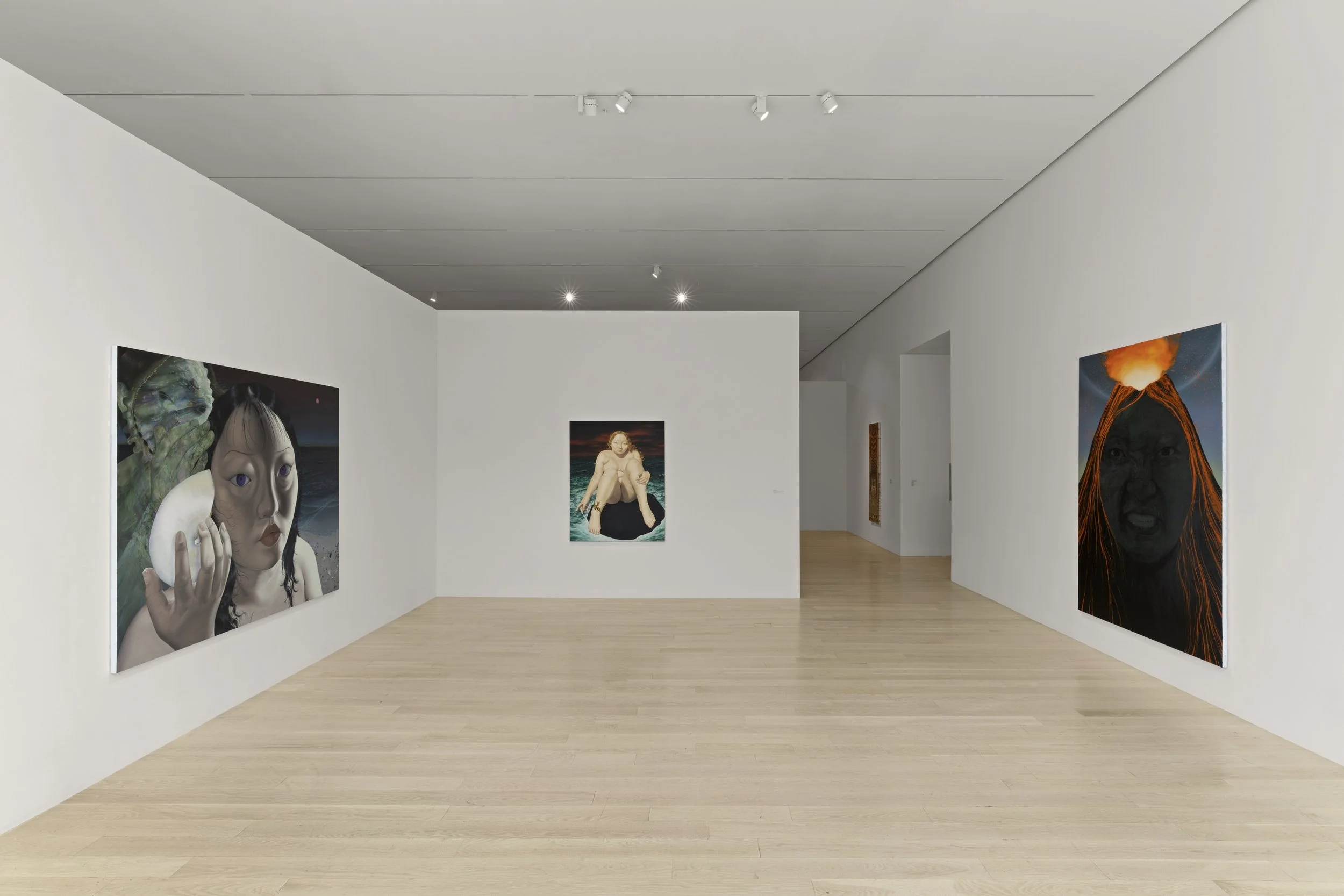

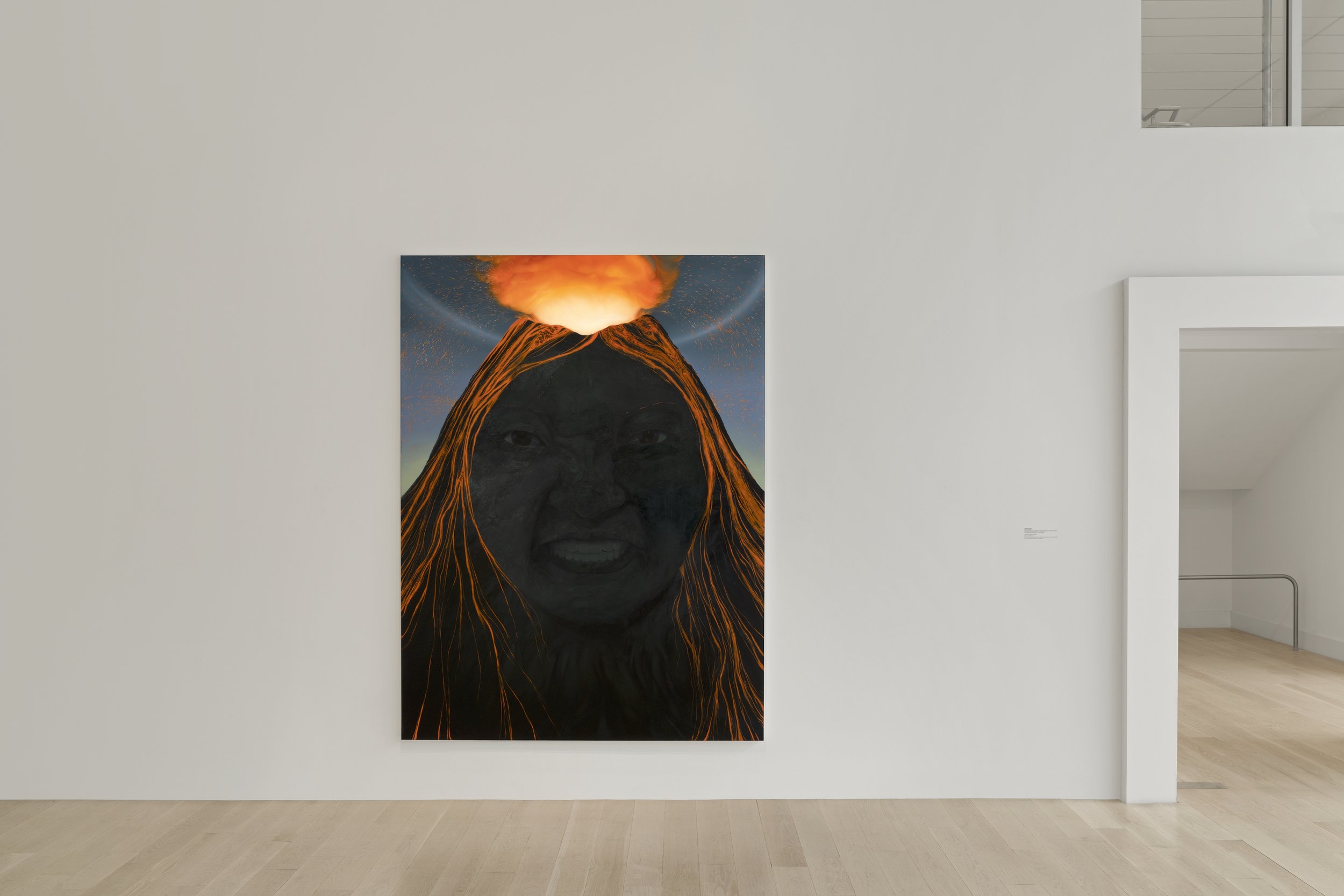



Installation view: "Sasha Gordon: Surrogate Self," at the Institute of Contemporary Art, Miami. Dec 5,2023-Mar 10, 2024. Photograph Zachary Balber.
“Sasha Gordon is a leader in the field of contemporary painting, with a unique ability to communicate complex personal and cultural issues through her exquisite and inventive technique. We are proud to bring together new and very recent works in order to amplify Sasha's ideas about identity, objectification, and the politics of representation,” said Gartenfeld. “As Gordon’s debut solo museum exhibition, this presentation exemplifies ICA Miami’s commitment to providing the first institutional platform for important artists, and providing early-career contextualization through scholarship and conversation.”
Alongside Sasha Gordon this fall, ICA Miami opens a robust roster of solo exhibitions and installations, including a three-decade survey of renowned conceptual artist Charles Gaines; a presentation of works by under-recognized painter Ahmed Morsi; a major new installation by Tau Lewis, the 2023 recipient of the Ezratti Family Prize for Sculpture; and a new monumental photographic installation by Anne Collier, animating the museum’s dramatic central staircase. Image: Sasha Gordon, Like Froth (2022). Oil on canvas. 60 x 48 in. 152.4 x 121.9 cm. Courtesy Matthew Brown Gallery.
About Sasha Gordon
Sasha Gordon (b. 1998, Somers, New York) lives and works in New York. She graduated from the Rhode Island School of Design (RISD), Providence, in 2021. Solo exhibitions include “Hands of Others,” Jeffrey Deitch, New York (2022) and “Enters Thief,” Matthew Brown, Los Angeles (2021). Her work is included in the collections of ICA Miami; Hammer Museum, Los Angeles; Museum of Fine Arts, Houston; and the Los Angeles County Museum of Art. Support Lead support for Sasha Gordon is provided by Matthew and Stephanie Herfield. Major support is provided by the Nicoll Family Fund. Additional support is provided by Stefanie, Andrew, and Rebecca Reed, in honor of Evan J Reed. Exhibitions at ICA Miami are supported by the Knight Foundation.
About the Institute of Contemporary Art, Miami
The Institute of Contemporary Art, Miami (ICA Miami) is dedicated to promoting continuous experimentation in contemporary art, advancing new scholarship, and fostering the exchange of art and ideas throughout the Miami region and internationally. Through an energetic calendar of exhibitions and programs and its collection, ICA Miami provides an important international platform for the work of local, emerging, and under-recognized artists and advances the public appreciation and understanding of the most innovative art of our time. Launched in 2014, ICA Miami opened its new permanent home in Miami’s Design District on December 1, 2017. The museum’s central location positions it as a cultural anchor within the community and enhances its role in developing cultural literacy throughout the Miami region. The museum offers free admission, providing audiences with open, public access to artistic excellence year-round.
The Institute of Contemporary Art, Miami, is located at 61 NE 41st Street, Miami, Florida 33137. For more information, visit here or follow the museum on Instagram, You Tube, and Facebook
Marina Perez Simão: Solanaceae
Marina Perez Simão: Solanaceae 1201 South La Brea Avenue, Los Angeles, CA 90019, January 20–March 2, 2024 Photography courtesy Pace Gallery
Los Angeles – Pace is pleased to be presenting an exhibition of immersive paintings by Marina Perez Simão at its Los Angeles gallery. The exhibition opened on January 20 and will close on March 2, 2024; the show, titled Solanaceae, will bring together some 15 canvases of various sizes—including monumental panoramas—created by the artist in the past year. Solanaceae will mark Simão’s first-ever solo presentation in LA and, more broadly, on the West Coast of the United States, and the exhibition will coincide with the 2024 edition of Frieze LA. It will be accompanied by a new catalogue from Pace Publishing, featuring a foreword by the gallery’s Curatorial Director Kimberly Drew, as well as an original essay by SCAD Museum of Art Assistant Curator Brittany Richmond.
Untitled/Sem título, 2023 PAINTING oil on linen 185 cm × 380 cm (72-13/16" × 12' 5-5/8") No. 90106 © Marina Perez Simão, courtesy Pace Gallery
Working across oil painting, watercolor, and printmaking, Simão is known for her vibrant, lyrical compositions exploring both interior and exterior landscapes. Through her practice, she constructs visual journeys into semiabstract and often unknowable realms made up of organic, undulating forms. Imbued with visions and memories, Simão’s oneiric landscapes reflect her deep and enduring interest in abstraction’s power to convey ideas, concepts, and feelings that transcend language.
Untitled/Sem título, 2023 PAINTING oil on linen 136 cm × 108 cm (53-9/16" × 42-1/2") No. 90118 © Marina Perez Simão, courtesy Pace Gallery
In the paintings for her upcoming exhibition with Pace in LA—which takes the scientific name for the nightshades family of plants as its title—the artist meditates on the phenomenological effects of different conditions of light and its absence. In a departure from her past works, Simão has adopted a palette of deep, dark colors for her new landscapes, combining multiple hues at a time to emulate the nuances of bioluminescence. Elaborating upon her recent experimentations with traditional Florentine fresco techniques for a painting she showed this year in São Paulo, Simão has realized many of these landscapes at grander scales than she has ever worked in before, with two monumental compositions each extending more than 12-feet in width. As part of her process for making these paintings, she experiments with forms in watercolors and smaller scales, bringing a confident intuition to her final, large-scale compositions.
Untitled/Sem título (Detail), 2023 PAINTING oil on linen 200 cm × 170 cm (78-3/4" × 66-15/16") No. 90109 © Marina Perez Simão, courtesy Pace Gallery
Tapping into the rich material histories of murals and frescos, mediums often associated with depictions of heaven or paradise, the artist’s new large-scale works lend a distinctly experiential and transportive dimension to this presentation. Featuring layers of color, these paintings—which seem to glow and vibrate with energy drawn from an internal, celestial light source—speak to Simão’s unique ability to imbue her work with luminosity.
Untitled/Sem título, 2023 PAINTING oil on linen 200 cm × 170 cm (78-3/4" × 66-15/16") No. 90110 © Marina Perez Simão, courtesy Pace Gallery
Her paintings are marked by expressive and gestural brushstrokes, which respond to one another within individual works and across multiple compositions, giving the entire exhibition a sense of continuity and consequence with respect to time and movement. In her tableaus that suggest caves, forests, rivers, waterfalls, and other environments, Simão examines the way that light can function as a supernatural force in our experience of nature. Boundaries between interior and exterior spaces are blurred and, in some cases, obliterated in these scenes of unreality and mystery.
Untitled/Sem título, 2023 PAINTING oil on linen 170 cm × 136 cm (66-15/16" × 53-9/16") No. 90116 © Marina Perez Simão, courtesy Pace Gallery
Among Simão’s recent projects was her 2022 residency with Cahiers d’Art in Paris, where she presented an exhibition of watercolors.

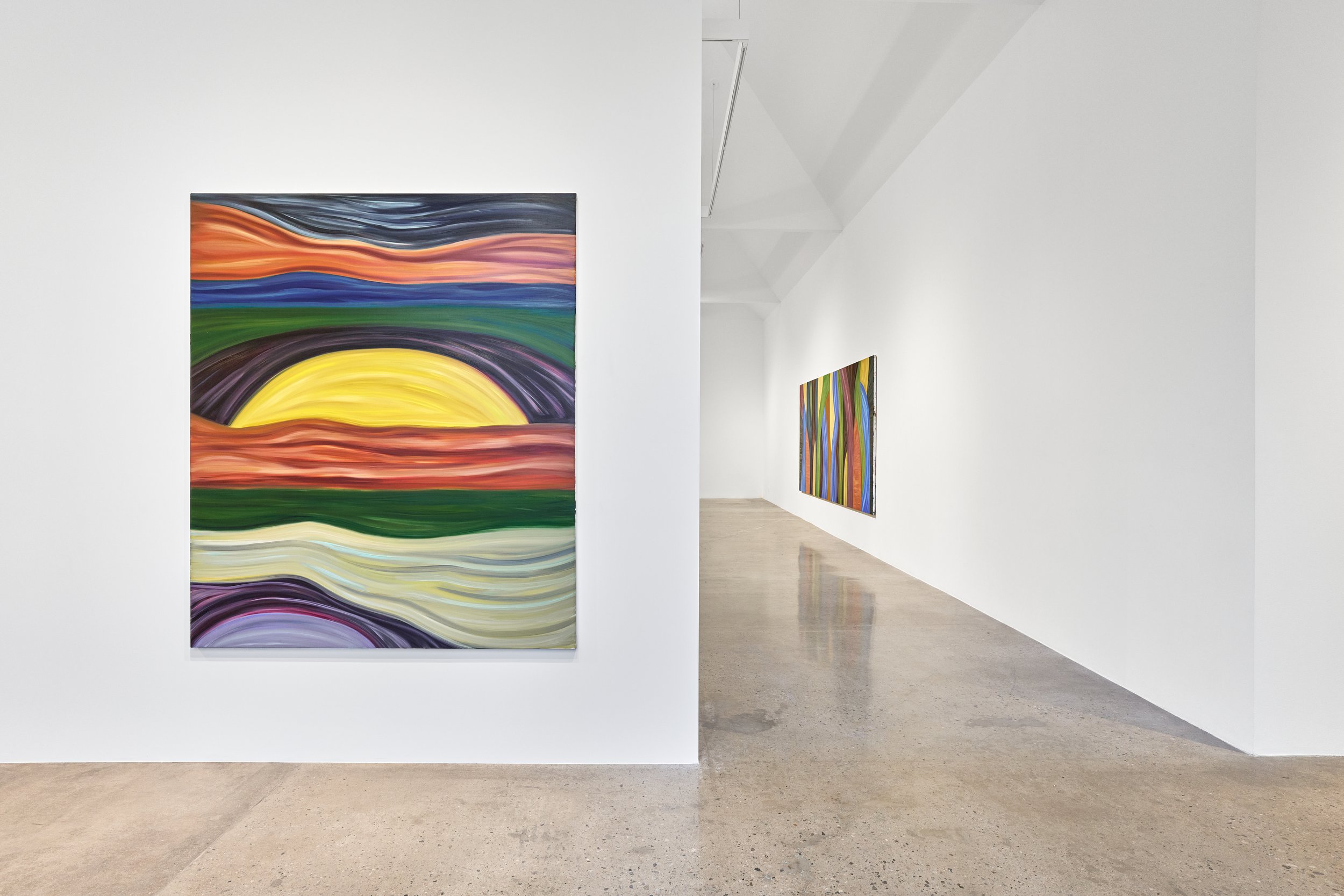
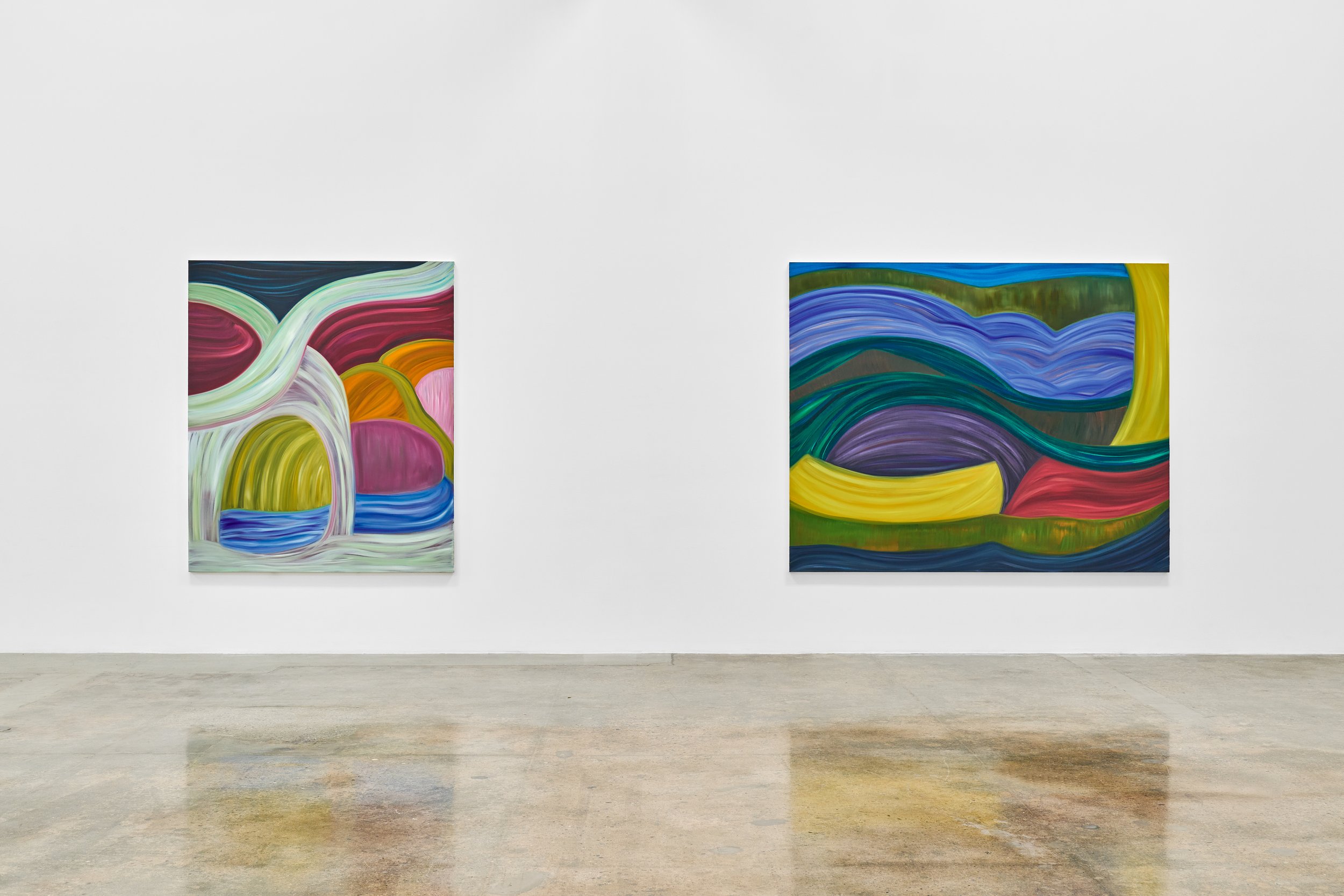
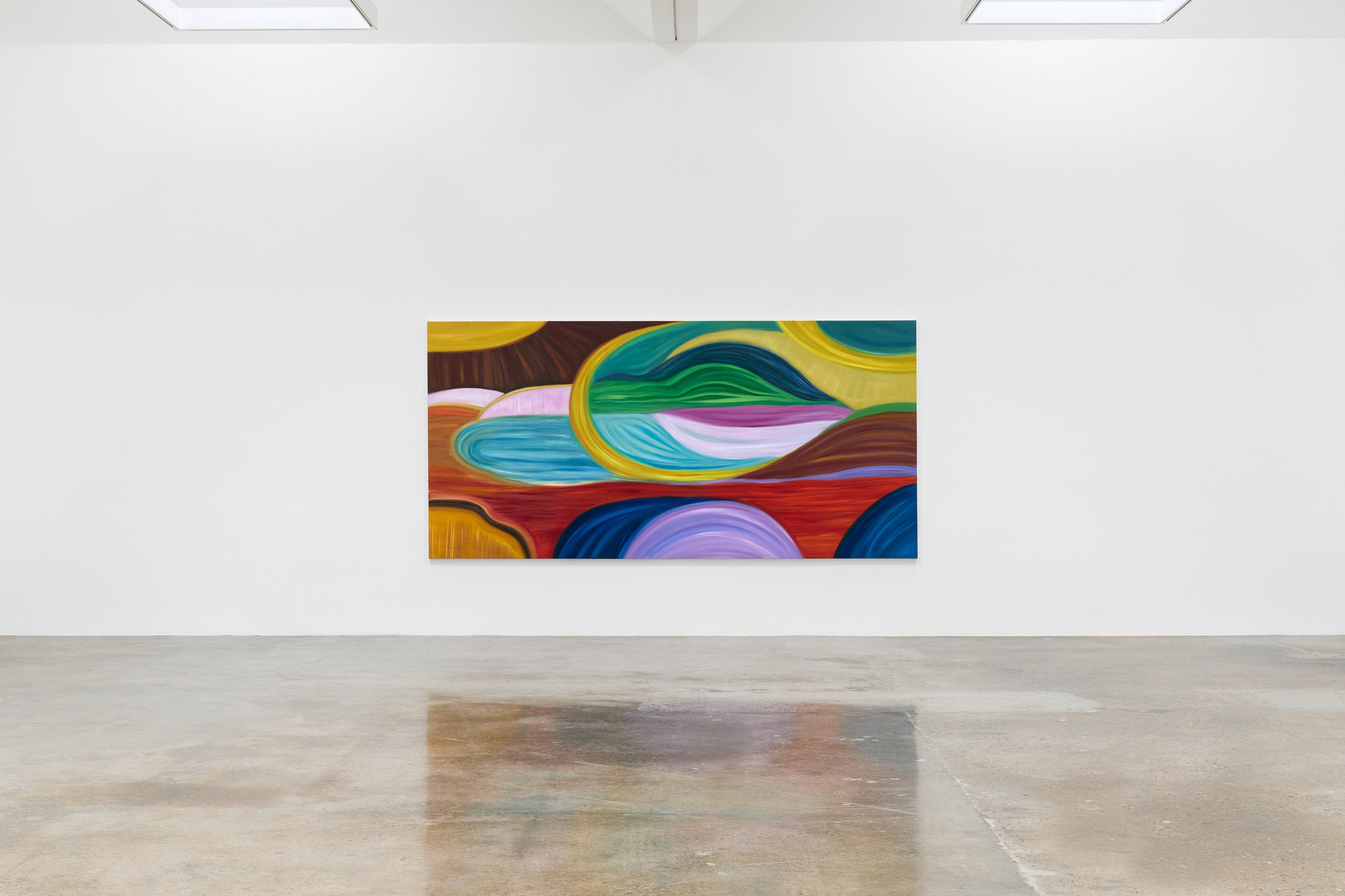
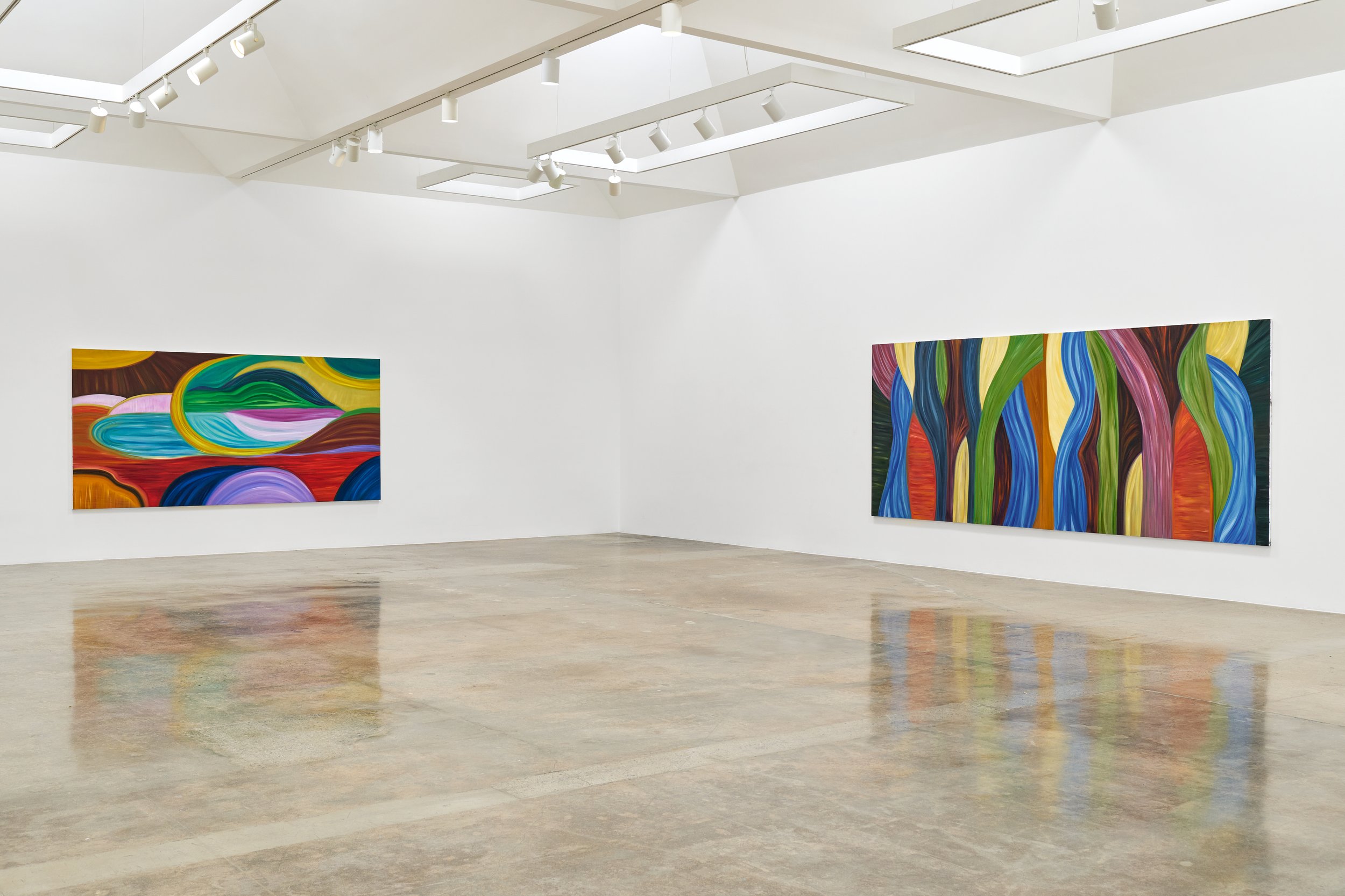
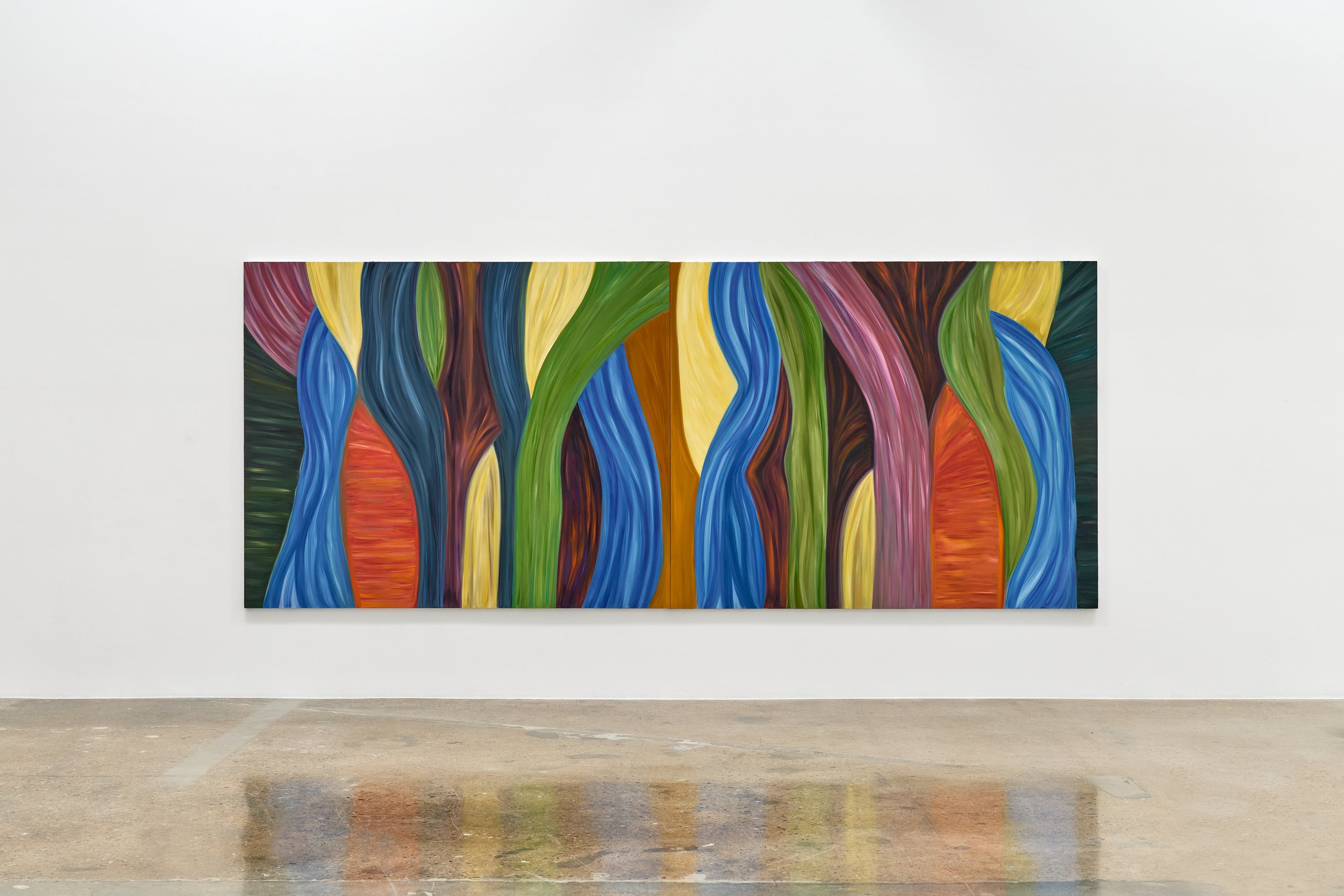

Marina Perez Simão: Solanaceae, 1201 South La Brea Avenue, Los Angeles, CA 90019, January 20–March 2, 2024 Photography courtesy Pace Gallery
Marina Perez Simão (b. 1980, Vitória, Brazil) has developed a working process based fundamentally on the accumulation and juxtaposition of memories and images. By combining personal experiences and multiple references stemming from fields such as philosophy, literature, and journalism, the artist collects certain narratives in order to edit them through pictorial means that do not belong to any predefined language; rather, they develop with an organic practice, which combines thematic density and a delicate treatment. Simão uses a variety of techniques, such as collage, drawing, and oil painting, as starting points in order to marry interior and exterior landscapes, she composes visual journeys that sometimes traverse the unknown, the abstract and the nebulous, but also include visions and memories. Simão’s work is held in several public collections worldwide, including the Musée d’Art Moderne et Contemporain de Saint-Étienne in France, The Ekard Collection in the Netherlands, and the Samdani Art Foundation in Bangladesh, as well as the Speed Art Museum in Kentucky and the University of Chicago in the United States.
Pace is a leading international art gallery representing some of the most influential contemporary artists and estates from the past century, holding decades-long relationships with Alexander Calder, Jean Dubuffet, Barbara Hepworth, Agnes Martin, Louise Nevelson, and Mark Rothko. Pace enjoys a unique U.S. heritage spanning East and West coasts through its early support of artists central to the Abstract Expressionist and Light and Space movements.
Since its founding by Arne Glimcher in 1960, Pace has developed a distinguished legacy as an artist-first gallery that mounts seminal historical and contemporary exhibitions. Under the current leadership of CEO Marc Glimcher, Pace continues to support its artists and share their visionary work with audiences worldwide by remaining at the forefront of innovation. Now in its seventh decade, the gallery advances its mission through a robust global program— comprising exhibitions, artist projects, public installations, institutional collaborations, performances, and interdisciplinary projects. Pace has a legacy in art bookmaking and has published over five hundred titles in close collaboration with artists, with a focus on original scholarship and on introducing new voices to the art historical canon.
Today, Pace has seven locations worldwide, including European footholds in London and Geneva as well as Berlin, where the gallery established an office in 2023. Pace maintains two galleries in New York—its headquarters at 540 West 25th Street, which welcomed almost 120,000 visitors and programmed 20 shows in its first six months, and an adjacent 8,000 sq. ft. exhibition space at 510 West 25th Street. Pace’s long and pioneering history in California includes a gallery in Palo Alto, which was open from 2016 to 2022. Pace’s engagement with Silicon Valley’s technology industry has had a lasting impact on the gallery at a global level, accelerating its initiatives connecting art and technology as well as its work with experiential artists. Pace consolidated its West Coast activity through its flagship in Los Angeles, which opened in 2022. Pace was one of the first international galleries to establish outposts in Asia, where it operates permanent gallery spaces in Hong Kong and Seoul, along with an office and viewing room in Beijing. In spring 2024, Pace will open its first gallery space in Japan in Tokyo’s new Azabudai Hills development.
For more information about this exhibition and others, please visit the Pace Gallery’s website here. Pace Gallery can be found on Instagram and Artsy, too.
ODA JAUNE : Miss Understand
Toutes les images / All images : © Courtesy of the artist and TEMPLON, Paris —Brussels — New York
For her first solo exhibition in the United States, the rare and uncanny Oda Jaune unveils a challenging exhibition in New York. “Miss Understand” offers a series of nearly 25 new oil paintings and dozens of watercolors, on a singular perception of the woman in our time.
Oda Jaune, Bulgarian in origin and trained in Germany, has for nearly 15 years been among the most intriguing figures on the European art scene with a body of work freed from any pictorial convention. Poetic, sensual, and expansive, her painting ignites conversation and explores, without inhibition, the depth of femininity today.
At the core of this new exhibition is a spectacular and large canvas. The work captivates and challenges. A baby is cradled in a nurturing embrace within softly curvaceous, winged forms, floating upon a fleshy landscape. The audience is reminded that all life emerges through the womb as a unique being. A single eye, nestled in the heart of a fetal composition, secretes tender tears – an intimate window into the sacrifices made upon becoming a mother. Just as memories of this rite of passage are non-linear, little by little, this intriguing enigma unfolds an ode to motherhood that is as poignant as it is astonishing.

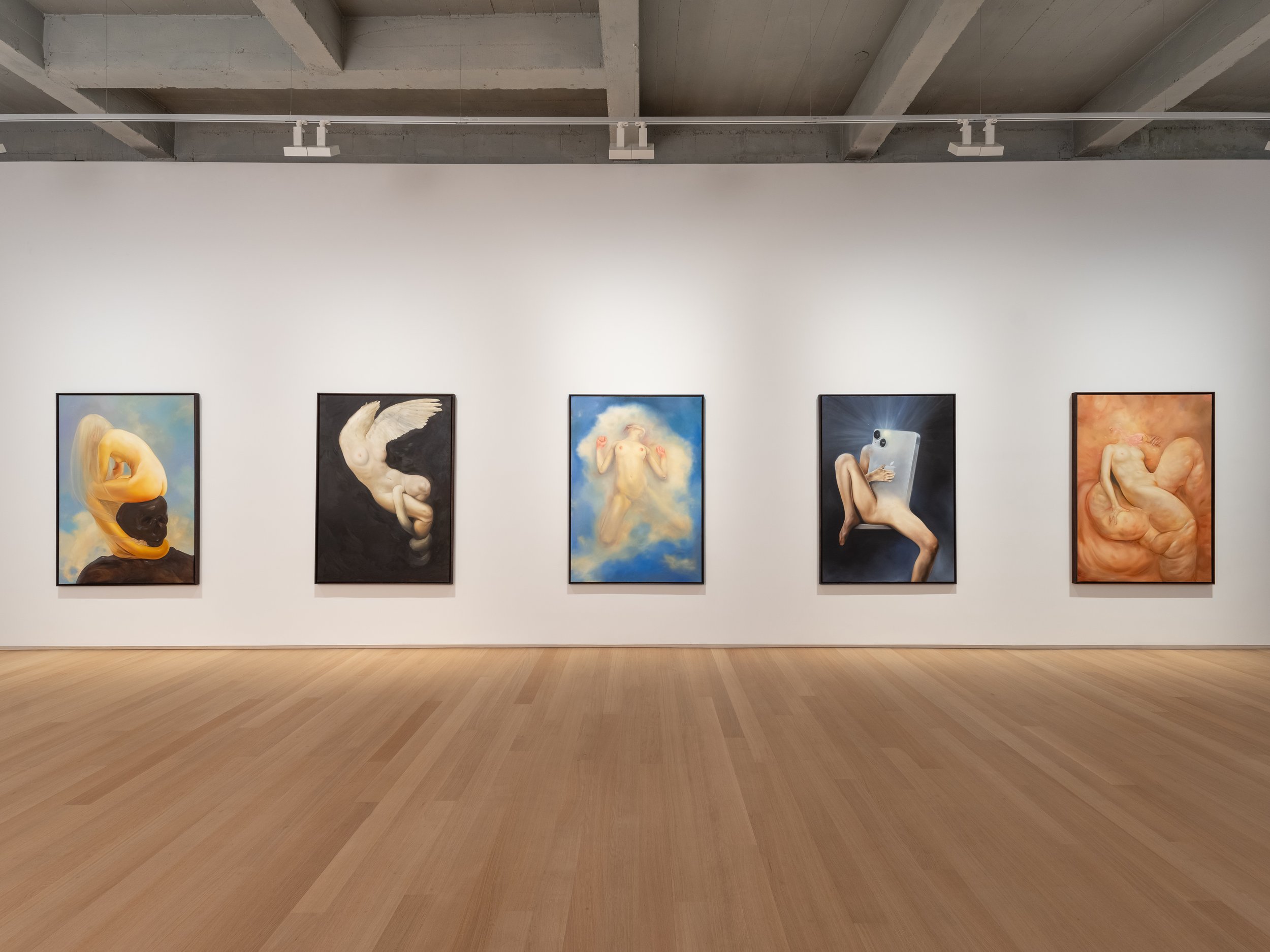

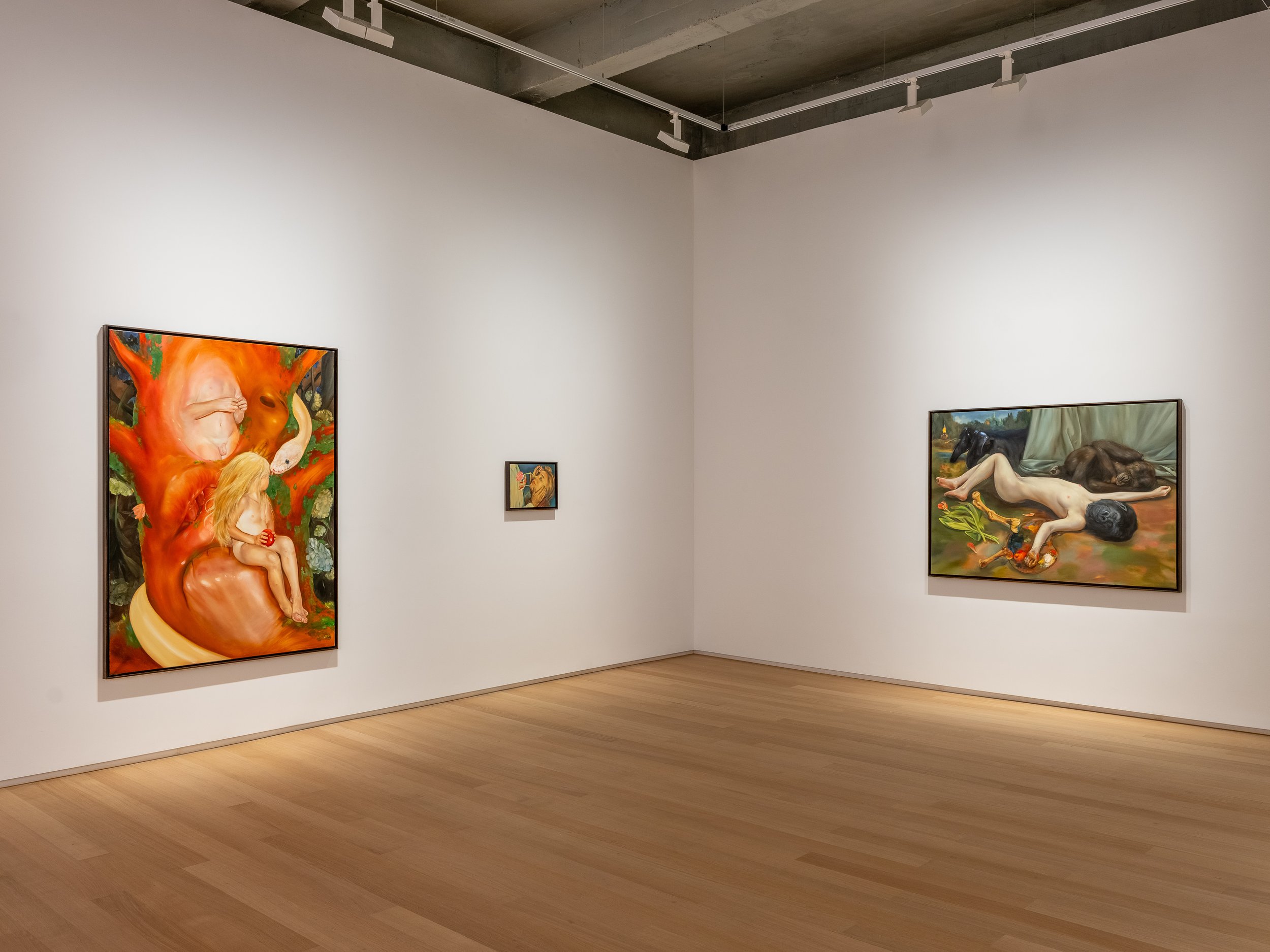
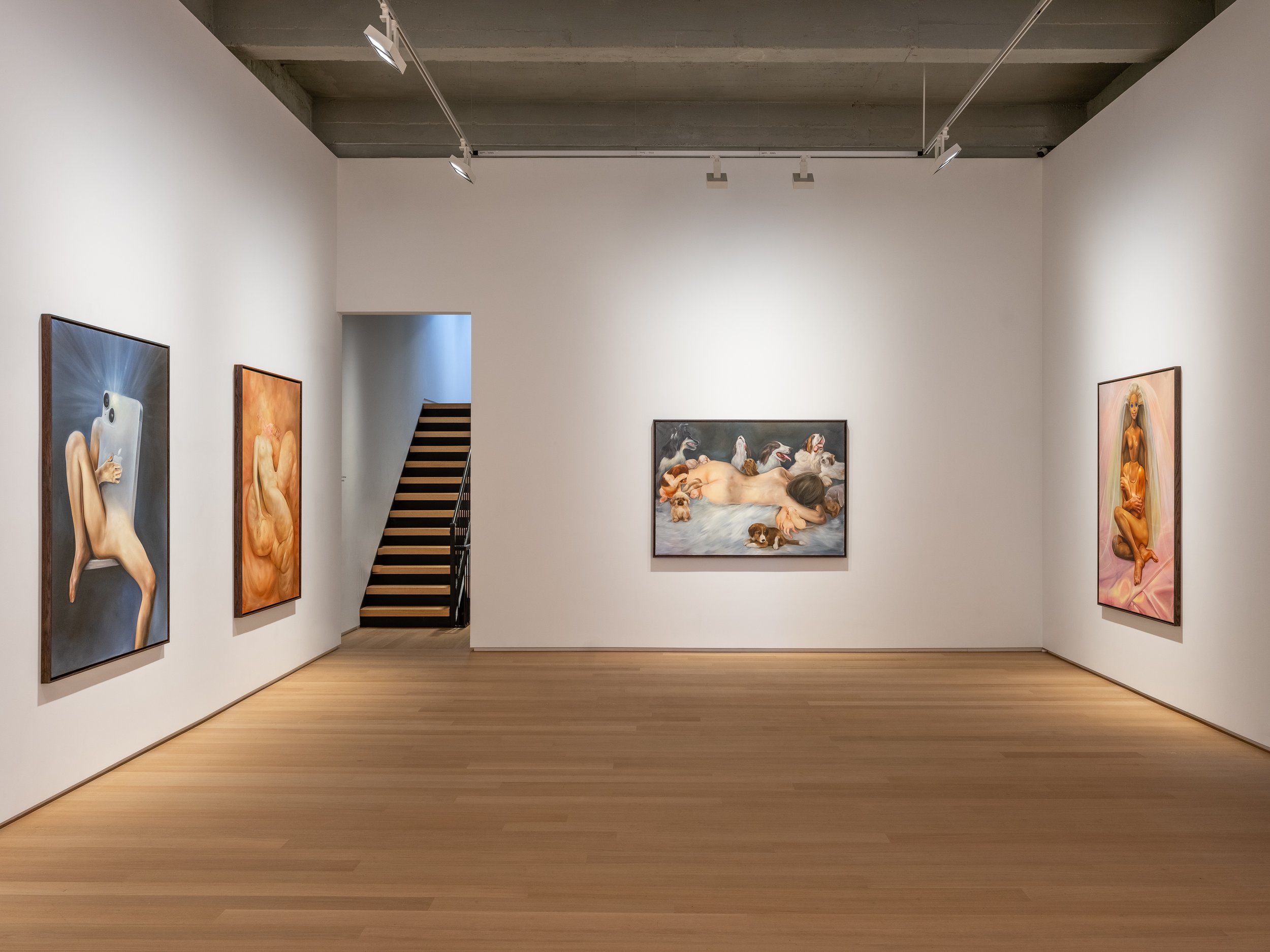
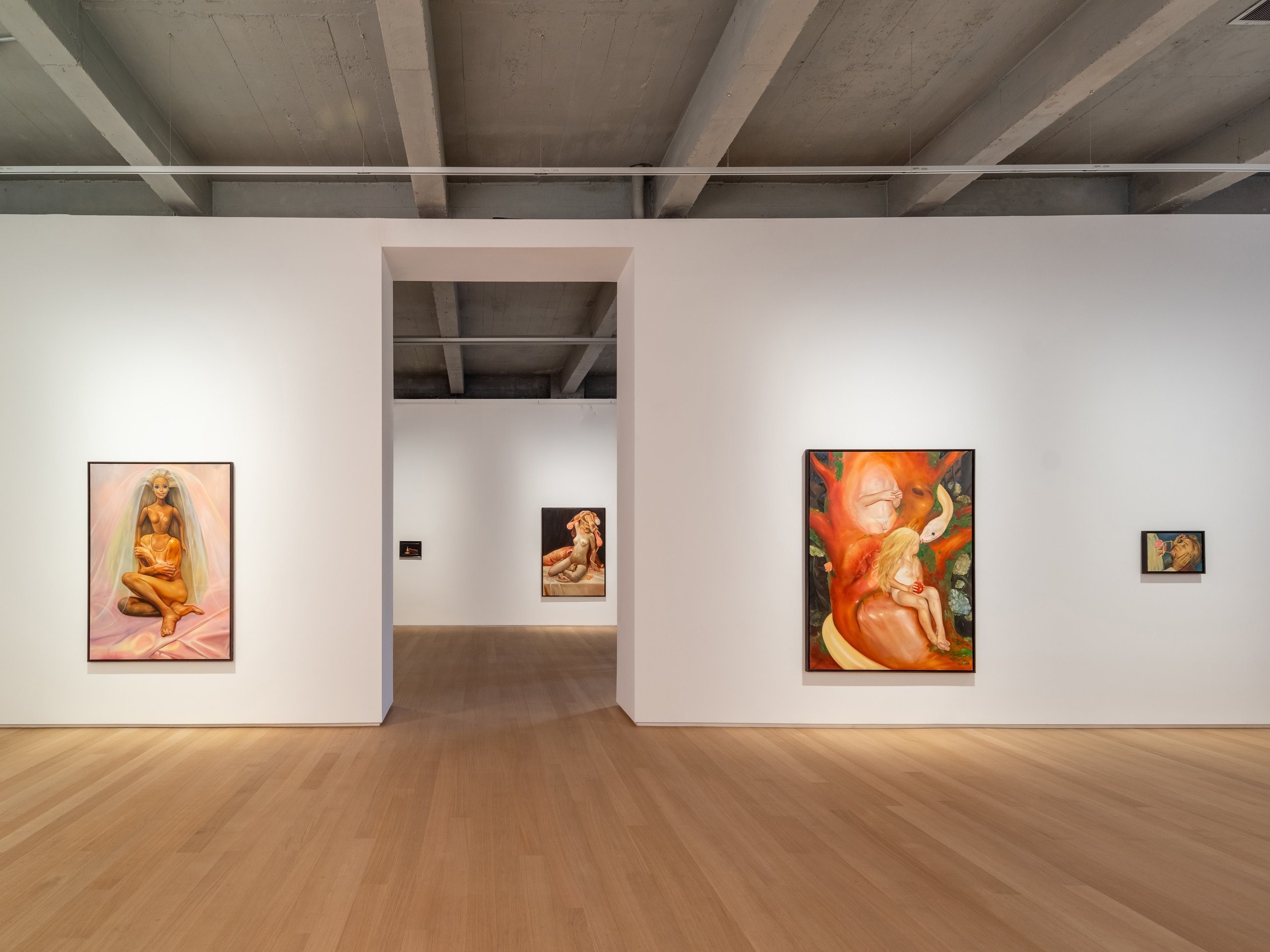
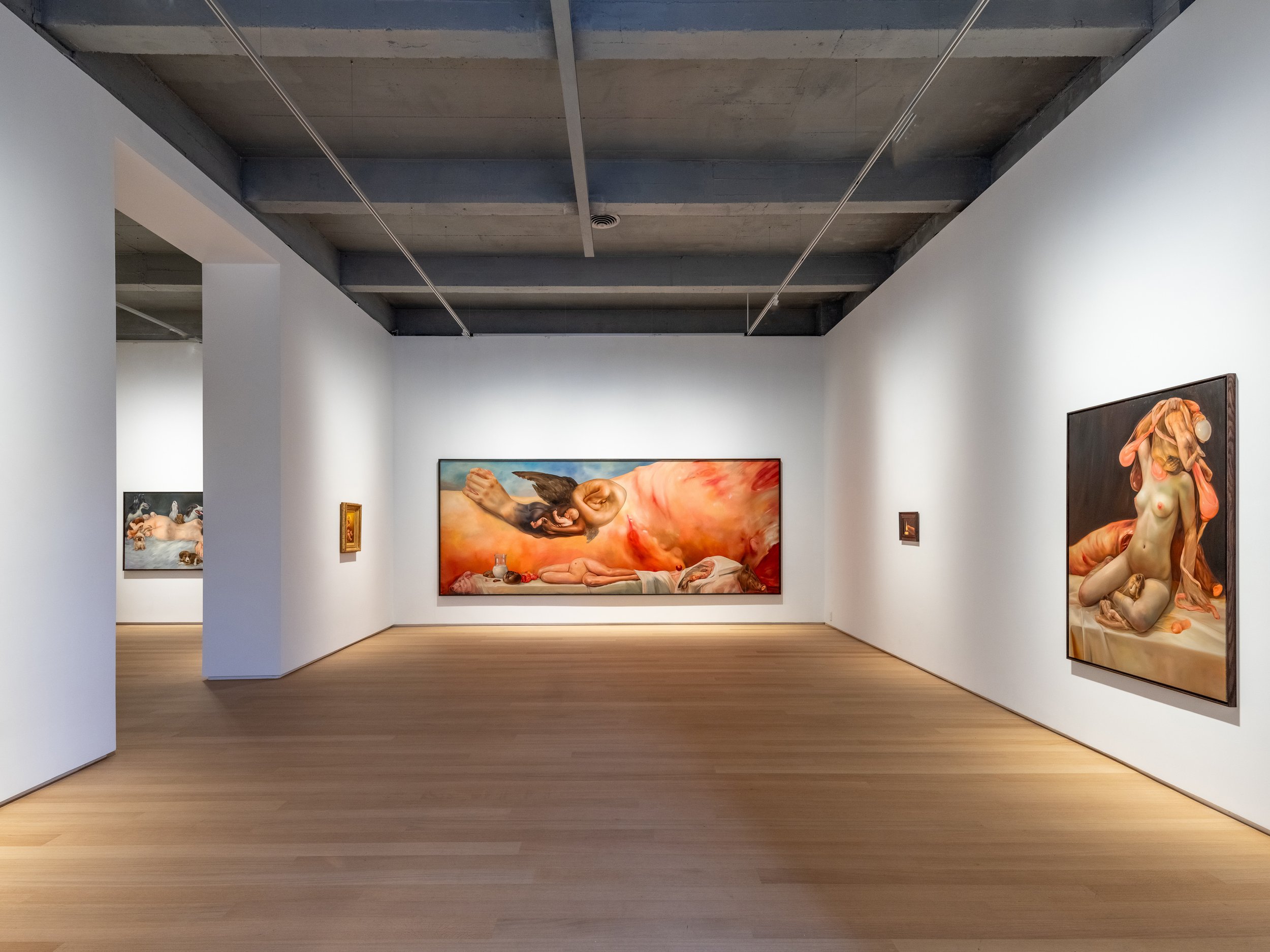
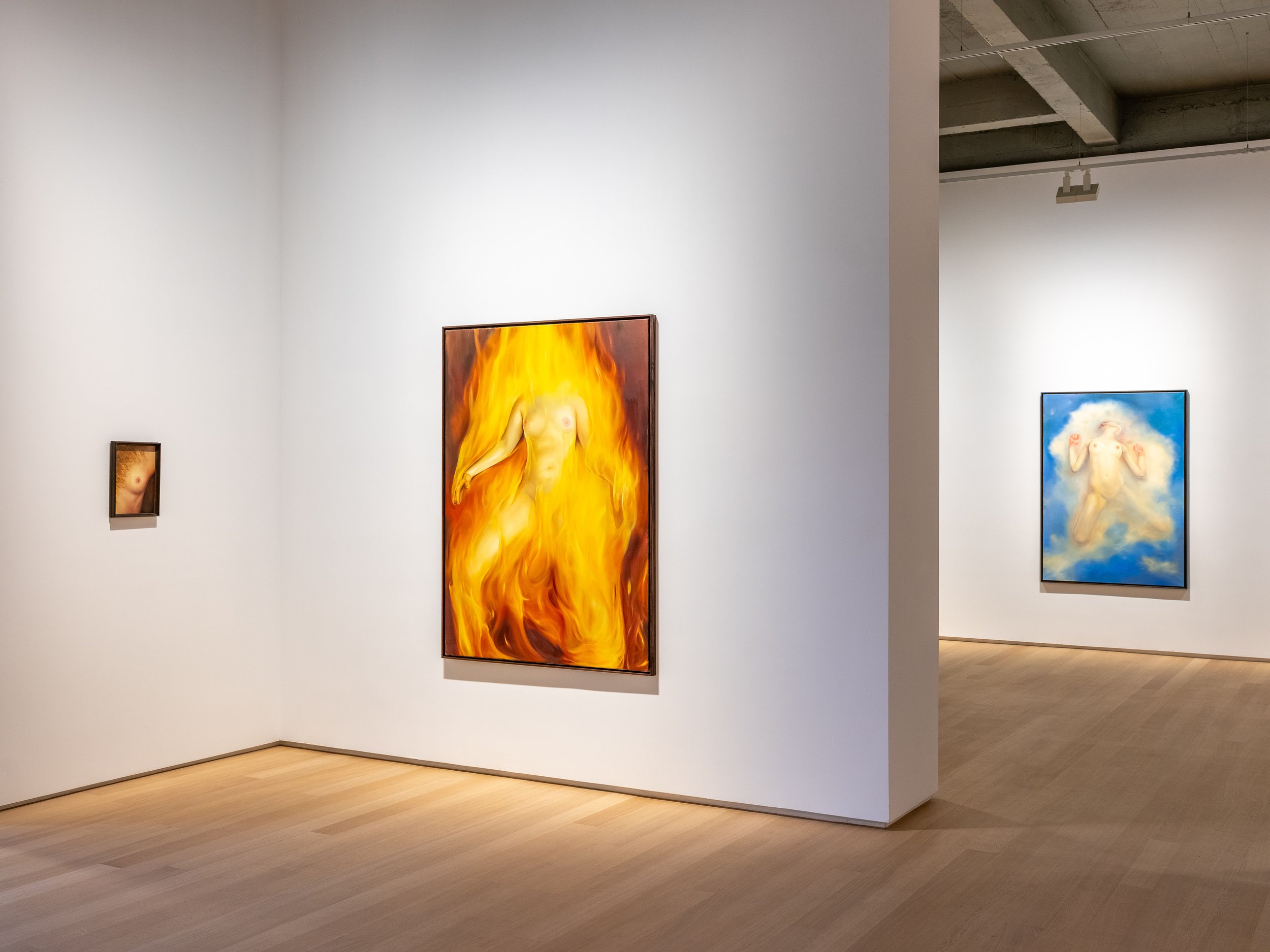
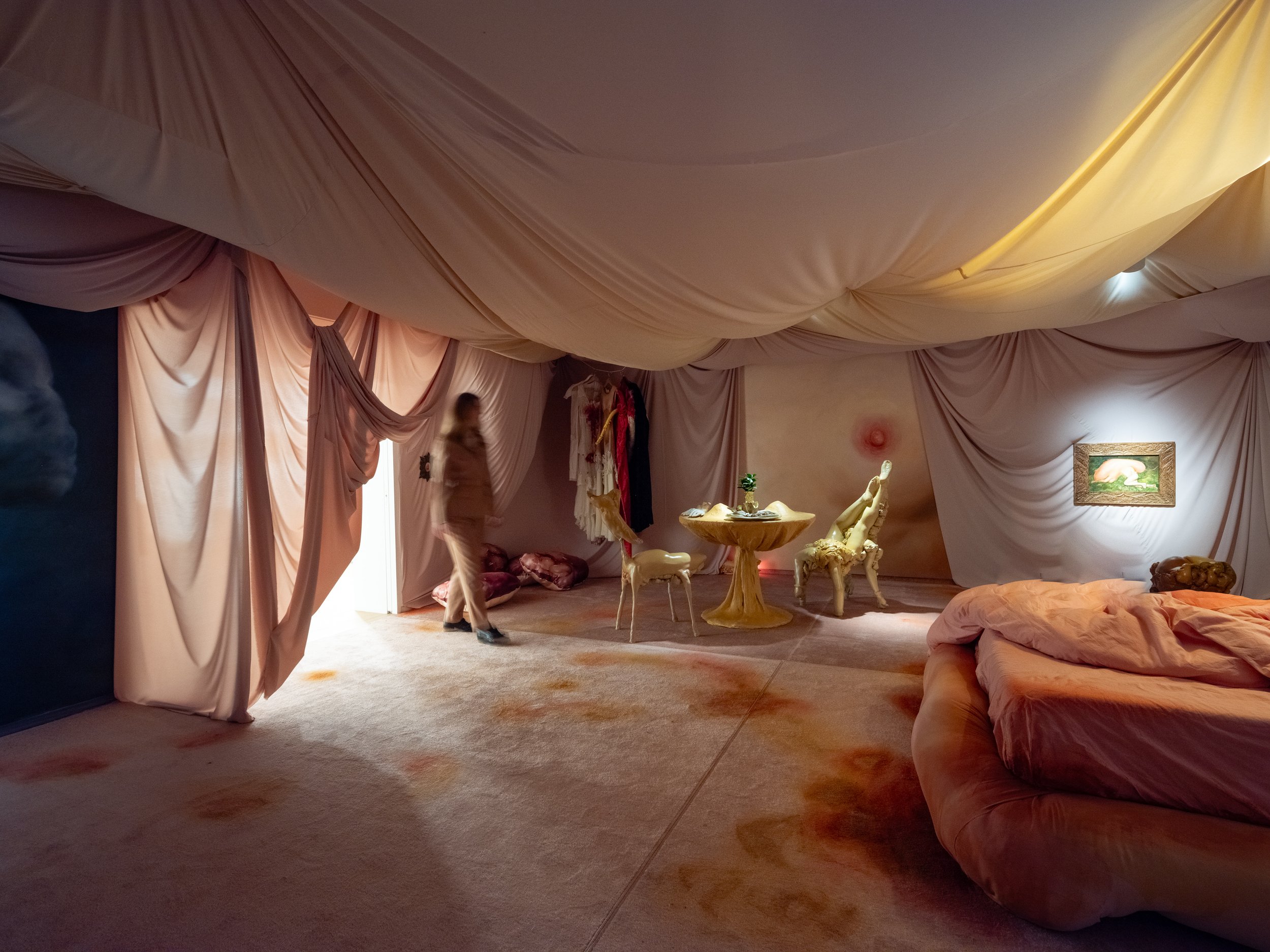
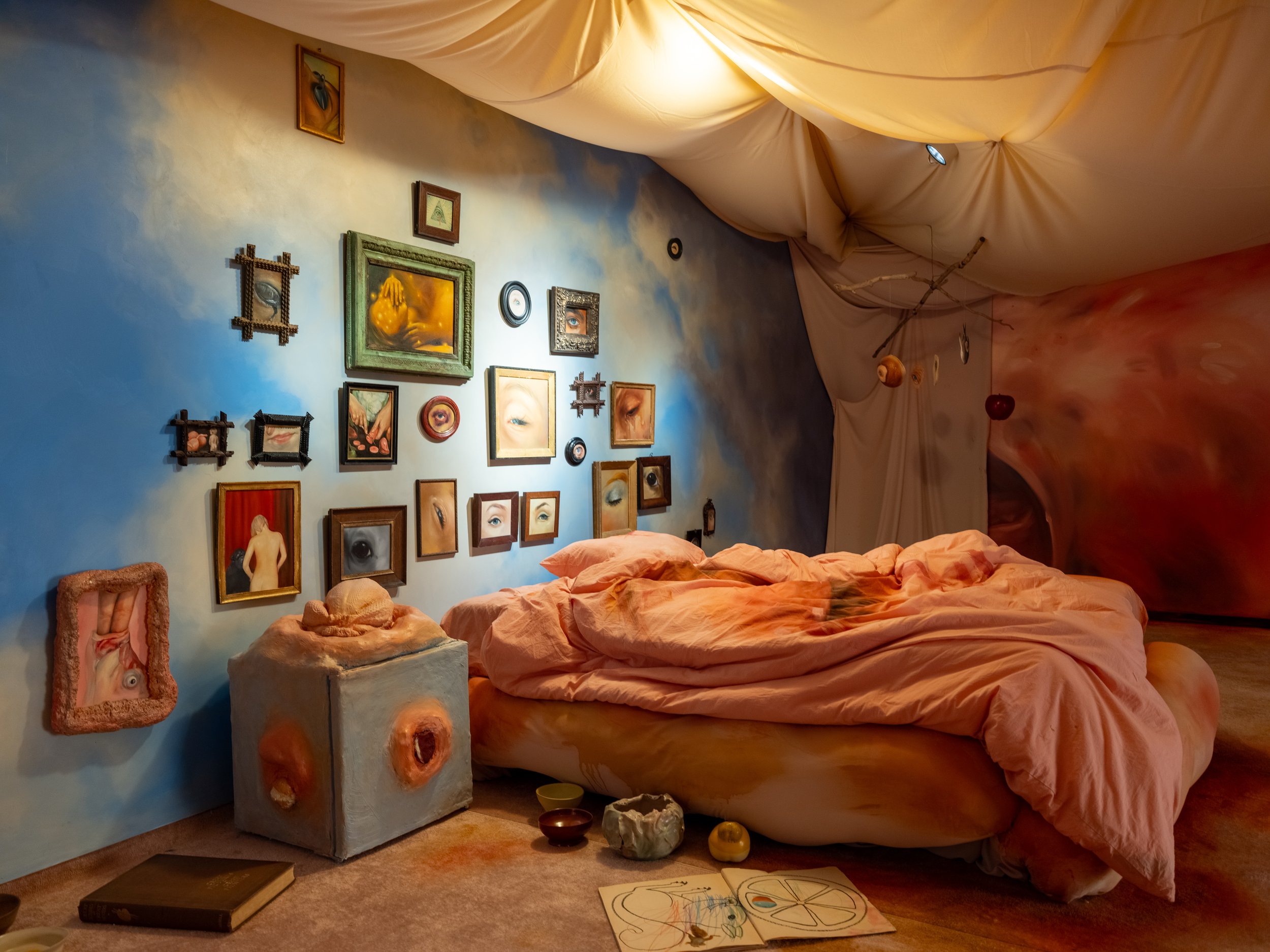
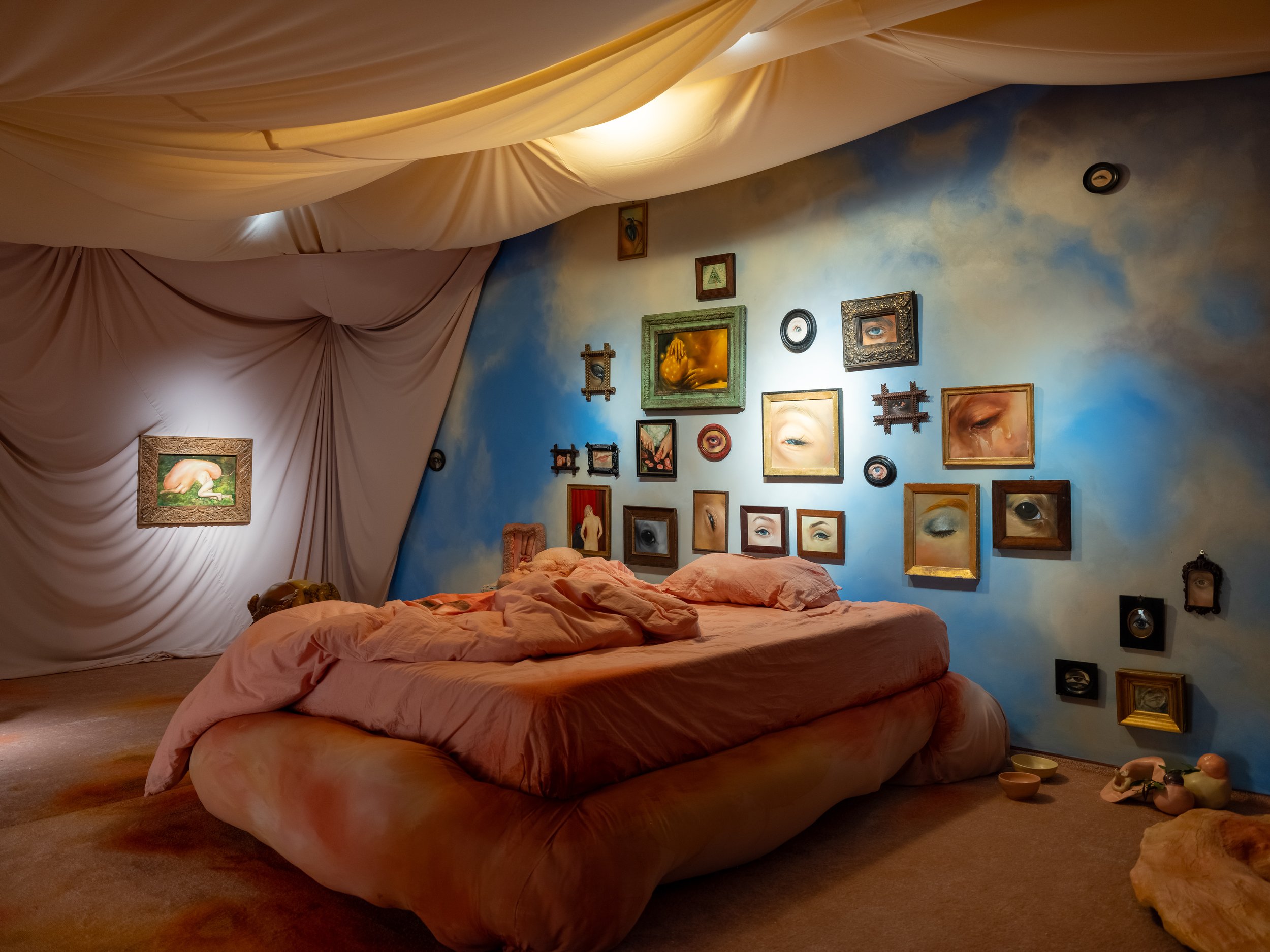
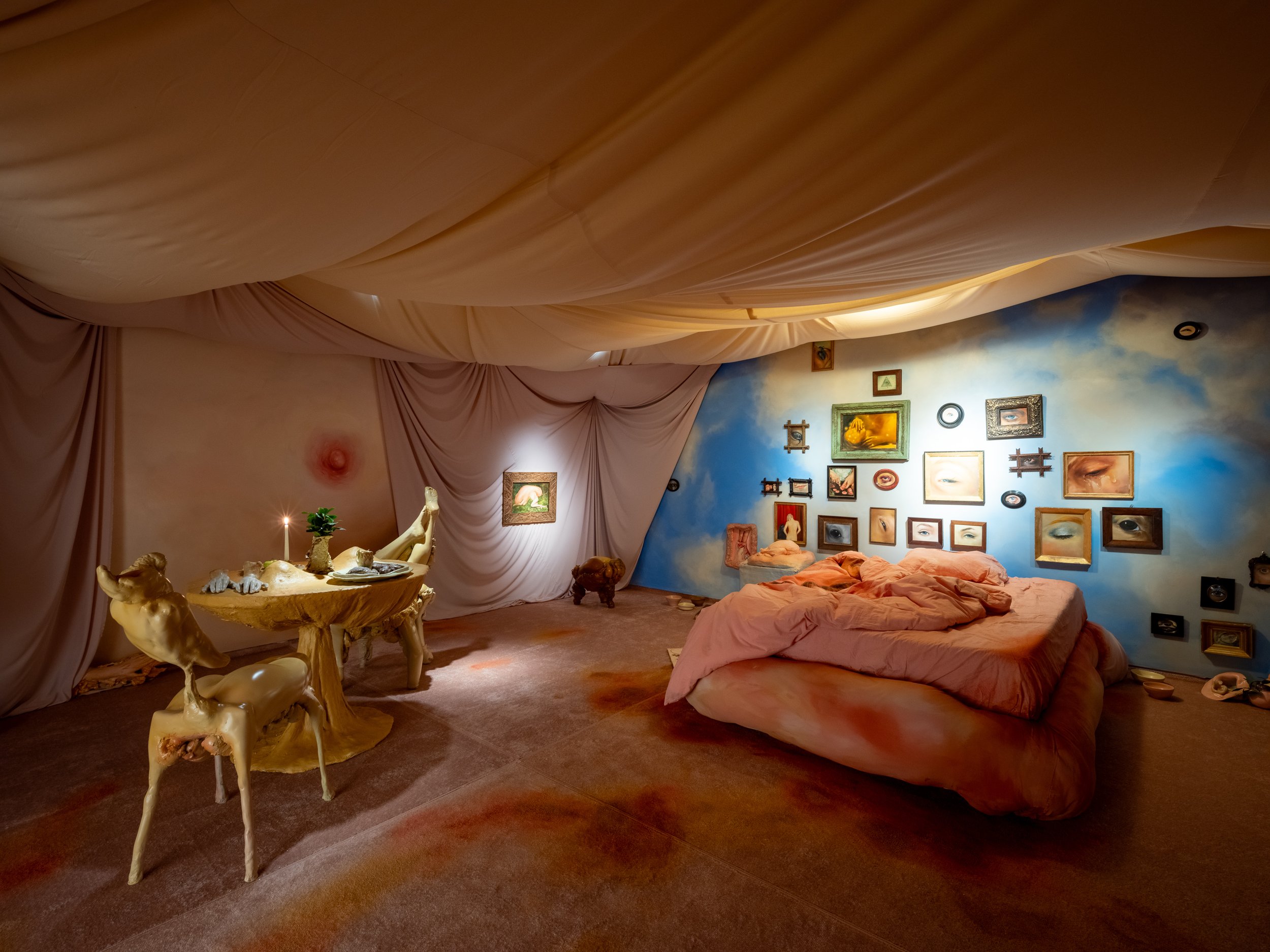
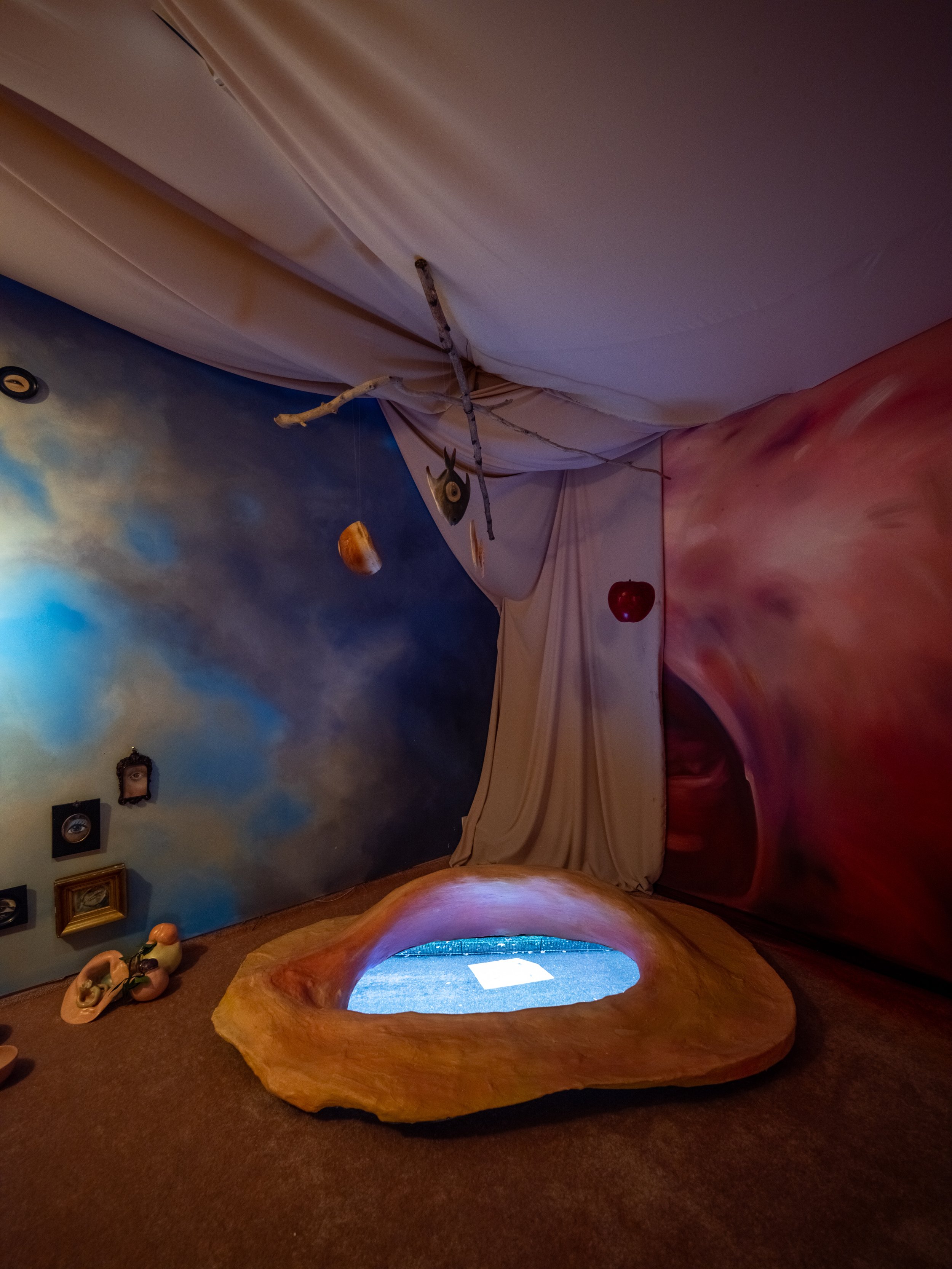
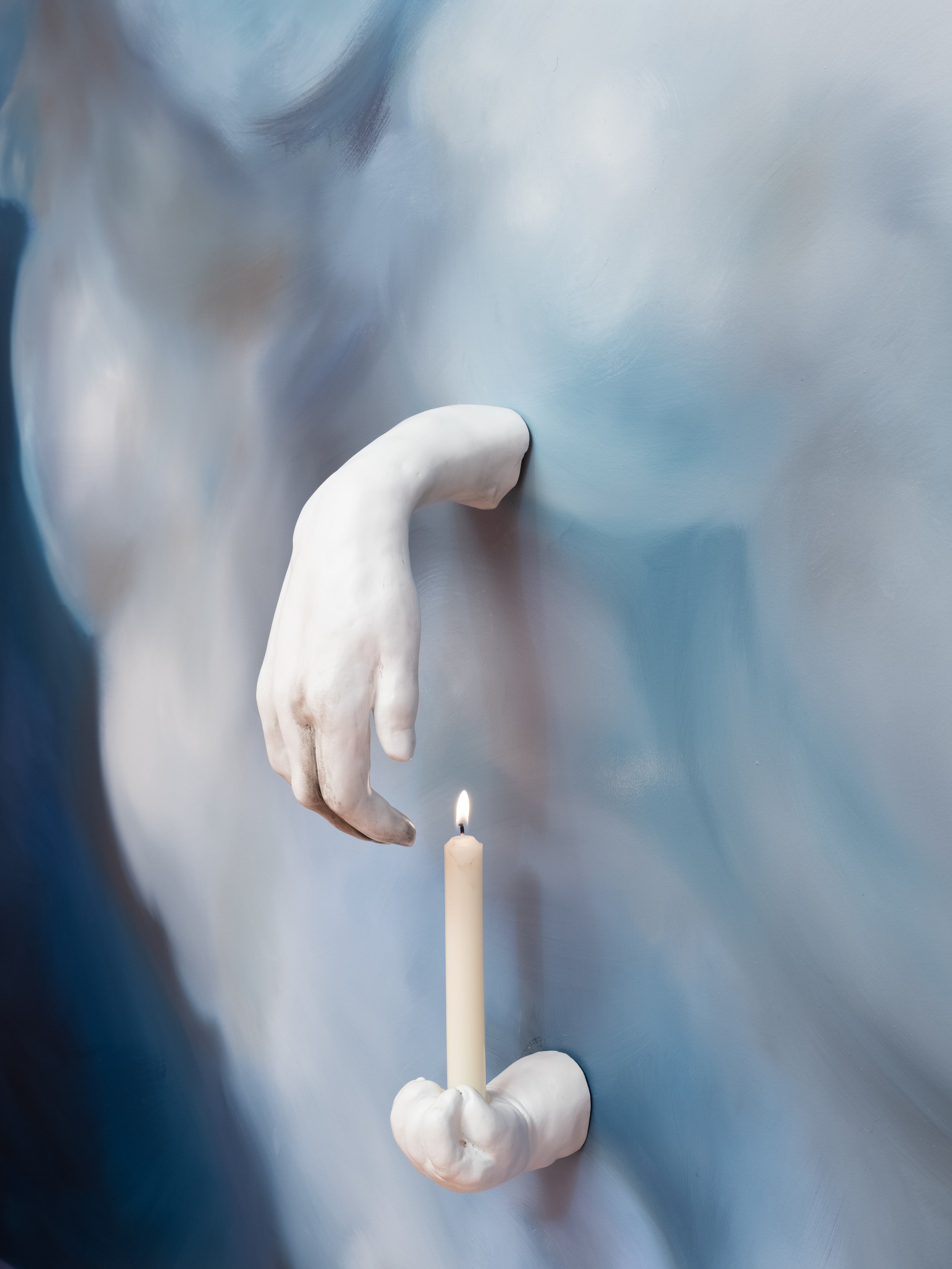
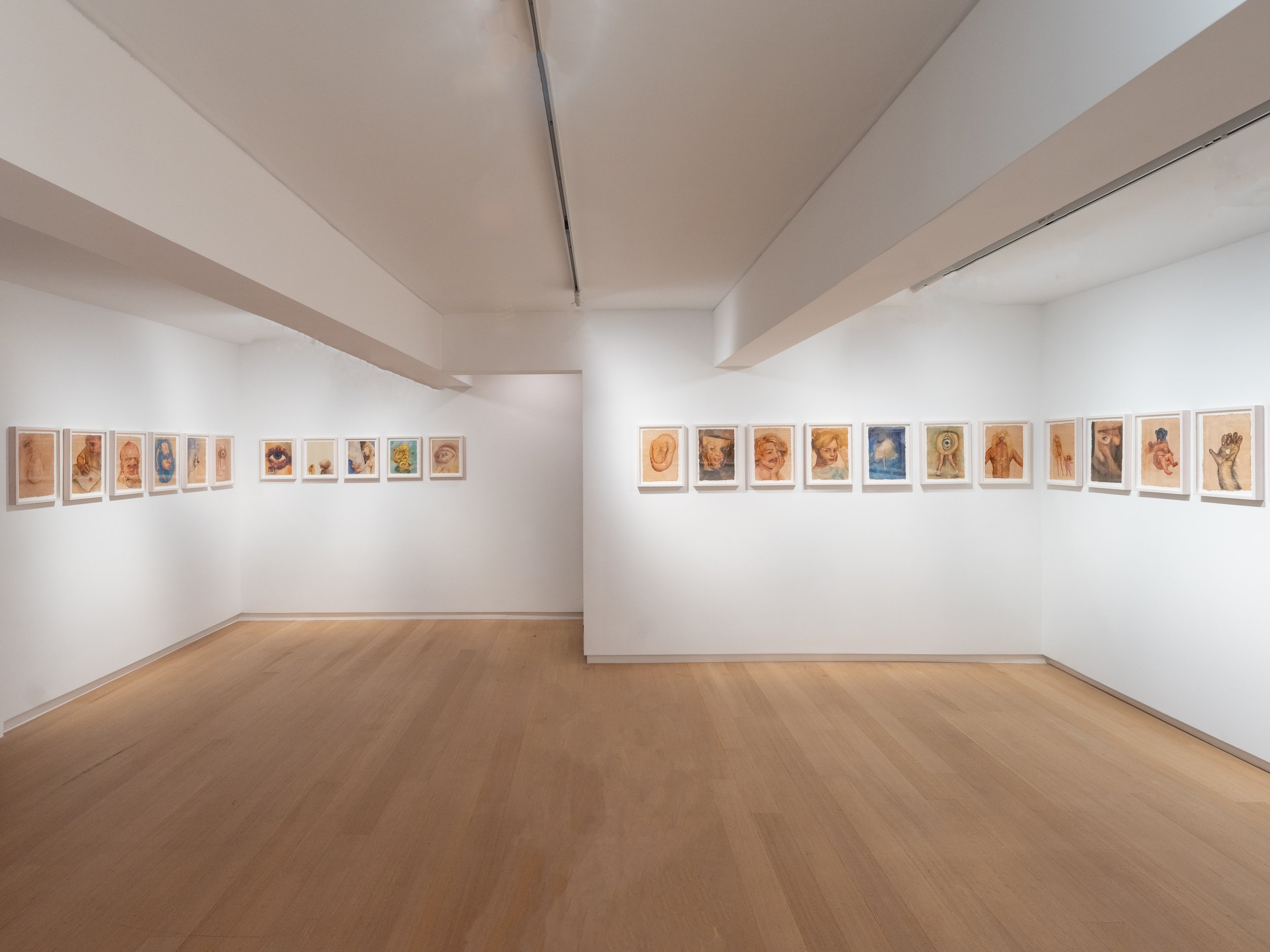
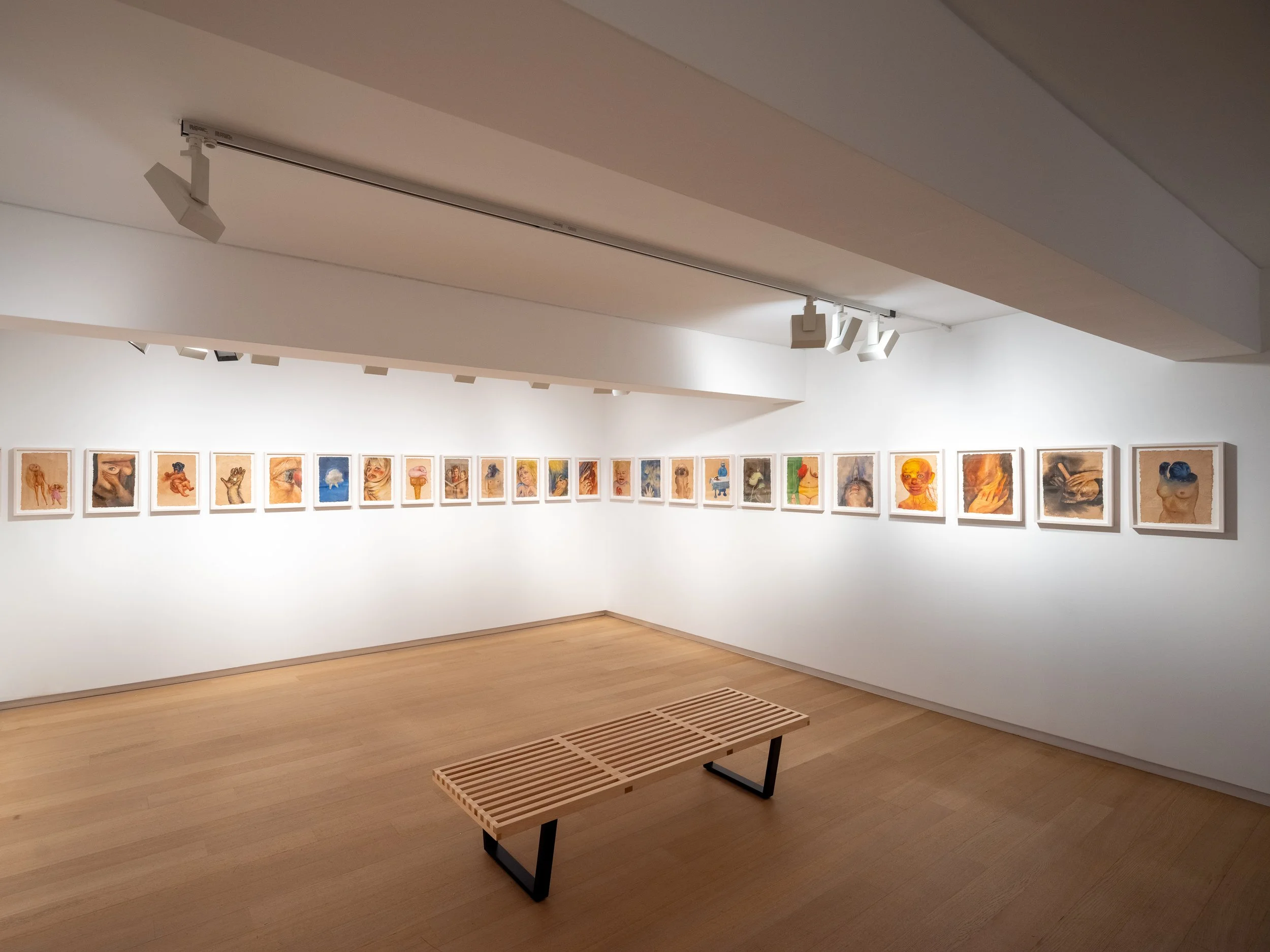
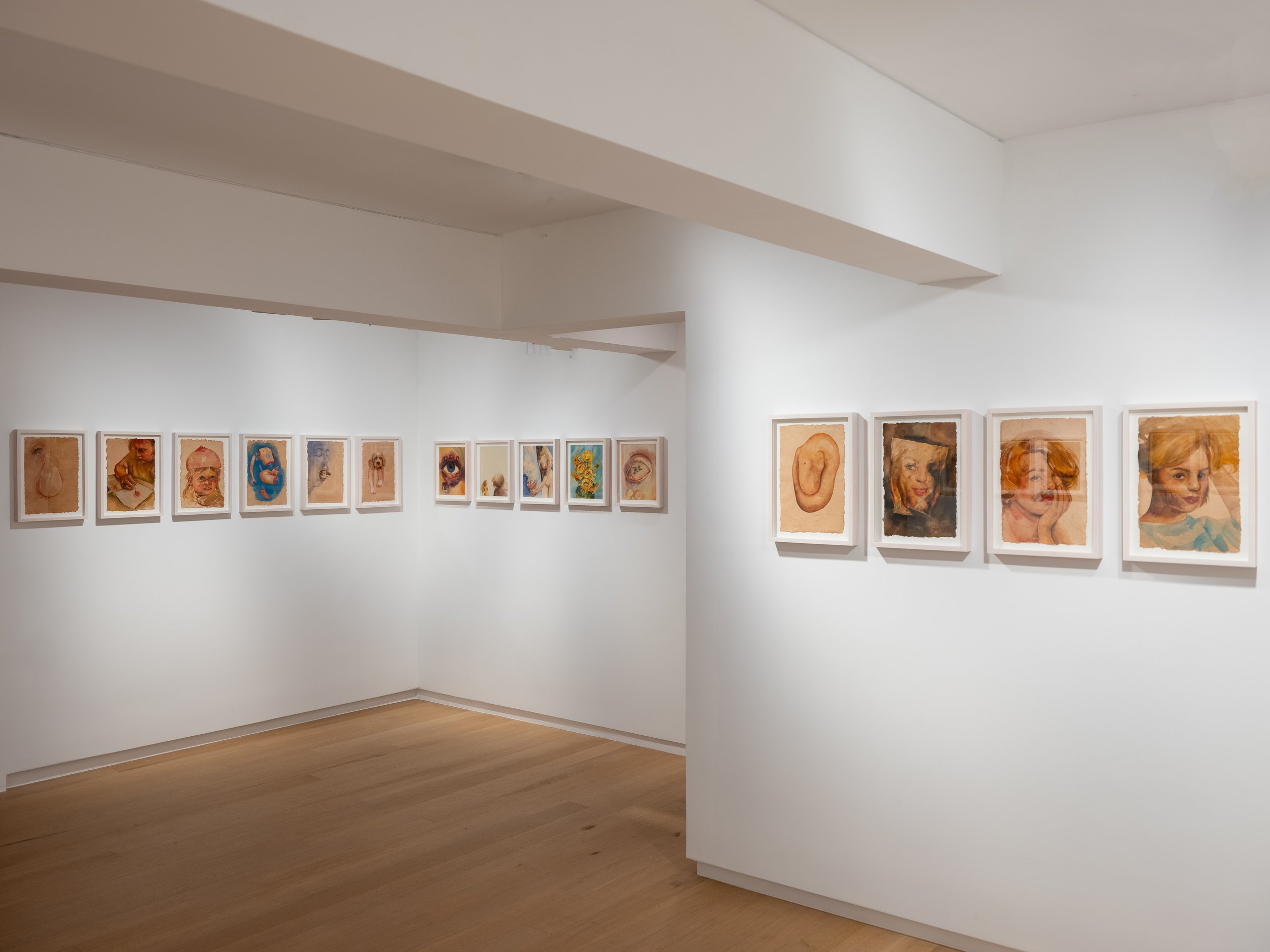
Toutes les images / All images : © Courtesy of the artist and TEMPLON, Paris —Brussels — New York
The exhibition then unfolds in a constellation of medium and small format watercolors. On the first floor of the gallery, the visitor is introduced to the feminine in its full complexity. Jaune holds up a distorted mirror, presenting unexplored potentials of how the feminine is perceived – historically and today: Eve portrayed as an innocent child, holding an apple whilst perched on an anatomical tree with softly bowing branches; Barbie who, far from being unchanging in her expression, posture and age, represents the metamorphosis of the female as she cycles through the archetypes (from Maiden to Crone), her skin creasing into wrinkles as our eyes descend the canvas; and the body of a woman in the prime of life topped with a primate head, a discreet homage to the Guerrilla Girls. The theme of morphing identities continues in The It Girl (part-woman part-iPhone), suggesting that our phones become an artificial extension of ourselves, both anatomically and metaphorically. The cold, blue light surrounding her exposes the extroversion on social media that often masks our insecurities. Another woman squats powerfully, enduring the flames that attempt to devour her.
Behind a technique that appears singular and complex, these hybrid bodies in states of metamorphosis raise questions. The exhibition opens a dialogue around the polarities that divide society today, such as good and evil, young and old, authentic and fake, innocent and guilty, light and shadow, tame and “Man Eater”.
Downstairs, the visitor is immersed in the minimalist, womb-like realm of “Miss Understand”. Her chair, TV, bed, fridge and rug are all soft. Tiny paintings of watchful eyes are stationed around her bed, creating windows to souls she perhaps knew in a past lifetime, or wishes she could know in another.
The artist explains: “ I was always moved by all that cannot be told by words, for me when words end painting begins…art goes further. We don’t need to understand everything, but we shouldn’t stop feeling, as it's a way of deepening our understanding. I feel it’s time we move away from all the classifications, preconceptions and stigma that women are given. I feel it’s time we expand our understanding... ”.
On the exhibition’s final day, during opening hours on Saturday, March 9th, choreographer Claudia Hilda will perform continuously in the installation of Miss Understand.
Portrait 2024 © Charles Roussel
Born in 1979 in Bulgaria, Oda Jaune today lives and works between Paris and London. She has exhibited in numerous exhibitions in Europe and the United States, including recently in Immortelle at MO.CO Montpellier Contemporain (2023), Heart – Romanticism in Contemporary Art at the Musée de la Vie Romantique in Paris (2020); Hands – Solo Show at SEEN in Antwerp, Belgium (2019); Painting, she said, chap. 2, Museum of Fine Arts of Dôle (2017), Intriguing uncertainties, Museum of modern and contemporary art of Saint-Etienne (2016), Painting, she says, Departmental museum of contemporary art of Rochechouart (2015), Confrontation with Félicien Rops, Musée Rops de Namur (2011), Tous cannibales, La maison rouge, Paris and Me Collectors room, Berlin (2011). In 2018, the National Gallery in Sofia dedicated a major solo exhibition to him, Heartland. Oda Jaune has been represented by the Templon gallery since 2009, and Miss Understand is the artist's ninth exhibition.
For more information about this exhibit and other exhibits at the Templon Gallery, please visit their website here. Also find the Gallery on Instagram and Artsy.
Mika Tajima: Energetics
Mika Tajima: Energetics 540 West 25th Street, New York, NY 10001 January 12 – February 24, 2024 Photography courtesy Pace Gallery
New York – Pace is pleased to present Mika Tajima: Energetics, an exhibition of new work by Mika Tajima, at its 540 West 25th Street gallery in New York. This exhibit has been on view since January 12 and will close on February 24, 2024. This presentation brings together sculptural, textile, and evolving sensorial work. It is Mika’s first exhibition with Pace in New York since she joined the gallery’s program in 2022 and her first solo show in the city in eight years.
Through her multidisciplinary practice spanning performance, sculpture, painting, and installation, Tajima takes up questions of identity and agency in a world increasingly influenced and mitigated by technology. Drawing on various points of reference—including quantum mechanics, Hannah Arendt’s writings on the nature of freedom, and Catherine Malabou’s notion of plasticity and the body as a vexed relation—the artist imbues her work across mediums with scientific and philosophical import. At the center of Tajima’s practice are her investigations of the ways that different digital and aesthetic technologies manifest as intertwined material, perceptual, and psychic experiences.
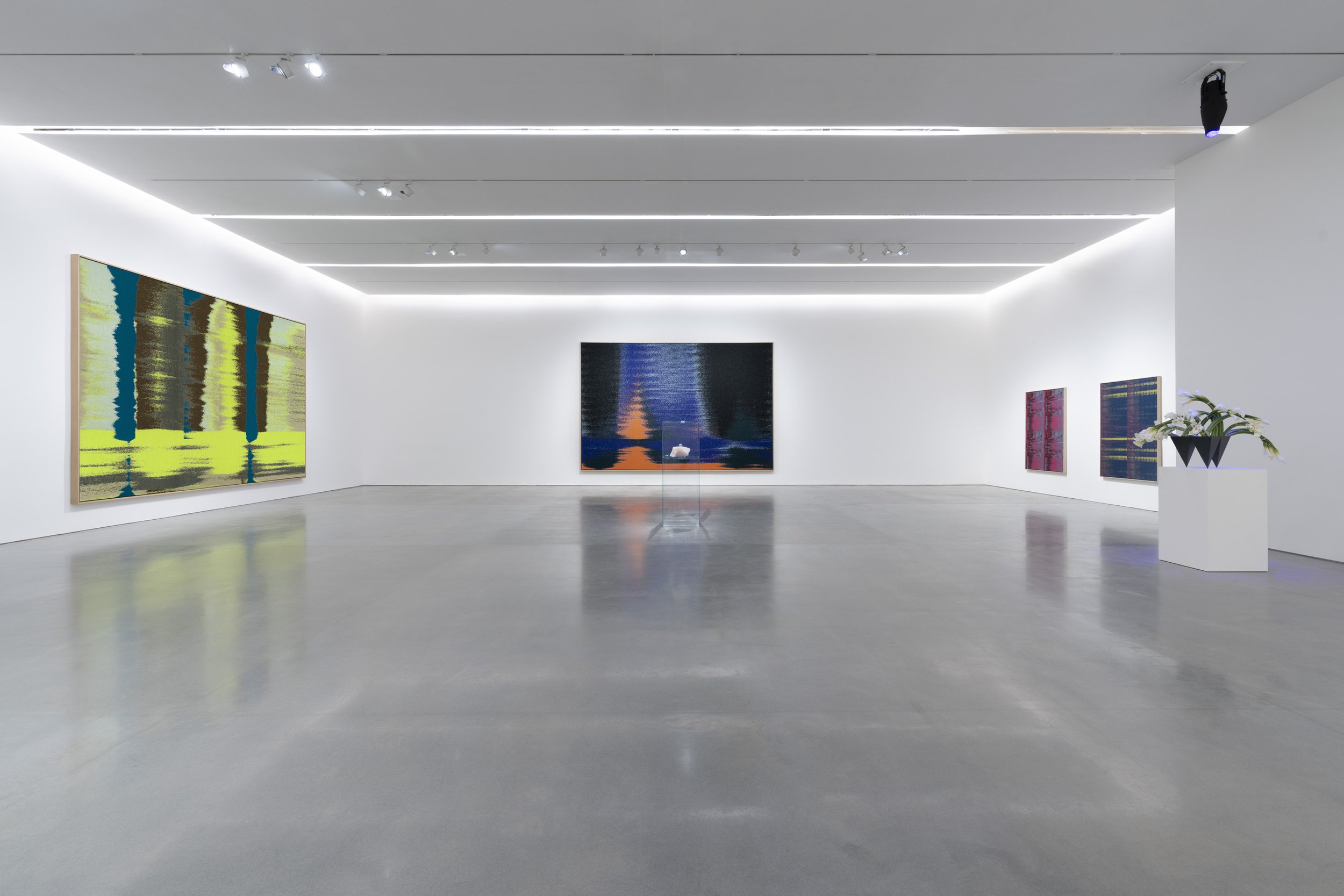
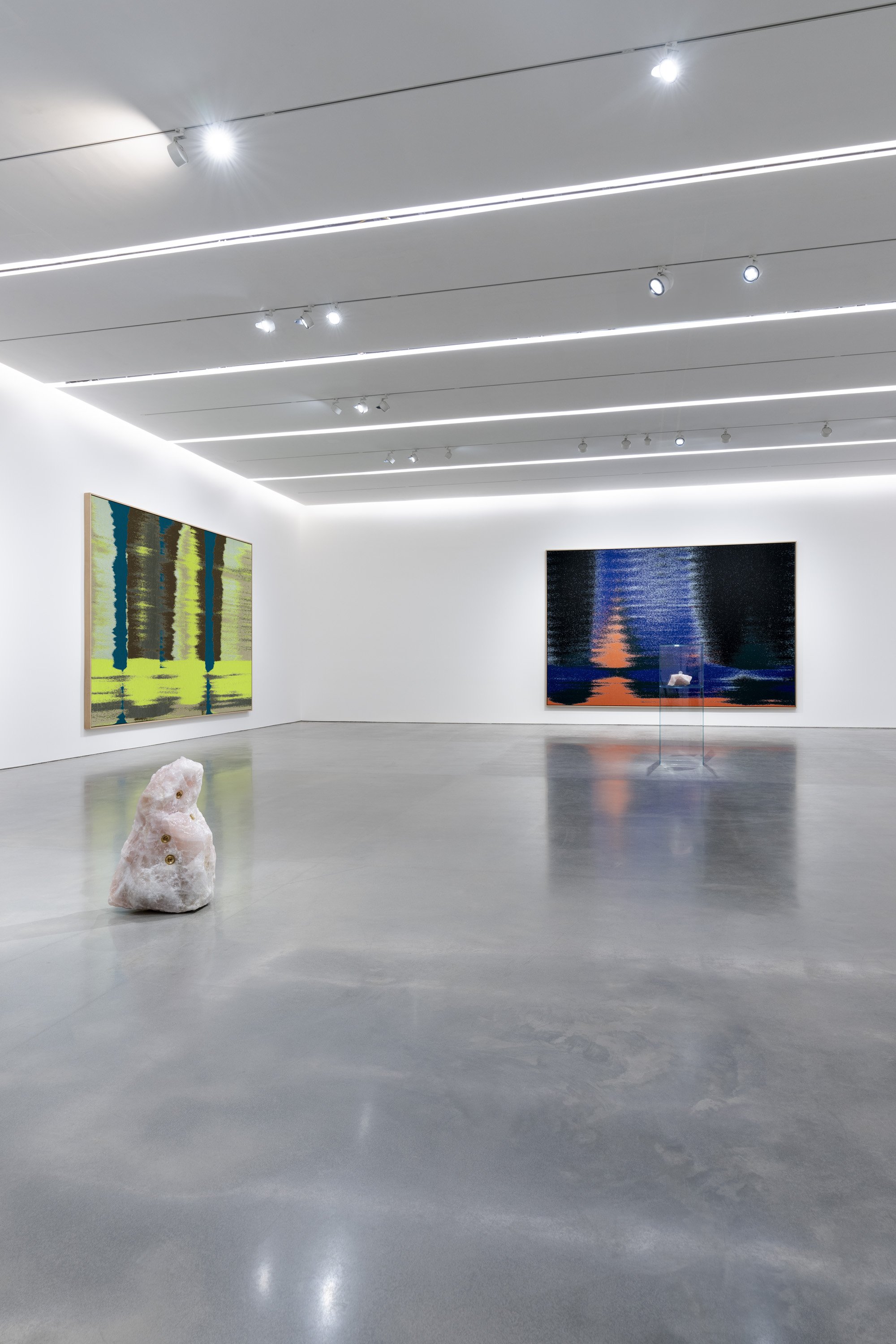

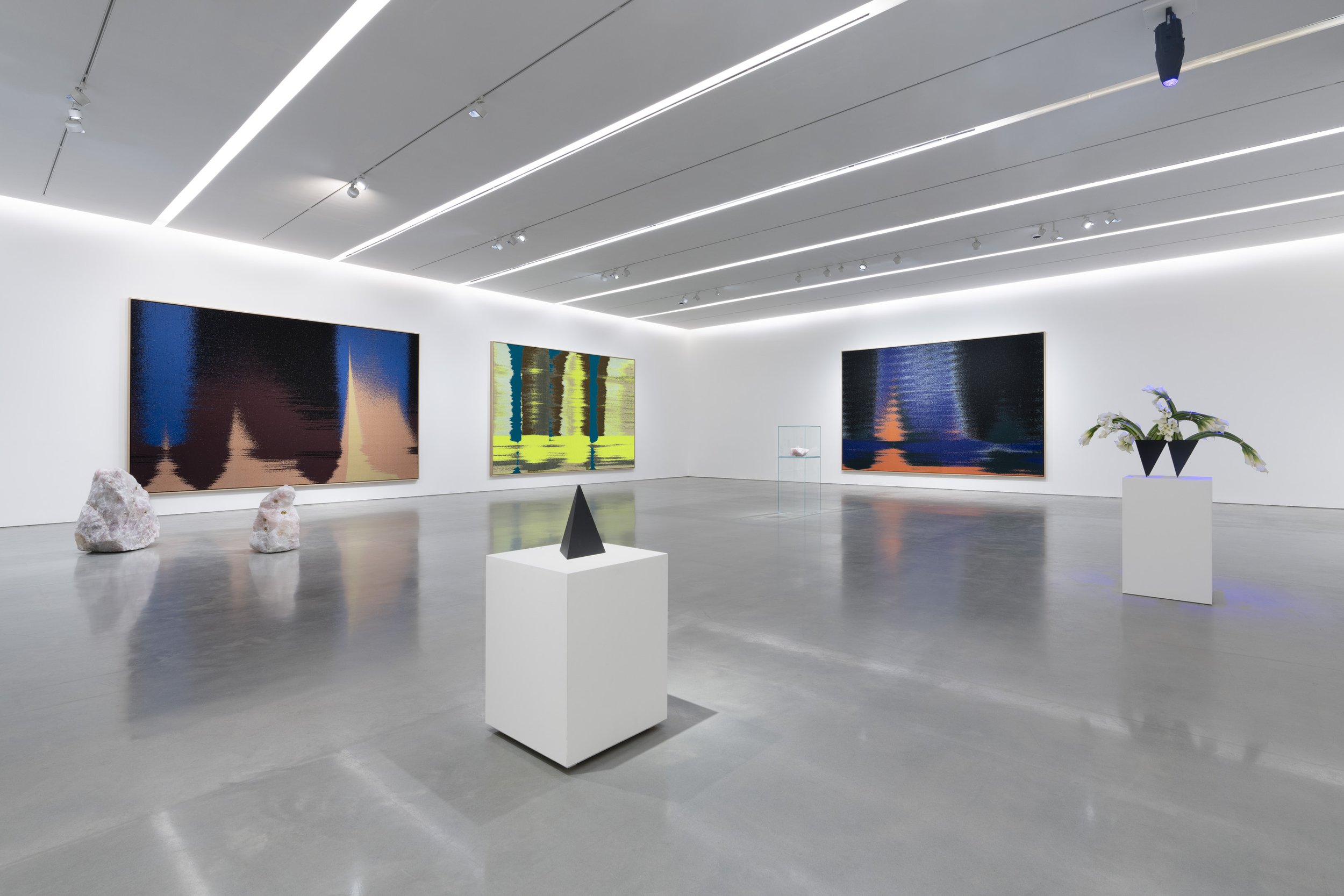
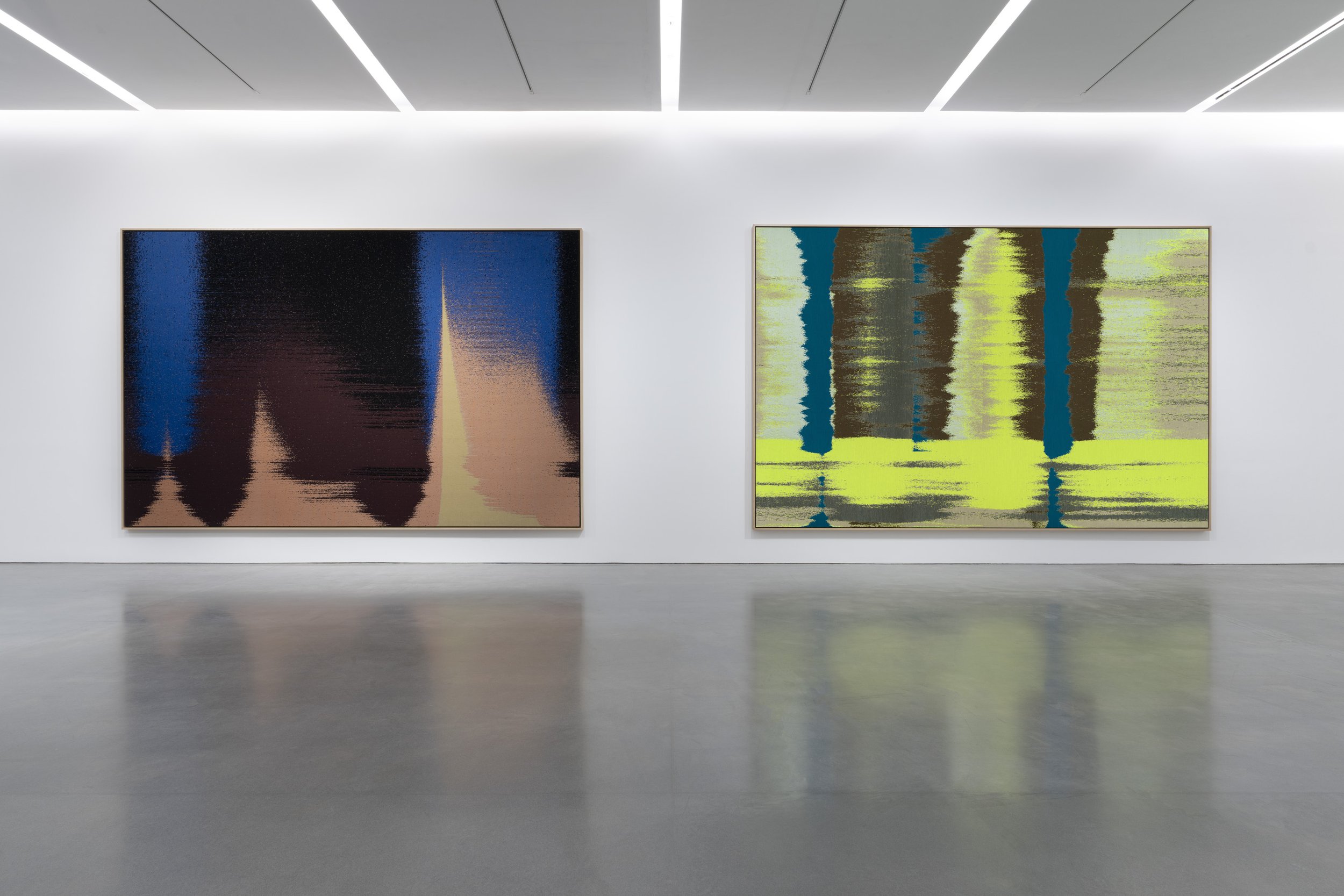
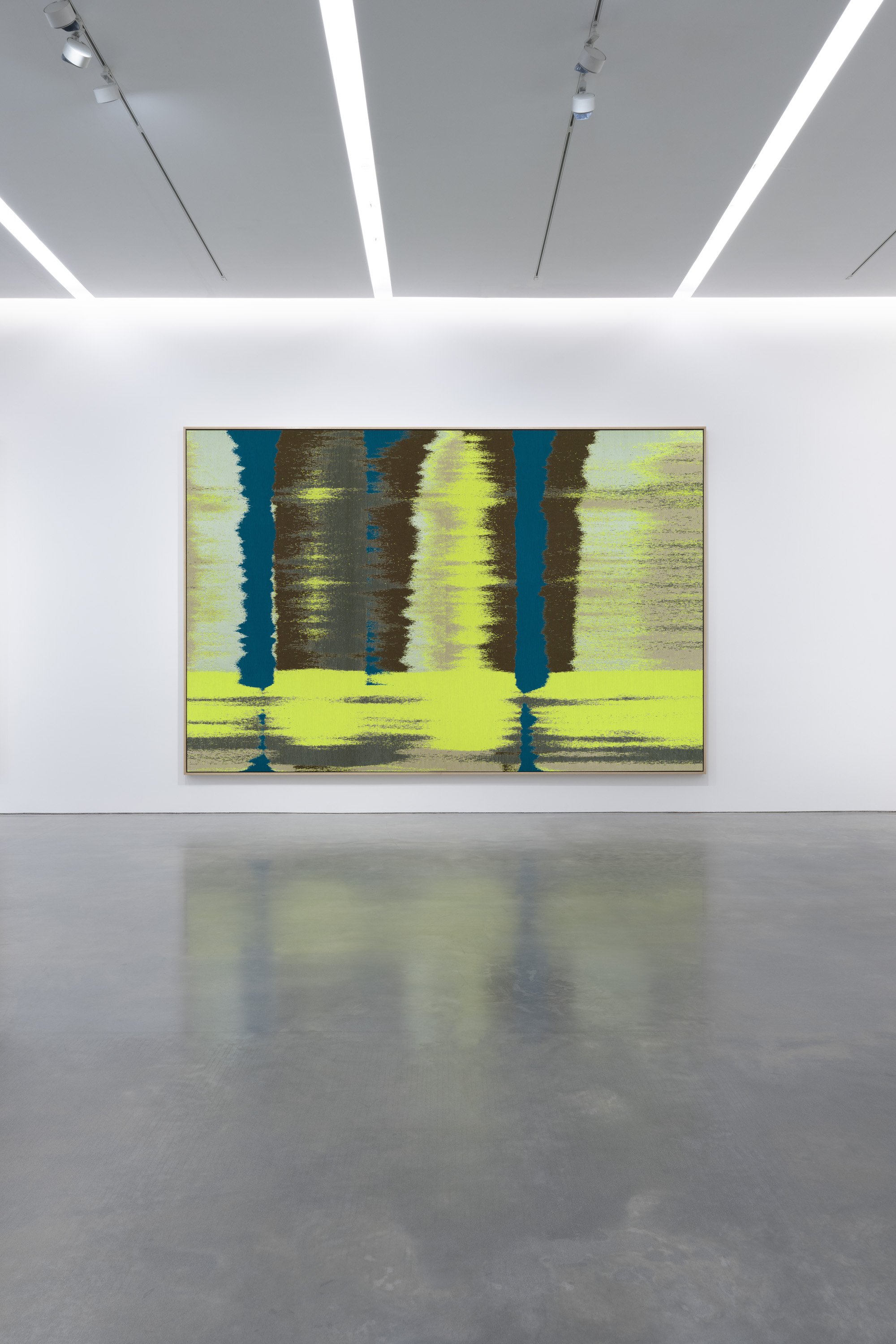
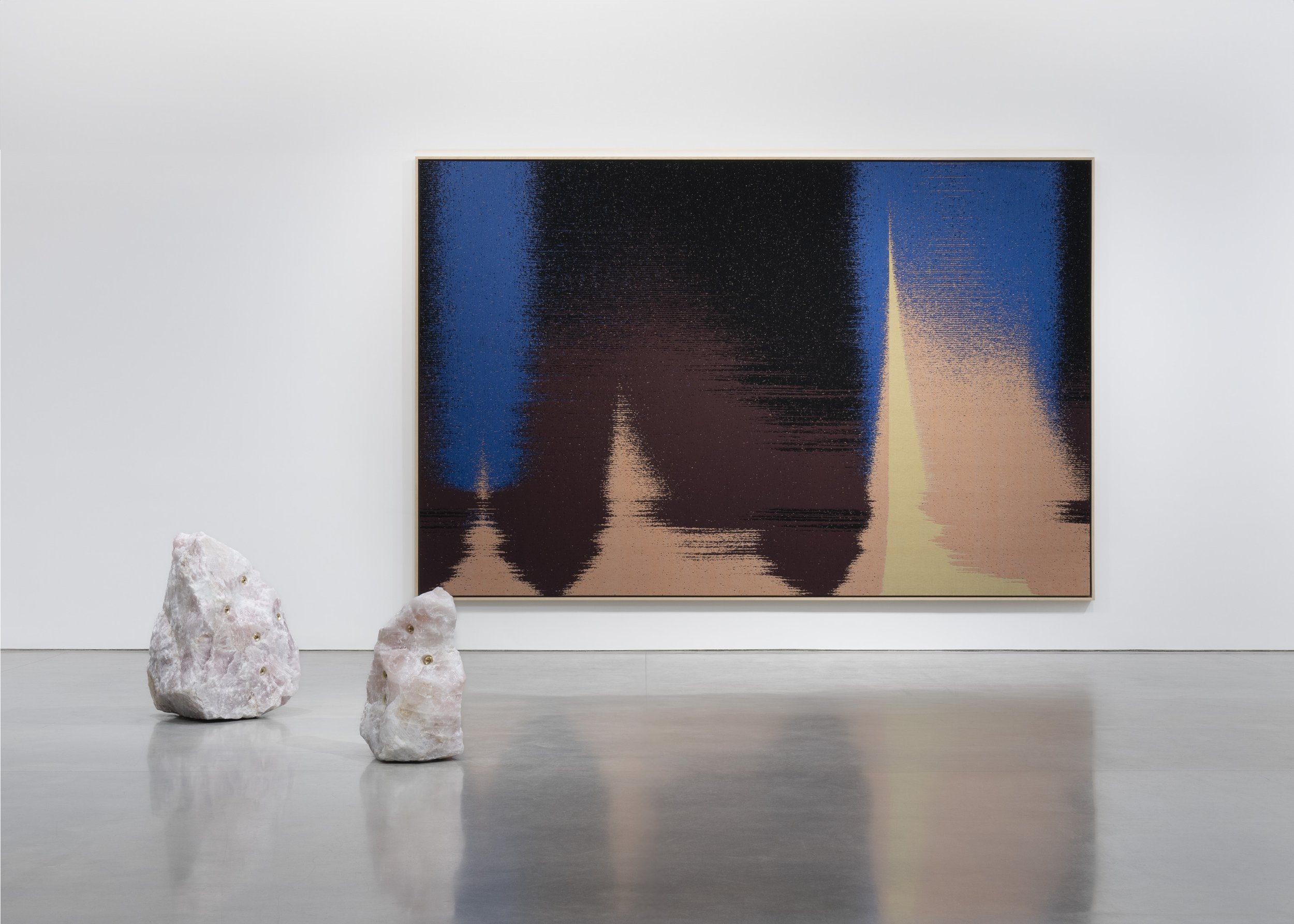
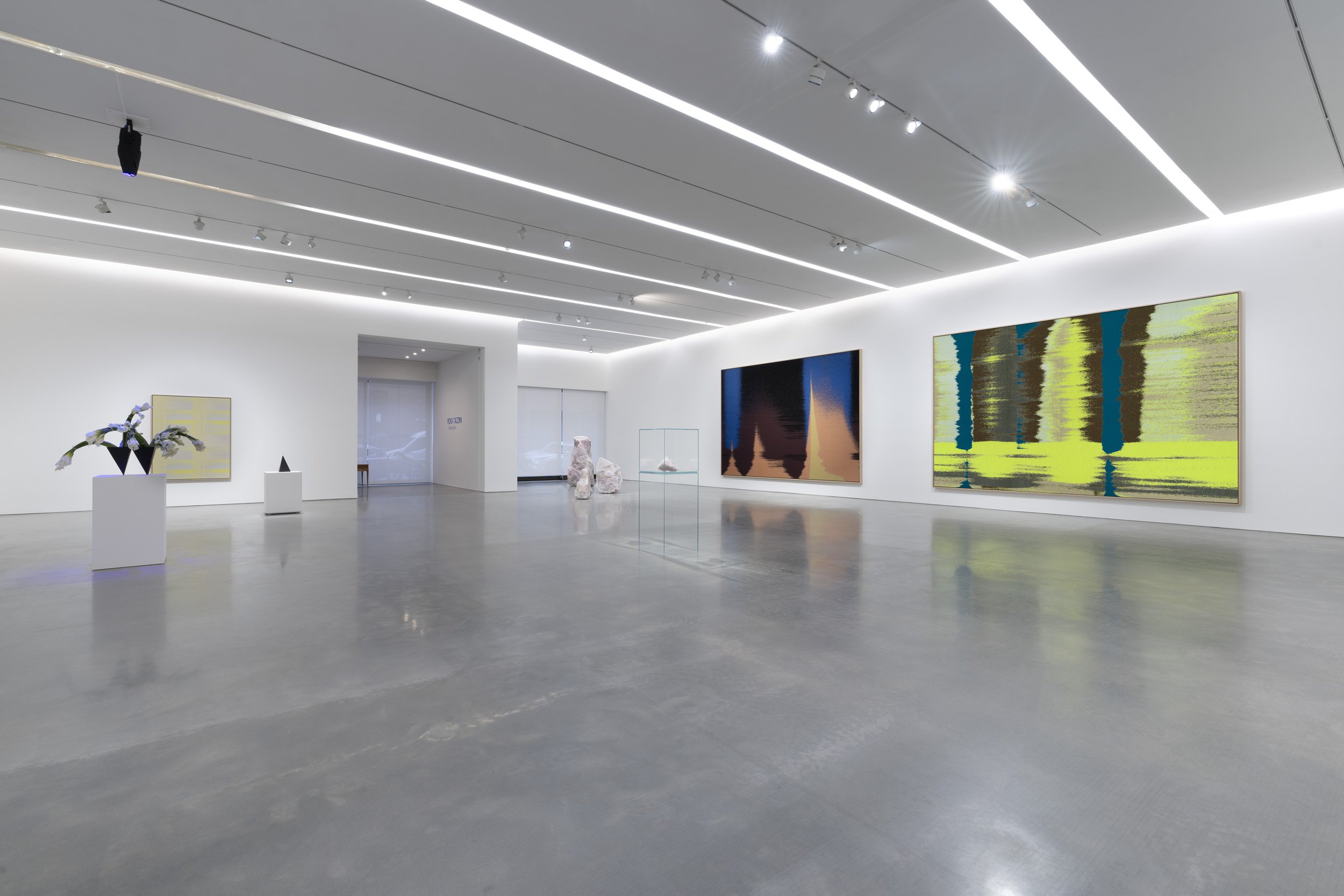
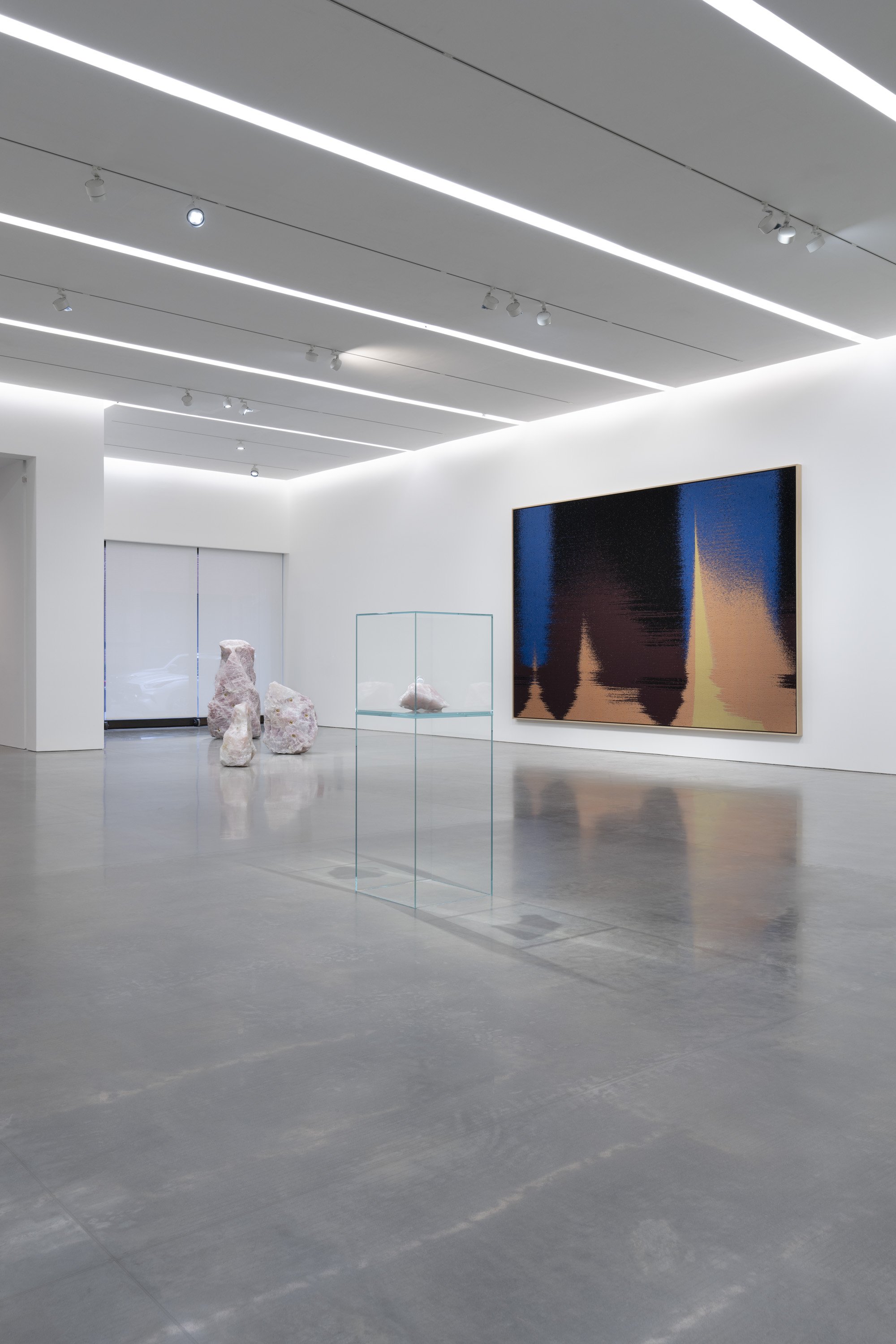
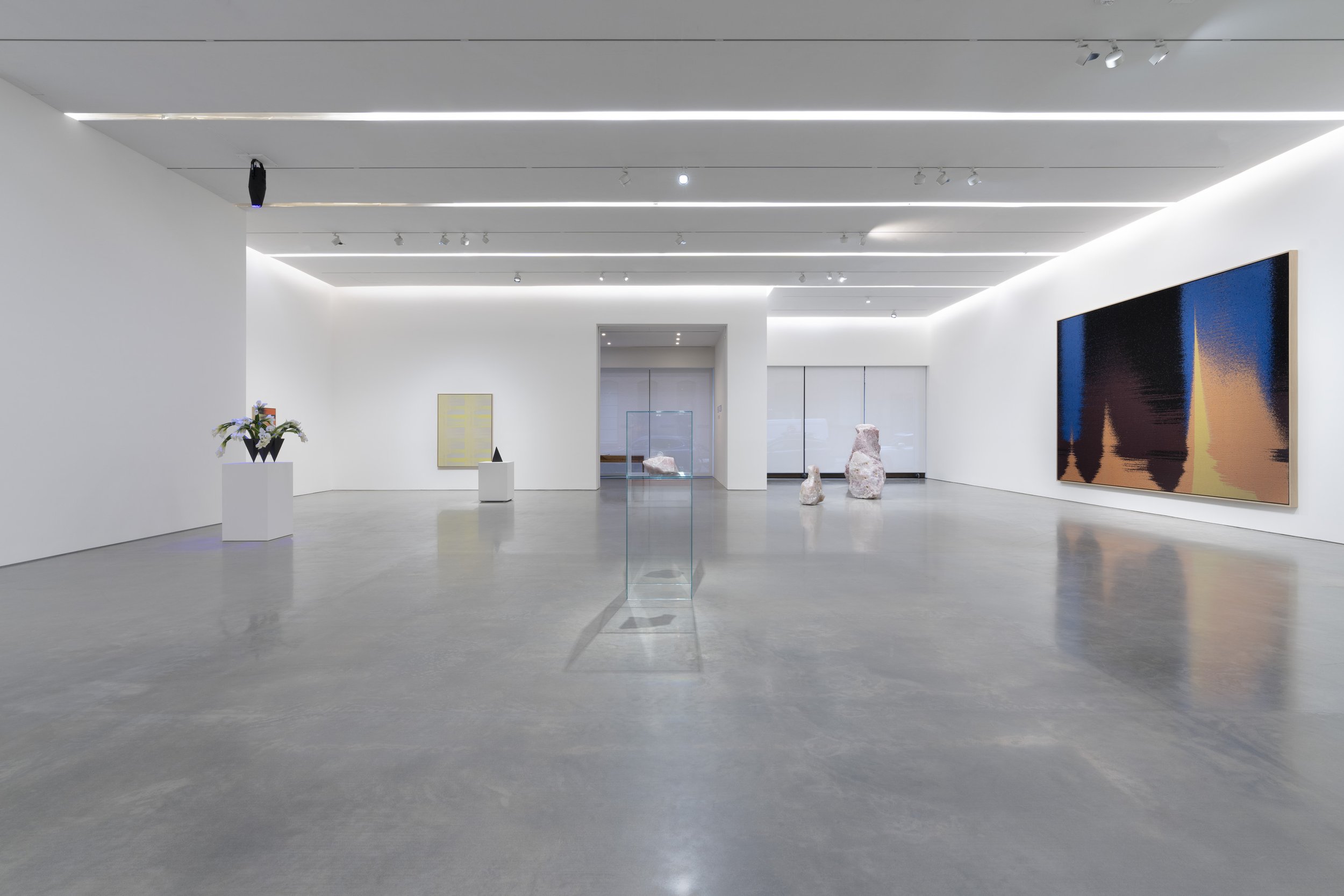
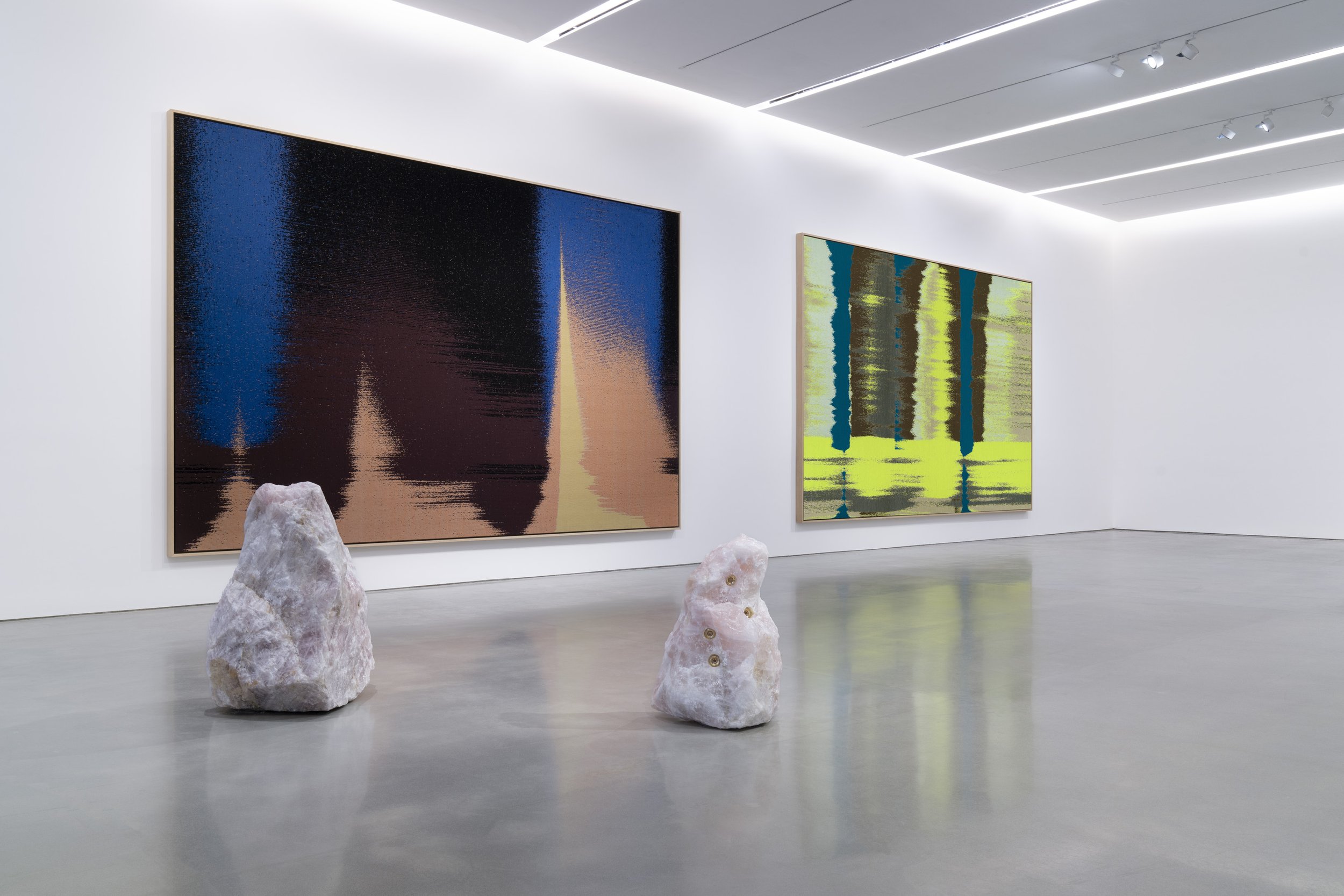
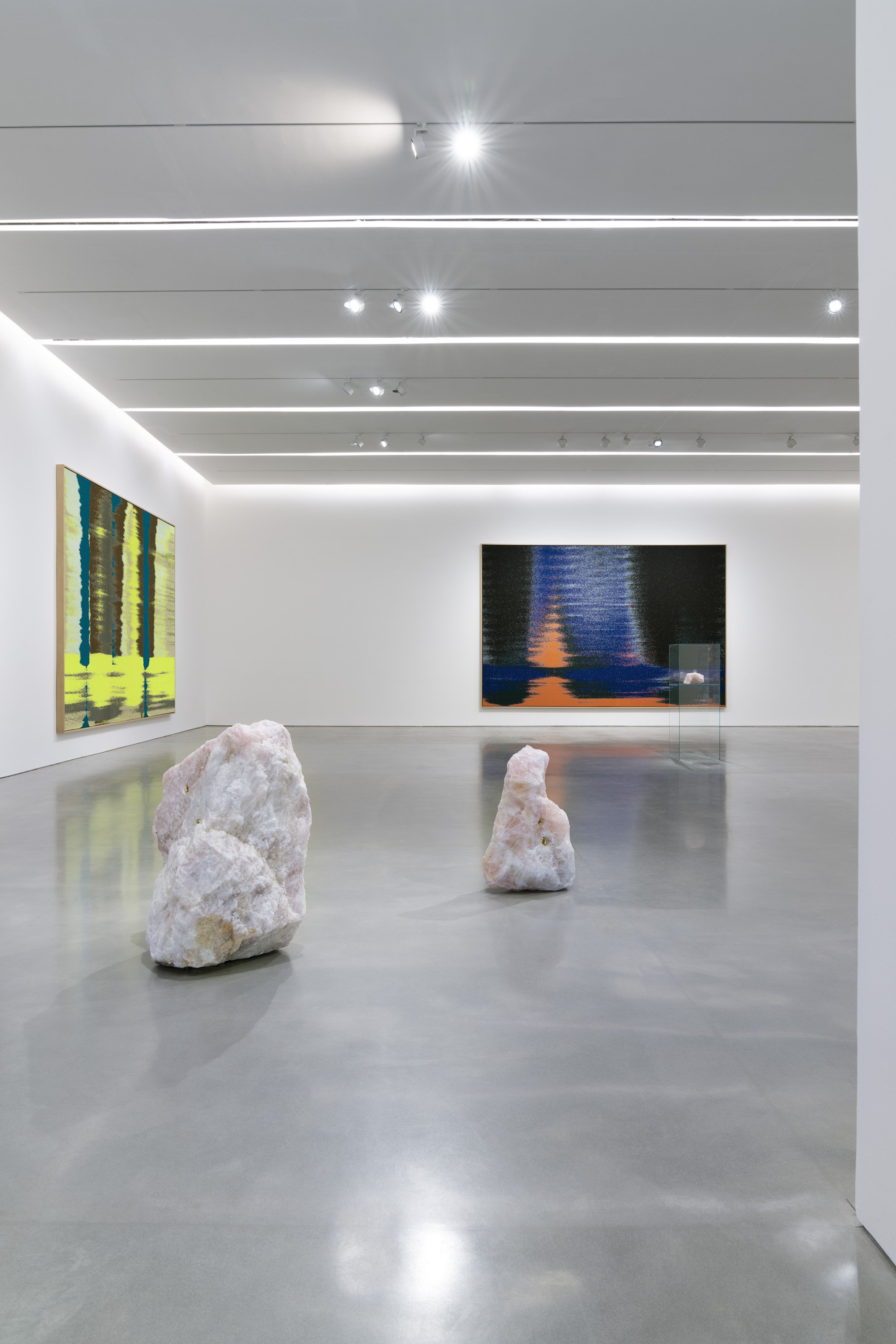
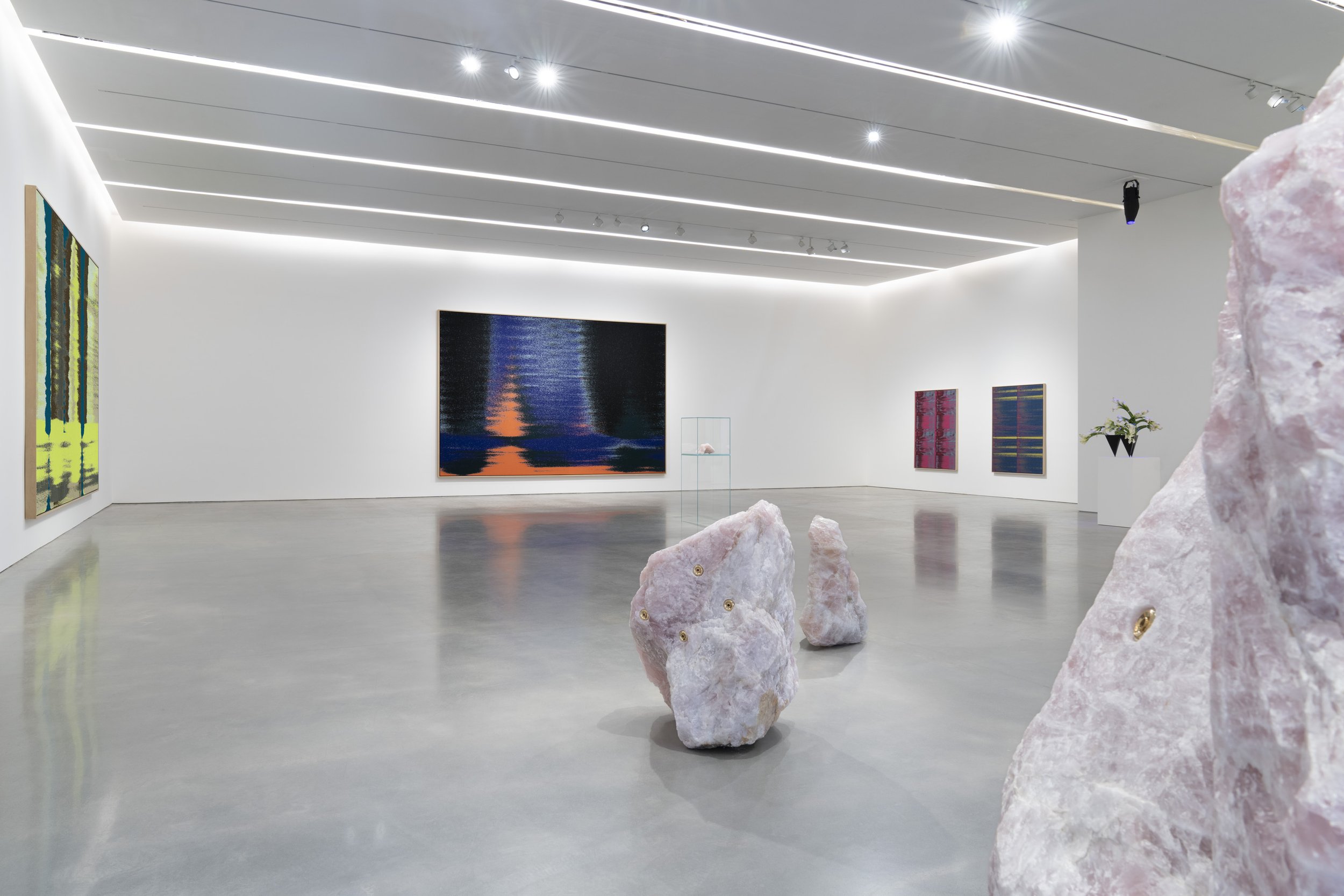
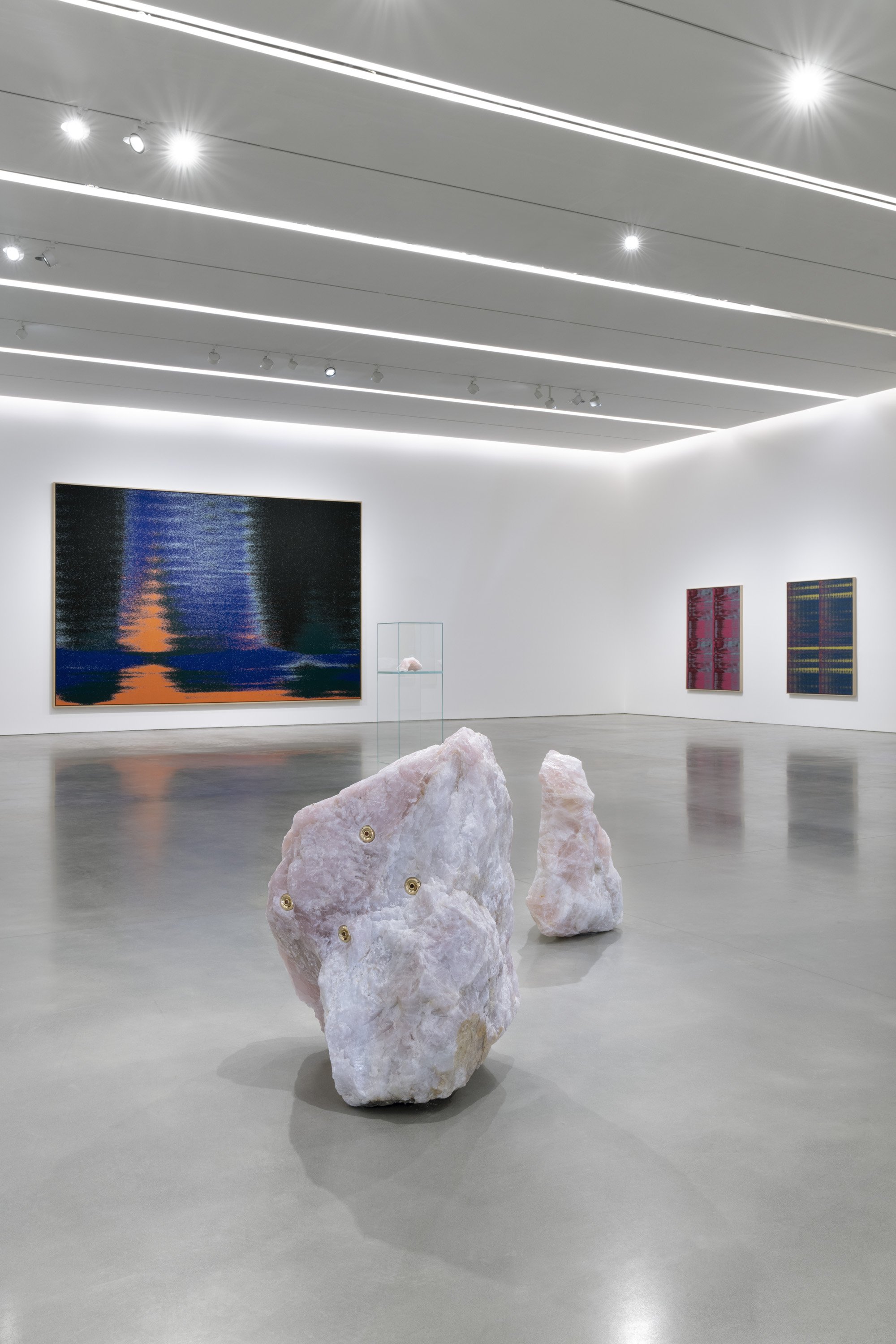
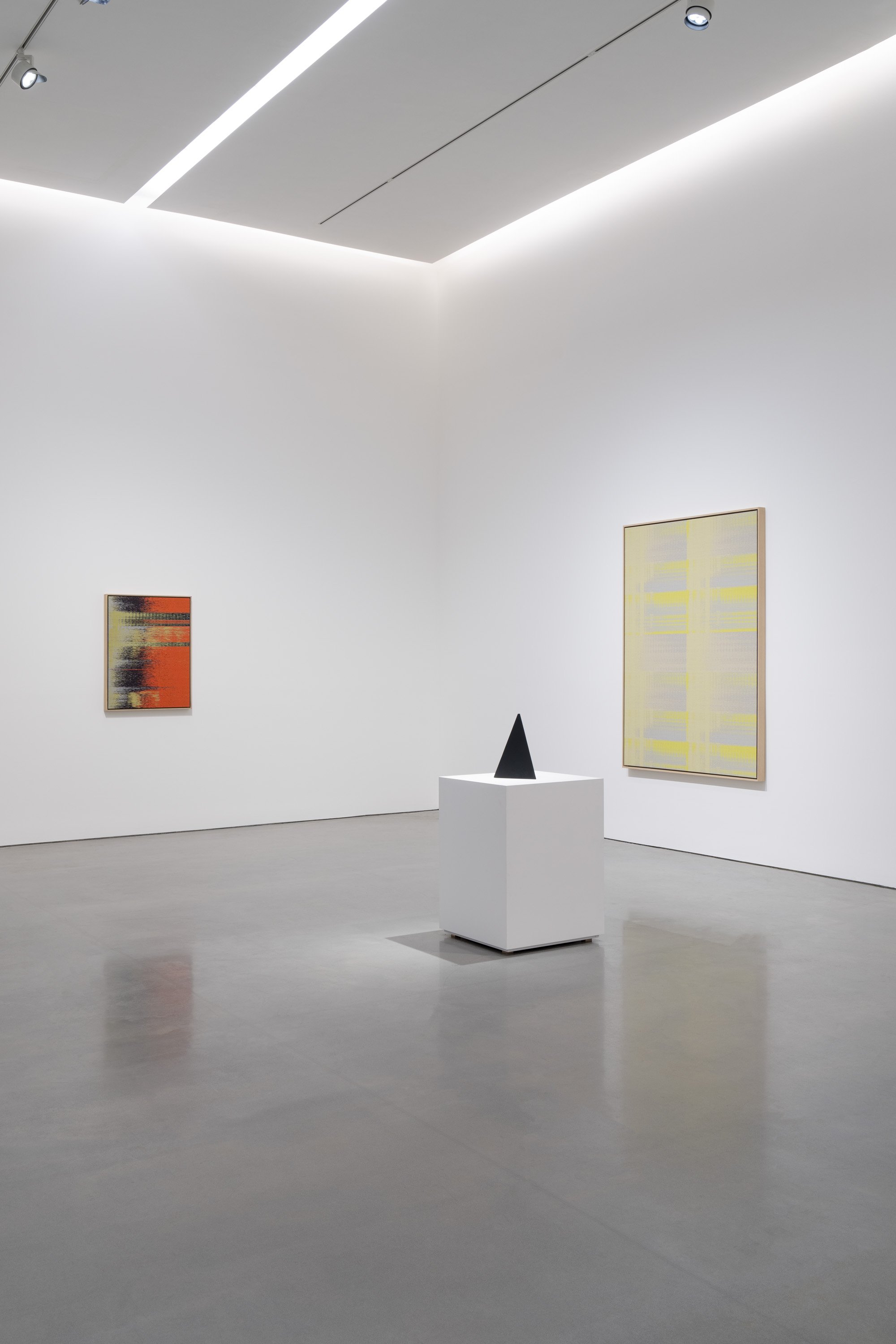
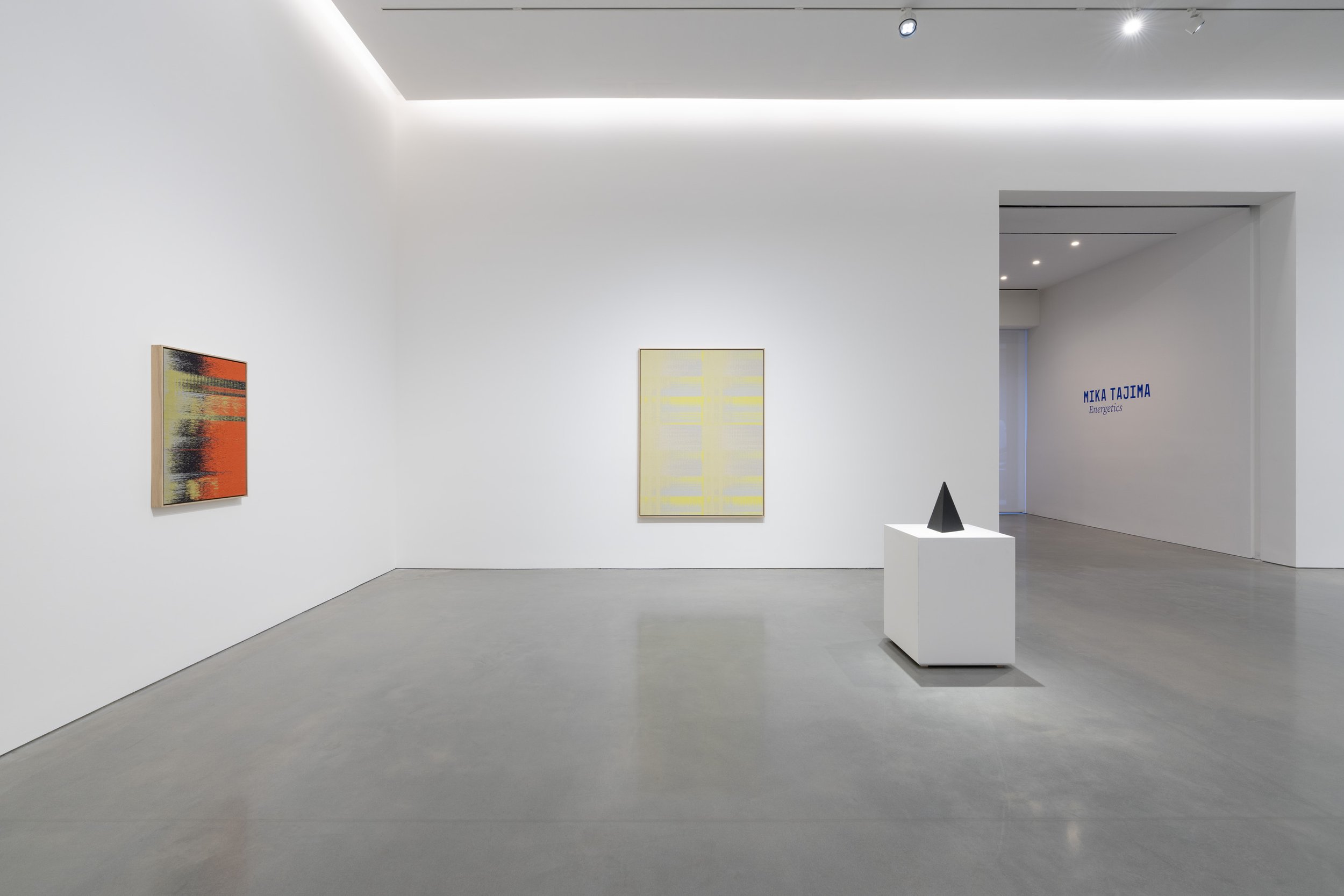
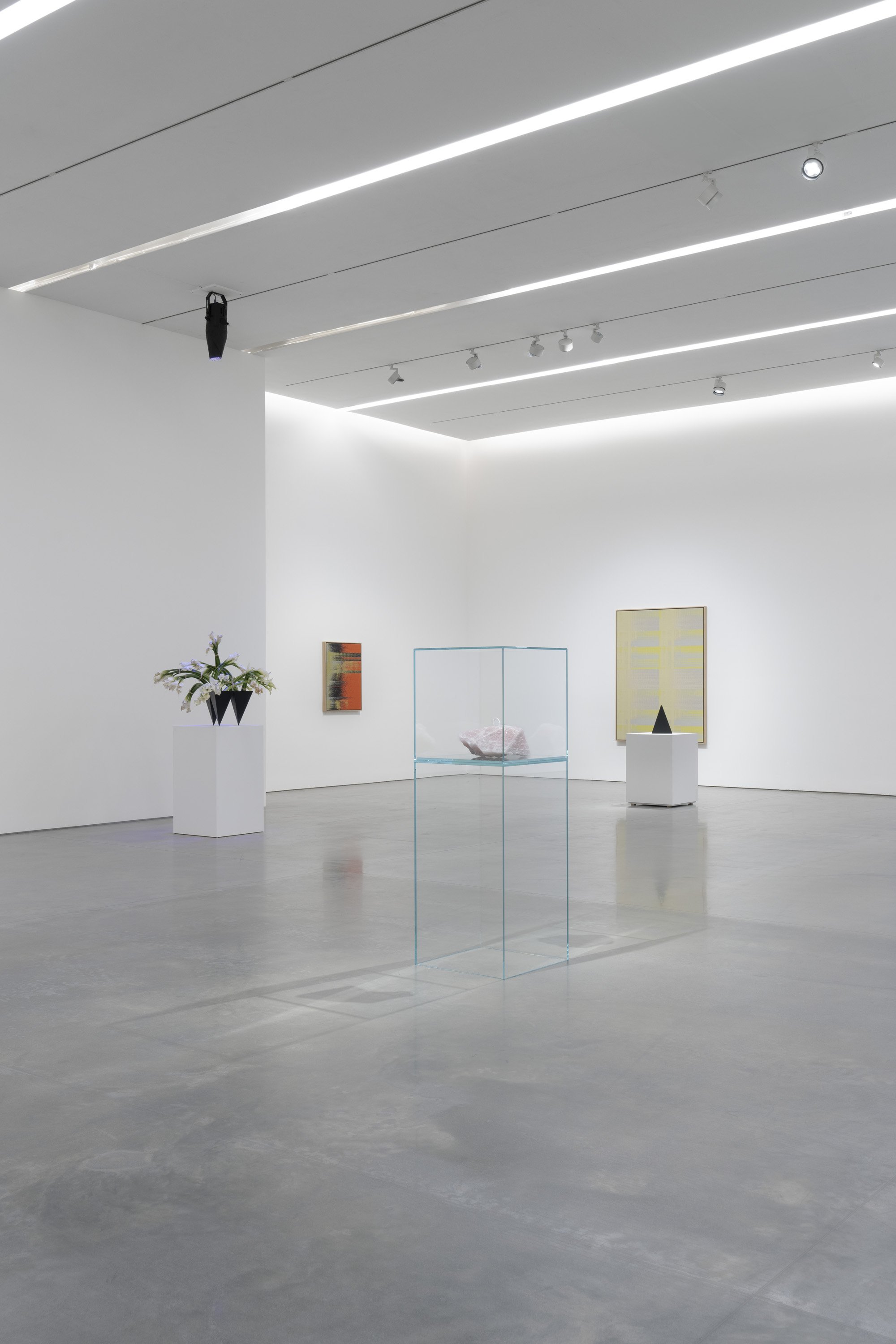
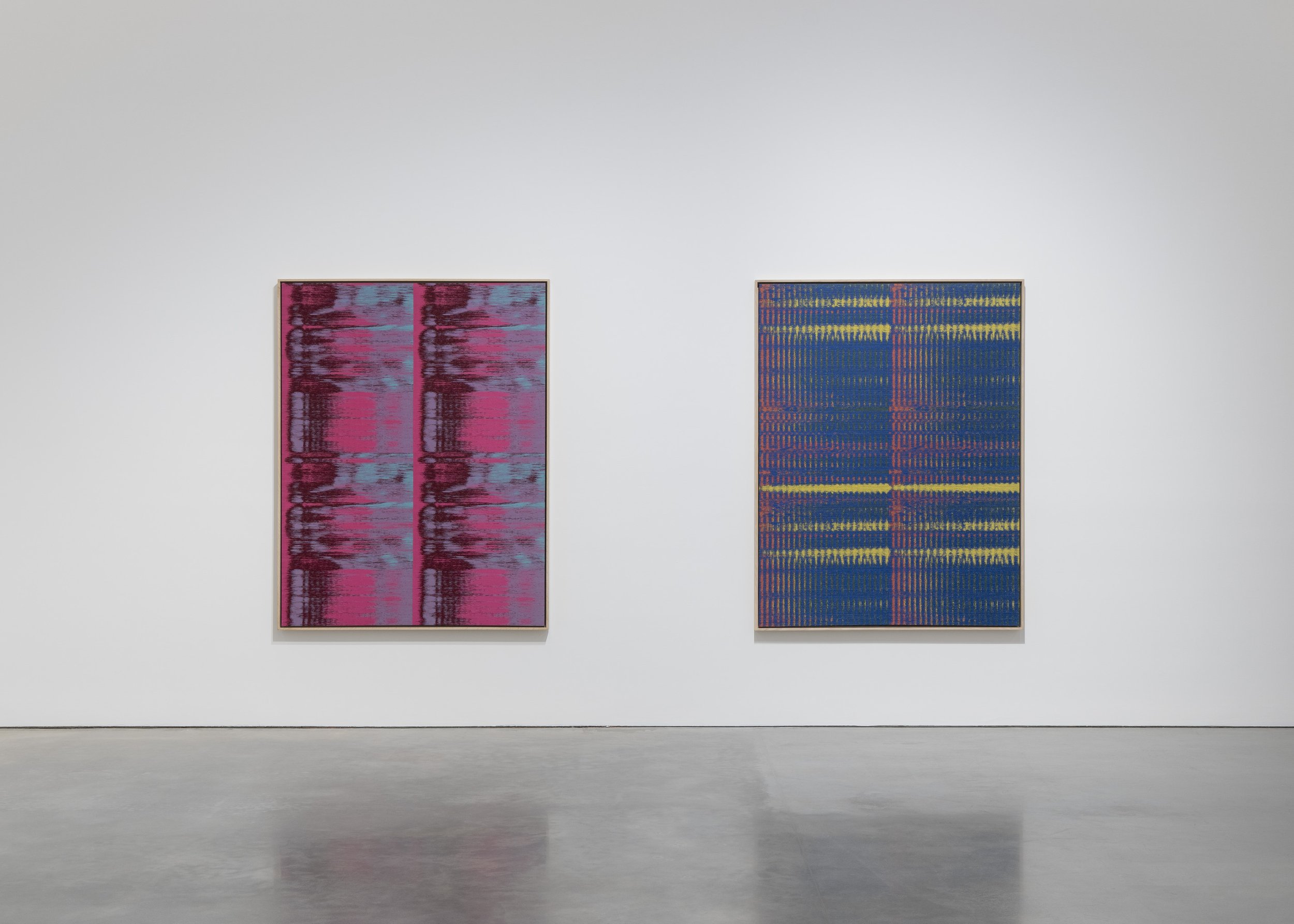
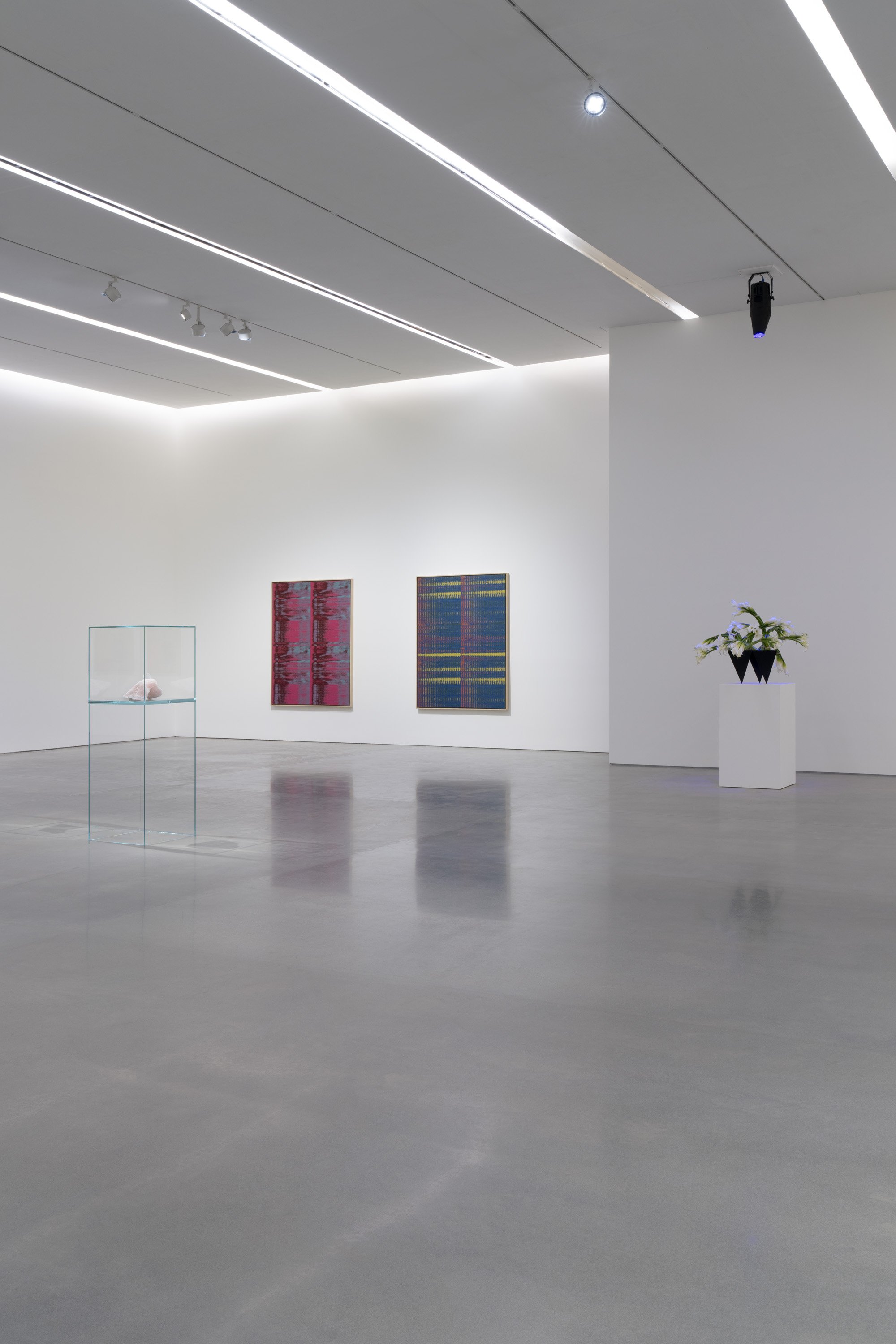
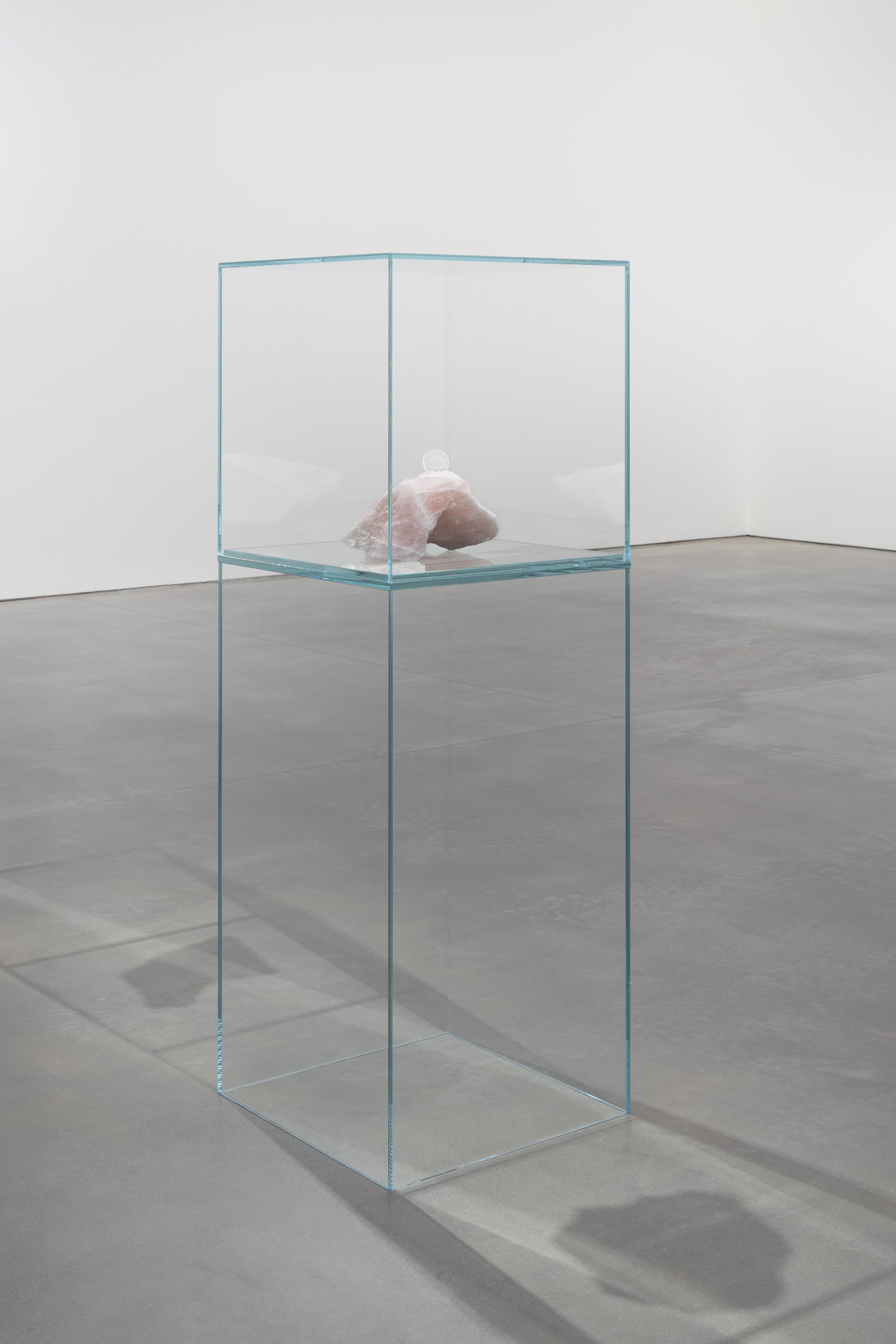
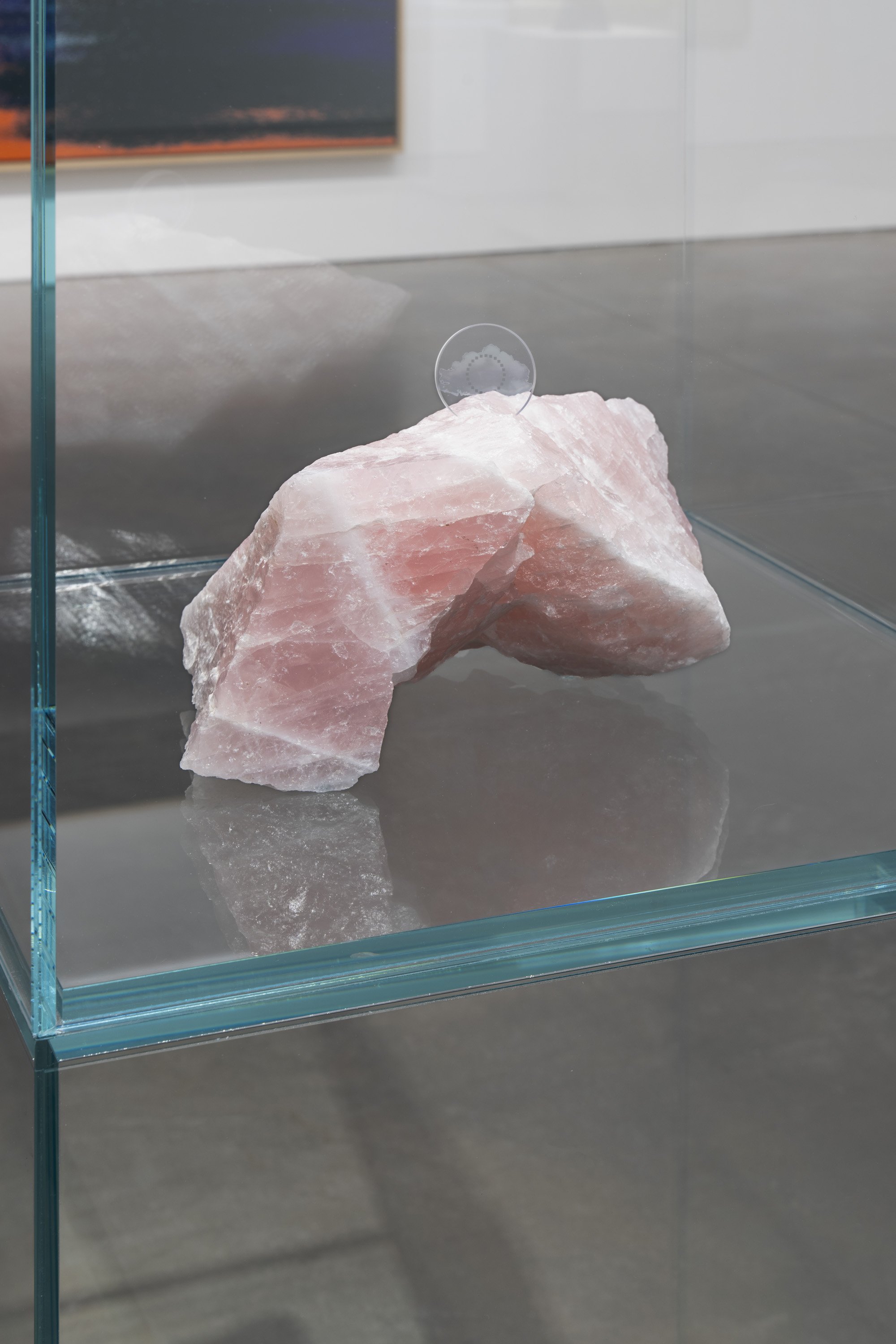
Mika Tajima: Energetics 540 West 25th Street, New York, NY 10001 January 12 – February 24, 2024 Photography courtesy Pace Gallery
Her exhibition at Pace’s New York gallery takes its title from a segment of physics focused on flows and transformations of energy. Enactments of glowing, burning, blooming, and dying will recur across the gallery space, which, in Tajima’s hands, becomes a stage for spiritual and physical transfigurations, traversing digital and ancient temporalities. The acute shifts in the sizes of the works in the show—in relation to human scale—draw attention to our staggeringly infinitesimal existence in the context of geologic and technological time. With her new works, the artist invites questions of what it means to be an individual within this deep time continuum and, in this contemporary moment, amid the inexorable rise of big data.
Upon entering the gallery, visitors will first experience a scent—which incorporates various ingredients used in ancient divination practices—emitted from a pyramidal incense sculpture in Tajima’s exhibition. Initiating viewers into the presentation, this ambient olfactory element serves to open the mind and to remind one of existence through the senses.
Anchoring the show are new, large-scale textile paintings from the artist’s ongoing Negative Entropy series. For this body of work, the artist has worked with neurosurgeons specializing in repairing the brain through energetic stimulation and activation. Auditory maps of the brain’s activity are translated into visual representations of sound waves (spectrograms) to which Tajima assigns colors. The latest Negative Entropy compositions—produced in collaboration with an experimental textile lab in the Netherlands—are rendered at an entirely new, expansive scale.
As such, these woven spectrograms, forged from virtually imperceptible records of brain activity, speak to the expansiveness of human potential. Tajima will also present Sense Object (January 1, 2023, United States) as part of Energetics—a portrait of the national sentiment in the United States on January 1, 2023, compressed within a 5d memory crystal. To create this work, the artist collected data from social media on that day, analyzing the sentiments of text-based posts by American users. Made with optoelectronics technology, the massive amount of data is represented as 24 small squares within a cloud image and inscribed into a tiny disc-shaped optical crystal, which balances atop rose quartz. Captured and locked away forever, the data laser etched within the image of the cloud becomes a memorial of sorts, an ode to the abstract, intangible nature of our digital selves.
Mika Tajima: Energetics 540 West 25th Street, New York, NY 10001 January 12 – February 24, 2024 Photography courtesy Pace Gallery
Three rose quartz sculptures from Tajima’s Pranayama series, a body of work in which the artist has pierced wood or marble surfaces with bronze nozzles cast from real Jacuzzi jets, will be included in the exhibition as well. The locations of punctures in the stones are loosely based on diagrams of bodily pressure points for acupuncture treatment, a traditional wellness technique used to control and direct unknowable life force. With her new rose quartz Pranayama sculptures, Tajima taps into the material’s associations with new age beliefs and aesthetics as well as its ability to produce electrical reactions. Meditating on mysterious flows and releases of energy in bodies, objects, and spaces, these practices that expose interiority and systematize abstract life functions are analogous to technology’s imperative to understand, regulate, and shape human activity.
Mika Tajima: Energetics 540 West 25th Street, New York, NY 10001 January 12 – February 24, 2024 Photography courtesy Pace Gallery
New sculptural works that incorporate live flowers also explore these ideas of life energy and breath. Transfused with UV fluorescence, the flowers will glow in the exhibition, emitting light as they die. For Tajima, the ephemeral and performative dimensions of these works reflect the constantly fluctuating state of the natural, built, and digital worlds that we inhabit and create.
Following her exhibition with Pace, Tajima will present Super Natural, a solo exhibition at the Hill Art Foundation in New York, in May 2024. Her work will also be included in Breath(e): Towards Climate and Social Justice, the Hammer Museum’s forthcoming Pacific Standard Time exhibition in Los Angeles, co-curated by Mika Yoshitake and Glenn Kaino and opening in September 2024.
Mika Tajima: Energetics is realized with support from Professor Peter Kazansky (University of Southampton), Dr. Amanda Carpenter, Textiel Lab, TAE Technologies, Seishoji Temple, Obayashi Corp., and Brooklyn Research.
Mika Tajima (b. 1975, Los Angeles) is an artist whose practice materializes techniques developed to shape the physicality, productivity, and desires of the human body. Her sculptures, paintings, videos, and installations focus on the embodied experience of ortho-architectonic control and computational life. From architectural systems to ergonomic design to psychographic data, Tajima's works operate in the space between the immaterial and the tangible to create heightened encounters that target the senses and emotions of the viewer, underlining the dynamics of control and agency. Tajima earned a BA in Fine Arts and East Asian Studies from Bryn Mawr College, Pennsylvania (1997), and an MFA from Columbia University, School of the Arts, New York (2003). Recent solo exhibitions of her work include Appear, Dazaifu Tenmangu, Dazaifu, Japan (2022); Spectral, Taro Nasu, Tokyo, Japan (2022); Mika Tajima: You Must Be Free, Kayne Griffin, Los Angeles (2022). Recent group exhibitions of including her work include Dirty Protests, The Hammer Museum, Los Angeles (2019); Programmed: Rules, Codes, and Choreographies in Art, 1965–2018, Whitney Museum of American Art, New York (2018); COLORI, Castello di Rivoli and GAM, Torino, Italy (2017); All Watched Over by Machines of Loving Grace, Palais de Tokyo, Paris, France (2017); and Mika Tajima: Meridian (Gold), Sculpture Center, New York (2016). Her work resides in numerous public collections worldwide including the Los Angeles County Museum of Art, California; Hammer Museum, Los Angeles, California; San Francisco Museum of Modern Art, California; Dallas Museum of Art, Texas; Albright-Knox Art Gallery, Buffalo, New York; and the Hirschhorn Museum and Sculpture Garden, Washington, D.C, among others. Pace is a leading international art gallery representing some of the most influential contemporary artists and estates from the past century, holding decades-long relationships with Alexander Calder, Jean Dubuffet, Barbara Hepworth, Agnes Martin, Louise Nevelson, and Mark Rothko. Pace enjoys a unique U.S. heritage spanning East and West coasts through its early support of artists central to the Abstract Expressionist and Light and Space movements.
Since its founding by Arne Glimcher in 1960, Pace has developed a distinguished legacy as an artist-first gallery that mounts seminal historical and contemporary exhibitions. Under the current leadership of CEO Marc Glimcher, Pace continues to support its artists and share their visionary work with audiences worldwide by remaining at the forefront of innovation. Now in its seventh decade, the gallery advances its mission through a robust global program— comprising exhibitions, artist projects, public installations, institutional collaborations, performances, and interdisciplinary projects. Pace has a legacy in art bookmaking and has published over five hundred titles in close collaboration with artists, with a focus on original scholarship and on introducing new voices to the art historical canon.
Today, Pace has seven locations worldwide, including European footholds in London and Geneva as well as Berlin, where the gallery established an office in 2023. Pace maintains two galleries in New York—its headquarters at 540 West 25th Street, which welcomed almost 120,000 visitors and programmed 20 shows in its first six months, and an adjacent 8,000 sq. ft. exhibition space at 510 West 25th Street. Pace’s long and pioneering history in California includes a gallery in Palo Alto, which was open from 2016 to 2022. Pace’s engagement with Silicon Valley’s technology industry has had a lasting impact on the gallery at a global level, accelerating its initiatives connecting art and technology as well as its work with experiential artists. Pace consolidated its West Coast activity through its flagship in Los Angeles, which opened in 2022. Pace was one of the first international galleries to establish outposts in Asia, where it operates permanent gallery spaces in Hong Kong and Seoul, along with an office and viewing room in Beijing. In spring 2024, Pace will open its first gallery space in Japan in Tokyo’s new Azabudai Hills development.
For more information about this exhibition and others, please visit the Pace Gallery’s website here. Pace Gallery can be found on Instagram and Artsy, too.
ROBERT SMITHSON : Mundus Subterraneus – Early Works
Robert Smithson in the Cedar Tavern, New York, April 1960 Photo Credit: Fred W. McDarrah © Holt/Smithson Foundation / Licensed by Artists Rights Society, New York Courtesy Holt/Smithson Foundation and Marian Goodman Gallery
Marian Goodman Gallery and Holt/Smithson Foundation are pleased to announce the exhibition Robert Smithson: Mundus Subterraneus – Early Works opened on the 13th of January and will close on the 24th of February 2024. Developed with Professor Adrian Rifkin, this exhibition focuses on Smithson’s works on paper made in the early 1960s, presenting drawings and collages that set the ground for his studies of entropy and the fall of modernism. Many of these drawings have never previously been seen. Leather-clad bikers, crumbling cities, movie stills, occult books, and erotic entanglements buzz against references to the dogmas of art history, religion, and totalitarianism. Alongside Mundus Subterraneus, a presentation of rare exhibition posters and print material is on view at the gallery’s 66 rue du Temple space. The selection is related to Smithson’s exhibitions and projects spanning several decades from the late 1950s to the 1980s at venues including New York’s Artists Gallery, Castellane Gallery, Dwan Gallery, and the Jewish Museum.
Untitled, 1962 Black ink on paper 24 x 18 in. (61 x 45.7 cm) Photo credit: Alex Yudzon © Holt/Smithson Foundation /Licensed by Artists Rights Society, New York Courtesy Holt/Smithson Foundation and Marian Goodman Gallery
In 1972 Smithson reflected in an interview that his early works were “a kind of groping, investigating period,” made at a time when he was “interested in origins and primordial beginnings, the archetypal nature of things.” These concerns he described were “haunting me all the way through 1959 and 1960, when I got interested in Catholicism through T. S. Eliot and, through that range of thinking, T. E. Hulme led me to an interest in the Byzantine and his notions of abstraction as a counterpoint to the humanism of the late Renaissance.” In 1964 he announced that he morphed into a more “conscious” artist who rejected “lurking pagan religious anthropomorphism.”
Mundus Subterraneus pays attention to this groping, investigating phase of artmaking, to a moment when Smithson described himself as creating “phantasmagorical drawings of cosmological worlds somewhat between Blake and a kind of Boschian imagery.” These drawings are a raw, unfettered analysis on the idea of modernism and on systems of knowledge. The exhibition’s title is taken from a drawing Smithson made in 1971 based on an illustration of earth’s volcanoes and interconnected lava tubes found in Mundus Subterraneus, a wide-ranging scientific encyclopedia from 1665 written by the polymath and fabulist Athanasius Kircher. Both Smithson and Kircher were fascinated by what lies beneath the earth’s surface and the limitations of human knowledge. In the 1970 film Spiral Jetty Smithson narrates, “the earth’s history seems at times like a story recorded in a book, each page of which is torn into small pieces. Many of the pages and some of the pieces of each page are missing.” The incongruities and mysteries in the earth’s history that fascinated Smithson spiral their way through the layers of historical and cultural archetypes referenced in the works in Mundus Subterraneus.
Poster for Asphalt Rundown Ink on paper 40 x 27 in. (101.6 x 68.6cm) Photo credit: Rebecca Fanuele © Holt/Smithson Foundation /Licensed by Artists Rights Society, New York Courtesy Holt/Smithson Foundation and Marian Goodman Gallery
Smithson’s works on paper include dinosaurs collaged with magazine advertisements, film stills paired with Corinthian columns, and statues from antiquity layered with bright pop abstractions and flying motorcycles. There are human bodies transforming into trees, references to superstition and esotericism, gender-fluid figures, and queered tropes of ultra-masculinity. He uses a still from the 1961 Ealing Studios film The Secret Partner and the record sleeve to Johnny Mathis’ album cover Wonderful, Wonderful. In some drawings he outlines the swastika, an ancient symbol transmuted through association, set beside a queer coupling in one work, being ingested by a monstrous fish in another. Smithson creates conversations and contradictions by combining divergent imagery from art history, movies, and fetish magazines. Smithson’s early drawings have rarely been seen, and they demand much research. They are complicated decipher yet are necessary to engage with to fully understand the scope of Smithson’s critical engagement with signs and structures of society.
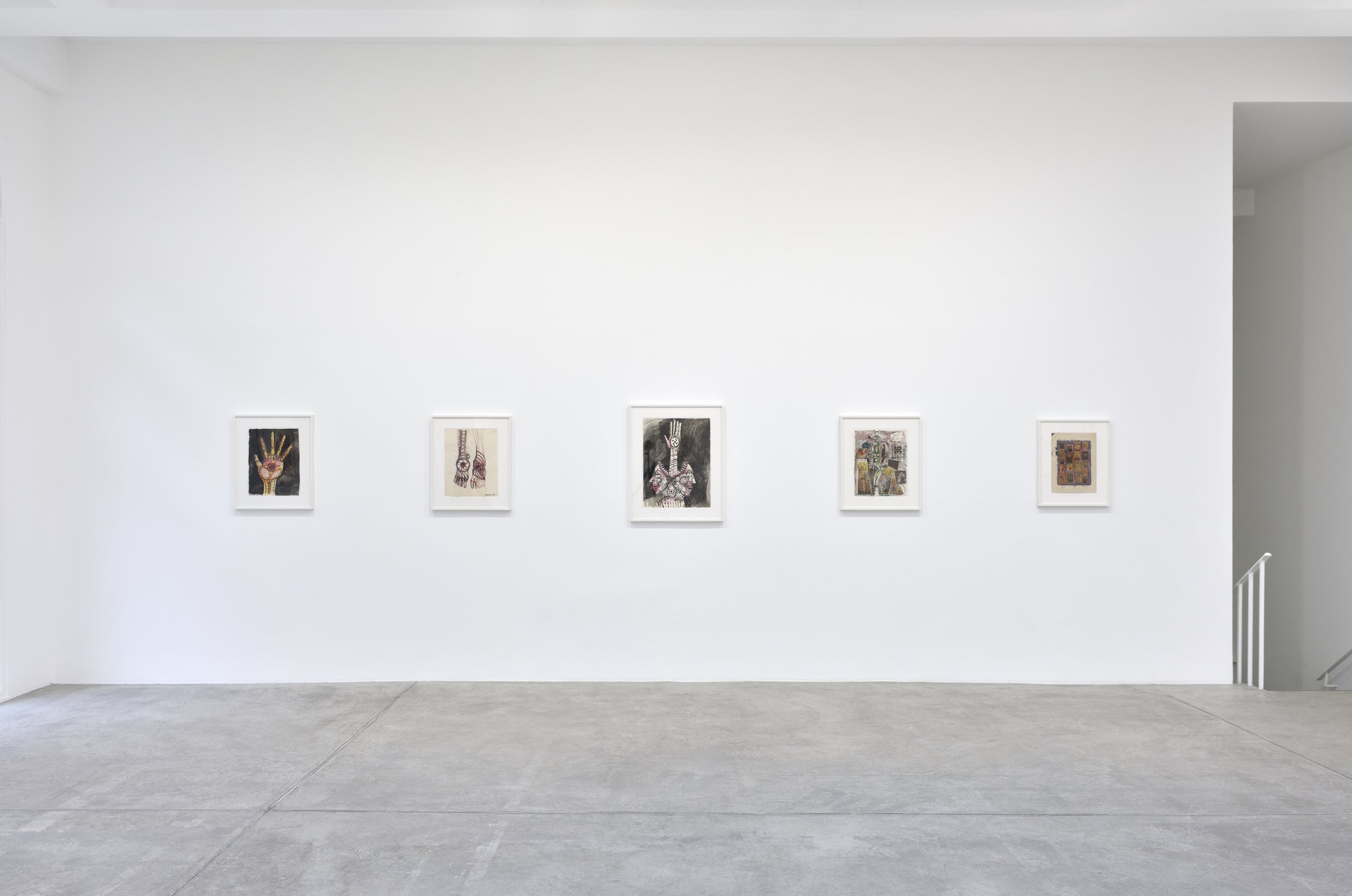
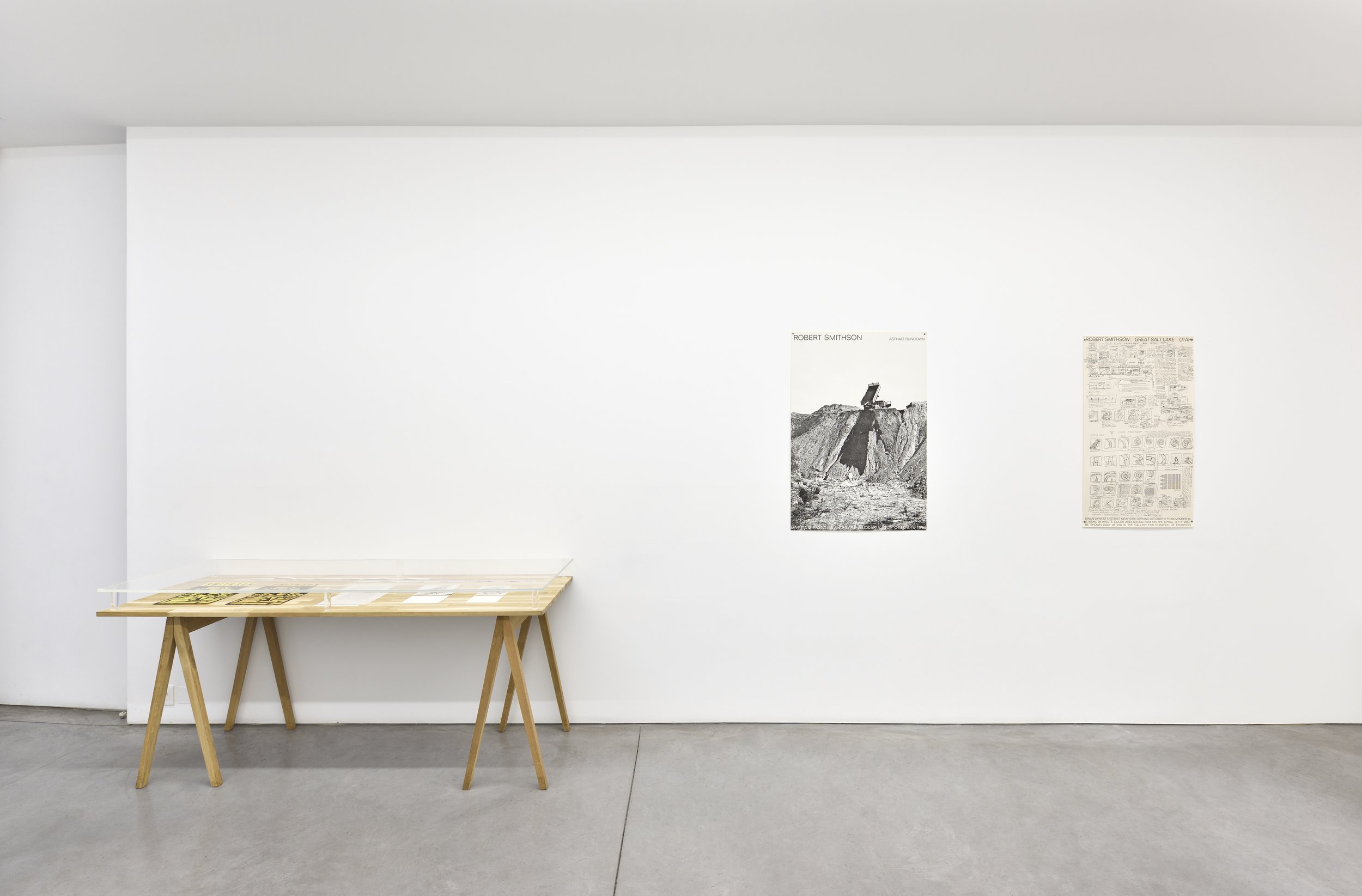
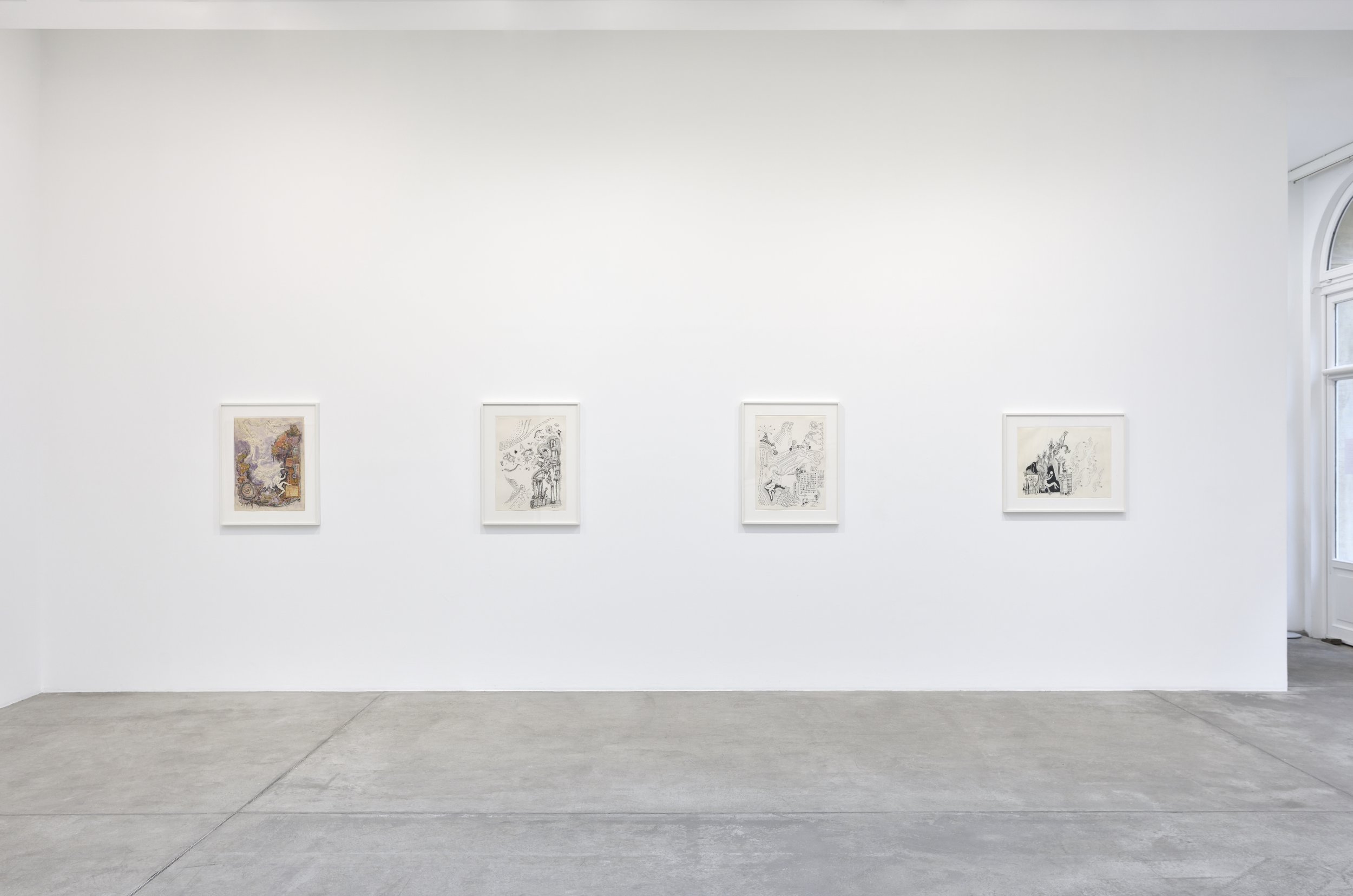
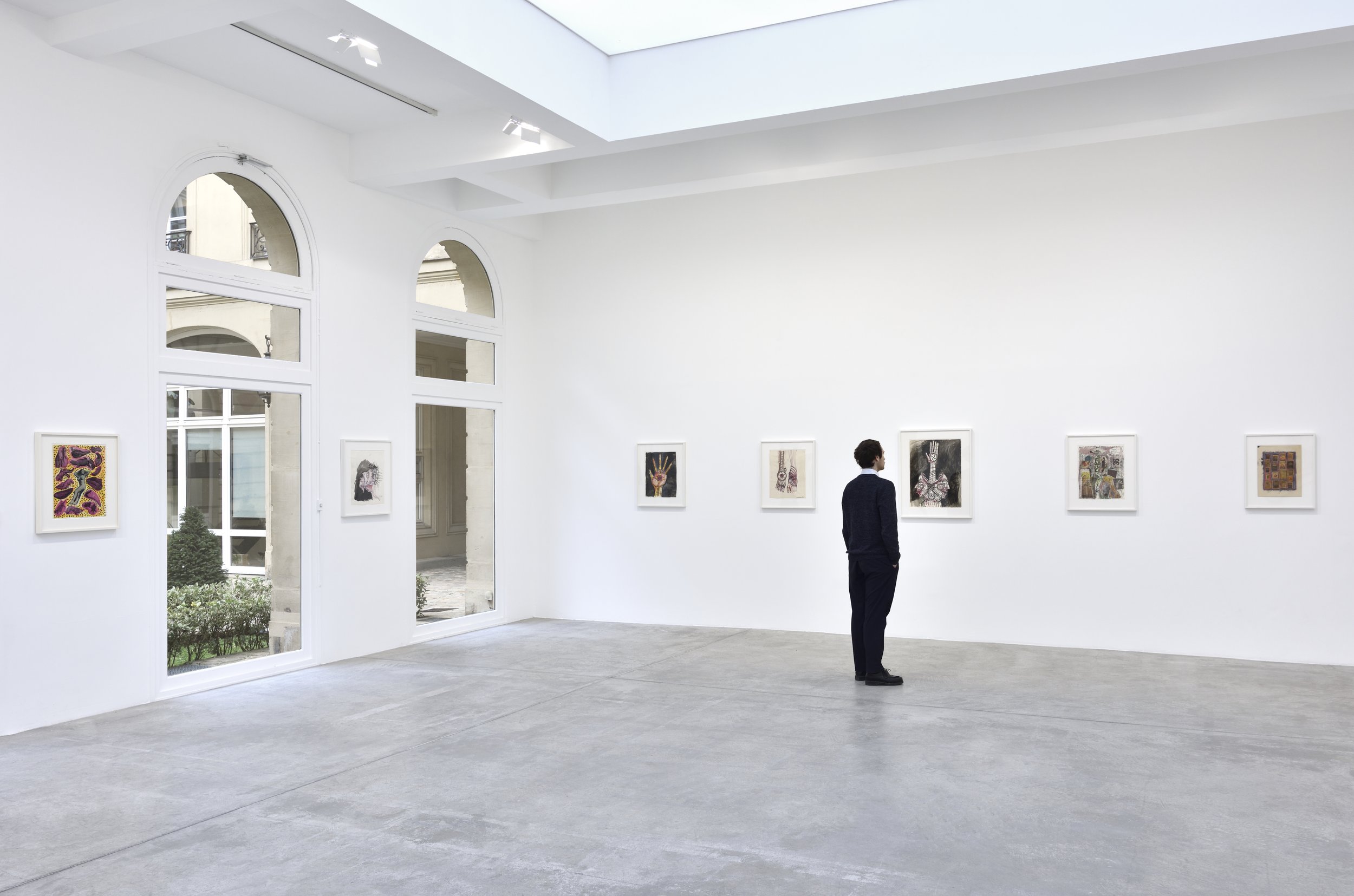


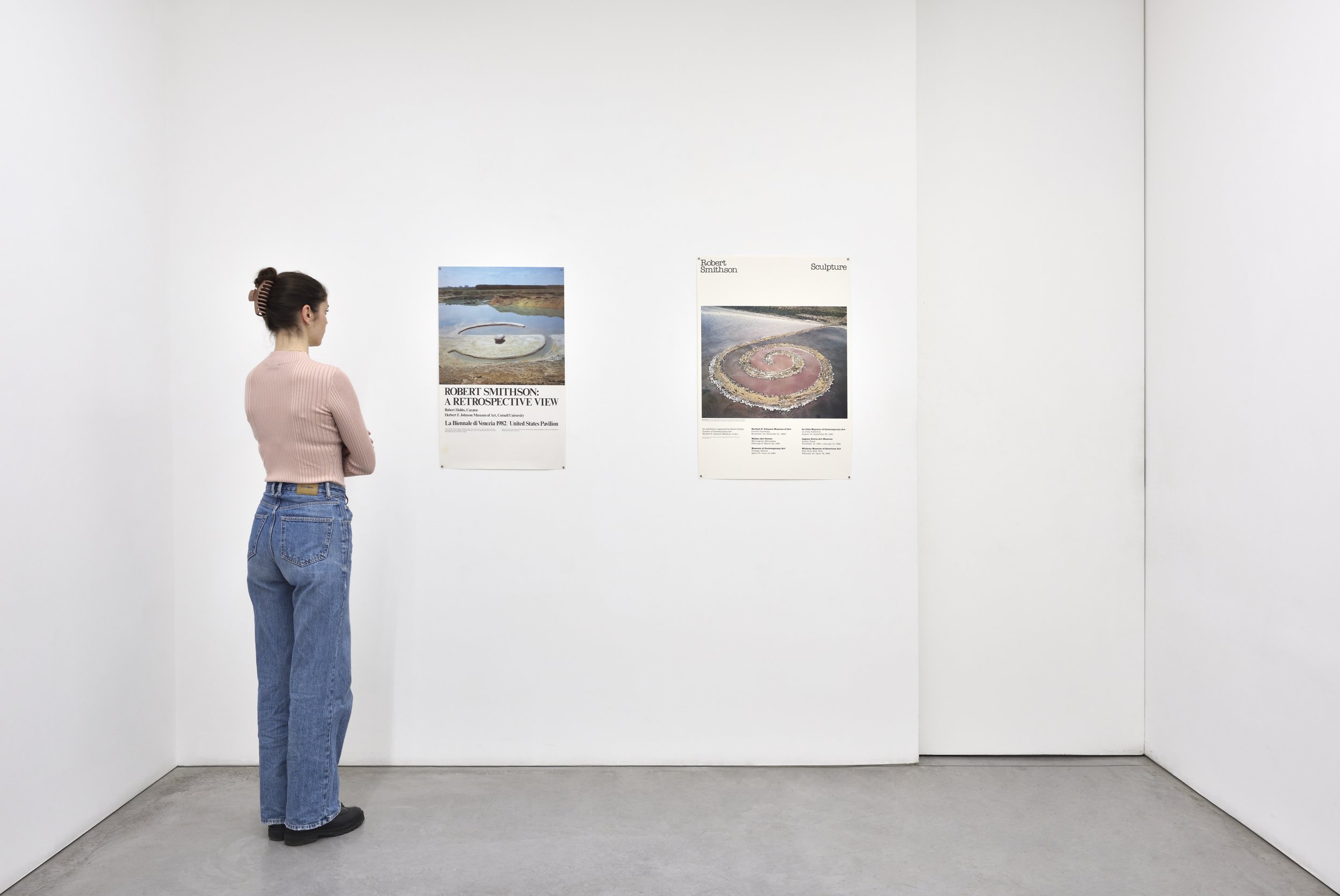

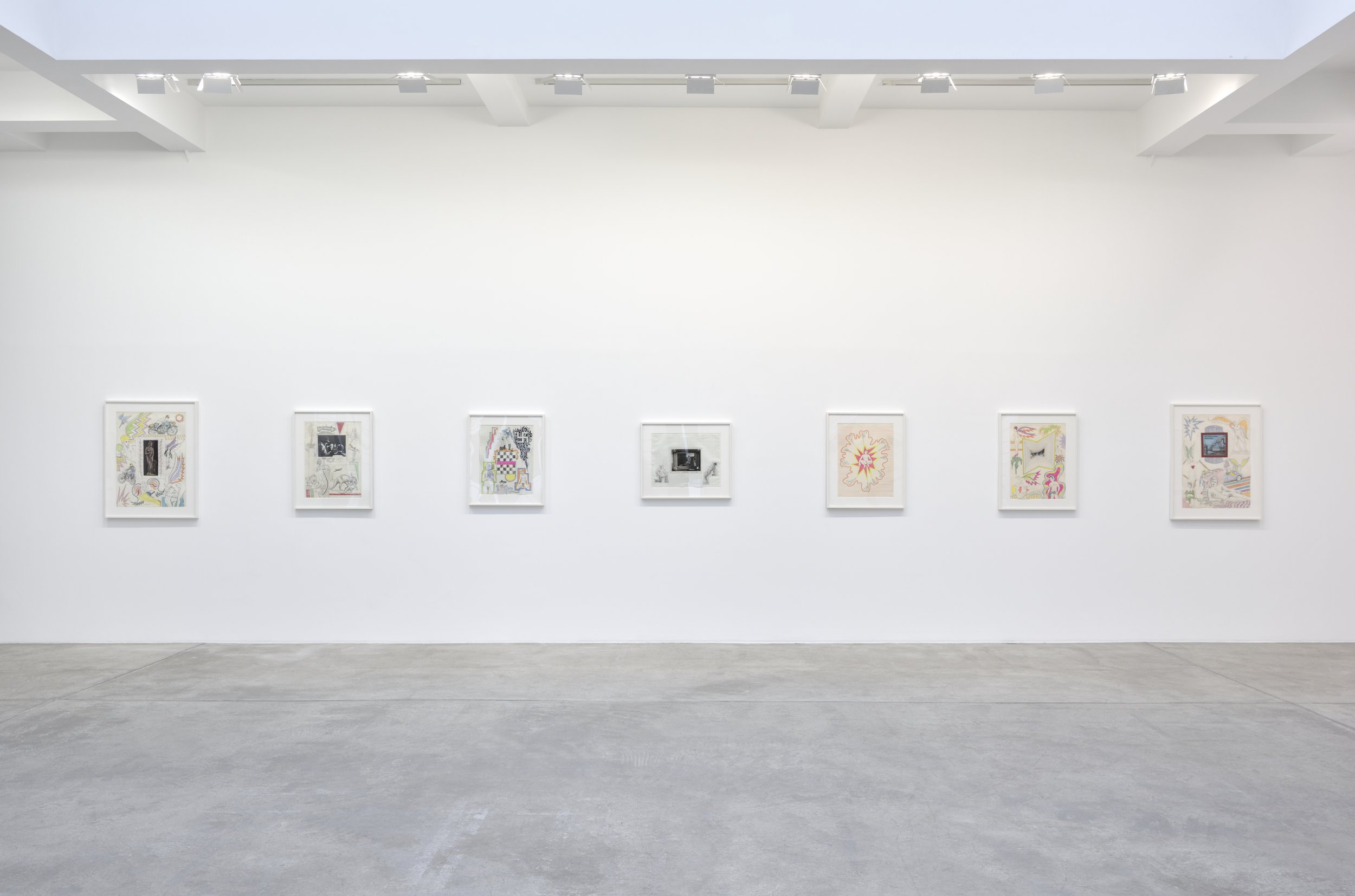
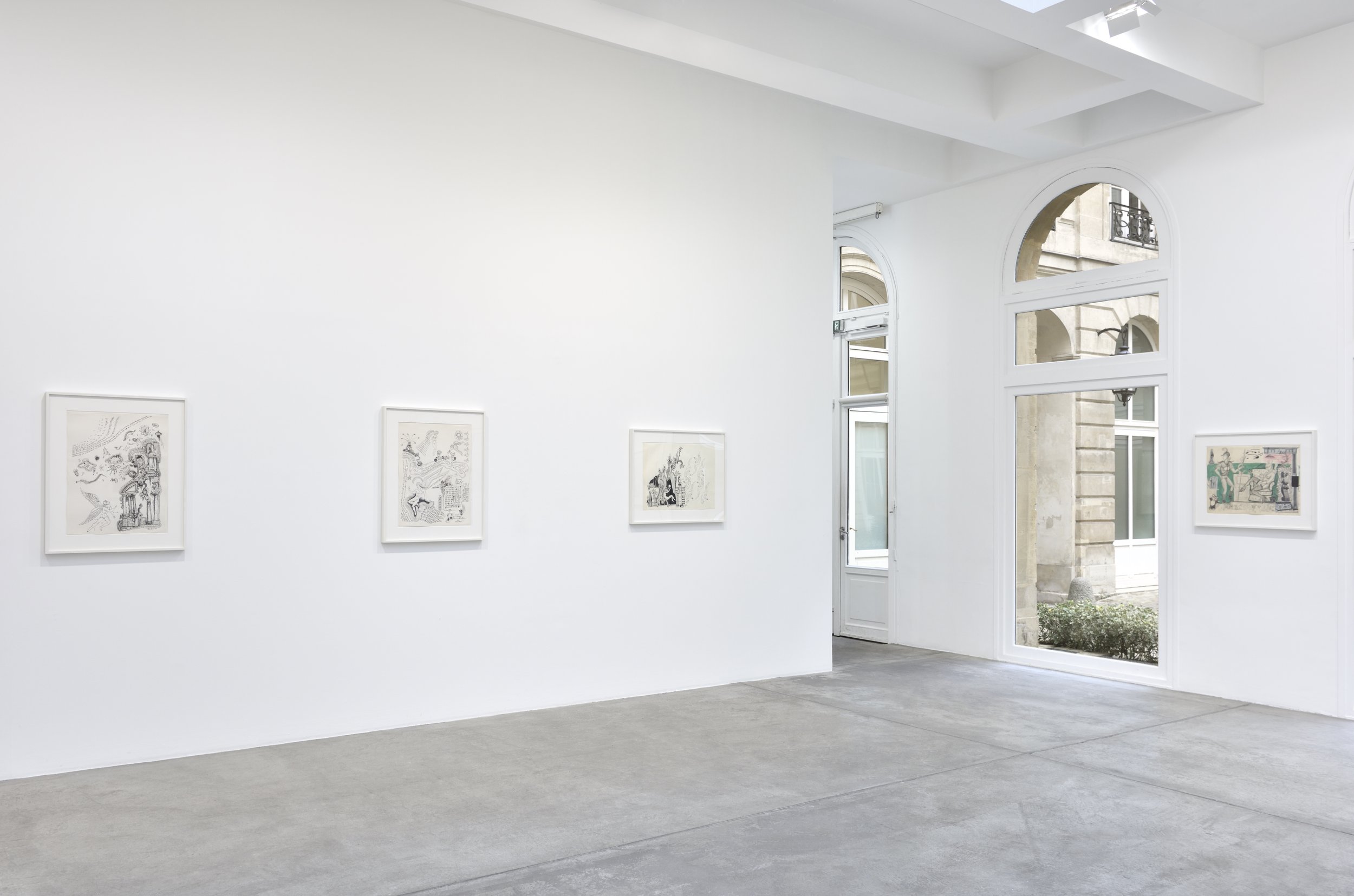

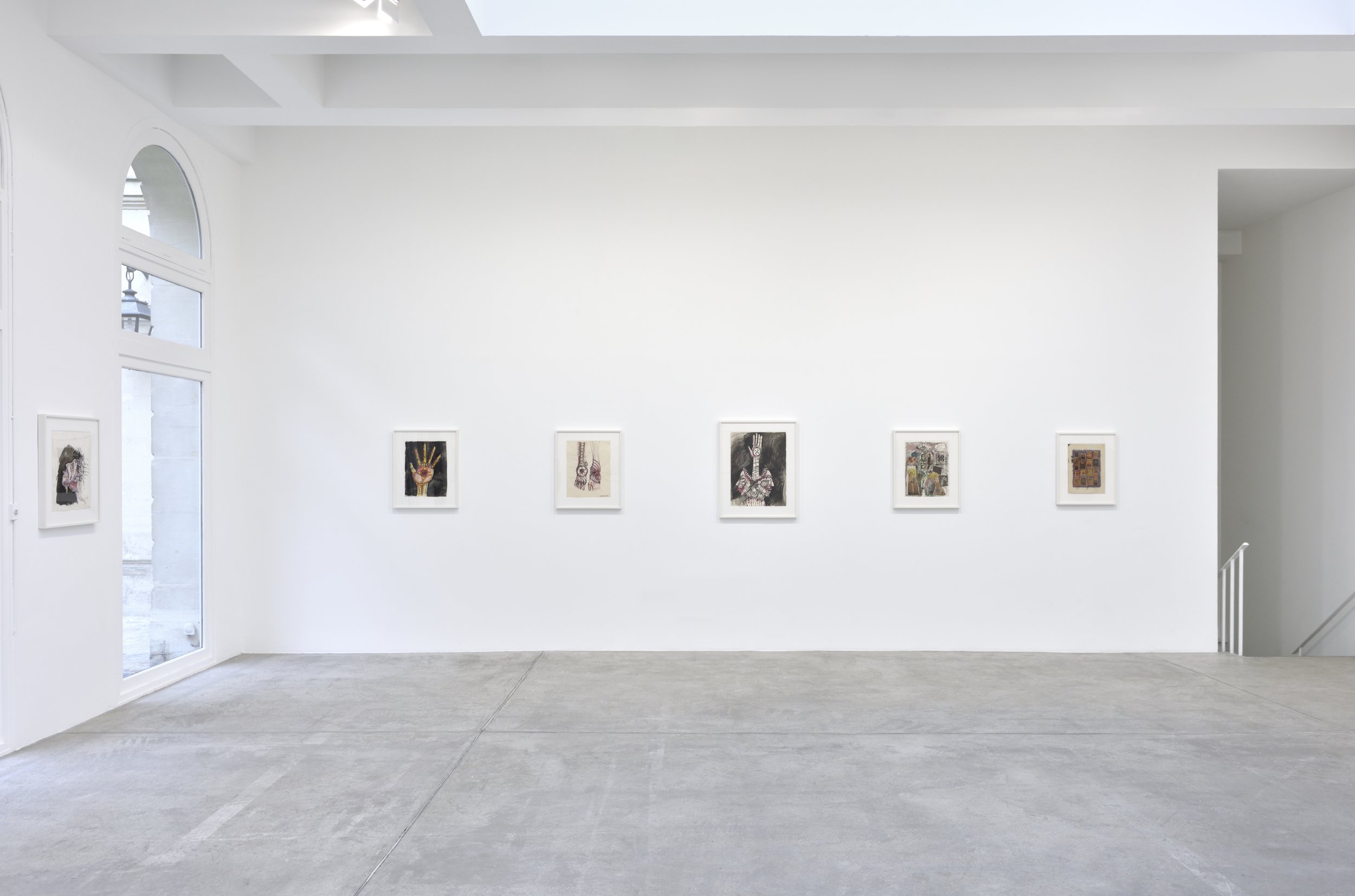
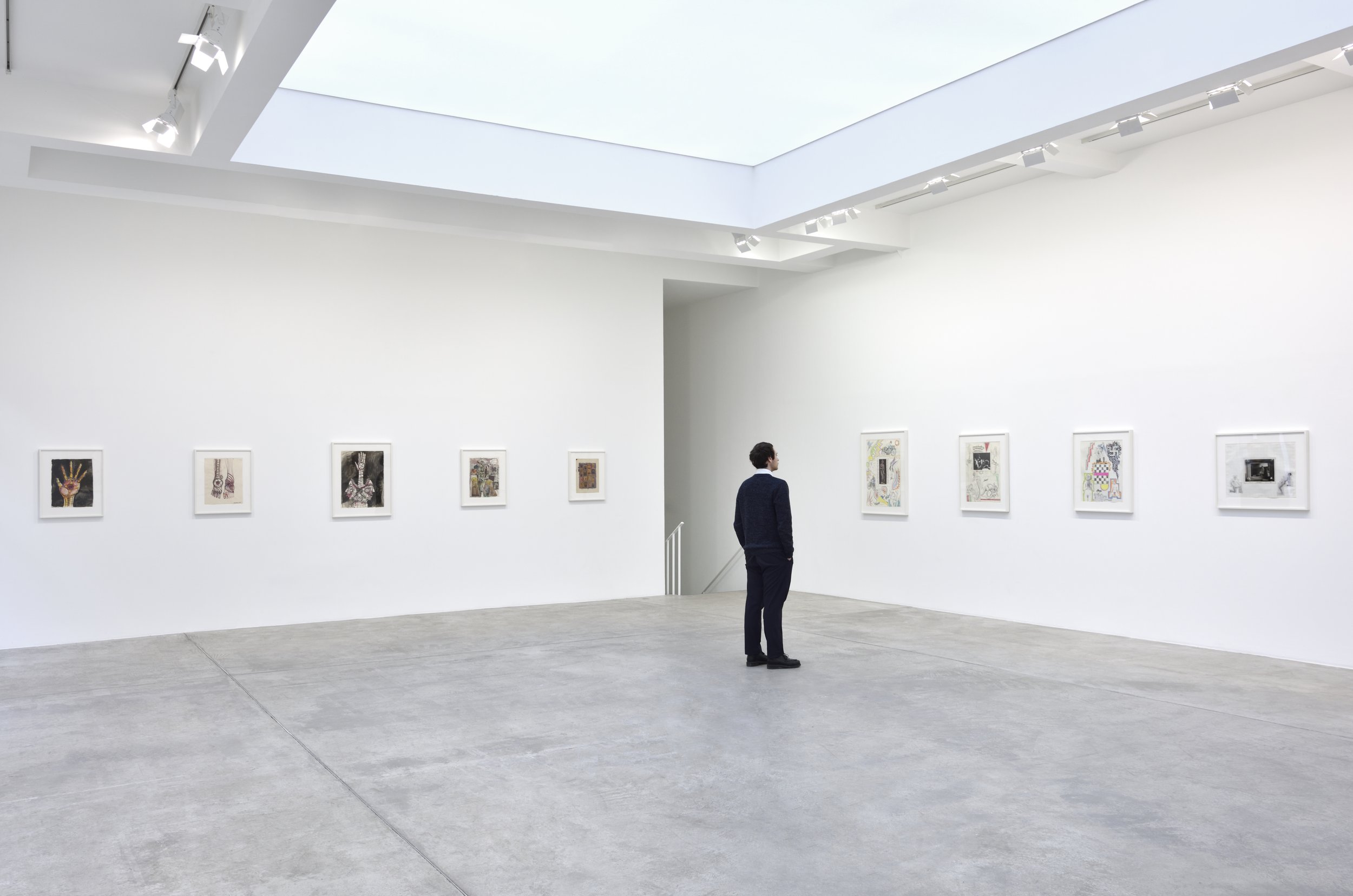
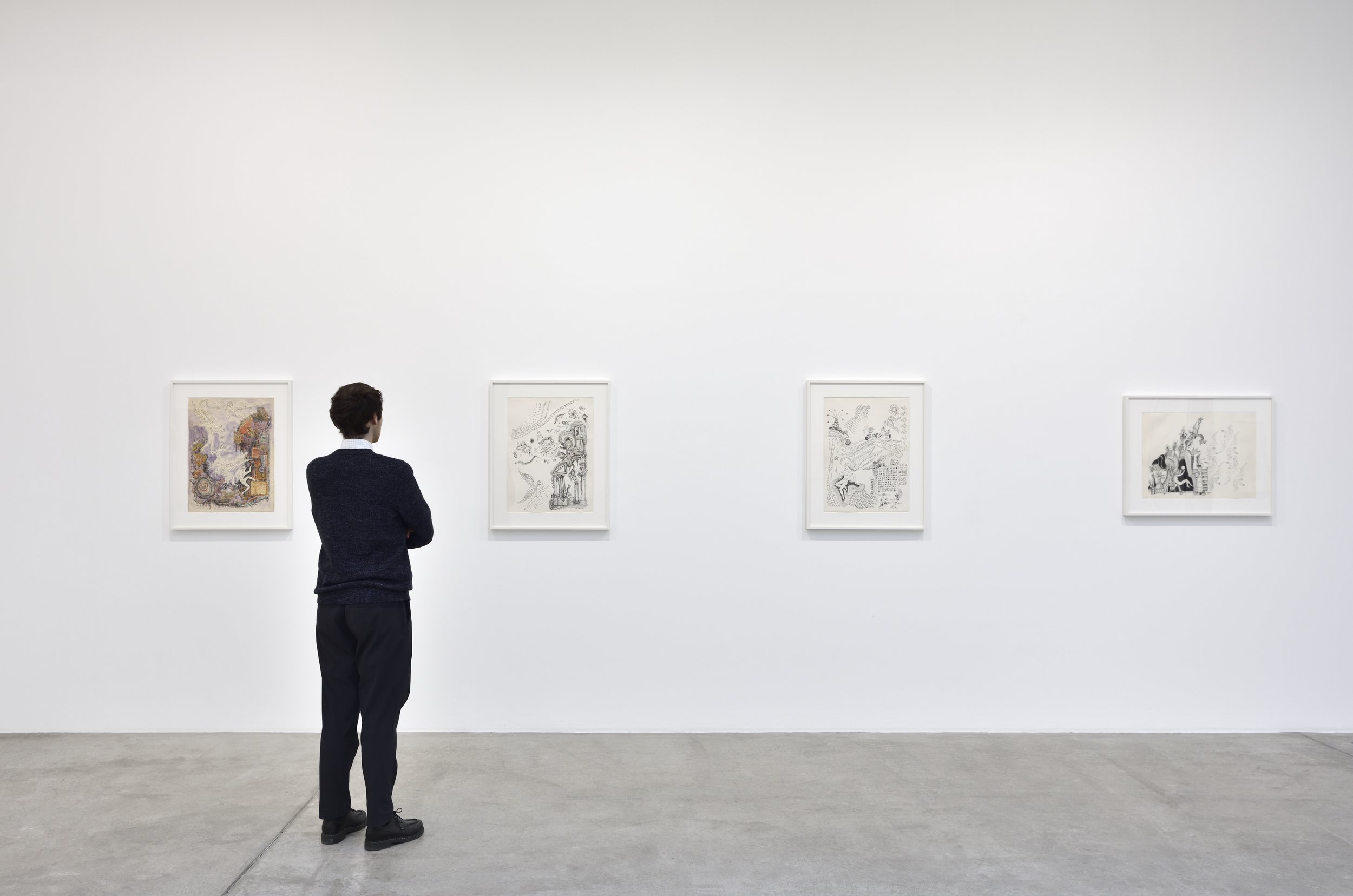
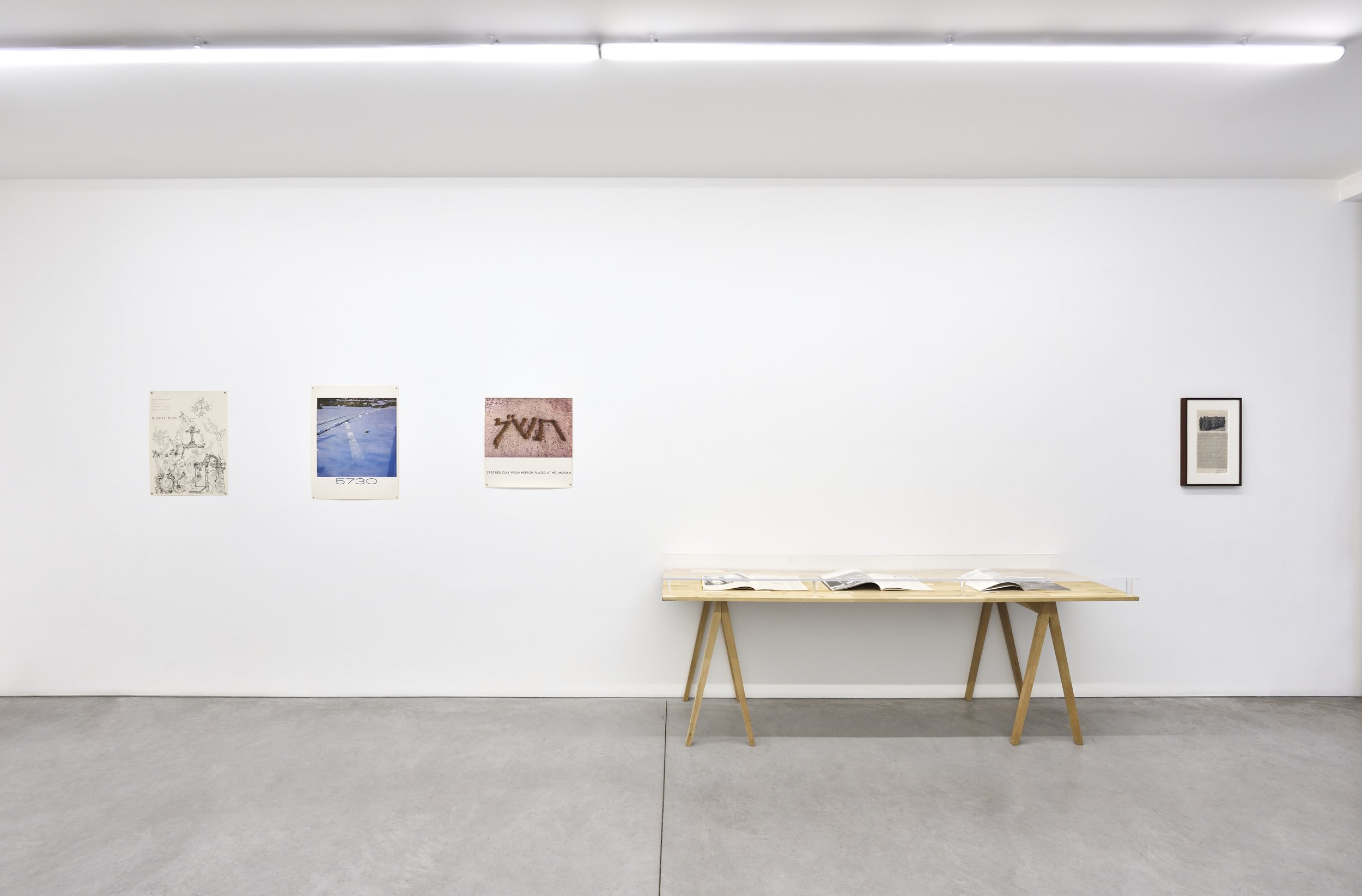
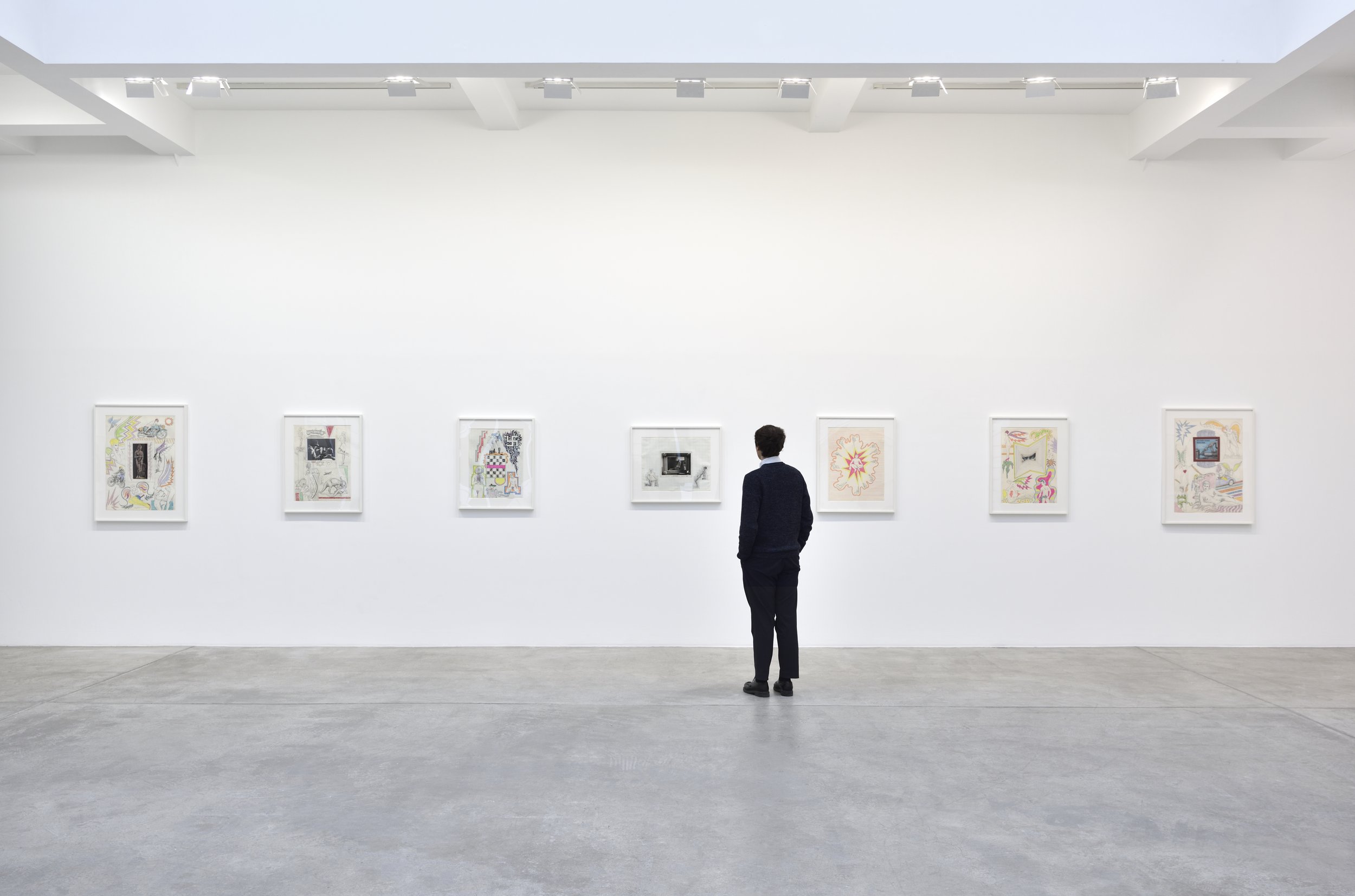
Exhibition view Robert Smithson: Mundus Subterraneus Early Works, Galerie Marian Goodman Paris. 13 January – 24 February 2024 Photo credit: Rebecca Fanuele © Holt/Smithson Foundation /Licensed by Artists Rights Society, New York Courtesy Holt/Smithson Foundation and Marian Goodman Gallery
Born in Passaic in New Jersey, Robert Smithson (1938-1973) was an artist who expanded what art could be and where it could be found. For over fifty years his work, writings, and ideas have influenced artists and thinkers, building the ground from which contemporary art has grown. An autodidact, Smithson's interests in travel, cartography, geology, architectural ruins, prehistory, philosophy, science fiction, popular culture, and language spiral through his work. In his short and prolific life, Smithson produced paintings, drawings, sculpture, earthworks, film and video, photographs, writings, and all the stops between. From his landmark earthworks to his Nonsites, writings, proposals, collages, detailed drawings, and radical rethinking of landscape, Smithson's ideas are profoundly urgent for our times.
Hands Stigmata, 1961 Gouache on paper 18 x 13 5/8 in. (45.7 x 34.6 cm) Photo credit: Alex Yudzon © Holt/Smithson Foundation /Licensed by Artists Rights Society, New York Courtesy Holt/Smithson Foundation and Marian Goodman Gallery
By exploring the conceptual and physical boundaries of knowledge Smithson raised essential questions about our place in the world. Smithson’s first solo exhibition, which emphasized what he described as “expressionistic work,” took place in 1957 at Alan Brilliant’s gallery in New York. The artist’s peripatetic life took him to Rome in 1961, when George Lester offered him his first solo international exhibition at Galleria George Lester, where he explored quasi-religious subject matter. His early paintings, drawings, and sculptures are imbued with references to queer and fetish culture, popular movies, science fiction, religion, and art history.
Smithson poster for the Artist's Gallery, 1959 Ink on paper 12 1/8 x 9 1/8 in. (30.8 x 23.2 cm) Photo credit: Rebecca Fanuele © Holt/Smithson Foundation /Licensed by Artists Rights Society, New York Courtesy Holt/Smithson Foundation and Marian Goodman Gallery
Smithson's works are held in museum collections around the world including: Art Institute of Chicago; Modern Art Museum of Fort Worth, Texas; The Getty Research Institute, California; New Jersey State Museum; Philadelphia Museum of Art; Centre Pompidou, Paris; Dia Art Foundation, New York; Museum of Modern Art, New York; National Gallery, Washington DC; National Gallery of Australia, Canberra; National Museum of Modern Art, Tokyo; Solomon R. Guggenheim Museum, New York; and the Whitney Museum of American Art, New York. Currently Robert Smithson’s work is in the group exhibition Forms of Ruin at Musée des Beaux-Arts de Lyon. In July 2024 the exhibition Teresita Fernández / Robert Smithson launches at SITE Santa Fe, New Mexico, marking the first time Robert Smithson’s work has been placed in conversation with an artist working today.
Robert Smithson: Mundus Subterraneus is organized by Lisa Le Feuvre, Executive Director of Holt/Smithson Foundation with Professor Adrian Rifkin. It is accompanied by an illustrated newspaper with a commissioned text by Professor Rifkin, which he presents on 13 January as a performance event. Professor Rifkin has taught in art schools since 1970, most recently as Professor of Art Writing at Goldsmiths, University of London. Robert Smithson’s 1961 essay The Iconography of Desolation is also included in the newspaper, along with illustrations of key works from the exhibition.
In February 2020 Holt/Smithson Foundation and Marian Goodman Gallery announced their partnership. Marian Goodman has a long relationship with the work of Smithson, in 1965 Marian Goodman was a founder of Multiples, Inc., a landmark project publishing prints, multiples, and books by leading American artists— including Robert Smithson. Mundus Subterraneus is the second exhibition of Robert Smithson at Galerie Marian Goodman and the fourth exhibition with Marian Goodman Gallery. The works and posters on display are from the collection of Holt/Smithson Foundation.
In 2014 the artist Nancy Holt (1938-2014), who was married to Robert Smithson (1938-1973), willed Holt/Smithson Foundation into being. The Foundation has been active since 2018 and develops the distinctive creative legacies of Holt and Smithson. A research-led organization collaborating with artists, writers, thinkers and institutions, Holt/Smithson Foundation realizes exhibitions, publishes books, initiates artist commissions, programs educational events, encourages research, and develops collections globally from its headquarters in New Mexico.
For more information about the exhibit, please visit the Marian Goodman Gallery’s site. The gallery can be found on Instagram and Artsy, too. Information about the Holt/Smithson Foundation can be found here.
Yayoi Kusama’s LOVE IS CALLING
Installation view of Yayoi Kusama: LOVE IS CALLING, on view from March 9, 2023, to February 11, 2024, at Pérez Art Museum Miami (PAMM). Courtesy of Pérez Art Museum Miami (PAMM)
Pérez Art Museum Miami (PAMM) is pleased to present Yayoi Kusama: LOVE IS CALLING, the most immersive and kaleidoscopic of the artist’s renowned Infinity Mirror Rooms. The exhibition opened on March 9, 2023 and will be on view until February 11, 2024. LOVE IS CALLING is the artist’s largest environment to date—embodying the culmination of Kusama’s artistic feats, the show incorporates her signature polka dots and bold colors, the spoken word, and limitless reflections that double as optical illusions.
“We are honored to offer this experience to our audience as Kusama is an iconic artist with an important career trajectory. She has been creating works that are lively, thoughtful, and introspective, which have been enjoyed by viewers for over six decades and will certainly be enjoyed by our Miami audience,” said PAMM Associate Curator Jennifer Inacio.
Viewers will enter a darkened, mirrored room illuminated by inflatable, tentacle-like forms that extend from the floor and ceiling, gradually changing colors. As visitors walk through the installation, a sound recording of Kusama reciting a love poem in Japanese plays continuously. Written by the artist, the poem’s title translates to Residing in a Castle of Shed Tears. Exploring enduring themes including life and death, the poem poignantly expresses Kusama’s hope to spread a universal message of love through her art.
“We are thrilled to showcase LOVE IS CALLING at Pérez Art Museum Miami, a perfect home for a work that connects people from all walks of life,” said PAMM Director Franklin Sirmans.
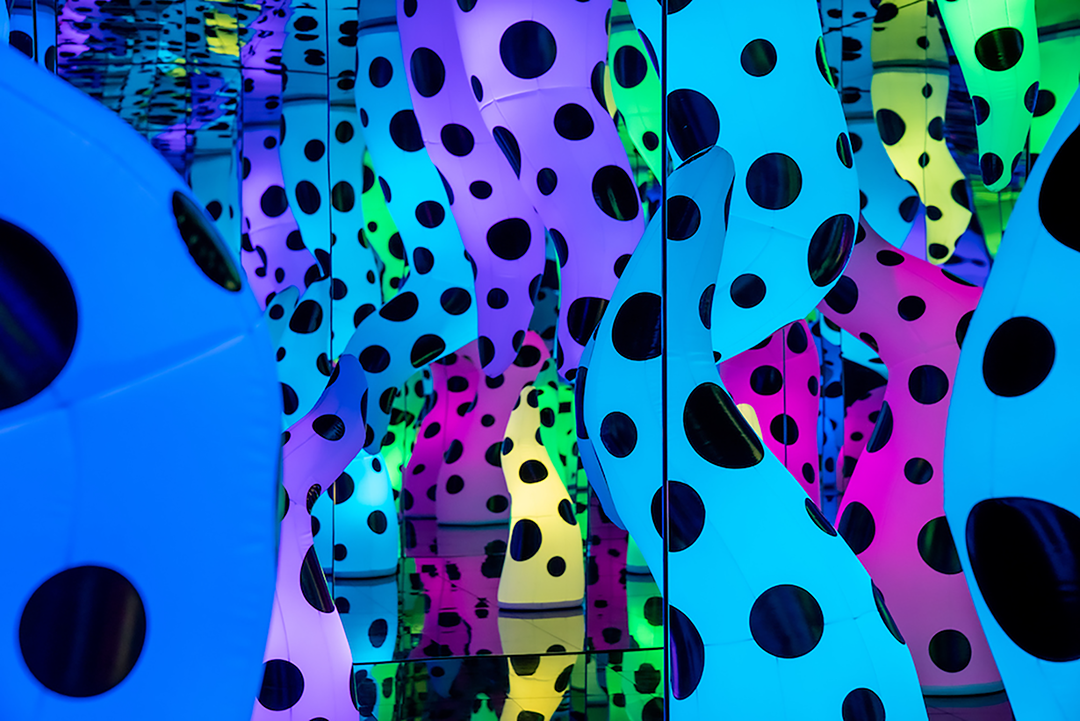
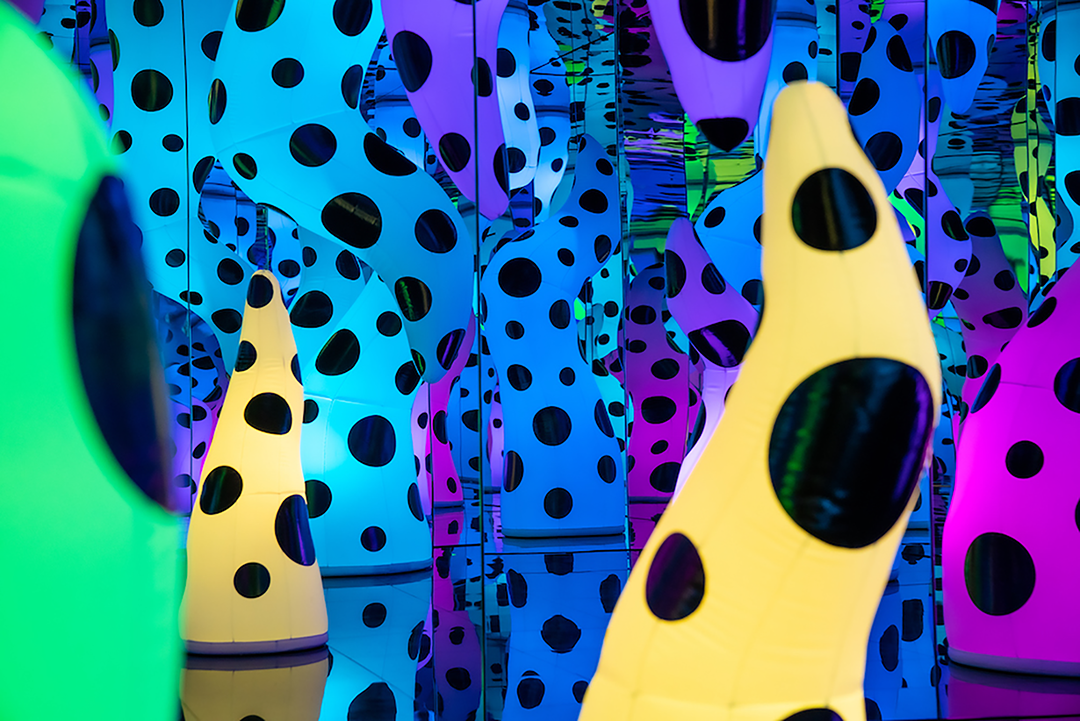
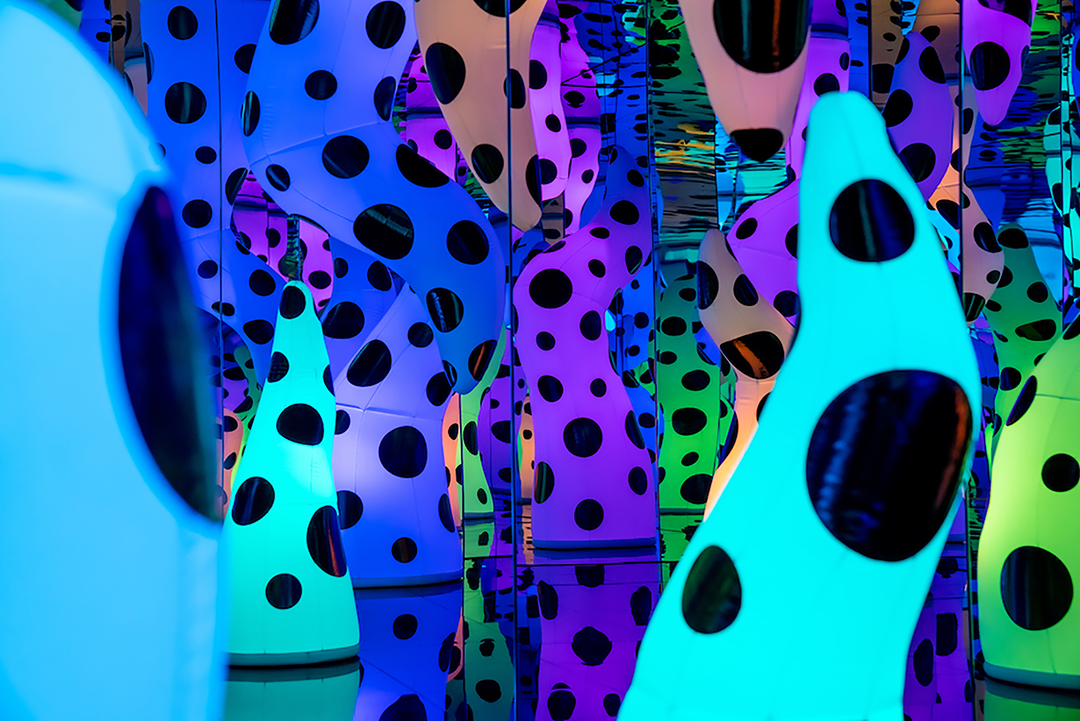
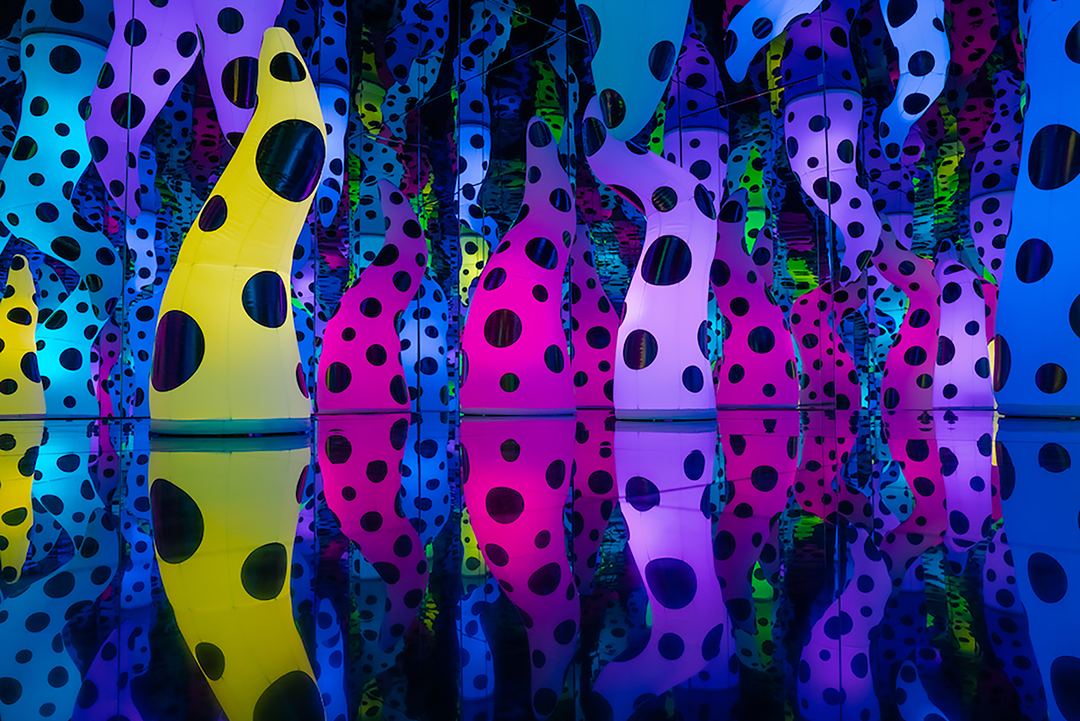
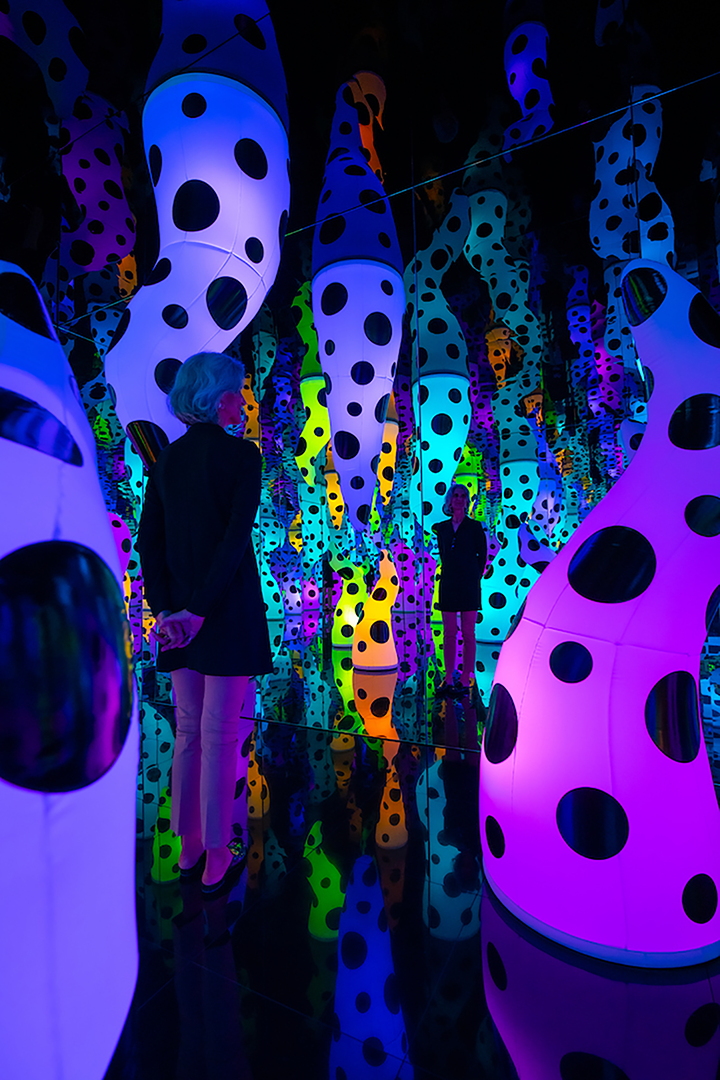
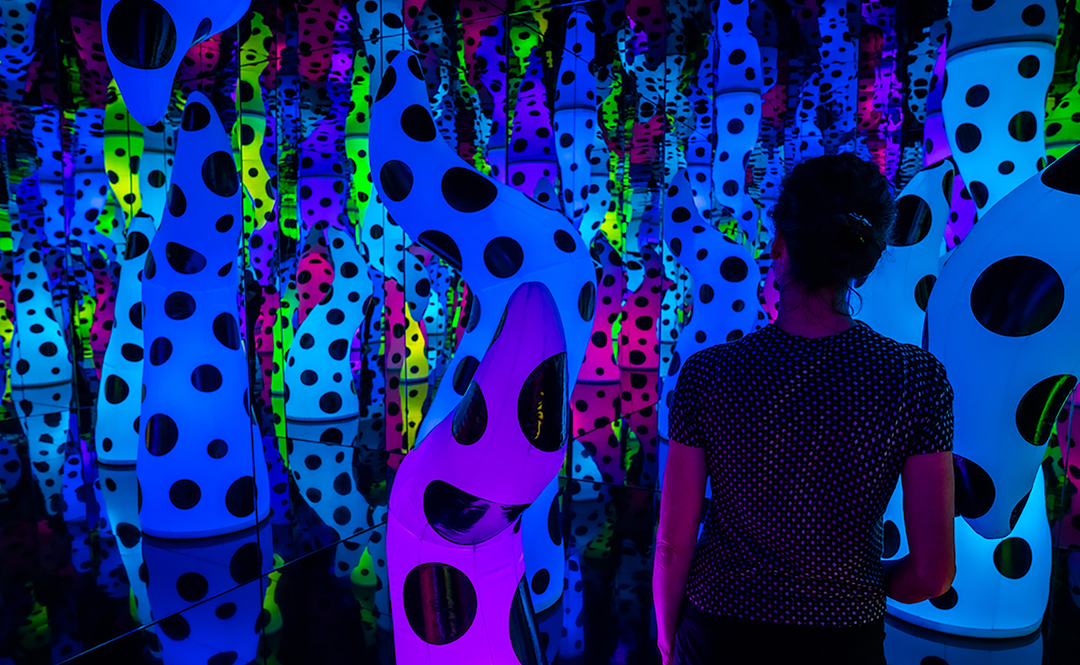
Installation view of Yayoi Kusama: LOVE IS CALLING, on view from March 9, 2023, to February 11, 2024, at Pérez Art Museum Miami (PAMM). Courtesy of Pérez Art Museum Miami (PAMM)
This is the first time the legendary artist has exhibited at PAMM. As Miami’s flagship art museum, PAMM is committed to showcasing 20th and 21st-century international modern and contemporary art. By presenting LOVE IS CALLING, the museum honors its mission of creating genuine human interaction, communication, and exchange for Miami’s diverse audiences through art.
Yayoi Kusama is one of the world’s most recognized and celebrated artists today. Her work has transcended two of the most notable art movements of the late twentieth century: Pop art and Minimalism. Her nearly seven-decade seminal career spans painting, performance, large-scale presentations, outdoor sculptural installations, literary pieces, films, fashion, and design. Featured globally in solo and group presentations, Kusama established herself in New York and presented groundbreaking events and exhibitions.
Yayoi Kusama: LOVE IS CALLING is organized by PAMM Associate Curator Jennifer Inacio. The exhibition is presented by Bank of America.
ABOUT YAYOI KUSAMA
Born in Matsumoto, Japan in 1929, Yayoi Kusama began her artistic education at the Kyoto School of Arts and Crafts. There, she studied Nihonga, a style of formal, traditional Japanese painting that emerged in the Meiji period (1868–1912). Following six solo exhibitions in Japan during her early artistic career, Kusama moved to New York in 1958, inspired by the rise of Abstract Expressionism in the United States. She was one of the first Japanese artists of her generation to make this move, and her early mobility, combined with her openly acknowledged history of mental illness, contributed to a highly visible, eccentric public persona.
Kusama represented Japan at the Venice Biennale in 1993. She has been the subject of international touring exhibitions organized by institutions such as the Los Angeles County Museum of Art and the Museum of Modern Art, New York (1998); Le Consortium, Dijon, France (2000); National Museum of Modern Art, Tokyo (2004); and Museum Boijmans Van Beuningen, Rotterdam (2008); as well as a major retrospective shown at the Museo Nacional Centro de Arte Reina Sofía, Madrid; Centre Georges Pompidou, Paris; Tate Modern, London; and Whitney Museum of American Art, New York (2011–12). The artist has won numerous awards and honors, including the Asahi Prize (2001), French Ordre des Arts et des Lettres (2003), and 18th Praemium Imperiale award for painting (2006). Kusama was the subject of Near Equal Yayoi Kusama: I Adore Myself (2008), a documentary film by Takako Matsumoto.
ABOUT PAMM
Pérez Art Museum Miami (PAMM), led by Director Franklin Sirmans, promotes artistic expression and the exchange of ideas, advancing public knowledge and appreciation of art, architecture, and design, and reflecting the diverse community of its pivotal geographic location at the crossroads of the Americas. The nearly 40-year-old South Florida institution, formerly known as Miami Art Museum (MAM), opened a new building, designed by world-renowned architects Herzog & de Meuron, on December 4, 2013 in Downtown Miami’s Maurice A. Ferré Park. The facility is a state-of-the-art model for sustainable museum design and progressive programming and features 200,000 square feet of indoor and outdoor program space with flexible galleries, shaded outdoor verandas, a waterfront restaurant and bar; a museum shop, and an education center with a library, media lab, and classroom spaces.
Accredited by the American Alliance of Museums, Pérez Art Museum Miami (PAMM) is Sponsored in part by the State of Florida, Department of State, Division of Arts and Culture and the Florida Council on Arts and Culture. Support is provided by the Miami-Dade County Department of Cultural Affairs and the Cultural Affairs Council, the Miami-Dade County Mayor and Board of County Commissioners. Additional support is provided by the City of Miami and the Miami OMNI Community Redevelopment Agency (OMNI CRA). Pérez Art Museum Miami is an accessible facility. All contents ©Pérez Art Museum Miami. All rights reserved.
For more information about this exhibit and other exhibits currently on view and upcoming, please visit the Pérez Art Museum website here. PAMM can also be found on Instagram, YouTube, TikTok, and Facebook.
Going Dark: The Contemporary Figure at the Edge of Visibility
Installation view, Going Dark: TheContemporary Figure at the Edge of Visibility, Solomon R. Guggenheim Museum, New York, October 20, 2023–April 7, 2024. Photo:Midge Wattles © Solomon R. Guggenheim Foundation
On October20, 2023, The Solomon R. Guggenheim Museum presented the opening of Going Dark: The Contemporary Figure at the Edge of Visibility, a major exhibition predicated on a duality: works of art that present the figure, yet obscure it in some way, thus existing at the “edge of visibility.” The exhibition asserts that these experimentations in figuration across media—painting, photography, drawing, prints, sculpture, video, and installation—articulate pressing questions around what it means to be seen, not seen, or erased in society. On view from October 20, 2023, through April 7, 2024, the exhibition features 28 artists and fills all six ramps of the museum’s Frank Lloyd Wright–designed rotunda.
Installation view, Going Dark: TheContemporary Figure at the Edge of Visibility, Solomon R. Guggenheim Museum, New York, October 20, 2023–April 7, 2024. Photo:Midge Wattles © Solomon R. GuggenheimFoundation
The artists in this exhibition “go dark” through a range of formal moves, including, but not limited to, literal darkening by way of shadowing or other lighting techniques; paint selections; reversing or otherwise concealing the body; and post-production tools like “chroma-keying.” Going Dark suggests that these approaches to the figure allow for engagement with urgent and ongoing discussions around visibility in its social context: both invisibility and hypervisibility within public and private spaces, as well as within institutions, (art) history, popular media, social media, and more. Through revealing and concealing the body, Going Dark probes a key point of conflict in representation: both the desire to be seen and the desire for obscurity, especially as technology offers more opportunities for (and dangers in) exposure than ever before.
Installation view, Going Dark: TheContemporary Figure at the Edge of Visibility, Solomon R. Guggenheim Museum, New York, October 20, 2023–April 7, 2024. Photo: Midge Wattles © Solomon R. Guggenheim Foundation
Going Dark features over 100 works of art by a multigenerational, multiracial group of artists, the majority of whom are Black and more than half of whom are women. Chronologically, the show proceeds from the mid-1980s, with paintings and photographs by Kerry James Marshall, Lorna Simpson, and Ming Smith, through to the present, with photography, sculpture and video works by Sandra Mujinga, Sondra Perry, Stephanie Syjuco, and others. Works from the late 1960s to early 1970s by David Hammons, Faith Ringgold, and Charles White offer earlier reference points for the contemporary history this show presents. Tiona Nekkia McClodden and WangShui debut new paintings, and American Artist presents a new site-specific installation.
Stephanie Syjuco, Block Out the Sun (Shadow), 2019-2022. Archival pigment print, 16 × 20 inches framed (40.6 × 50.8 cm). Courtesy the artist; Ryan Lee Gallery, New York; Catharine Clark Gallery, San Francisco; and Silverlens, Manila. © Stephanie Syjuco. Photo: Courtesy the artist; Ryan Lee Gallery, New York; Catharine Clark Gallery, San Francisco; and Silverlens, Manila
While focused on the social contexts of visibility, Going Dark also argues that this “semi-visible” figuration as a genre is one of art historical significance, intervening upon discourses of modernism and the monochrome. The works in the show move fluidly between figuration and abstraction, thus blurring the lines in that staid binary frame. Recognizing that making art at the limits of the visible requires new materials, tools, and processes, many of the artists featured in Going Dark inventively manipulate color and light to obscure both social and optical perception, challenging the very biology of how we see.
Installation view, Going Dark: TheContemporary Figure at the Edge of Visibility, Solomon R. Guggenheim Museum, New York, October 20, 2023–April 7, 2024. Photo:Midge Wattles © Solomon R. GuggenheimFoundation
A robust catalogue has been published alongside the exhibition featuring newly commissioned essays by curators and scholars Jordan Carter, Ayanna Dozier, Ashley James, Key Jo Lee, Abbe Schriber, and Legacy Russell. Also included are creative responses to the concept of “going dark” by seven poets and graphic designers: Rio Cortez, Harmony Holiday, Marwa Helal, Kristian Henson, Nontsikelelo Mutiti, and Hassan Rahim, and Kevin Young. The book is designed by Fahad AlHunaif.
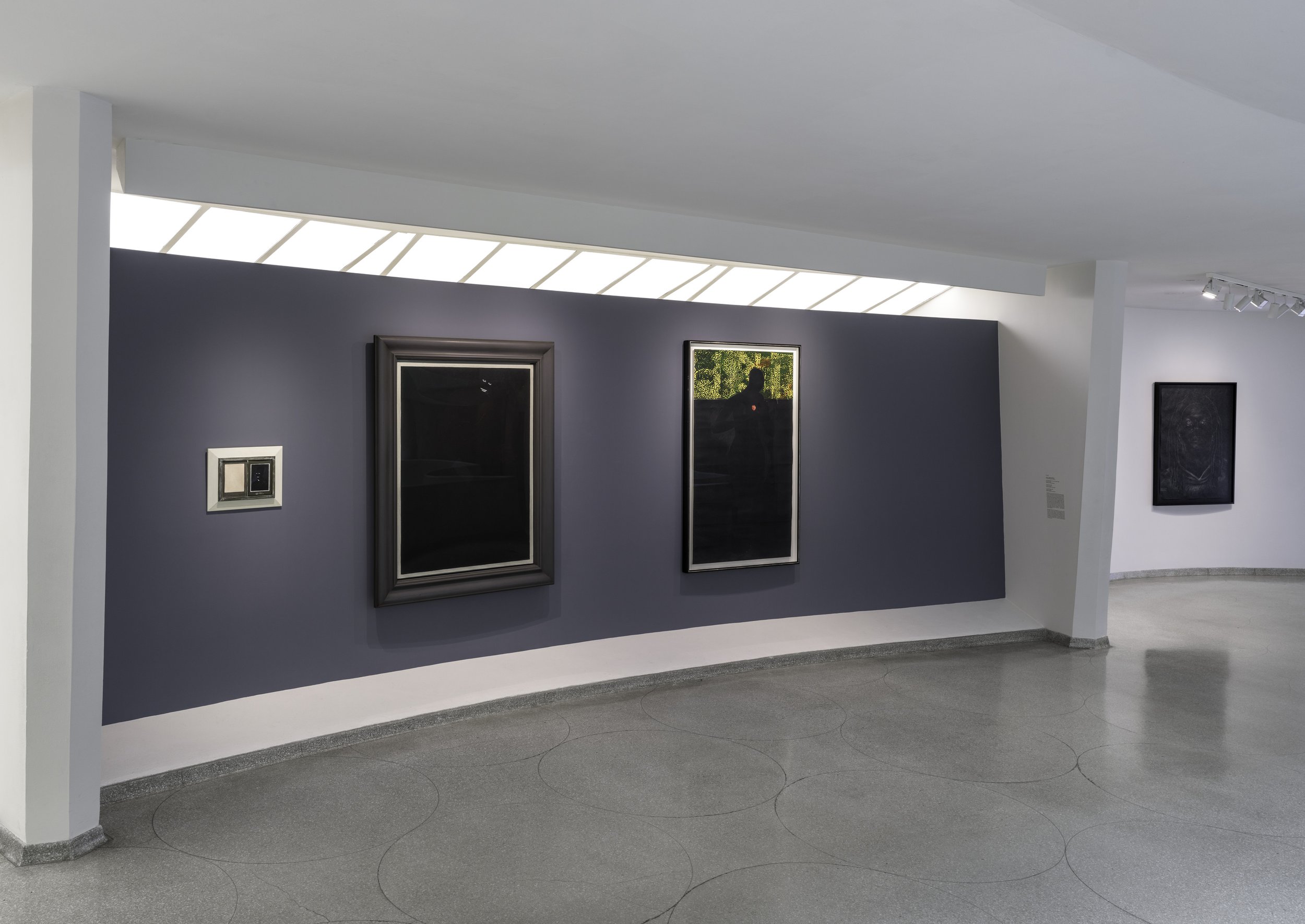


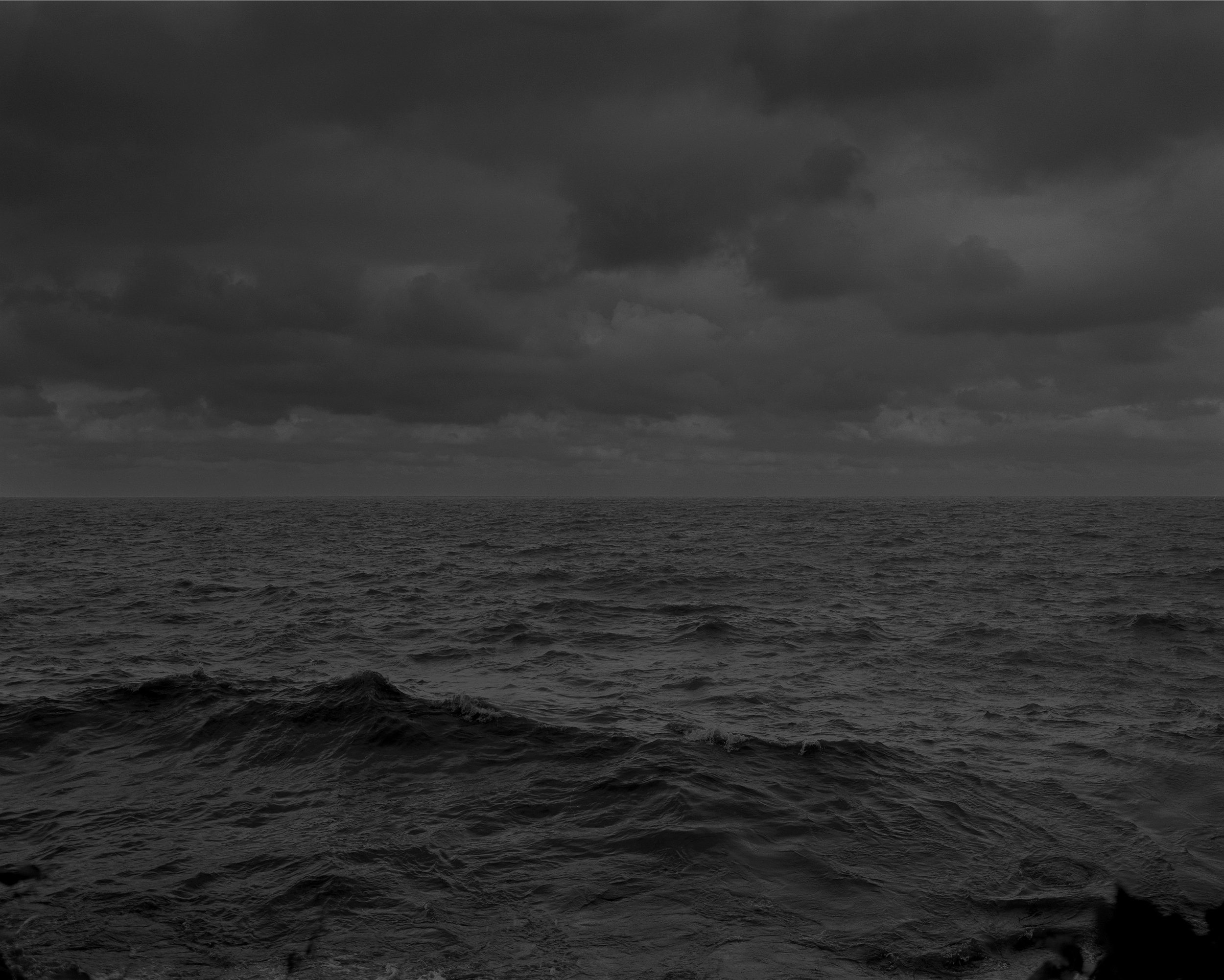
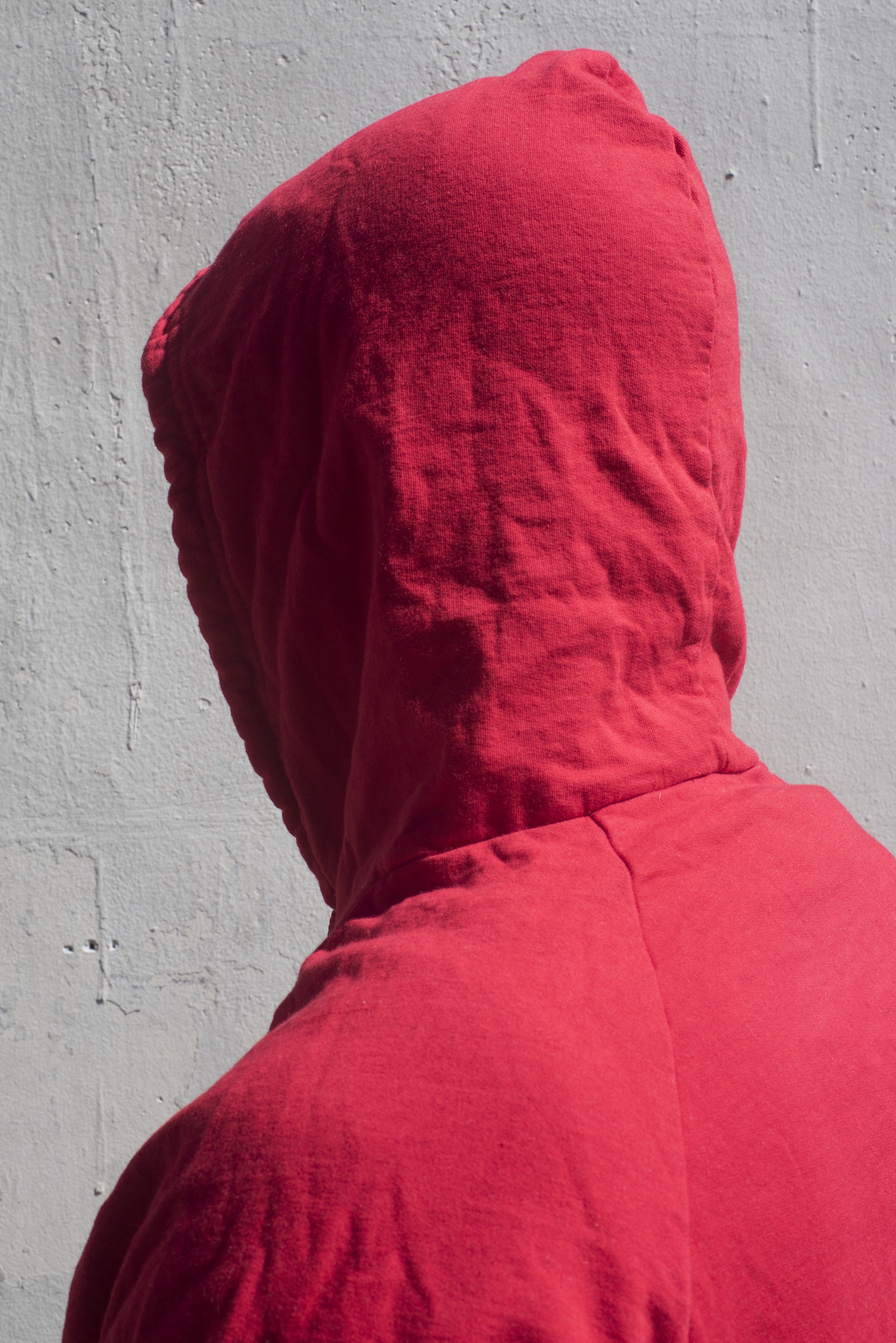
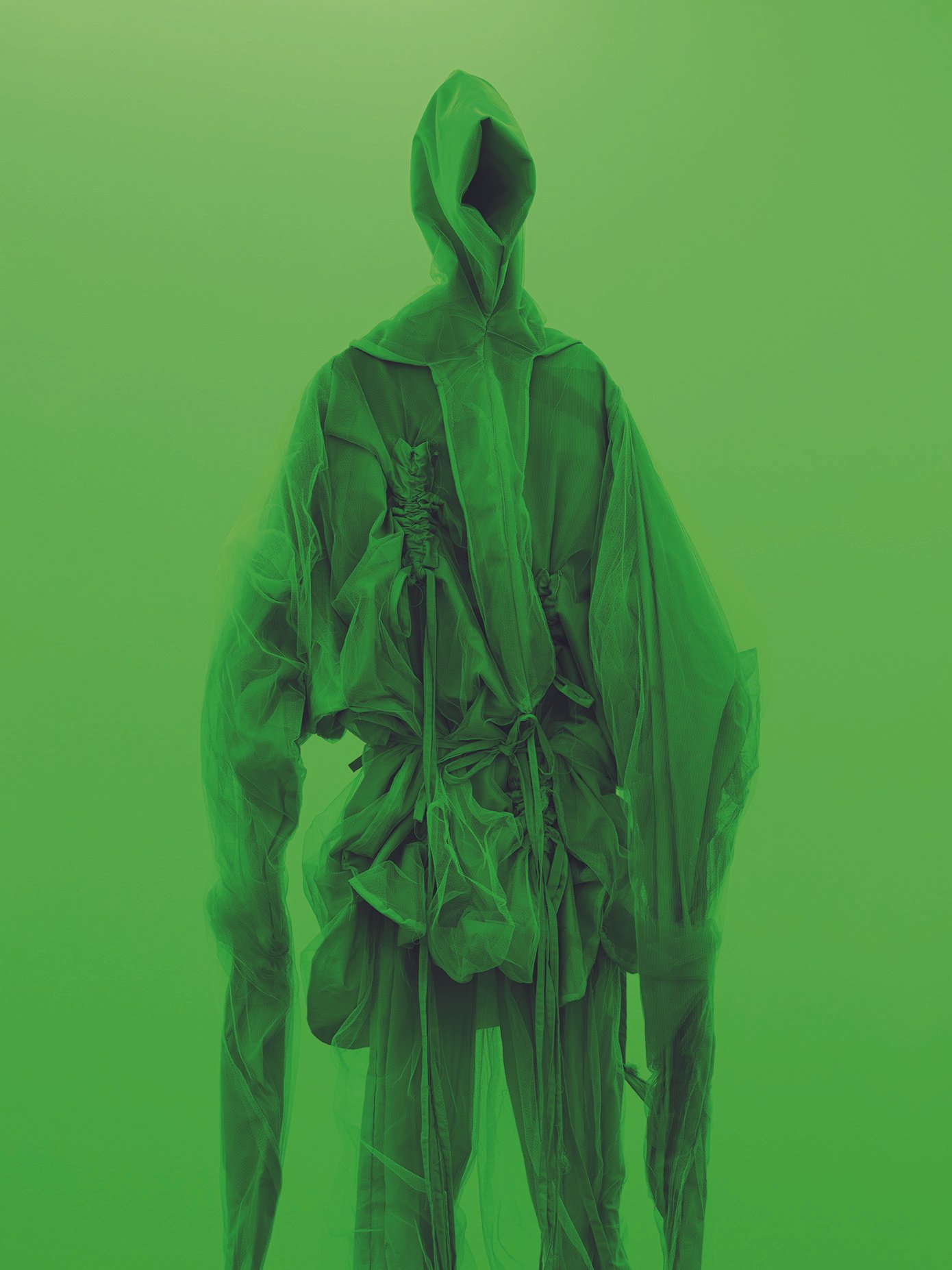
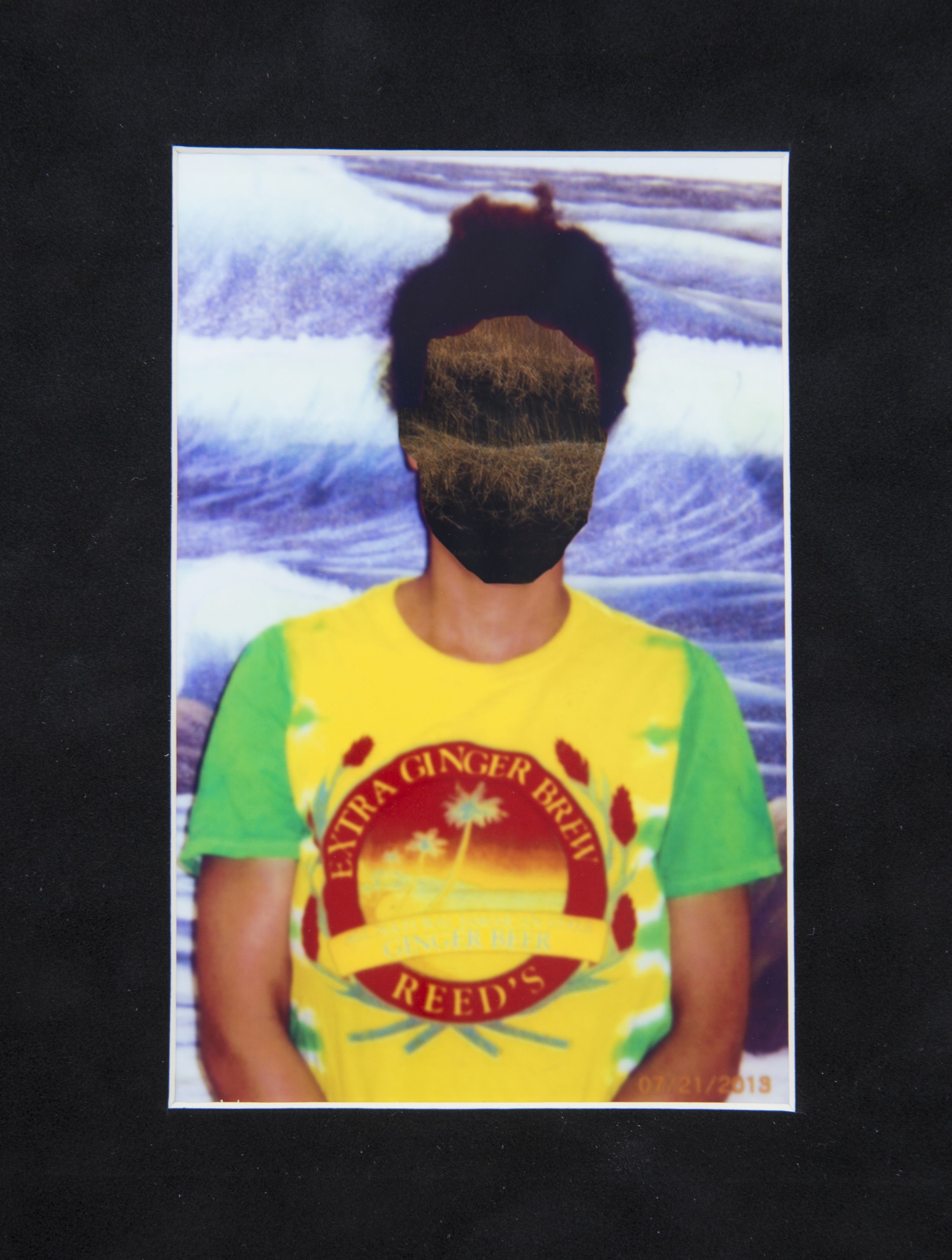
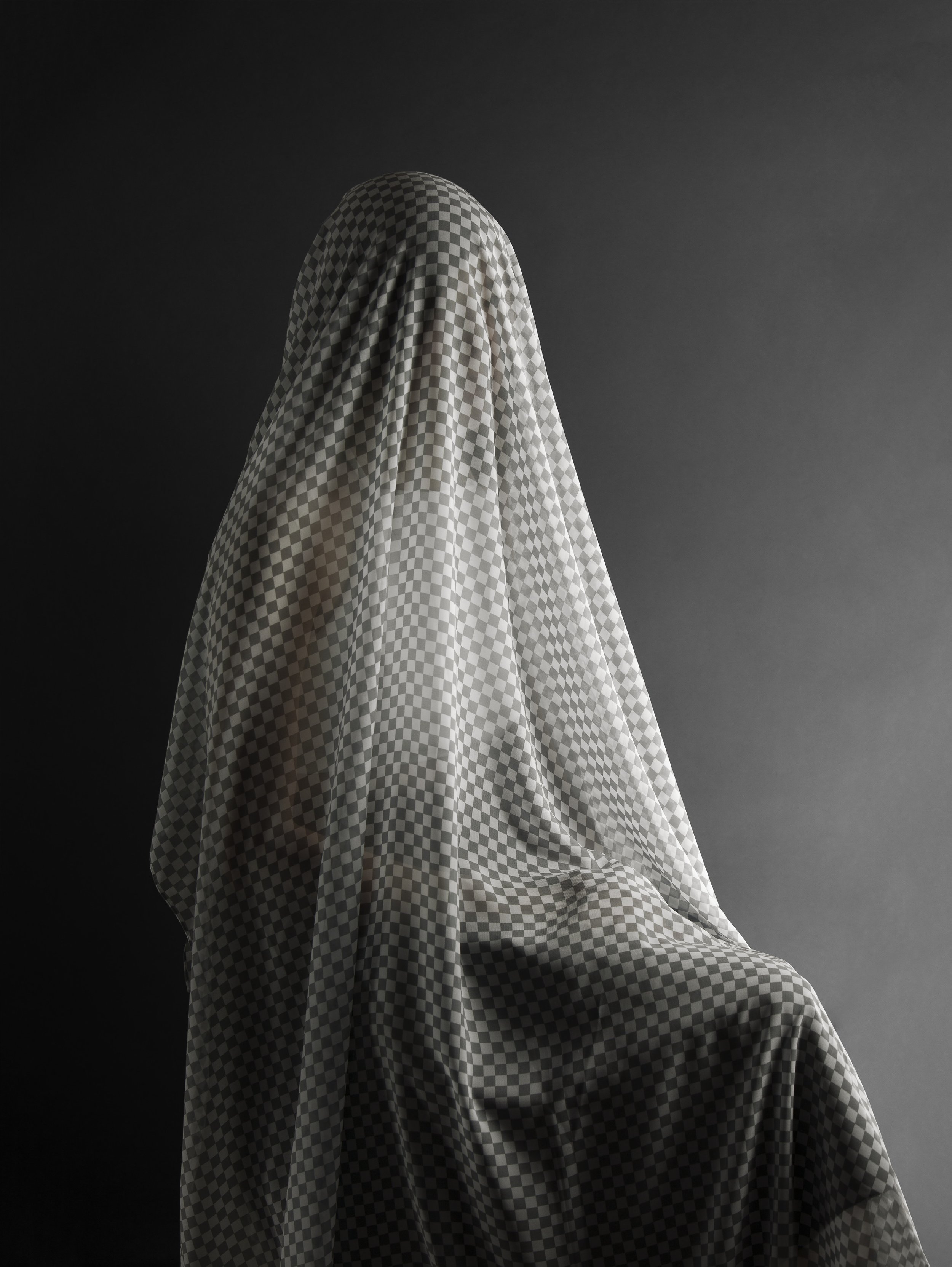

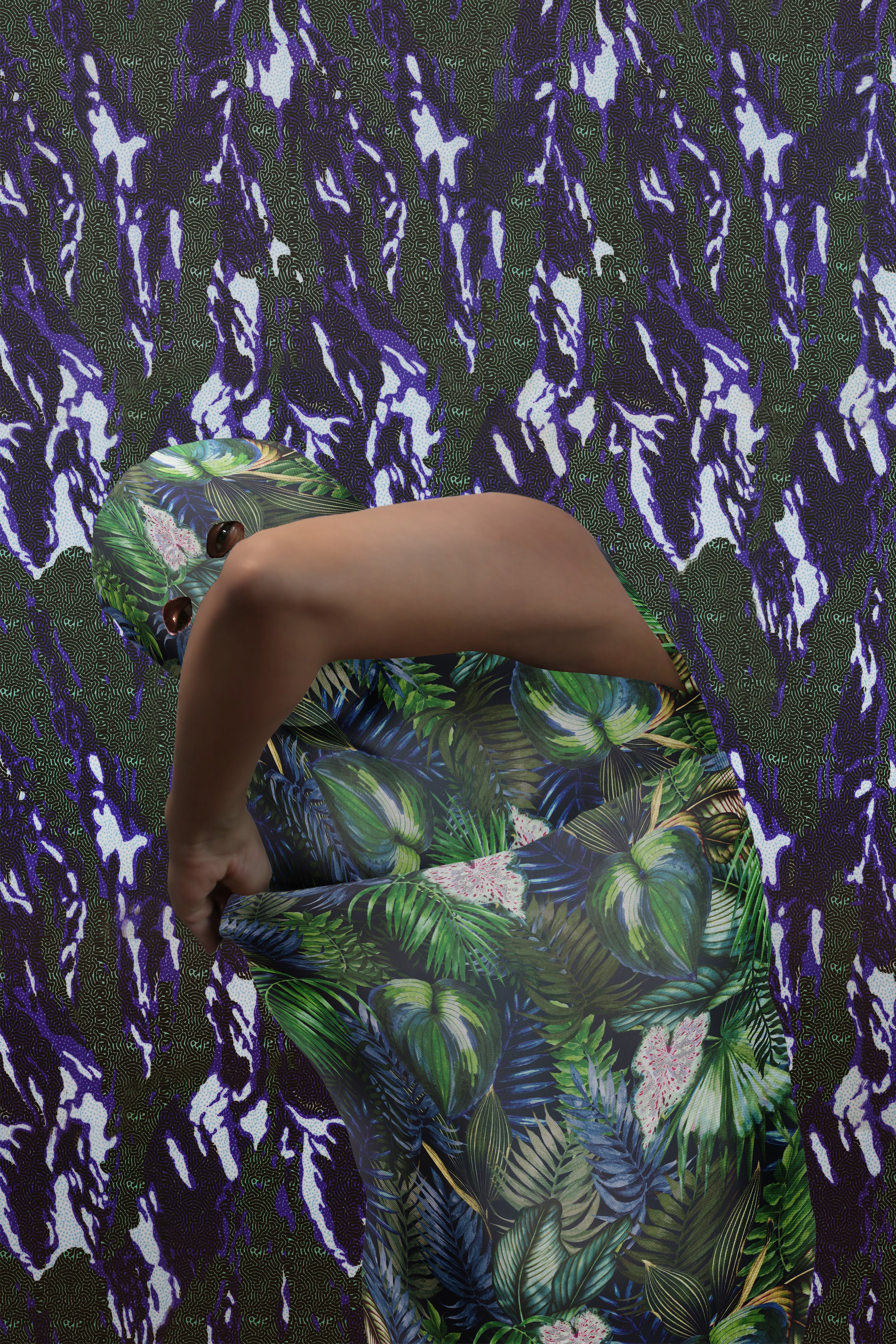
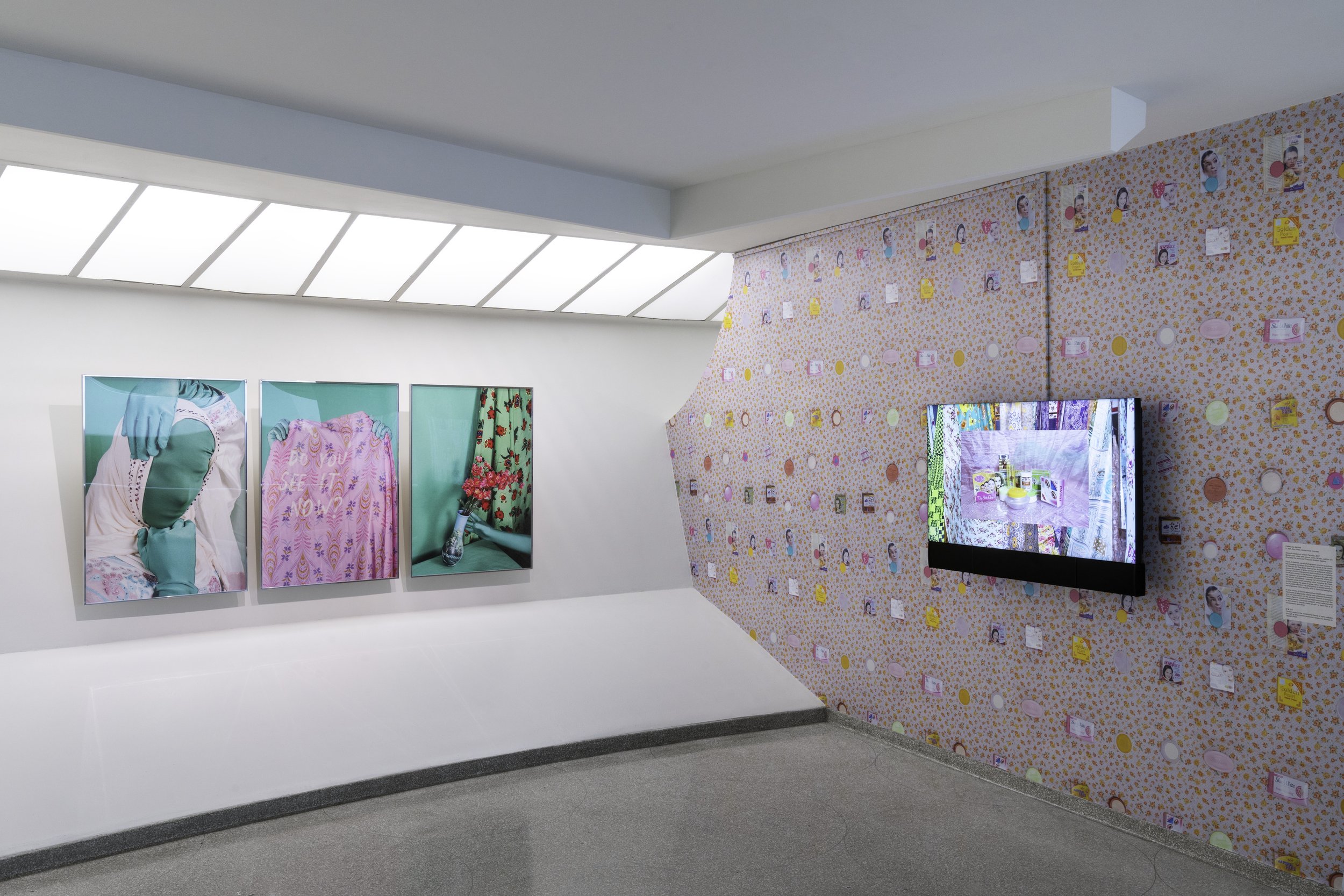
Artist List
American Artist
Kevin Beasley
Rebecca Belmore
Dawoud Bey
John Edmonds
Ellen Gallagher
David Hammons
Lyle Ashton Harris
Tomashi Jackson
Titus Kaphar
Glenn Ligon
Kerry James Marshall
Tiona Nekkia McClodden
Joiri Minaya
Sandra Mujinga
Chris Ofili
Sondra Perry
Farah Al Qasimi
Faith Ringgold
Doris Salcedo
Lorna Simpson
Ming Smith
Sable Elyse Smith
Stephanie Syjuco
Hank Willis Thomas
Wang Shui
Carrie Mae Weems
Charles White
Going Dark: The Contemporary Figure at the Edge of Visibility is organized by Ashley James, Associate Curator, Contemporary Art, with Faith Hunter, Curatorial Assistant.
Support
Major support for Going Dark: The Contemporary Figure at the Edge of Visibility is provided by the Rockefeller Brothers Fund.
The Leadership Committee for this exhibition is gratefully acknowledged for its generosity, with special thanks to Amy and David Abrams, Glenstone Museum, Agnes Gund, Pamela Joyner and Alfred Giuffrida, Noel E.D. Kirnon, Arthur Lewis and Hau Nguyen, Amitha Raman, Jessica and Brian Robinson, ARTNOIR, Elisa Durrette and Ruth McFarlane, Marilyn and Larry Fields, Alteronce Gumby, Miyoung Lee and Neil Simpkins, Bernard I. Lumpkin and Carmine D. Boccuzzi, Suzanne McFayden, Jack Shainman Gallery, and George Wells.
Support is also generously provided by The Andy Warhol Foundation for the Visual Arts, The Henry Luce Foundation, The Kate Cassidy Foundation, The Mondriaan Fund, The Jacques and Natasha Gelman Foundation, and Royal Norwegian Consulate General in New York.
Additional funding is provided by the Solomon R. Guggenheim Museum’s Photography Council and Young Collectors Council.
About the Solomon R. Guggenheim
The Solomon R. Guggenheim Foundation was established in 1937 and is dedicated to promoting the understanding and appreciation of modern and contemporary art through exhibitions, education programs, research initiatives, and publications. The international constellation of museums includes the Solomon R. Guggenheim Museum, New York; the Peggy Guggenheim Collection, Venice; the Guggenheim Museum Bilbao; and the future Guggenheim Abu Dhabi. An architectural icon and “temple of spirit” where radical art and architecture meet, the Solomon R. Guggenheim Museum is now among a group of eight Frank Lloyd Wright structures in the United States recently designated as a UNESCO World Heritage site.
This large-scale exhibition features a multigenerational, multiracial group of artists who address pressing questions around what it means to be seen, not seen, or erased in society, through formal experimentations with the figure and will be on view until April 7th of 2024. To learn more about the museum, this exhibit, past exhibits, current exhibits, upcoming exhibits, and the Guggenheim’s activities around the world, visit here. The museum can also be found on YouTube, TikTok, X, Facebook and Instagram.
WesleyWorld: Works on Paper and Objects 1961–2004
WesleyWorld: Works on Paper and Objects 1961–2004 540 West 25th Street, New York, NY 10001 January 12 – February 24, 2024 Photography courtesy Pace Gallery
New York – Pace Gallery is pleased to present its first exhibition dedicated to the work of John Wesley since the gallery began representing his estate in early 2023. The exhibit has been on view since January 12 and will close on February 24, 2024. Held at Pace’s New York location at 540 West 25th Street in New York, this exhibition brings together over 30 works on paper and painted objects produced by Wesley over the course of his career, from the early 1960s to the early 2000s.
Wesley, who died in 2022 at age 93, is known for his flattened, idiosyncratic figurations that defy easy classification within any single artistic movement. Drawing inspiration from images in comics and other mass media, the artist cultivated a distinctive, graphic style characterized by bold, weighted lines, unmodulated color, and an absurdist- edge.
Concord, 2004 WORK ON PAPER acrylic on paper 18" × 19-3/8" (45.7 cm × 49.2 cm), image 26-5/16" × 27-1/16" × 1-1/2" (66.8 cm × 68.7 cm × 3.8 cm), framed No. 89803 © John Wesley, courtesy of The John Wesley Foundation and Pace Gallery
Marked by eroticism, wry humor, and often a slight sense of unease, Wesley’s work explores a wide range of imagery informed by pop cultural and literary sources as well as the artist’s own memories and daily experiences. Many of his works are concerned with enactments of balance and symmetry, examining nuances of sexuality and desire through a formal language characterized by unexpected crispness and precision.
Untitled (Ducks), 1983 WORK ON PAPER acrylic on paper 39-1/2" × 62-1/2" × 1-1/2" (100.3 cm × 158.8 cm × 3.8 cm), framed No. 86524 © John Wesley, courtesy of The John Wesley Foundation and Pace Gallery
“The puzzling, open-ended ambiguity of Wesley’s depictions encourages expansive gestures of critique, whatever their ultimate merits,” art historian Richard Shiff writes in a newly commissioned essay for Pace Publishing’s digital catalogue accompanying the gallery’s Wesley exhibition. “To a theorist, his art readily demonstrates that interpretation has no limits, for every nuance of graphic difference initiates multiple interpretive threads with the potential to lead just about anywhere.”
Wesley produced a large body of landscapes regularly depicting tranquil shorelines and stormy seascapes, but also rolling hills and urban skylines. In his figurations, the human body and its constituent parts are often used to experiment with repetition as a formal device. Wesley also frequently reimagined characters from popular culture— most notably Dagwood Bumstead and his wife Blondie from the Blondie comic strip—in scenes across his body of work.
“His often caustic wit also has a warm-heartedness to it when the topic demands, and his sense of comedy is no less pronounced than his sense of tragedy,” art historian Martin Hentschel wrote in his 2005 publication on Wesley’s works on paper, continuing later, “He directed his gaze above all to the human condition, with all its peaks, ambiguities, and abysses.”















WesleyWorld: Works on Paper and Objects 1961–2004 540 West 25th Street, New York, NY 10001 January 12 – February 24, 2024 Photography courtesy Pace Gallery
Pace’s exhibition showcases the varied scales of Wesley’s works on paper, allowing visitors to experience the impressive range of form and imagery through which he experimented with repeating, layering, and mirroring—formal mainstays of his paintings. Though the works on view in the show span Wesley’s career, they reveal a remarkable consistency in his approach to image-making over the course of five decades. Tracing the evolution of the artist’s interests over time, these artworks shed light on the different subjects that entered his visual lexicon between the 1960s and 2000s.
Transport des Enfant, 1978 WORK ON PAPER acrylic on paper 19-3/4" × 25-1/2" (50.2 cm × 64.8 cm), paper No. 86528 © John Wesley, courtesy of The John Wesley Foundation and Pace Gallery
The show takes a broad view of Wesley’s life and career, spotlighting several objects by the artist—including a canvas vest and a selection of paper neckties—in addition to his works on paper. These rarely exhibited and, in some cases, never-before-exhibited pieces feature patterns and motifs that are often mirrored in the artist’s works on paper and paintings, reflecting his ability to translate his signature style across mediums and dimensions.
A unique voice in the canon of Contemporary art, John Wesley (b. 1928, Los Angeles, California; d. 2022, New York) is known for his precise, lyrical, and often deadpan painterly investigations of the American subconscious. With no formal artistic training, two of Wesley’s jobs had a direct impact on his early practice. At the age of 24, he began working as an illustrator in the Production Engineering Department at Northrop Aircraft in Los Angeles where he translated blueprints into drawings. In 1960, he moved to New York, where he worked as a postal clerk, utilizing symbols such as the shield-like postage stamp and his employee badge in his paintings. Later, his practice expanded to incorporate varied and enigmatic iconographies such as animals, beguiling women, and portraiture of subjects including Theodore Roosevelt, Rudyard Kipling, and Count Henri de Baillet-Latour, the president of the 1932 International Olympic Committee. Through a carefully refined visual vocabulary of clean lines, solid shapes, and repetition, Wesley imbued everyday scenes and quotidian subjects with humor and wry wit. Exploring themes relating to trauma, eroticism, innocence, and coyness, paintings within his oeuvre are characterized by a linear stylized formation, similar to comic strips, and are often populated with cartoon characters such as Dagwood Bumstead, Popeye, and Olive Oyl. His series, Searching for Bumstead, which he began in 1974 and continued for the entirety of his career, depicts empty interiors—including a vacant armchair, slippers by a bedside, a bathtub filled with water—and is an exploration of the trauma of losing his father, whose sudden death deeply affected him.
I'll Dream you in My Sees, ca. 1965 SCULPTURE duco and oil on canvas on found object (wood lamp) 31" × 29-1/2" × 29-1/2" (78.7 cm ×74.9cm×74.9cm) No. 86556 © John Wesley, courtesy of The John Wesley Foundation and Pace Gallery
Wesley defies categorization as an artist. During the 1960s, as the tenets of Pop art began to take shape, he was grouped with the movement due to the basic elements of his style and subject matter. Wesley exhibited alongside Pop artists such as Andy Warhol, Tom Wesselman, and Roy Lichtenstein but ultimately eluded true categorization both in theory and in practice due to his unique visual language. His first solo exhibition was at the Robert Elkon Gallery, New York, in 1963. Minimalist artist Donald Judd, a lifelong supporter of the artist, reviewed the paintings in the show: “the forms selected and shapes to which they are unobtrusively altered, the order used, and the small details are humorous and goofy. This becomes a cool, psychological oddness.” [1] Wesley was given his own room at the Documenta 5 Retrospective at Kassel (1972) and by the mid 70s it became clear that his work lay somewhere between Pop, Surrealism, and Minimalism, though no label ever encapsulated his singular style. Wesley’s contributions to painting are undeniable. Envisioned by Donald Judd, the largest collection of works by Wesley, spanning from 1963 to the present, are permanently on view in his eponymous gallery at the Chinati Foundation, Marfa, Texas. His work is held in public collections worldwide including the Hirshhorn Museum and Sculpture Garden, Washington D.C.; Kunstmuseum, Basel; The Museum of Modern Art, New York; Speed Art Museum, Louisville, Kentucky; and the Whitney Museum of American Art, New York, among others.
NECKTIES, 1981 SCULPTURE 66" × 22-1/2" × 1-5/8" (167.6 cm ×57.2cm×4.1cm) No. 88989 © John Wesley, courtesy of The John Wesley Foundation and Pace Gallery
Pace is a leading international art gallery representing some of the most influential contemporary artists and estates from the past century, holding decades-long relationships with Alexander Calder, Jean Dubuffet, Barbara Hepworth, Agnes Martin, Louise Nevelson, and Mark Rothko. Pace enjoys a unique U.S. heritage spanning East and West coasts through its early support of artists central to the Abstract Expressionist and Light and Space movements.
Since its founding by Arne Glimcher in 1960, Pace has developed a distinguished legacy as an artist-first gallery that mounts seminal historical and contemporary exhibitions. Under the current leadership of CEO Marc Glimcher, Pace continues to support its artists and share their visionary work with audiences worldwide by remaining at the forefront of innovation. Now in its seventh decade, the gallery advances its mission through a robust global program— comprising exhibitions, artist projects, public installations, institutional collaborations, performances, and interdisciplinary projects. Pace has a legacy in art bookmaking and has published over five hundred titles in close collaboration with artists, with a focus on original scholarship and on introducing new voices to the art historical canon.
Today, Pace has seven locations worldwide, including European footholds in London and Geneva as well as Berlin, where the gallery established an office in 2023. Pace maintains two galleries in New York—its headquarters at 540 West 25th Street, which welcomed almost 120,000 visitors and programmed 20 shows in its first six months, and an adjacent 8,000 sq. ft. exhibition space at 510 West 25th Street. Pace’s long and pioneering history in California includes a gallery in Palo Alto, which was open from 2016 to 2022. Pace’s engagement with Silicon Valley’s technology industry has had a lasting impact on the gallery at a global level, accelerating its initiatives connecting art and technology as well as its work with experiential artists. Pace consolidated its West Coast activity through its flagship in Los Angeles, which opened in 2022. Pace was one of the first international galleries to establish outposts in Asia, where it operates permanent gallery spaces in Hong Kong and Seoul, along with an office and viewing room in Beijing. In spring 2024, Pace will open its first gallery space in Japan in Tokyo’s new Azabudai Hills development.
For more information about this exhibition and others, please visit the Pace Gallery’s website here. Pace Gallery can be found on Instagram and Artsy, too.
Glenn Kaino: Walking with a Tiger
Glenn Kaino: Walking with a Tiger, 540 West 25th Street, New York, NY 10001January 12–February24, 2024 Photography courtesy of Pace Gallery
New York – Pace is pleased to present an exhibition of new work by Glenn Kaino at its 540 West 25th Street gallery in New York. The exhibit opened on January 12 and will close on February 24, 2024. The show, titled Walking with a Tiger, marks Kaino’s first major exhibition with Pace since he joined the gallery’s program in 2021. The presentation will bring together 18 new artworks—including paintings, embroideries, and sculptures—created by the artist this year.
Known for his multidisciplinary, activist-minded practice and collaborative approach to art making, Kaino has explored a wide range of political, social, and environmental issues in his work across mediums. In his paintings, sculptures, installations, performances, films, and monumental public works, the artist examines the roles that empathy and subjectivity can play in dismantling oppressive power structures and effecting real change.
Don't Ruffle Feathers, 2023 MIXED MEDIA, cotton, thread, wood, and metal 36-1/2" × 20-3/4" × 2-1/2" (92.7 cm × 52.7 cm × 6.4 cm), frame 47-1/2" × 20-3/4" × 2- 1/2" (120.7 cm × 52.7 cm × 6.4 cm), overall, No. 90131, © Glenn Kaino, courtesy Pace Gallery
For his first full-scale exhibition with Pace, Kaino will show a selection of deeply personal works centering on his family history and identity as a Japanese-American. With new paintings, embroideries, and sculptures, the artist has, for the first time in his career, turned his gaze inward to his own history, memories, and experiences. Kaino’s decision to engage in this more intimate kind of storytelling—as opposed to the macro-scale social issues he has explored in much of his past work—evolved from Glenn Kaino: Aki’s Market, a multifaceted installation centering on his grandfather’s life in East LA, on view at the Japanese American National Museum in Los Angeles through January 28, 2024. Kaino’s upcoming show in New York addresses these personal concerns with the same rigor, inventiveness, and humor that has defined his approach to art making and scholarship.
Kabuto (Kangol), 2023 SCULPTURE bronze and fabric 10-3/4" × 14-13/16" × 12-3/8" (27.3 cm × 37.6 cm × 31.4 cm), overall No. 90139.01, © Glenn Kaino, courtesy Pace Gallery
Walking with a Tiger raises questions about the Asian-American diaspora, a subject that has been largely ignored in cultural production until very recently, as it relates to the past, present, and future alike. Based on original photography, Kaino’s portraits—including friends, musicians, and individuals he encountered on the streets of LA— are acts of visibility, bringing new representations of Asian-Americans into conversation with one another and foregrounding enactments of intergenerational communion within the exhibition. Through gestural processes of accumulation and erasure, Kaino uses his brushstrokes to partially obscure various features of the paintings’ subjects, suggesting a disruption or slippage in the fabric of time and a tension between the background and fore.
Where You From, 2023 MIXED MEDIA, cotton, thread, wood and metal 12-1/4" × 16" × 2-1/2" (31.1 cm × 40.6 cm × 6.4 cm), each frame, No. 90132, © Glenn Kaino, courtesy Pace Gallery
For the new embroidered works in the exhibition, the artist draws on the history of bunka shishu, Japanese punch embroidery that was popularized in the Japanese-American community during the postwar years as a kind of paint- by-numbers for fiber arts and served, for many, as a link to the past. Departing from the instructions within the kits as he has done in his previous 'Kitbash' works, Kaino has invented a new stitch that he utilizes alongside traditional methods. The threads in these works are long and loose, extending embroidered images of tigers, storks, and Kabuki figures well beyond the confines of the picture plane; in some cases, the artist sews images directly together. Japanese tigers are of particular interest to Kaino as symbolic meditations of a romanticized homeland, given that the creature has become part of Japanese iconography and mythology despite having never been indigenous to the country.
The exhibition will also include a selection of bronze sculptures based on kabuto, a type of helmet used by samurai. In Kaino’s hands, this traditional Japanese armor has been reinterpreted through a contemporary lens. Each of these works is an amalgamation of structures and styles—combining baseball caps or Kangols with futuristic, embellished forms that protrude into space, declaring their Asian-American history by incorporating distinctly American wares. Displayed atop wooden plinths, Kaino’s helmets will also feature decorated interiors composed of kimono fabrics and woven shoelaces from sneakers. These sculptures speak to the ways that the form and design of relics can endure through the ages, generating new meanings and connections by way of the artist's hand.


























Glenn Kaino: Walking with a Tiger, 540 West 25th Street, New York, NY 10001January 12–February24, 2024 Photography courtesy of Pace Gallery
Kaino is the co-curator of the Hammer Museum’s forthcoming Pacific Standard Time exhibition Breath(e): Towards Climate and Social Justice, and his newly commissioned public works for LA’s 6th Street Park and MTA LAX Metro Connector will be unveiled in 2026 and 2024, respectively. Last year, he exhibited his large-scale installation Bridge (Raise Your Voice in Silence) (2021)—a work produced as part of his decade-long collaboration with Olympic track and field athlete Tommie Smith—at Pace’s gallery in New York. He also recently presented a long-term exhibition, In the Light of a Shadow, at MASS MoCA in North Adams, Massachusetts.
Glenn Kaino (b. 1972, Los Angeles, California) is known internationally for his expansive vision and activist-minded practice, which encompasses painting, sculpture, installation, performance, monumental public art, theatrical production, and feature film. Focusing on equity, social justice, and climate change, among other urgent topics, the artist’s work traces through lines among various art historical movements, including Arte Povera, Conceptualism, and performance art. A relentless optimist, Kaino creates work imbued with hope, revealing structures of power and domination and creating opportunities for direct action and progress, all rooted in the belief that cultural production can affect real change. Kaino often highlights the illusionistic and mesmeric effects of scientific and natural phenomena in his large-scale installations to explore notions of empathy and subjectivity and to bring legibility to the often-invisible forces that shape our world.
Pace is a leading international art gallery representing some of the most influential contemporary artists and estates from the past century, holding decades-long relationships with Alexander Calder, Jean Dubuffet, Barbara Hepworth, Agnes Martin, Louise Nevelson, and Mark Rothko. Pace enjoys a unique U.S. heritage spanning East and West coasts through its early support of artists central to the Abstract Expressionist and Light and Space movements.
Since its founding by Arne Glimcher in 1960, Pace has developed a distinguished legacy as an artist-first gallery that mounts seminal historical and contemporary exhibitions. Under the current leadership of CEO Marc Glimcher, Pace continues to support its artists and share their visionary work with audiences worldwide by remaining at the forefront of innovation. Now in its seventh decade, the gallery advances its mission through a robust global program— comprising exhibitions, artist projects, public installations, institutional collaborations, performances, and interdisciplinary projects. Pace has a legacy in art bookmaking and has published over five hundred titles in close collaboration with artists, with a focus on original scholarship and on introducing new voices to the art historical canon.
Today, Pace has seven locations worldwide, including European footholds in London and Geneva as well as Berlin, where the gallery established an office in 2023. Pace maintains two galleries in New York—its headquarters at 540 West 25th Street, which welcomed almost 120,000 visitors and programmed 20 shows in its first six months, and an adjacent 8,000 sq. ft. exhibition space at 510 West 25th Street. Pace’s long and pioneering history in California includes a gallery in Palo Alto, which was open from 2016 to 2022. Pace’s engagement with Silicon Valley’s technology industry has had a lasting impact on the gallery at a global level, accelerating its initiatives connecting art and technology as well as its work with experiential artists. Pace consolidated its West Coast activity through its flagship in Los Angeles, which opened in 2022. Pace was one of the first international galleries to establish outposts in Asia, where it operates permanent gallery spaces in Hong Kong and Seoul, along with an office and viewing room in Beijing. In spring 2024, Pace will open its first gallery space in Japan in Tokyo’s new Azabudai Hills development.
For more information about this exhibition and others, please visit the Pace Gallery’s website here. Pace Gallery can be found on Instagram and Artsy, too.
Albano Afonso:Fora de Registro
Installation views: “Fora de Registro,” Casa Triângulo São Paulo, Brazil, 2024, courtesy of Casa Triângulo São Paulo, Brazil Photo Credit: Filipe Berndt
Casa Triângulo, with delight, presented to Fora de Registro, Albano Afonso's (1964, São Paulo, Brazil). His eleventh solo exhibition at the gallery opened on November 11, 2023, and will close on February the 3rd of, 2024.
Thoughts on Fora de Registro by Eder Chiodetto
Whenever we contemplate something, engaging with a specific object or subject, we do so out of a desire to internalize the significations and broader meanings of an occurrence, a landscape, a person, an object, a gesture, or even a work of art. These meanings are indeed broader, because when a certain referent appeals to a degree that we subject it to a more detailed visual scrutiny, it's not only the faculty of vision that we put into action for this prolonged moment. Within the duration of that moment, a co-relation between the self and the other is established, in which other senses are soon called into play.
We can infer that contemplating is a way of perceiving the target of our interest beyond its appearance. It is an adventure in which our sensory streams are enlisted to produce an enhanced sort of vision that is able to investigate, both thoroughly and gently, the interstices, nuances, and gaps of this referent that is drawing us to it. To a large extent, it is also a dialogic perceptive gaze, since to unveil the latent meanings of the other, or of something, we are necessarily also looking into ourselves, letting our mood, our intellect, and our unconscious react freely with this enjoyment.
O Sono 01, 2023 Inkjet printing on Hahnemühle Photo Rag Baryta paper Edition: unique + 3 + 1 PA 89 x 119 cm Courtesy Casa Triângulo, São Paulo Photographer Credit: Albano Afonso
Thus, all contemplation is also an enhanced mode of vision that takes place not only from the eyes outward, but also inward, into ourselves. When this circuit is put into operation, we are close to a meditative state.
Photography is the sphinx of a contemplation. A monument built by the effects of light striking a photosensitive surface, tasked with generating the simulacrum of a contemplation that the photographer believed should be made permanent. As researcher and photographer Boris Kossoy has said, a photograph reveals not the reality of the moment of capture, but a second reality, the reality of the two-dimensional printed surface, subject to being organically and symbolically altered in its temporal journey towards infinity.
Could, therefore, a photographic record give rise to the potential of the contemplative ecstasy that originated it? Or, could a photograph itself be the trigger of this enchantment, exchanging the experience of the lost instant for the contemplation of the very medium that contains it?
Still Life 02, 2023 Inkjet printing on Hahnemühle Photo Rag Baryta paper Edition: unique + 3 + 1 PA 40 x 48,5 cm Courtesy Casa Triângulo, São Paulo Photographer Credit: Albano Afonso
Thoughts like these arise when we observe the new photographic series by Albano Afonso. Fora de Registro [Out of Register] is created by means of technical and poetic strategies that generate a sort of illusory seismic shock where we seem to be seeing the photographed thing and not simply an image printed on a surface. The idea of photography as a window that magically dislodges us from our space-time is refuted in the artist’s metalinguistic proposal.
The artist overlays several images made in sequence and rearranges them so that the representation of the referent is “out of register,” which is printmaking jargon for when the several plates used for printing the various colors that form the image are not aligned, resulting in a blurred effect. This approach, along with other creative techniques, transforms the photographs, taking them beyond being merely passive camera reproductions.
By subjecting the images to this process, Albano Afonso seems to be echoing René Magritte’s iconic statement, in this case suggesting: This is not a bouquet of flowers, it is a photograph. By disrupting our mind's tendency to wander, preventing the illusion offered by photographic mimesis, the artist peels back the mirror-like play of the representational system, placing us in front of these photographs, which intentionally fail in their attempt to be a mirage.
A failure can also be the trigger that leads us to contemplation. If the sphinxes that appeal to me in these images are no longer the bouquet of flowers, the work of art, or a constellation, then what is it that keeps me connected to them?
Albano leads us to look at photographs as if they were... almost photographs. Bereft of the illusory mimetic game, of their power of mirage that brings us to past times and spaces, these photographs have no aim to lead us to any place beyond them. They are no longer merely a support, nor a passport.
Still Life 03, 2023 Inkjet printing on Hahnemühle, Photo Rag Baryta paper Edition: unique + 3 + 1 PA 52 x 62,5 cm, Courtesy Casa Triângulo, São Paulo Photographer Credit: Albano Afonso
The contemplation now takes place in the materiality of the photographic copy itself, and in Fora de Registro, these images seem imbued with an irrepressible desire to be a sculptural event. After all the strategies the artist set into motion, what remains before us is not the fabulous promise of photography, but rather its structure; the center of our speculation is no longer somewhere beyond it, it is the material medium itself.
In this operation, the image is no longer the promise of anything; it becomes an exposed fracture, a relic. We are therefore contemplating the failure of a promise, and thus, we are finally led to see the framework, the constitutive elements of a collapsed image, rather than an image as a whole.








Installation views: “Fora de Registro,” Casa Triângulo São Paulo, Brazil, 2024, courtesy of Casa Triângulo São Paulo, Brazil Photo Credit: Filipe Berndt
Fora de Registro marks Albano Afonso’s triumphant return to the entrails of the photographic, in his selfless project of speculating about the realm of technical images and the effects they have on our perception. In his career, the artist has already investigated the image-imagination dyad from various standpoints: projection, movement, the genesis that forms the image, the brightness that reveals even as it blinds, etc. Now, the artist is passionately engaged in the possibility of contemplating the raw language, photography in a state of suspension, self-analyzing its place in a world dominated by assertive algorithms that disorient us to the point where, for better or worse, realities and fables overlap, leaving no traces that would allow us to understand where and why they emerge before us. This clearly involves a timely political thrust, as the artist sounds an alert about the hypnotic effect of the nature of the photographic image.
Deactivating the illusion also contributes to a more critical and less dogmatic point of view. Albano unveils this possibility by presenting photography as a sovereign body vibrating intensely before our eyes. Photographs that begin and end in themselves. Monuments that have shed their false heroes.
For more information about the exhibit Out of Register and Other exhibitions at Casa Triângulo, please visit their website and follow the gallery on Instagram and Facebook. Casa Triângulo can also be found on Artsy.
ALIOUNE DIAGNE:SEEDE
Toutes les images / All images : © Courtesy of the artist and TEMPLON, Paris —Brussels — New York
For his very first exhibition at Galerie Templon’s Paris space, painter Alioune Diagne, who is representing his country on the Senegalese Pavilion at the Venice Biennale in 2024, is showing a selection of eight paintings on the theme of clandestine crossings at sea. The Templon Gallery is pleased to have this exhibition, which opened on January 6th and will close on the 24th of February this year.
Destination inconnue, 2023 Acrylique sur toile | Acrylic on canvas 100 × 130 cm — 39 1/4 × 51 1/4 in Photo © Adrien Millot
Alioune Diagne uses a technique he developed and has gradually perfected where small modules, which he calls “unconscious signs”, cluster together to form a coherent figurative mass. He uses a complex process based on these signs, reminiscent of forgotten calligraphy, to create dynamic paintings that depict daily life in Senegal as well as the everyday experiences of the African diaspora around the world.
For Seede, which means “the witness” in Wolof, Diagne spent several weeks visiting the Senegal coastline. His canvases echo the stories of local fisherman who, equipped only with a pirogue and a net to do their work, are seeing growing foreign industrialisation of the fishing business. As Alioune Diagne explains: “To survive, some of them have had to abandon their traditional skills and resort to the illegal practice of people smuggling.”








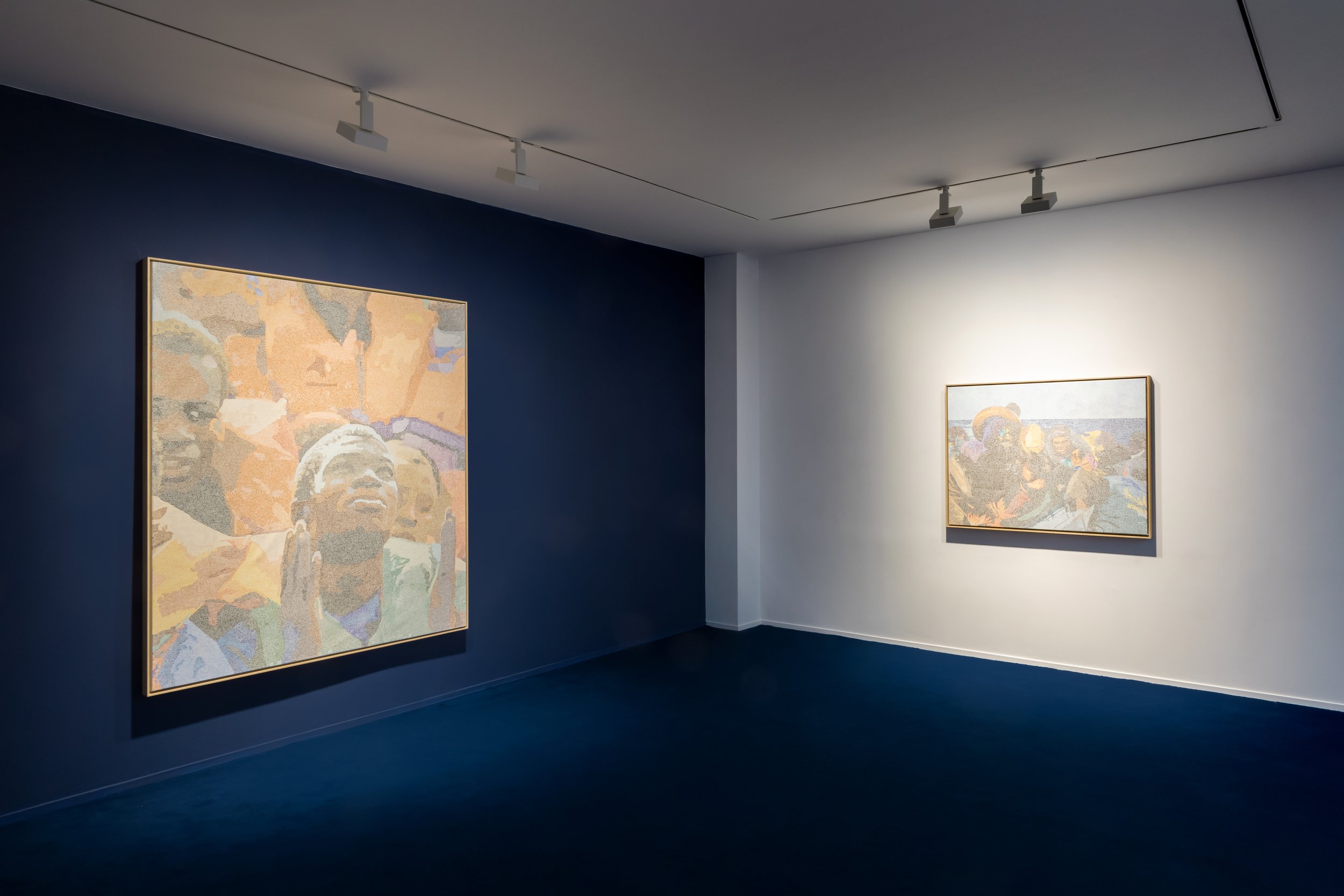





Toutes les images / All images : © Courtesy of the artist and TEMPLON, Paris —Brussels — New York
The deep blue colour and handful of fishing nets covering the walls and floor of the Paris space give the exhibition an immersive not to say dramatic feel. “These are subjects I want to talk about,” says the artisti. “Emigration is still a painful reality today. Up till now, people only envisaged living a successful life in Europe or the USA. I want to show the younger generations that it’s possible to have a future in Africa.”
Toutes les images / All images : © Courtesy of the artist and TEMPLON, Paris —Brussels — New York
Born in 1985 in Kaffrine, Senegal, Alioune Diagne lives and works in Senegal and France. After studying at the Dakar Ecole des Beaux-Arts in 2008, Alioune Diagne developed “figuro-abstro”, an imaginary script, universal language and intimate account of fragments of his private life in Dakar and on his travels. He is a socially engaged artist, paving the way for a deep-seated exploration of the major challenges facing today's world: ecology, the place of women in society, racism, and the notions of transmission and heritage. His work has featured in a variety of solo and group exhibitions in Europe, Africa and Asia, including Sink or Swim at the 11th Dakar Biennale, Villa Spivey, Dakar, Senegal (2014), Itinéraire en Couleurs at Espace Jean Drevon, Saint-Jean-de-Bournay, France (2014), the off-site show at Art Basel, Switzerland (2017), Un nouveau regard,
Aosta, Italy (2017) and Ndox-Glint at the Rouen Musée des Beaux-Arts (2023). His work has also been part of the national art collection of Senegal since 2019 and was exhibited at the national theatre in Dakar for the 2022 Dakar biennale. In April 2024, the artist will have the honour of representing his country on the Senegalese Pavilion at the 60th Art Biennale International Art Exhibition in Venice. He has been represented by Galerie Templon since 2022 and Seede will be his second solo exhibition with the gallery.
For more information about this exhibition and others, please visit the Templon Gallery’s website here.
JANET CARDIFF& GEORGE BURES MILLER Ambient Jukebox & Other Stories
Ambient Jukebox, 2023 interactive jukebox with tracks of ambient guitar music composed by the artists © Janet Cardiff and George Bures Miller, courtesy Fraenkel Gallery, San Francisco, and Luhring Augustine, New York
Ambient Jukebox & Other Stories, is an exhibition of new work by multidisciplinary artists Janet Cardiff and George Bures Miller at the Fraenkel Gallery. The exhibit opened On January 11th and featured a public reception with the artists that took place on Saturday, January 13, from 2-4 pm.. This will be the artists’ second solo exhibition with the gallery since 2018. The exhibition closes on March 9, 2024.
Cosmic Disco, 2024 mirror balls, acrylic paint, rotating motors, DMX lights, chains & miscellaneous hardware © Janet Cardiff and George Bures Miller, courtesy Fraenkel Gallery, San Francisco, and Luhring Augustine, New York
Atmospheric, dreamlike, and theatrical, the duo’s work often explores how sound affects perception. In Cosmic Disco, tiny points of light reflected from altered mirrorballs fill a darkened room to create the illusion of slowly moving galaxies, accompanied by a soundtrack drawn from recordings of planets and moons made by NASA’s Voyager I and II. The piece immerses viewers in illusory reflections and otherworldly sounds, encouraging contemplation of the universe and humans’ place in it. In another room, Ambient Jukebox repurposes a familiar-looking 1960s jukebox. Rather than playing pop hits, it has been reprogrammed to spin drone-like tunes created by Bures Miller during the disorienting months of the global pandemic. As in many of their pieces, Cardiff and Bures Miller invite the viewer to activate the piece—selecting the tracks creates a singular experience of the work and transforms the iconic object into something unfamiliar and surprising.
Pack Up Your Troubles, 2024 gramophone horn, suitcase, electronics, audio accompanied by artists certificate © Janet Cardiff and George Bures Miller, courtesy Fraenkel Gallery, San Francisco, and Luhring Augustine, New York.
A range of more intimate works populate the third gallery. Combining paintings, found materials, soundtracks, and audio musings, these works explore the ways in which narrative, music, and sound influence the viewer’s interpretation of visual elements. Playful sculptural collages, made in part from studio scraps left over from earlier works, are inspired by constructivist ideas. In one, a collage made from rough wooden shapes, pieces of torn paper, and a tuft of blonde hair spins on a round pedestal as speakers play a hypnotic soundtrack of layered voices. Other works juxtapose moody oil paintings with fragments of found text, exploring the power of words even when inaudible.
Suitcase theater, 2000-23 mixed media & air-dry clay, suitcase, smart phone, charger, clamp, wooden shelf © Janet Cardiff and George Bures Miller, courtesy Fraenkel Gallery, San Francisco, and Luhring Augustine, New York
Suitcases appear in several works. A vintage suitcase is transformed into a theater, replete with curiously crafted doll-like characters and a range of scenarios that play on a small screen facing the ‘stage.’ Another suitcase is modified with a gramophone speaker through which Cardiff’s dreamlike voice quavers the World War I marching song Pack Up Your Troubles in Your Old Kit Bag, and Smile, Smile, Smile by George and Felix Powell, a song which in time has been sung by forces on all sides of many conflicts.
Dream Vacuum, 2021 mixed media with sound & electronics © Janet Cardiff and George Bures Miller, courtesy Fraenkel Gallery, San Francisco, and Luhring Augustine, New York
Janet Cardiff and George Bures Miller recently opened the Cardiff Miller Art Warehouse in Enderby, British Columbia, a venue that showcases their immersive large-scale installations. The Killing Machine, an automated installation inspired in part by Franz Kafka’s story In the Penal Colony, is featured in the exhibition Kafka: 1924 at Villa Stuck in Munich, Germany, on view until February 11, 2024. Their solo survey exhibition Dream Machines was recently on view at Museum Tinguely in Basel, Switzerland, following its premiere at Lehmbruck Museum in Duisburg, Germany. The exhibition was organized in honor of the Wilhelm Lehmbruck Prize, which was awarded to the pair in 2020. Cardiff’s celebrated sound sculpture Forty-Part Motet is on view in ongoing exhibitions at the National Gallery of Canada in Ottawa, and Inhotim in Brumadinho, Brazil.
Doppler Dance, 2023 mixed media, electronics, audio, motor, battery, wooden pedestal accompanied by artists certificate © Janet Cardiff and George Bures Miller, courtesy Fraenkel Gallery, San Francisco, and Luhring Augustine, New York
Their work has been shown in the Metropolitan Museum of Art, New York; MoMA PS1, New York; National Gallery of Canada, Ottawa; Nelson Atkins Museum of Art, Kansas City, Missouri; Moderna Museet, Stockholm; San Francisco Museum of Modern Art; and Tate Modern, London, among many others. Their work is in the collections of public institutions, including the Corcoran Gallery of Art, Washington, D.C.; Dallas Museum of Art, Dallas, Texas; Hirshhorn Museum and Sculpture Garden, Washington, D.C.; San Francisco Museum of Modern Art, and others. In 2011 they received Germany’s Käthe Kollwitz Prize, and in 2001, represented Canada at the 49th Venice Biennale, for which they received the Premio Speciale and the Benesse Prize.
For more information about this exhibition or others, please visit the Fraenkel Gallery’s website.
